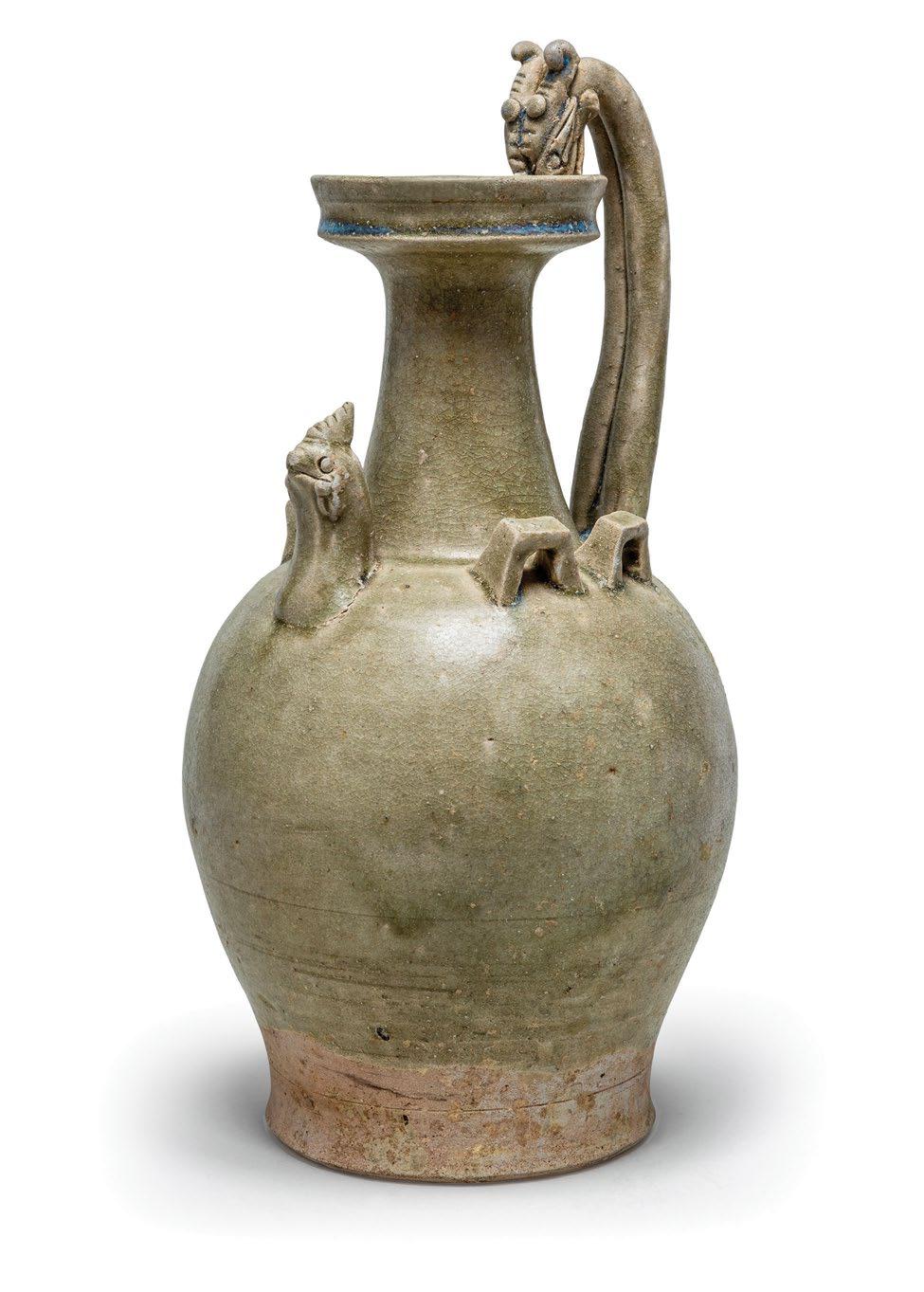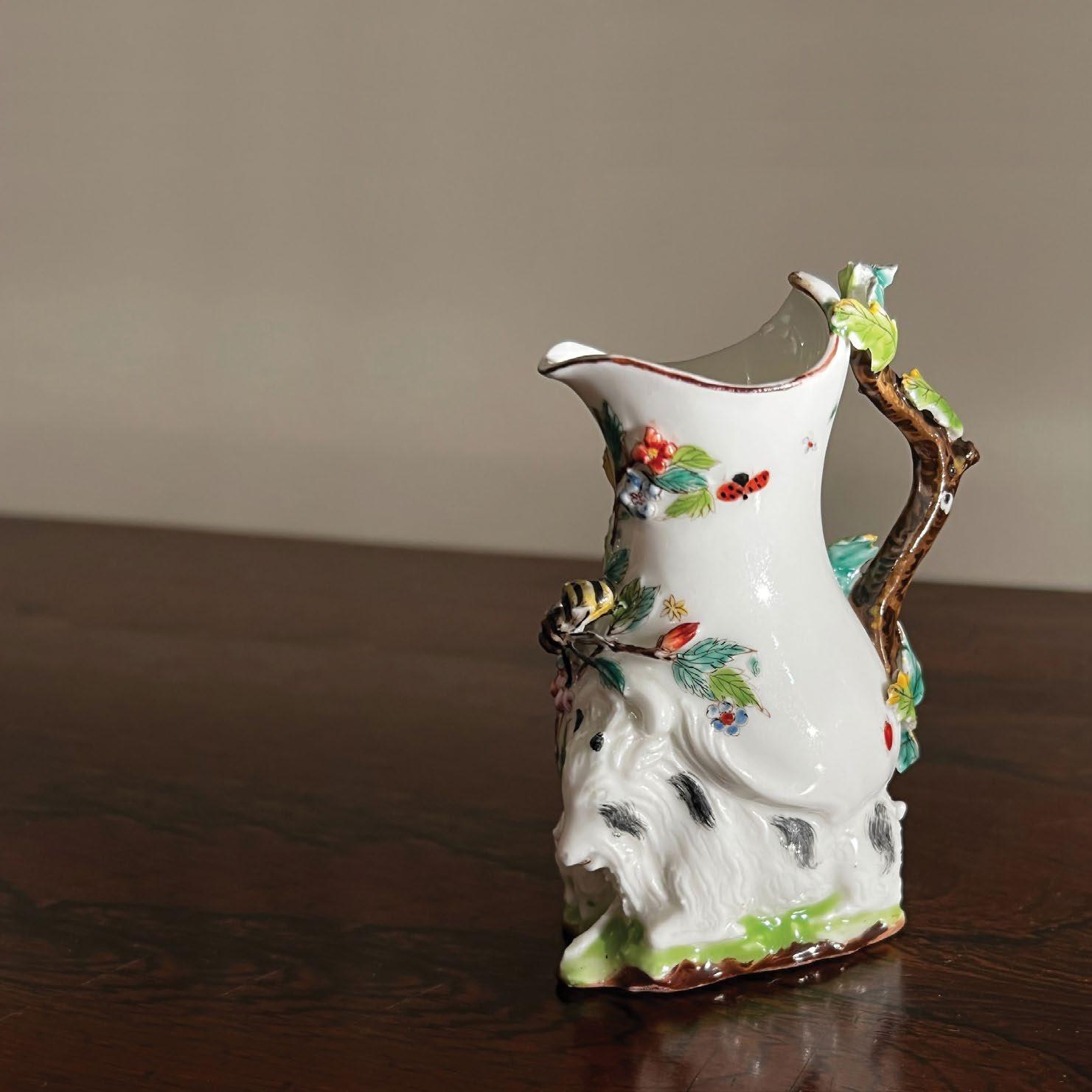How to bid at our Auctions
Catalogues and Viewing
Auction catalogues can be viewed on the Artvisory website www.artvisory.com.au approximately three weeks prior to the published date of an Auction.
Printed catalogues will be available complimentary at the auction viewing and can be express posted (within Australia) prior to the viewing for $20AUD.
The Auction viewing is open to the public and generally takes place during the three days prior to the Auction date, from 11am–5pm at the advertised location/s in the Auction catalogue.
Lot Descriptions
The Lot/ Catalogue descriptions provide the overall information of an item including size, date or age, medium, attribution, quantity and if known, provenance.
Estimates
The estimate accompanies each lot in the printed and online catalogue. This estimate takes into consideration the quality, condition, rarity, condition and provenance of the item. Each estimate also has a reserve, and the reserve is the undisclosed and confidential amount set at or below the low estimate. Please note the reserve will never exceed the low estimate at Artvisory, however many lots are sold without a reserve.
Condition Reports
Condition reports supplement the lot/catalogue description and focus on the condition of the item. We strongly advise obtaining a condition report if you are unable to view the lot in person. Condition reports and additional images are available to view as part of the auction item listing at Invaluable.com or can be requested from Artvisory directly.
Symbols
Occasionally a symbol is printed next to a lot number in the catalogue, this indicates a special clause that is associated with the sale of that item. Please refer to the Terms and Conditions for specific symbol meanings and information.
Buyers Premium
Artvisory charges a Buyers Premium of 26% plus GST on the hammer price of all Auction items unless otherwise stipulated.
Bidding
Artvisory offers four options for bidding at our Auctions:
Live Bidding
If this is your first-time bidding with Artvisory you will be required to register with us, which requires you to fill out a buyer registration form to receive your bidders number.
To facilitate this, please bring along your Government issued photo identification, such as a driver’s licence or passport as this is the only form of identification that will be accepted.
Please make sure you register in the name you want your final invoice to be made out to, as invoices once issued cannot be changed, and in certain cases a deposit may be required before you can bid.
Online Bidding
Online bidding via Invaluable.com allows you to bid via the internet in real time, whilst also allowing you to view the live feed of the Auction.
You have two options to register for this service:
• Register via the Artvisory website and an Invaluable.com online bidding fee of 2% of the hammer price is added
• Register direct with Invaluable.com and an online bidding fee of 5% of the hammer price is added
Please make sure you register for online bidding at least 24 hours prior to the Auction to ensure you do not miss your lot.
Please note if you have not bid with Artvisory previously, then Government issued photo identification verifying your name and address will be also be required before you can be approved to bid with Artvisory via the Invaluable.com site, and in certain cases a deposit may be required before you can bid.
Please note Artvisory cannot be held responsible for any errors that occur with internet connectivity during an auction or buyer bidding errors.
6
Telephone Bidding
Complimentary telephone bidding is available at all of our live Auctions and involves an Artvisory representative calling you approximately 3–5 lots in advance of your nominated lot and you then instruct them to bid on your behalf.
Telephone Bids must be requested at least 24 hours prior to the commencement of the Auction and are provided on a first come, first served basis, as the number of phone lines available are limited.
See our website to download and complete a telephone bidding form and please note that if this is your first time bidding with Artvisory, we will require a clear, scanned copy of Government issued photo identification such as a drivers licence or current passport verifying your name and address and in certain cases a deposit may be required before you can bid.
Absentee Bidding
Absentee bidding offers convenience if you are unable to attend an Auction in person, bid over the telephone, or if you wish to stick to your budget.
An absentee bid should be set at the maximum amount you wish to bid on the lot/s you are interested in purchasing. Should the lot/s be knocked down at an amount lower than the bid recorded on your form, the lot will be sold to you for the lesser hammer price plus Buyers Premium. If identical bids are received for the same lot, then the first bid received by Artvisory will take precedence.
Absentee bids must be received by Artvisory at least 24 hours prior to the Auction commencing and the Company cannot be held responsible for activating any late bids that are received.
See our website to download and complete an absentee bidding form and please note if this is your first time bidding with Artvisory, we will require a clear, scanned copy of Government issued photo identification such as a drivers licence or current passport verifying your name and address and in certain cases a deposit may be required before you can bid.
Payment and Collection
If you are successful with your bid/s, your invoice will be emailed to you immediately after the Auction finishes.
You will pay the hammer price, plus the Buyers Premium of 26% plus GST on each lot, together with any additional charges such as the Invaluable. com online bidding fee, GST on hammer, or the Artist Resale Royalty if applicable.
As per our terms and conditions, payments must be made in full by three (3) days after the Auction has been completed as printed in the catalogue.
We accept Direct Deposit into the Company Trust Account, Eftpos (up to your daily limit) or credit card in person with the following merchant fee applicable (1.43% inc GST for Visa, Mastercard and American Express)
Cash payments must be deposited direct to the Company Trust account via any Commonwealth Bank Branch, and goods can be released upon supplying the deposit receipt.
Personal, Company and Bank cheques are not accepted unless prior approval has been sought.
All payment options and Company Trust Account details are included on the invoice that is emailed to you after the Auction if you are a successful bidder.
All items must be paid for in full and collected within the collection times advertised for each individual Auction. If items are not collected within this time frame then Artvisory reserves the right to charge removal, storage and release fees.
Packing and Delivery
Artvisory has a list of recommended carriers specific to each auction that will be sent to you if you are a successful buyer.
7
Part 1
Sunday 22 October, 12 noon (Lots 1–260)
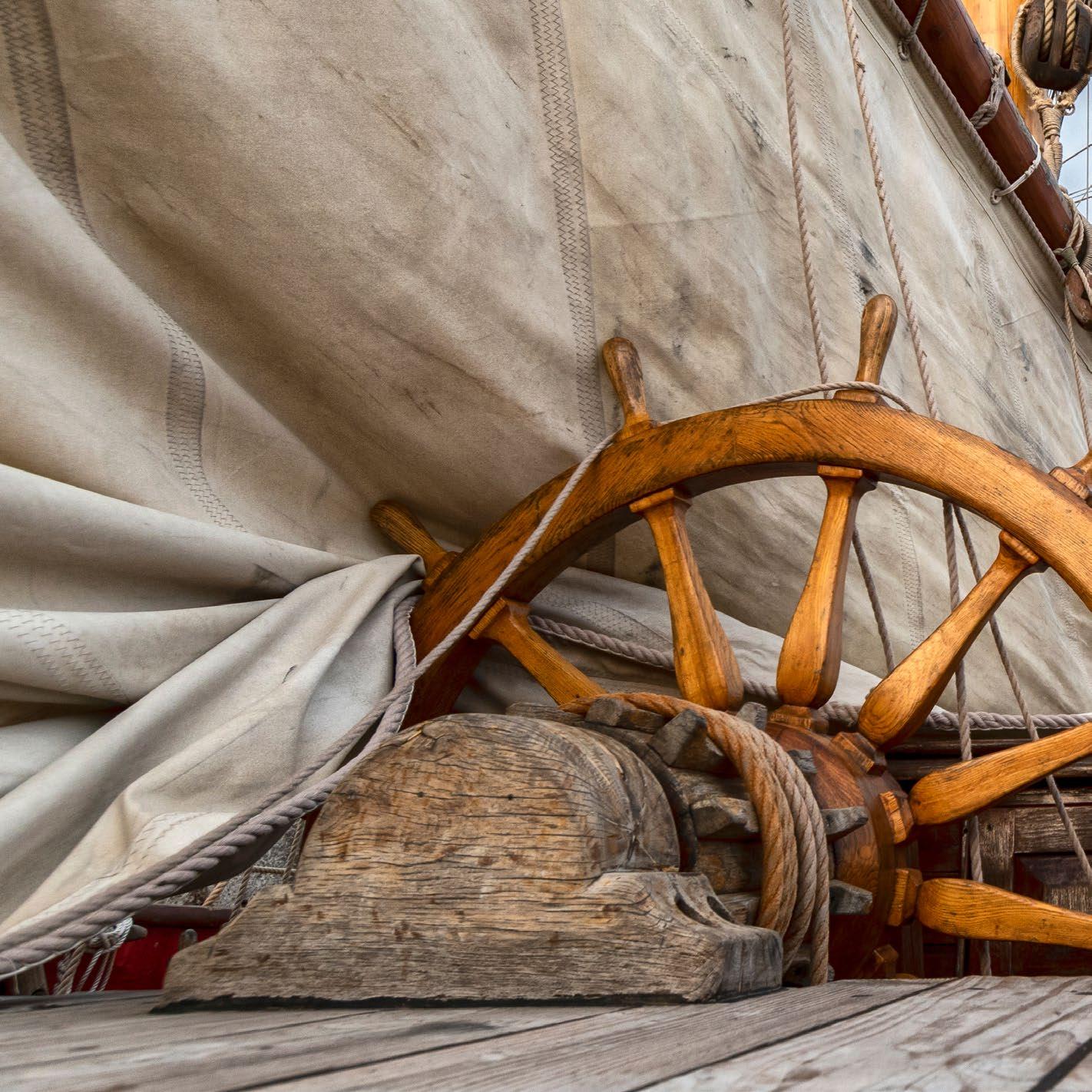
8

9
ARTIST UNKNOWN
(Australian School, 19th century)
Dunbar Wrecked at South Head, Sydney, August 20th 1857

watercolour signed indistinctly lower right 35 x 55cm
$500–1,000
1
1 10
A historically significant solid brass cup made from the bolts of the wreck of The Dunbar, Sydney, soon after the tragedy on August 20, 1857, Australian, dated 1857

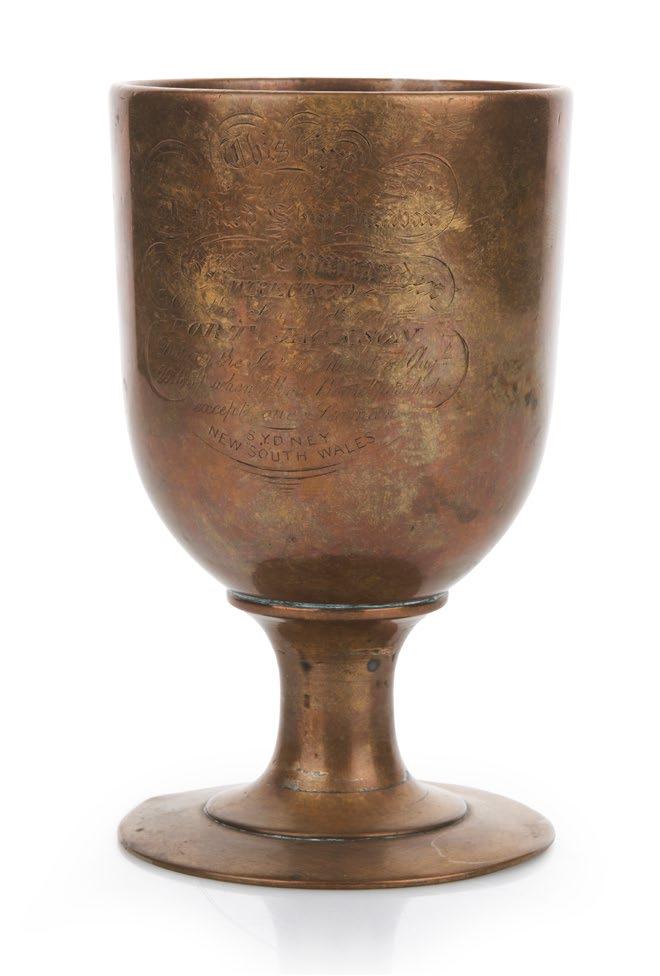
12.5cm high, 8cm diameter at rim
Sold with a copy of The Fatal Lights by Tom Mead, Dolphin Books, Sydney, which tells the incredible and sad story of the Dunbar.
PROVENANCE
The private collection of Mr John Williams, sold Christie's, Sydney
$2,000–4,000
The 1850s were years of great social and economic growth in Australia, spurred on by the Australian gold rushes and corresponding increase in population, agriculture, industry and commerce. As the demand for goods and services grew, so did the demand for passenger and cargo ships. This persuaded Scottish shipowner and merchant Duncan Dunbar to order a series of hardwood clipper ships from the English shipbuilder James Laing and Sons of Sunderland, England, to cater for the new Australian trade. Credited with introducing the American-style clipper ship to the Australian run, Duncan Dunbar named the various clippers after his family including Phoebe Dunbar, Dunbar Castle, Duncan Dunbar and the Dunbar.
Built in 1852, the cooper-sheathed, three-masted sailing ship Dunbar cost over £30,000 and was designed to carry passengers and cargo quickly between England and Australia. The Dunbar was first requisitioned by the Royal Navy however, for use as a troop carrier during the Crimean War, so it wasn't until 1856 that it made its first visit to Port Jackson.
2
2 2 (Detail) 11
On 31 May 1857 the ship departed Plymouth for its second voyage to Australia, carrying 63 passengers, 59 crew and a substantial cargo, including dyes for the colony's first postage stamps, machinery, furniture, trade tokens (coins privately issued by traders and manufacturers as change and to promote their business), cutlery, manufactured and fine goods, food and alcohol. Many of the first-class passengers were prominent Sydneysiders, local 'currency' that had made it in the colonies and who, after a visit 'home' to England, were returning to Australia.
Dunbar's master Captain Green was a veteran of eight visits to Sydney, as first mate aboard the Agincourt and Waterloo, then as commander of Waterloo, and again commanding Vimeira and Dunbar. After a relatively fast voyage of 81 days, Dunbar arrived off Port Jackson on the night of Thursday, 20 August 1857, with a rising gale and bad visibility. The Macquarie Light on the cliff top a mile south of South Head was seen between squalls, although the night was dark and the land was invisible. Shortly before midnight Captain Green estimated the ship's position off the entrance to the Heads and changed course to enter, keeping the Macquarie Light on the port bow.
Captain Green then ordered a blue light to be burnt to summon the Sydney Harbour pilot. According to the only survivor – a sailor on watch at the time who became the sole source of information about events on board – the urgent cry of 'Breakers ahead!' was heard from the second mate on the forepeak. Captain Green gave the order 'Port your helm!' to swing the ship to starboard while the watch braced the sails. It was already too late. Captain Green's orders instead drove the vessel broadside onto the 50-metre-high cliffs just south of the signal station at South Head, midway between the Macquarie Lighthouse and The Gap. The impact brought down the topmasts, mounting seas stove in the lifeboats and the Dunbar heaved broadside to the swells. Lying on its side, the ship began to break up almost immediately. The mizzen and main masts crashed over the side but the foremast remained standing.
One crewman, James Johnson, found himself in the poop clinging to the mizzen chains. Unable to cross the deck, which was being swept by each successive wave, he went below and made his way forward before climbing out of a cabin skylight and onto the chain plates of the surviving foremast. When the foremast finally gave way, Johnson was hurled onto the cliffs where he managed to gain a finger hold. Scrambling higher, he became the sole survivor amid a sea of bodies. All 63 passengers and the remaining 58 crew perished in the disaster.
When dawn came, Johnson found himself on a rocky ledge some 10 feet above the wreck, surrounded by wreckage and dead bodies. From here he climbed up out of the reach of the waves and remained on the cliff face until being rescued on 22 August.
Dawn had unveiled the enormity of the event to the community of Sydney. Thousands were drawn to the scene of the wreck over the ensuing days to watch the rescue of Johnson, the recovery of the bodies and the salvage of some of the cargo. For days afterwards the newspapers, journals and local guides were filled with graphic descriptions of the wreck – and of the public's interest in the horrible 'spectacle'.The rumours as to the fact of a dreadful shipwreck having just occurred soon assumed distinct shape and certainty. At length it generally became known in Sydney that numerous dead and mutilated bodies of men, women and children were to be seen floating in the heavy surf at the Gap thrown by immense waves at a great height; and dashed pitilessly against the rugged cliffs, the returning water sweeping them from the agonised sight of the horrified spectators.
To some, this spectacle would have been one of morbid curiosity, something to record in a diary or in a letter home to relatives in Europe, but to many, many others, once the wreck had been identified as the Dunbar, it would have been the need to identify or possibly recover the body of a father or mother, sister or brother or friend, that drew them to the scene of the disaster.
For the Dunbar was not just another ship carrying unknown immigrants starting a new life in Australia. On board were many local residents returning to the colonies after a visit to the old country, including eight members of the Waller family; Mr and Mrs Peek; Mrs Egan, the wife of the Sydney MP Daniel Egan; and Mr and Mrs Cahuac, son and daughter-inlaw of the former Sheriff of Sydney.
Also on board were family members migrating from Europe to join family members in Australia such as the two Miss Hunts, the only sisters of Robert Hunt, the First Clerk of the Sydney Branch of The Royal Mint, who was a well-known colonial scientist and photographer.
Seventeen bodies, including some mutilated by sharks, were recovered on the north shore of Sydney Harbour from the Mosman Spit around to Taylors Bay. Some were identified immediately by names on their clothing or by personal appearance. But others were so badly mutilated they could not be recognised.
At Middle Harbour, the majority of the wreckage of Dunbar appeared to have drifted ashore, along with several bodies: The shore is literally white with candles, and the rocks covered or so deep with articles of every kind – boots, panama hats and bonnets are here in abundance. Drums of figs, hams, pork, raisins, drapery, boots and pieces of timber are piled in heaps along with the keel of the Dunbar.
SYDNEY MORNING HERALD, 23 AUGUST 1857
Never before, and probably never since, had a shipwreck off the coast of New South Wales had such a traumatic and long-term effect on the people of the colony.
12
AUSTRALIAN SCHOOL
(Early 20th century)
Alpha at sail off Sydney harbour oil on board
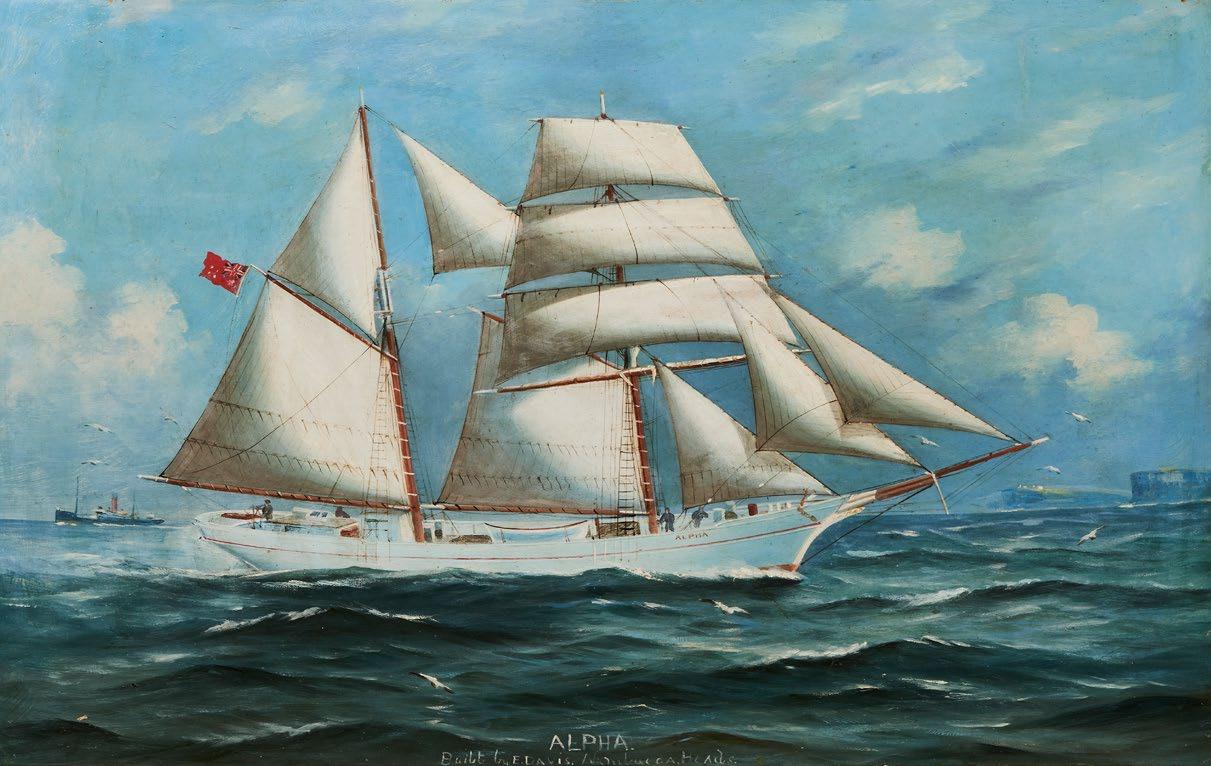
Titled to lower centre Alpha built by E Davis Nambucca Heads
44 x 61cm
$500–800
3
3 13
4 A. TWIGG (Australian, early 20th century)
Steamer at sea oil on board signed lower right 40 x 61cm
$400–600
5 A. TWIGG (Australian, early 20th century)
Two steamers at an estuary oil on board signed lower right 39 x 59cm
$500–800
6 A. TWIGG (Australian, 19th century)
Steamer Jenny Lind off a coast oil signed lower right and the vessel named to its fore 39 x 60cm


$400–600
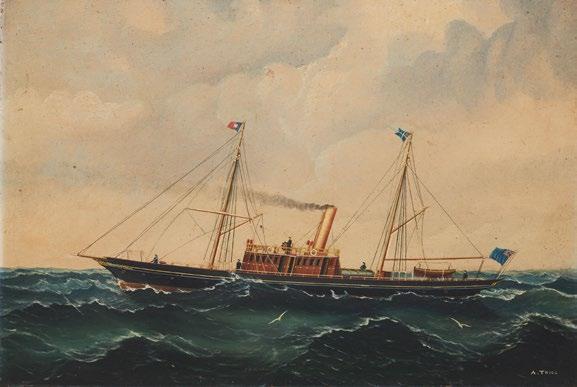
4 5 6 14
7
JOHN
Watsons Bay and the Heads, Sydney, NSW, 1863
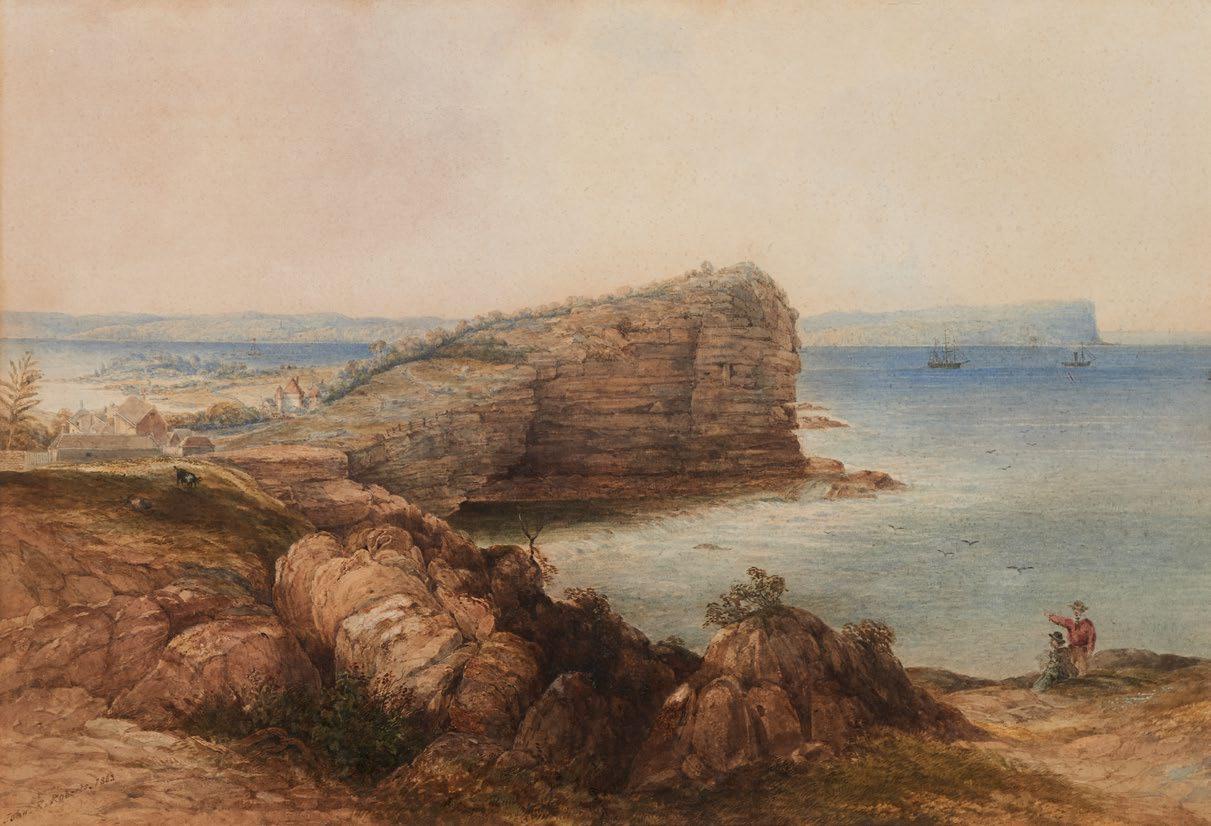
watercolour on paper signed and dated 1863 lower left in original Robin Hood musk-wood label to verso 34 x 52.5cm
PROVENANCE
Davidson Auctions, Australian & International Art, Sydney, 08/03/2008, Lot No. 53 (Sold $20,000 hammer) $7,000–10,000
RIDER ROBERTS (Australian, c.1820-1865)
7 15
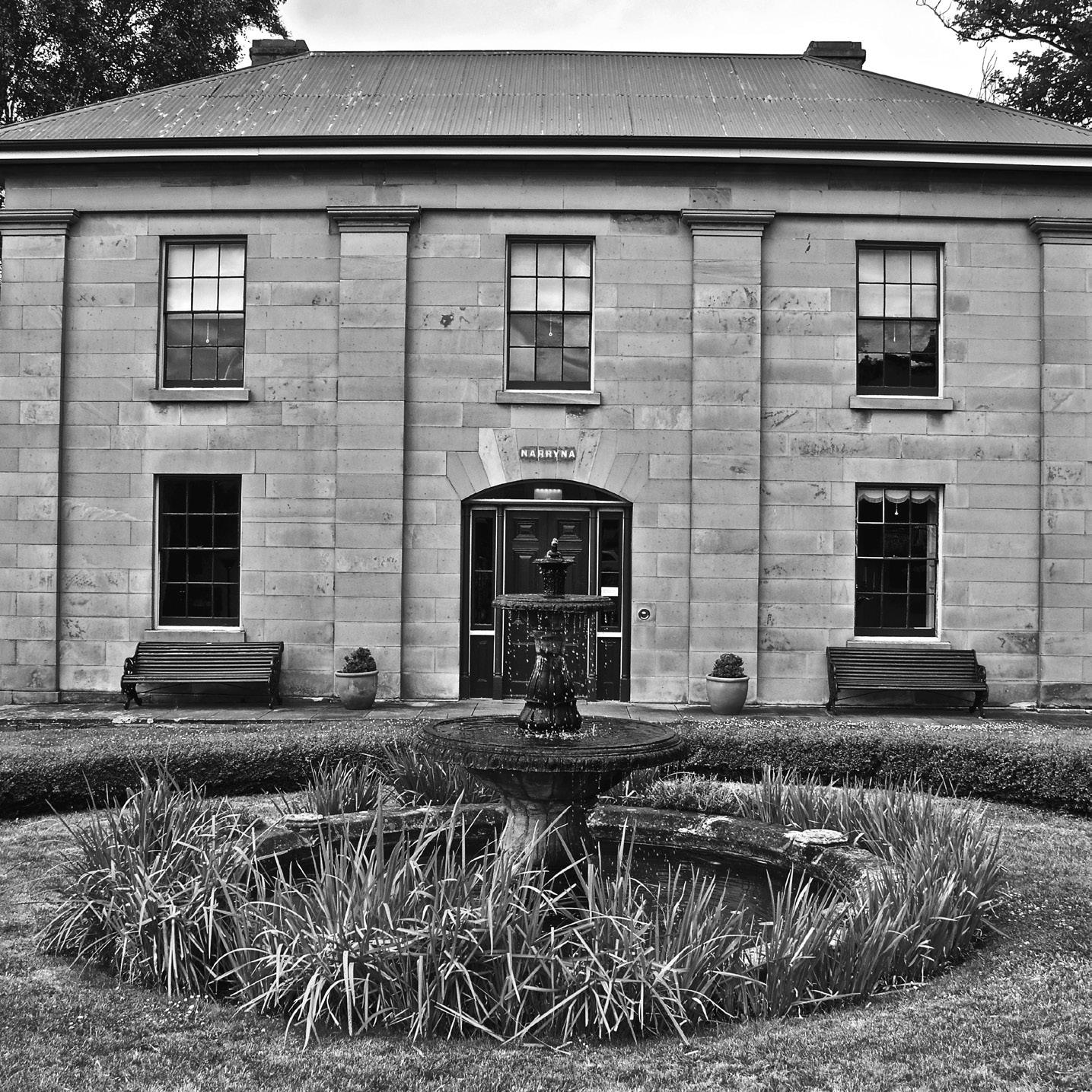
16
An important early Colonial cedar double-end sofa, Tasmanian, circa 1825 on turned and reeded legs with rosette carved back and scroll decorated arms 222cm long, 67cm deep, 96cm high

PROVENANCE
The Walsh Bowkett Family Tasmania
Acquired at the auction of The Harry and Christine Wright Collection, Gowan's, Tasmania. 2005 lot 726 (AUD$22,000 hammer)
The opposing twin sofa is illustrated in “Memories A Survey of the Australian Furniture in the Collection of the Lord McAlpine of West Green by Graham Cornall and is now in the collection of the National Gallery of Australia.
$10,000–15,000
8
8 17
9
A fine sterling-silver mounted emu-egg presentation bowl and cover, makers mark of William Edwards, Australian, 19th century
gilt interior, a pair of emus as the final and parrot finials to the handles, stamped WE makers mark, emu and kangaroo marks
27cm high, 20cm wide
$6,000–9,000
10
A fine white-metal mounted emu egg presentation inkwell, by William Edwards, Melbourne, Australian, 19th century emu finial and angular handles
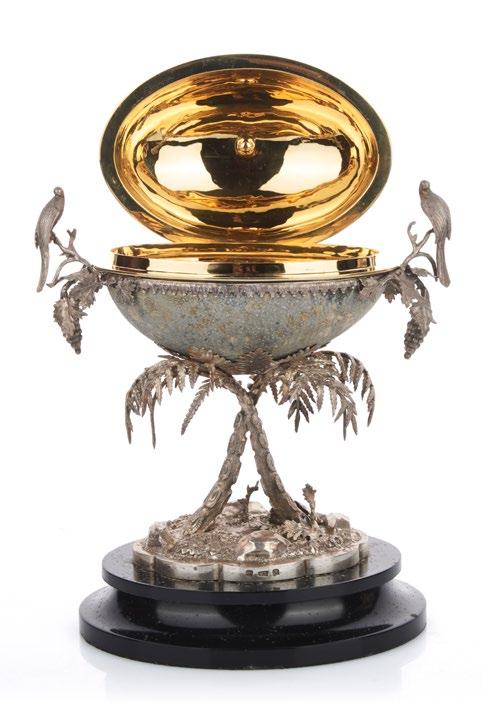
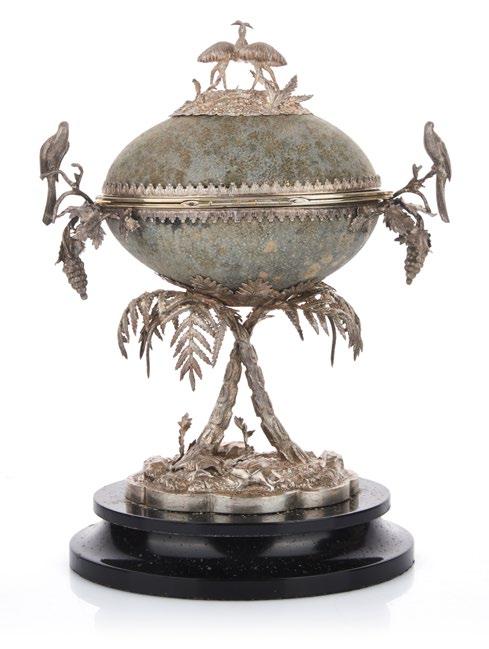
Acquired by the vendors from Bolli and Romiti Auctions, Rome, Italy, 30 October 2018, lot 159

17cm high, 11.5cm wide across the handles
REFERENCE
Nineteenth Century Australian Silver, J.B. Hawkins, Vol 1, Page 238, plate 194/195 for related designs of inkwells by William Edwards.
$1,500–2,500
9 9 10 18
A fine pair of carved cedar hall chairs, Australian, circa 1835
47cm wide, 40cm deep, 88cm high $3,000–5,000
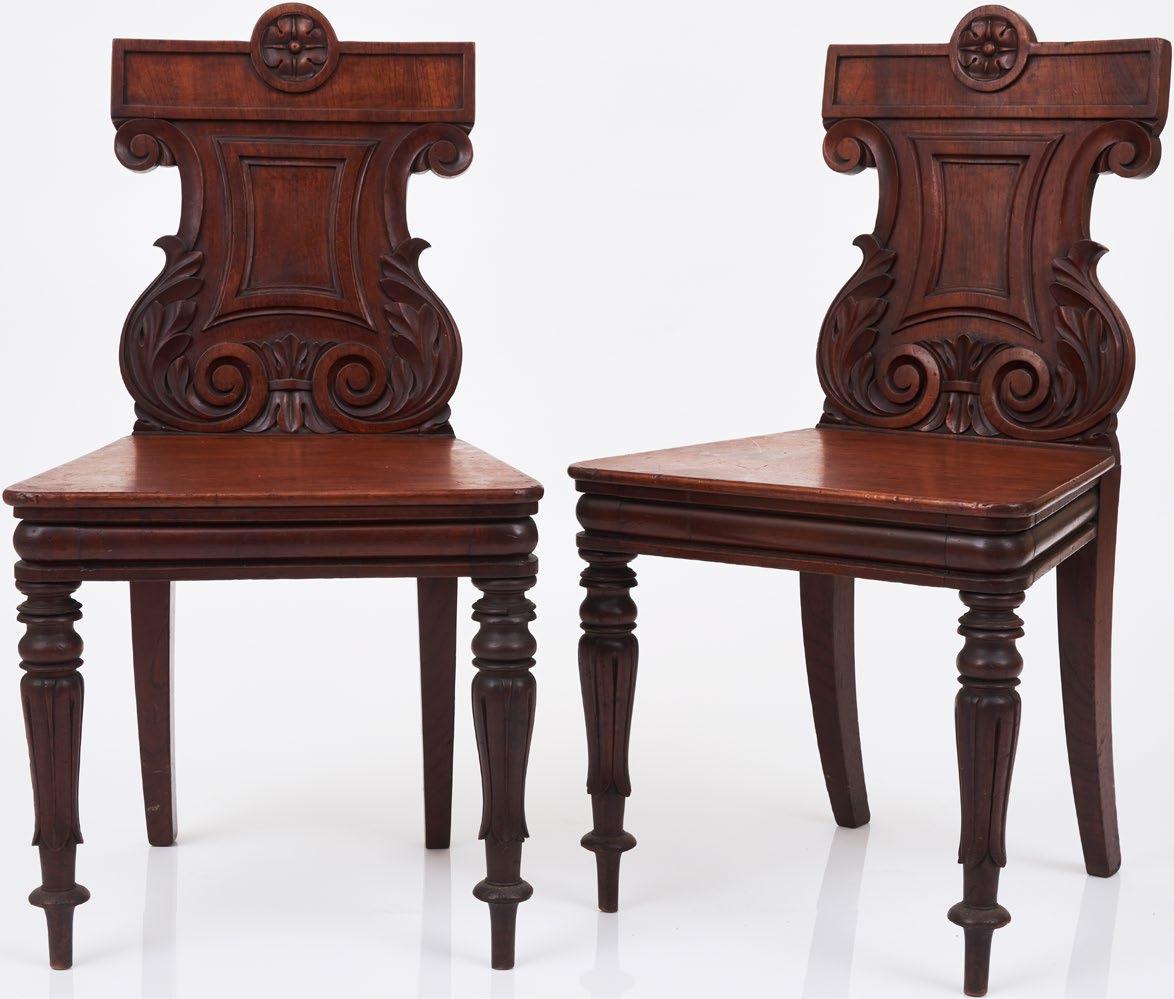
11
11 19
12
ARTIST UNKNOWN
(Australian, 19th century)
Sydney Harbour showing Government House and Fort Macquarie oil on canvas with old label to verso, now illegible 45.7 x 71cm

PROVENANCE
Acquired by the vendors from John Williams Sydney, as the property of the late George Patterson of Sydney. Gowrie Galleries Sydney label to verso
$3,000–5,000
12 20
A magnificent and early cedar dining table, Australian, circa 1835 a sixteen leg drop leaf sectional table with two extension leaves and centre section with drawer at either side with original brass handle; edge stringing on bottom of skirt and running through leg blocks. Comfortably seats twelve with extensions

137cm wide, 75cm high and approx. 310cm long fully extended
PROVENANCE
By descent to Lady Elizabeth Massy-Greene. Sydney
Mossgreen Auctions Tocal Hunter Valley November 29 2009 Lot 12
(Estimated at $10,000-15,000 it sold for AUD$164,910.00)
Lady Massy-Greene was the wife of John Brian Massy-Greene, the son of Sir Walter Massy-Greene, Knight Commander of St. Michael and St. George, who was an extremely distinguished politician who served as minister of defence in the Billy Hughes government 1921-1923.
$25,000–35,000
13
13 21
14
ALFRED. J. COFFEY (Australian, 1869-1950)
Summer beach scene – Women with Parasols oil on canvas signed and dated 1920 lower right 30 x 60cm
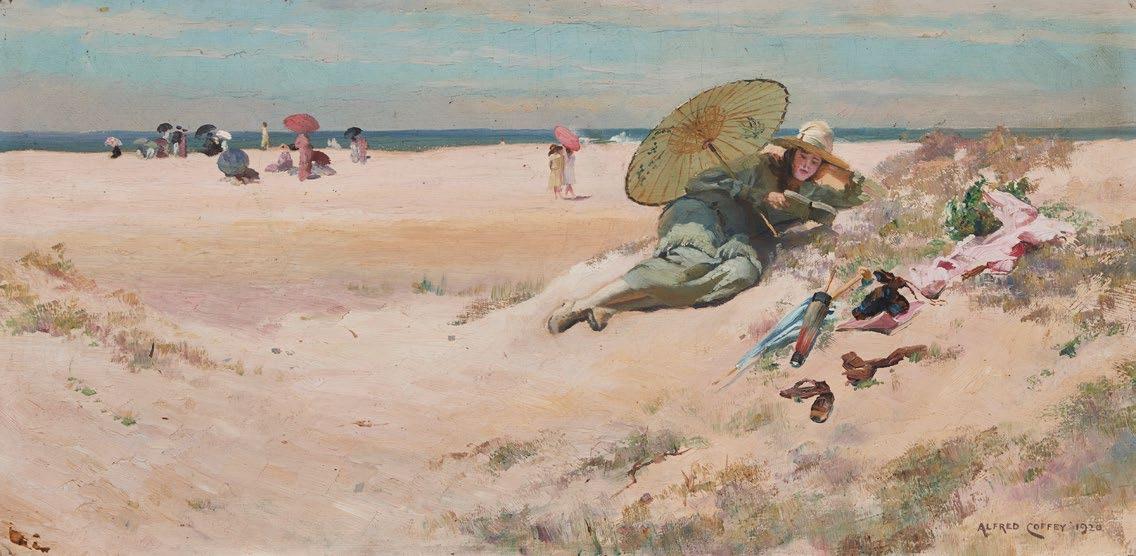
PROVENANCE
Sold as Ladies with Parasols on a Beach Goodmans Auctioneers, Australian & European Pictures, Sydney, 17/06/1997, Lot No. 666 (sold $5,000 hammer)
$4,000–6,000
15
ALFRED. J. COFFEY (Australian, 1869-1950)

Mr Coffeys Shack at Woy Woy (1) and (2) pair of watercolours each signed and dated 1916 each 24.5 x 10cm

PROVENANCE
Lawsons, Australian and International Paintings, Sydney, 25/07/2000, Lot No. 30 ($ 5,100 hammer)
$2,500–3,500
14 15 15 22
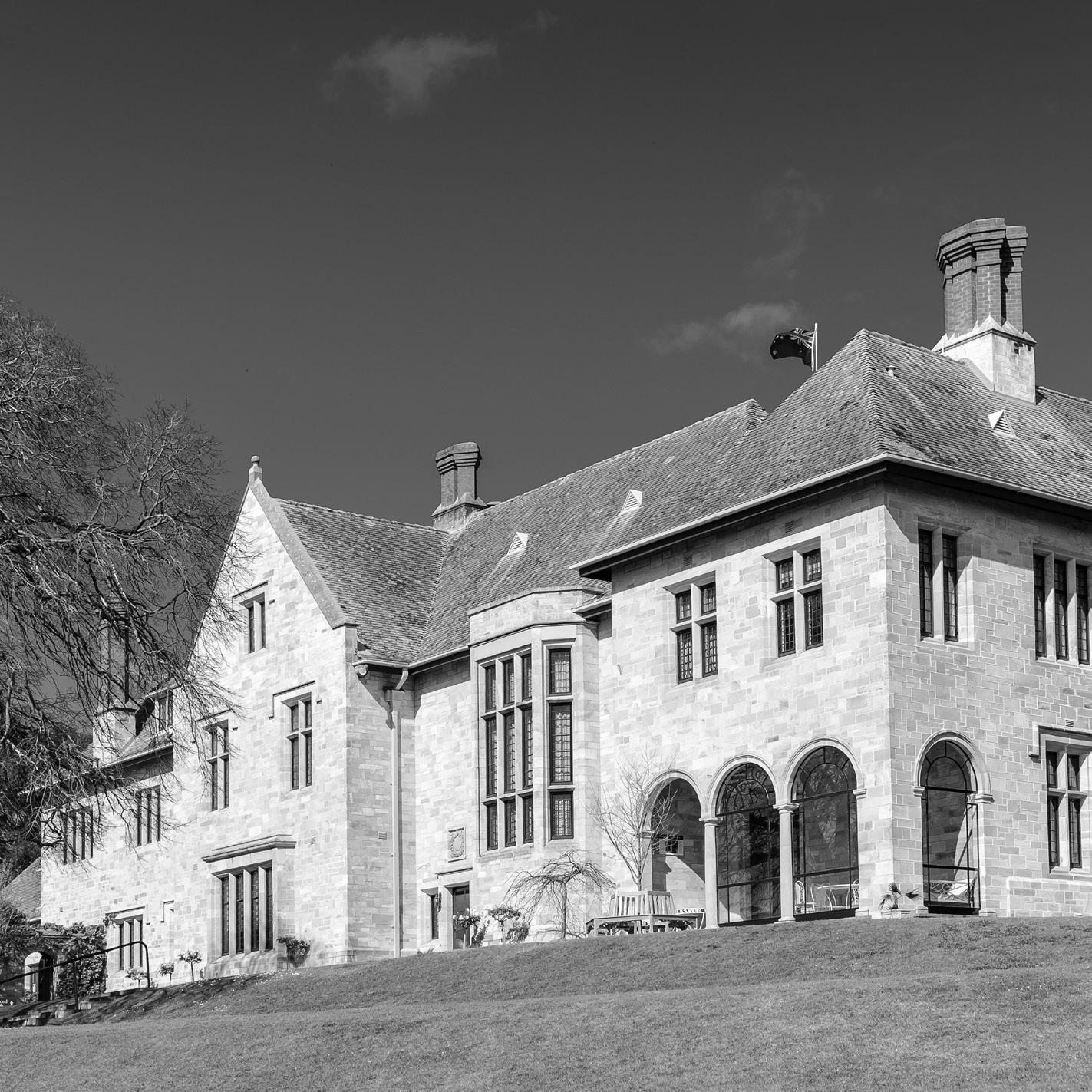
23
A fine silver and glass palm tree and figure with emu epergne, Australian, circa 1880

41cm high, base 20cm wide
PROVENANCE
Phillips Melbourne, 5 September 2004, Lot 293 Sold then with provenance from Stokes Australasia Ltd and sold as the work of Thomas Stokes.
$4,000–6,000
A fine silver inkwell centre-piece, Australian, circa 1880 with two glass inkwells suspended in the tree-ferns, apparently unmarked under glass dome 25cm high, 35cm wide on ebonised oval base, 36cm high overall, 31.5cm wide. Dome 45cm high, 36cm wide This piece was bought with an attribution to William Kerr, Sydney (1838-1896) although the design and the somewhat distinctive band of decoration around the foot-rim relates more to Steiner designs. See Nineteenth Century Australian Silver, J.B. Hawkins, Vol 2, Page 115/116/117, plate 368
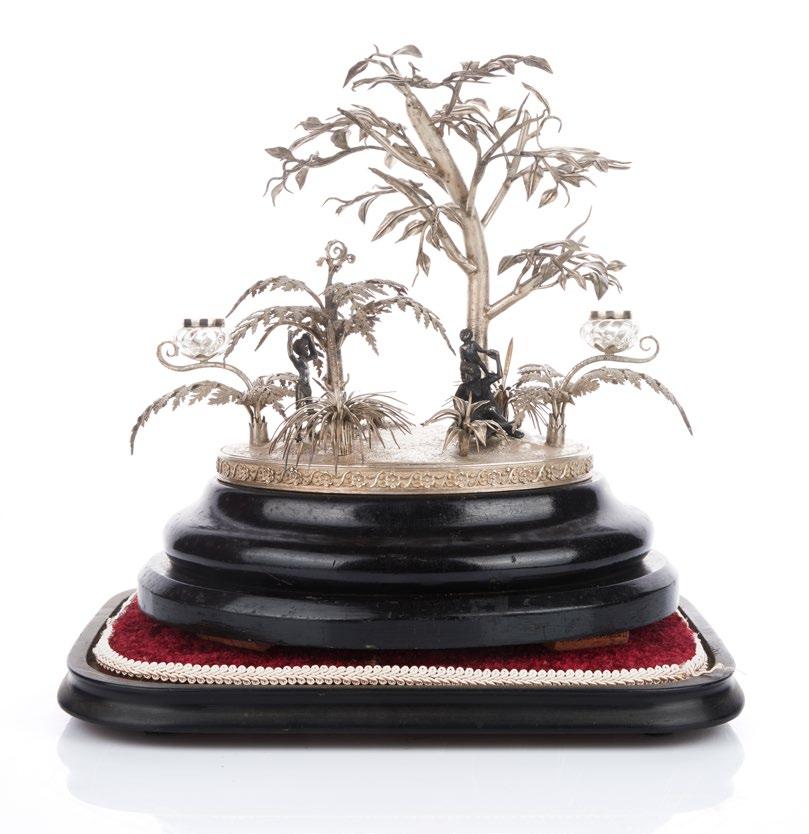
$6,000–8,000
An important Tasmanian Muskwood and specimen-wood exhibition table, Australian, circa 1835
120cm diameter, 72cm deep
PROVENANCE
Sotheby’s, Melbourne, October 1988 ($60,000)
$25,000–35,000
16
17
18
16 17 24
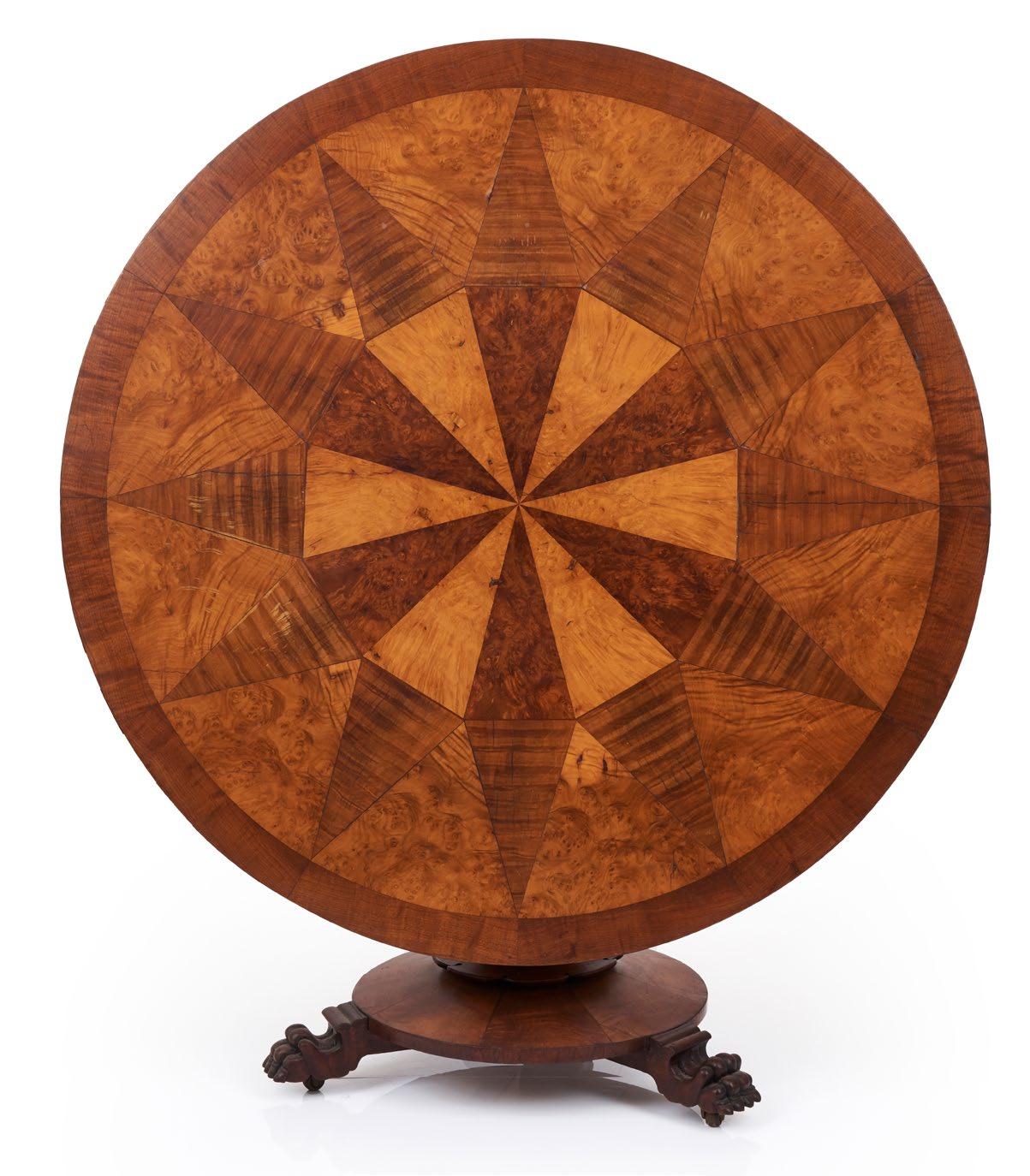

18 25
M.
S.
FITZGERALD
(Australian, 19th century)
A view of Sydney from the north-shore looking south oil on canvas signed lower left

34.5 x 53.5cm
PROVENANCE
Allpress Antiques
$4,000–6,000
19
19 26
A finely carved raised back cedar chiffonier, Australian, circa 1835 118cm wide, 52cm deep, 162cm high
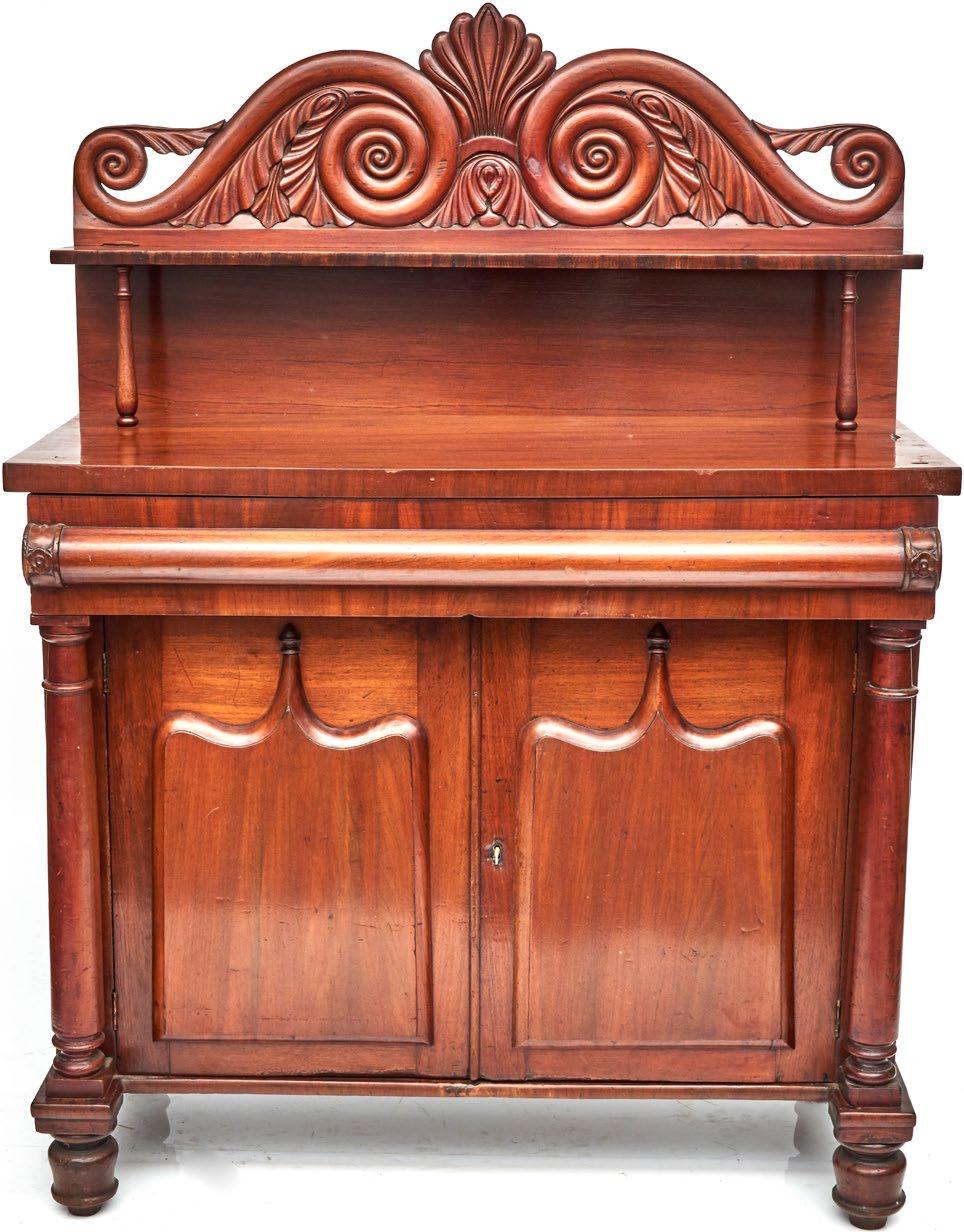

REFERENCE
For a similar chiffonier see: Australian Furniture Pictorial History and Dictionary 1788-1938, Kevin Fahy and Andrew Simpson, Casuarina Press, Sydney, page 286, No 235.
$3,000–5,000
20
20 27
21
GOTHER VICTOR FYERS MANN (Australian, 1863-1948)
Old Sydney-Cumberland Street, 1901 oil on canvas
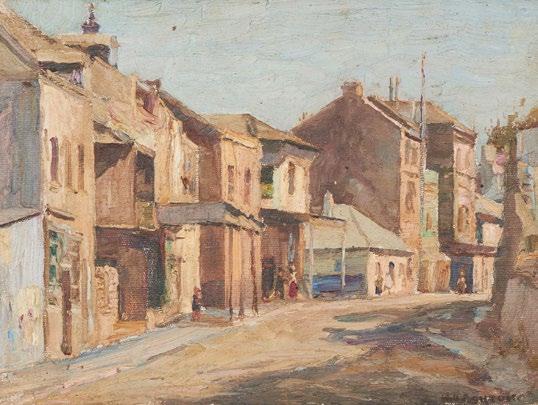
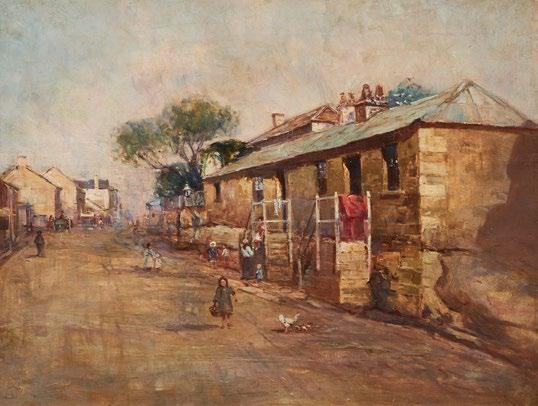
Provenance
DR JOHN RAVEN
Christie's, Sydney 6/10/1976 lot 305
Davidson Auctions, 15 September 2019, lot 1273 ($4,500 hammer)
34 x 44cm
$2,000–3,000
22
SIR JOHN WILLIAM ASHTON (Australian, 1881-1963)
Sydney street scene oil on board signed lower right 24 x 32cm
$800–1,200
23
WEIR, WILLIAM DOCHERTY (Ireland/Australia 1863-1903)
Manly Beach, Sydney watercolour titled and detailed to verso
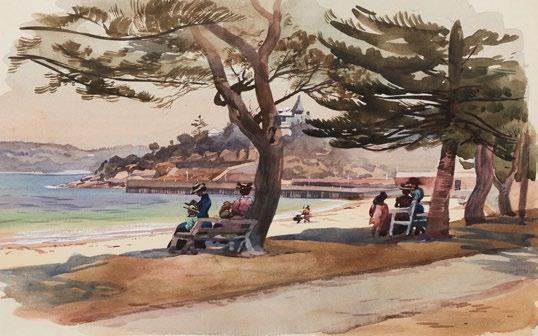
PROVENANCE
By descent to the artist grand-daughter
Mrs Ann Johnson, Bangor, Co. Down
Bill Morrion, Cleft gallery Donaghadee Private collection, Ireland
Whytes Auctioneers, 27 May 2006, lot 314 24 x 36cm
$600–900
21 22 23 28
A Colonial cedar elevated two part bookcase/display cabinet, Australian, circa 1845
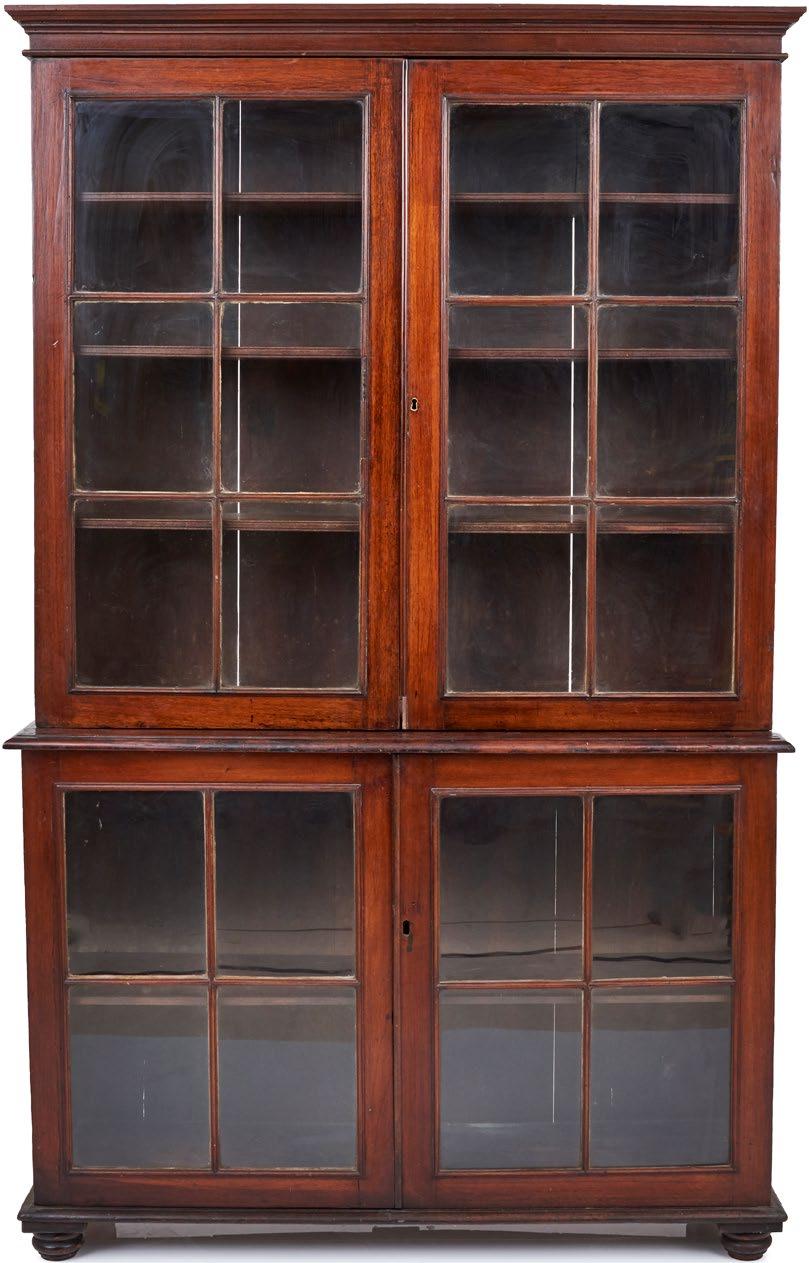
123cm wide, 37cm deep, 197cm high $4,000–6,000
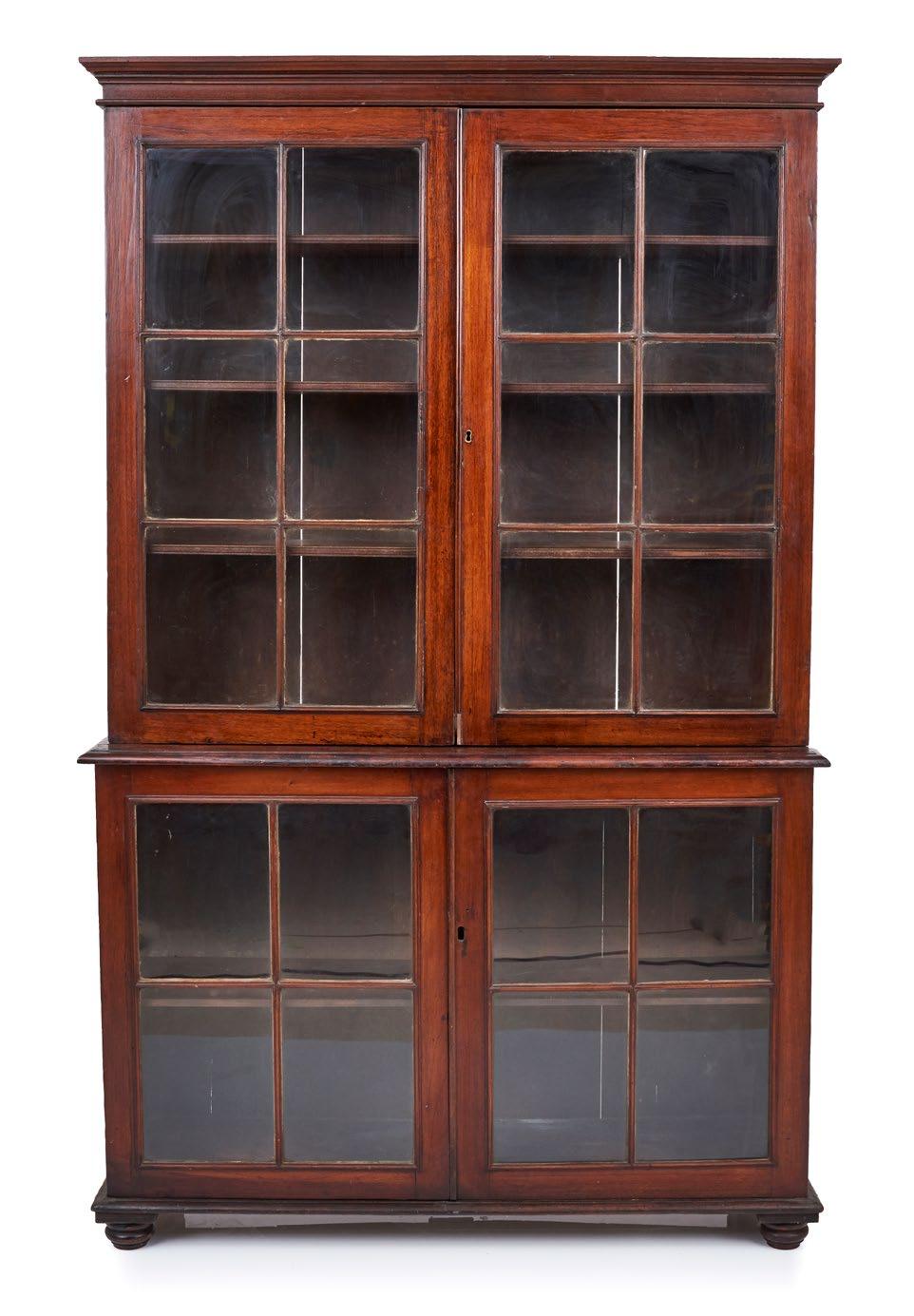
24
24 29
A Colonial three-tiered single-drawer whatnot, Australian, circa 1835

46 x 40 x 114cm high
$2,000–4,000
26
A set of three unusual and very large Georgian style cedar armchairs, Australian, circa 1845

95cm high, 71cm wide, 66cm deep
PROVENANCE
By repute Government House Hobart and sold at one stage by Tullochs Auctions, Tasmania. $2,000–3,000
25
26 25 30
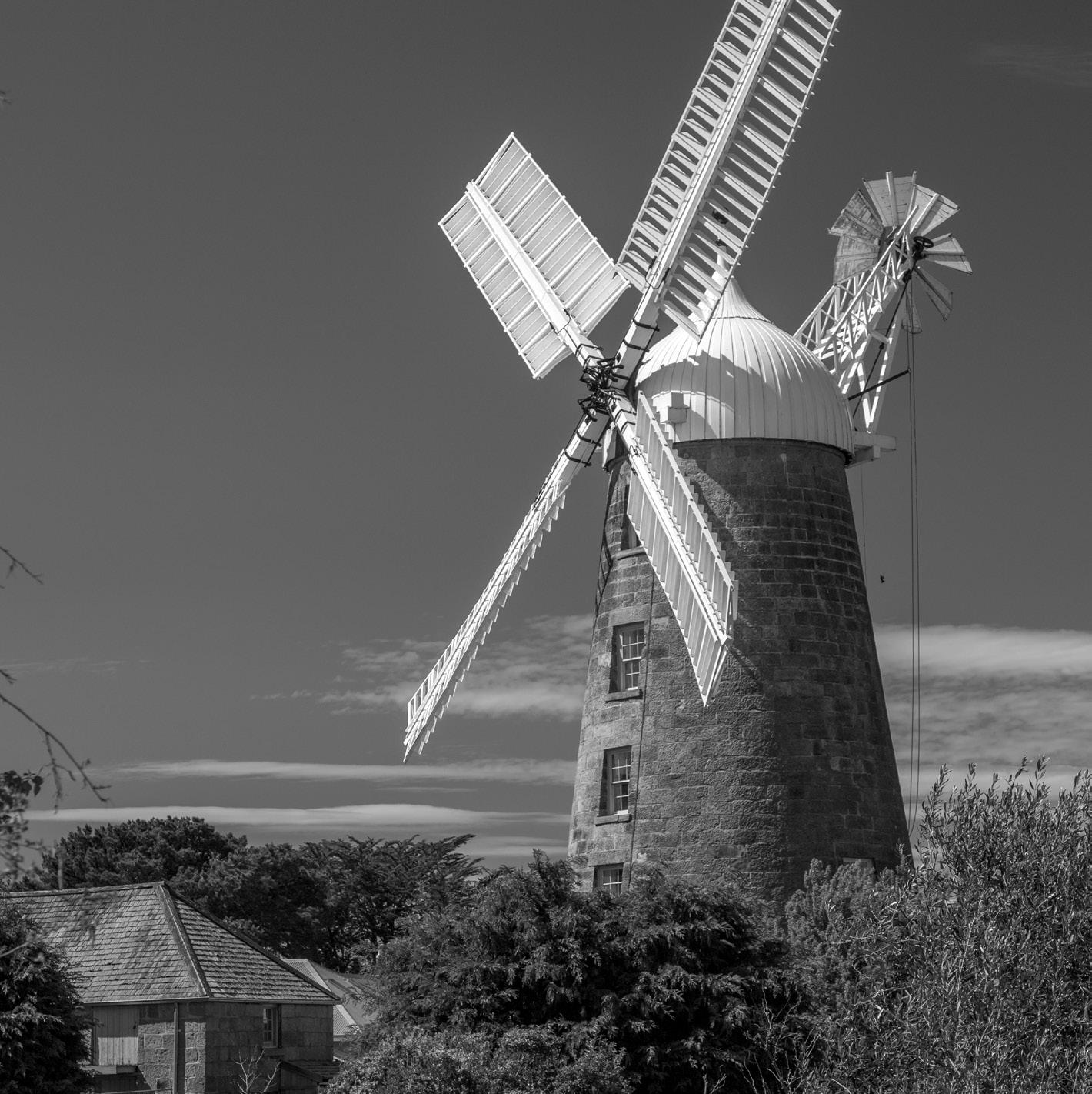
31
27
ARTIST UNKNOWN (Australian School, 19th century)
Sydney harbour (Mosmans Bay sic.) oil on board Signed Wynfield lower left

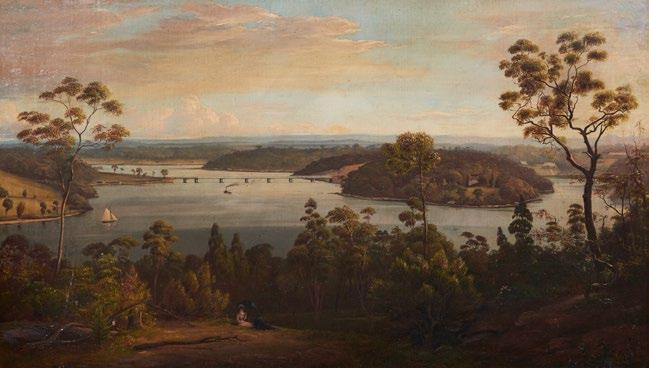
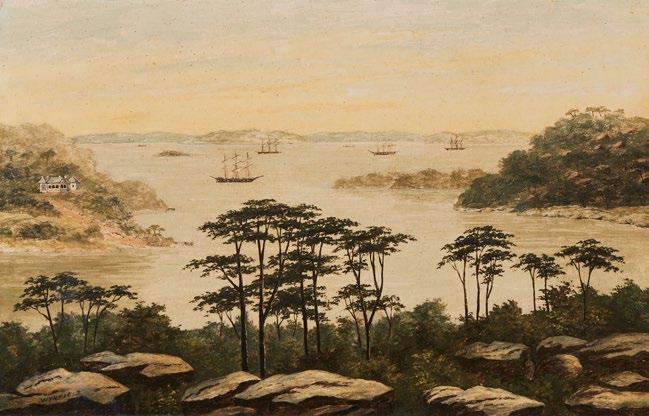
30 x 46cm
$1,000–2,000
28
GEORGE
(Australian, active 1860s-1880s)
Sydney Harbour Scene Oil on canvas signed lower left
PROVENANCE
Lawsons, Fine Art, Sydney, 28/09/2017, lot 574 ($7,000 hammer)
53 x 97cm
$3,000–5,000
29
JAMES
Sydney Harbour oil on board signed lower right
Webb’s Auckland label to verso
44 x 75cm
$3,000–5,000
F. HALSTEAD
HOWE CARSE (Australian, 1819-1900)
27 28 29 32
An Important colonial cedar Regency style elevated bookcase, Australian, circa 1835
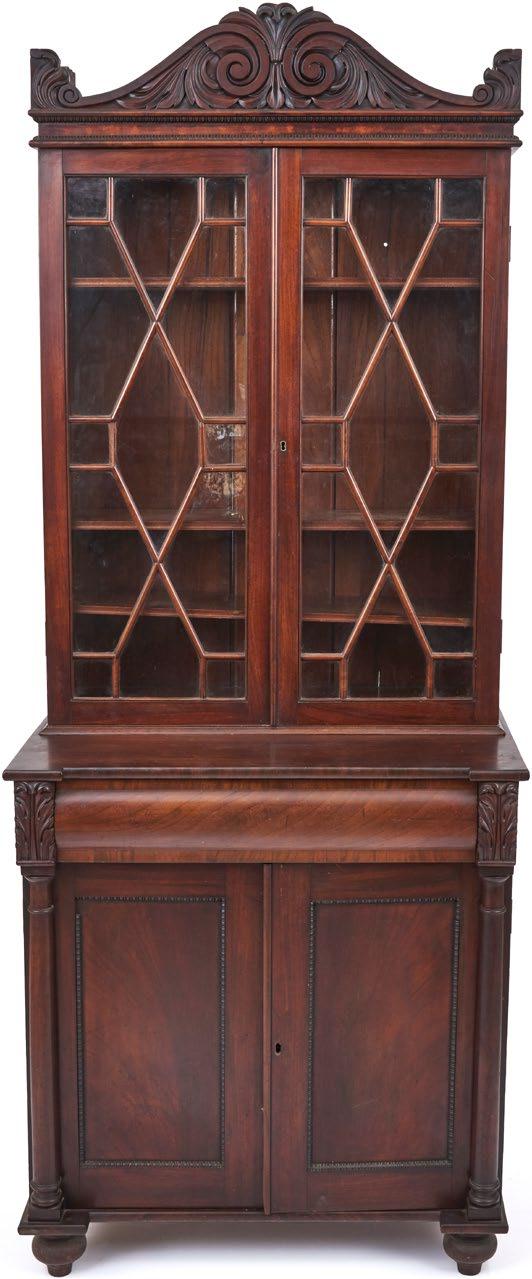

89cm wide, 53cm deep, 226cm high
PROVENANCE
Jeffrey Eager (1818–1891)
Third fleet Family of Australia
Thence by descent to the former owner
Acquired by the current vendor being at Goodman's, Sydney, September 2002 (AUD$20,000 hammer)
Believed to have come from Carthona, Darling Point, Sydney.
$12,000–18,000
30
30 33
An unusual silver and white-metal mounted black-wood and emu-egg inkstand, in the manner of Edward Fischer, Australian, 19th century vacant presentation cartouche stamped SS some of the components may be silver-plated 28cm wide, 17cm deep, 15cm high

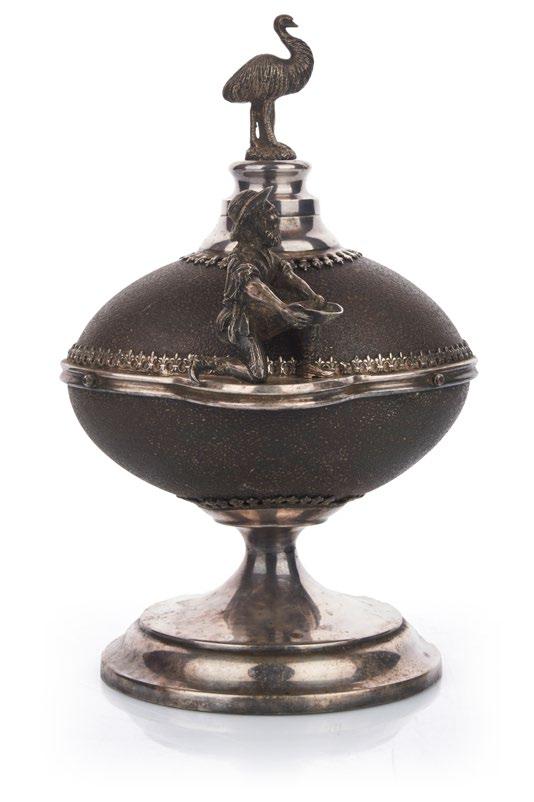

REFERENCE
Nineteenth Century Australian Silver, J.B. Hawkins, Vol 1, Page 303, plate 262 for a related design for a single-egg inkwell by Edward Fischer in the Geelong Gallery.
$1,500–2,500
31
31 32 33 34
A gilt white-metal emu-egg presentation bowl and cover, William Edwards, Melbourne, Australian, 19th century 18cm wide, 22cm high
PROVENANCE
Christie's, South Kensington, London, Sale 5256, Lot 1331
REFERENCE
Nineteenth Century Australian Silver, J.B. Hawkins, Vol 1, Page 241, plate 195 for a very similar example by William Edwards in The Altmann Collection, gifted to the National Gallery of Victoria. Another page 242, plate 1.
$5,000–8,000
An unusual white metal mounted emu-egg presentation inkwell, Australian, 19th century gold prospector and an emu mounted to the top section 23cm high, 15cm wide, circular base 11.5cm diameter
PROVENANCE
Lawsons, Sydney, 2 December 1984
The Collection of Graham and Elizabeth Cocks, Bonhams, Sydney, November 2012, Lot 181 ($,3800)
$1,000–2,000 34
A pair of cedar scroll pattern armchairs of elegant proportions, Australian, circa 1835 100cm high, 65cm wide, 66cm deep

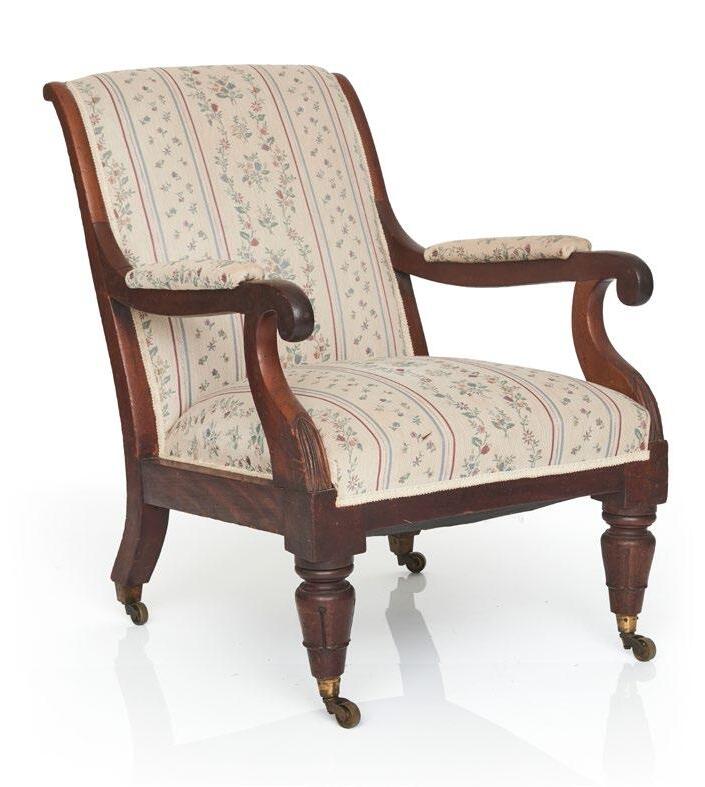
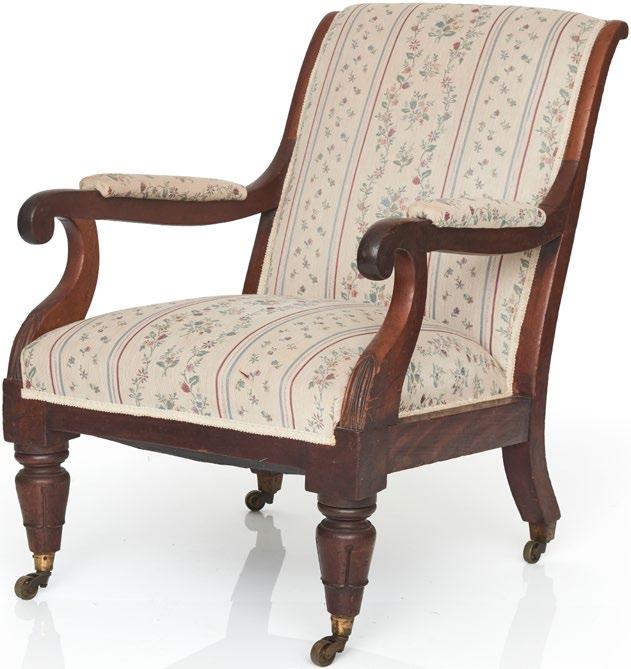
$4,000–6,000
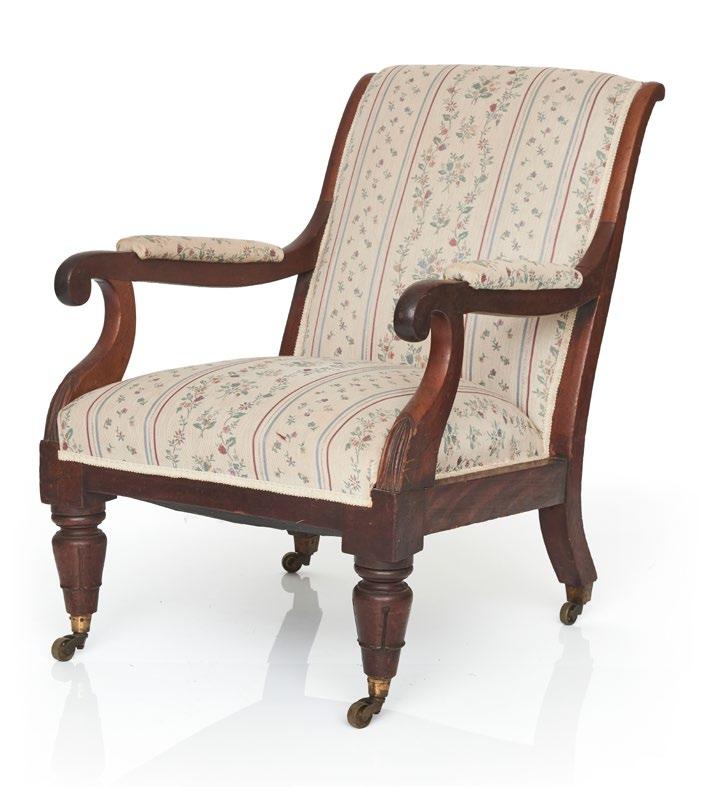
32
33
34 35
FEARNLEIGH
Fairy Hollow, Broken Bay, New South Wales oil on canvas signed and dated 1871 lower left further signed dated, titled, priced and guaranteed to verso in the artist's hand 45 x 90cm


$2,000–4,000
36
JOHN
Sydney Harbour from Middle Harbour with shipping
watercolour initialled JCH lower right 25 x 44.5cm
$500–1,000
37
Water-birds

watercolour signed and dated 1889 lower right 36 x 51cm
$500–1,000
35
L. MONTAGUE (American/Australia/New Zealand, c.1837-1892)
BARR CLARKE HOYTE (Australia/New Zealand, 1835-1913)
NEVILLE CAYLEY (Australian, 1853-1903)
35 36 37 36
An Important Colonial cedar and string inlaid secretaire-bookcase, New South Wales, circa 1845 with secretaire drawer and with ‘Grecian key’ pattern stringing throughout base 124cm wide, 253cm high, 67cm deep
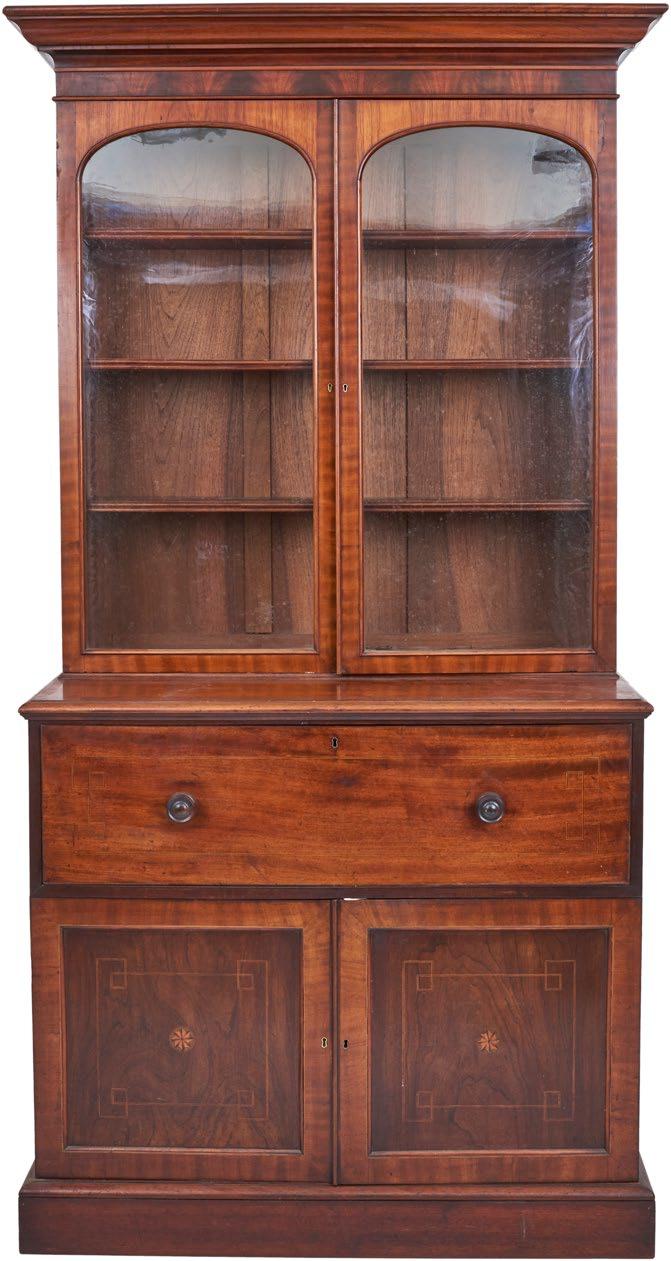
PROVENANCE
Sotheby's, Melbourne, August 2004, lot 416 ($35,000 hammer)
$15,000–25,000
38
38 37
JULIAN ROSSI ASHTON (Australian/British, 1851-1942)
Summer Holidays
oil on canvas
signed and dated 77 lower right
84.2 x 50.8cm
PROVENANCE
The Property of Mr Robert Griffiths, late of Highland Grove Stafford, Christie's, London, 23 February 1889, lot 4 (2.5 guineas to Corbury) Christie's London, Modern and Contemporary Australian Art Christie's, King Street London, 12 December 2007, lot 1 (58,100.00 pounds)
EXHIBITED
The Royal Society of British Artists 1877-1878, no 155 (52 pounds 10s) $80,000–120,000
Julian Rossi Ashton painted this work on the eve of his departure for Australia in 1878. Little was he to know then, as he set sail for distant shores, about the great influence he was to have on the history of Australian art.
On arriving in Australia, Ashton quickly made his mark and he was already teaching at The Art Society of New South Wales by 1885.
He went on to found the Sydney Art School in 1890 (from 1935 the Julian Ashton Art School) which tutored many of the leading Australian artists from the 1930's onwards, and which is now Australia's oldest continuous art school.
Prior to his emigration, Ashton had studied in London and at the Académie Julian in Paris. He had exhibited at the Royal Academy and at the Royal Society of British Artists from 1871. It was his work as an illustrator that led Ashton to be invited to Melbourne to work on David Syme's Illustrated Australian News.
Ashton exhibited works he had painted in England, befriended Louis Buvelot and Frederick McCubbin (dragging the latter out of his studio and up to Heidelberg) and painted on the Hawkesbury from 1884, becoming a central figure in the plein-air group there which included Charles Conder, A.H Fullwood, and many others (The Hawkesbury outings were forerunners of the famous artists' camps of the late 1880's and early 1890's).
Ashton had been a forerunner in England of the plein-air painting tradition, instigated in France, and he later credited himself with introducing 'plein-airism' to Australia:
"I had done a fairly large canvas of Merri Creek which I think is the first picture painted out of doors in the Commonwealth. Up to that time the artists did careful drawings in the open, and in the studio turned them into dull uninspiring pictures. I had but lately come from France with all the enthusiasm of the "plein-airists" who denounced any picture that was not painted out of doors"
Ashton yielded great influence in his day, not only as an artist, but also as a Trustee of the National Art Gallery of New South Wales (1889-1899) where he and the other trustee's organised the purchase of Sir Arthur Streeton's 'Still glides the stream and shall forever glide' which the AGNSW acquired in 1894. and which is now one the most famous and most loved Australian paintings.
39
38

39 39
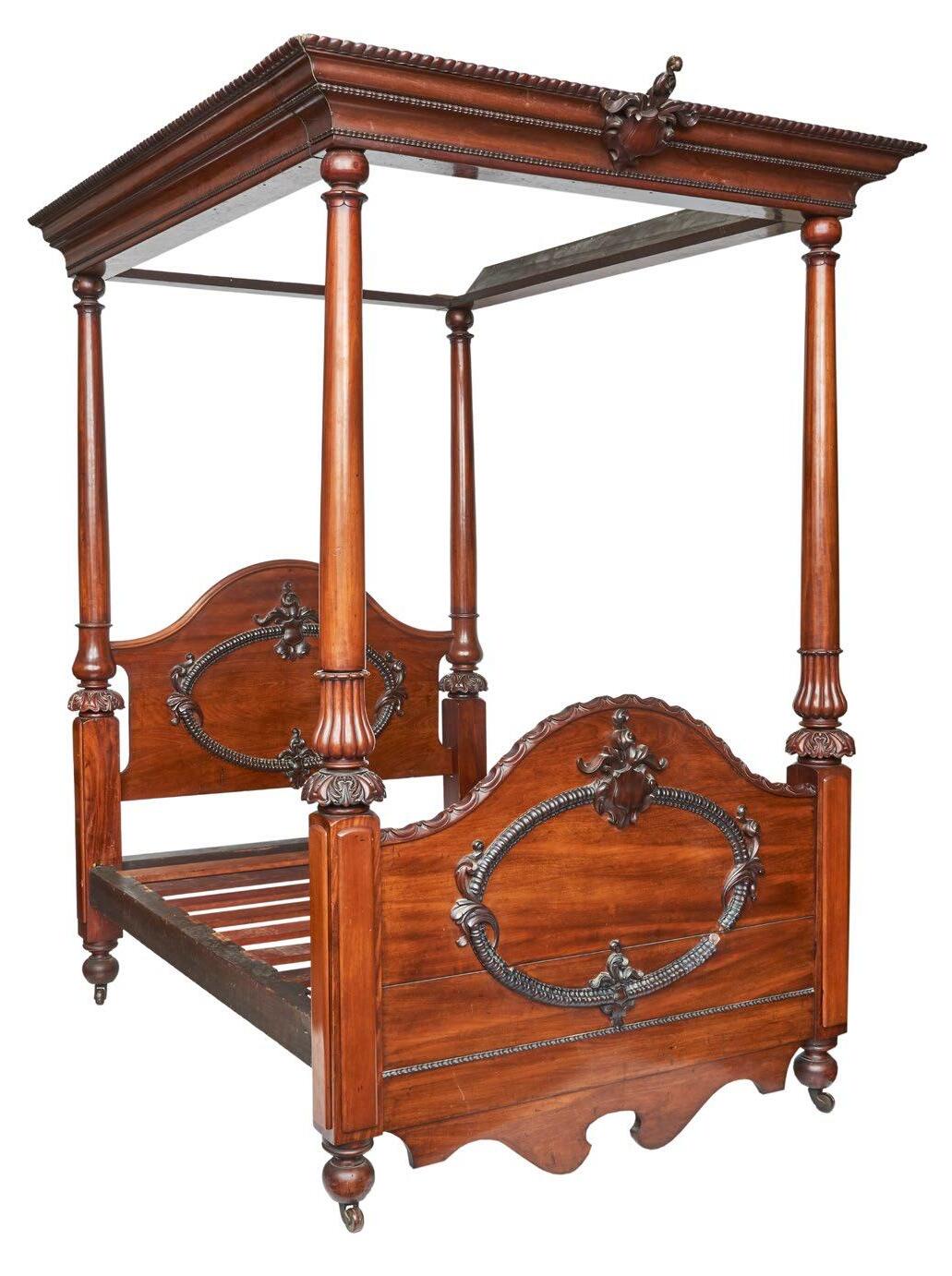
40 40
40
An impressive finely carved cedar and rose mahogany four-poster bed, Australian, circa 1845 with cartouche to the top foot-board 160cm wide, canopy approx 180cm wide
PROVENANCE
The collection of Graham and Elizabeth Cocks, Bonhams, Sydney November 2012, lot 198.
REFERENCE
Kevin Fahy and Andrew Simpson, Australian Furniture, Pictorial History and Dictionary 1788-1938, Casuarina Press, page 146, plate 8
$5,000–8,000
41
JULIAN ROSSI ASHTON
(Australian/British, 1851-1942)
Farmhouse Lady feeding chickens, 1895 oil on board signed and dated 1895 lower right Indistinctly titled in chalk to verso Farmhouse... Remains of old label now illegible 25 x 41cm
$8,000–12,000

41 41
CHARLES WELLINGTON FURSE (English, 1868-1904)
Portrait of the artist's wife and child oil on canvas
138 x 79cm
PROVENANCE
Cromwells Auctions, Sydney
$15,000–20,000
Charles Wellington Furse ARA (13 January 1868 – 16 October 1904) was an English painter who was born at Staines, the son of Jane Diana (Monsell) and the Rev. C. W. Furse, archdeacon of Westminster, and rector of St John's, Smith Square and descended collaterally from Sir Joshua Reynolds; and in his short span of life demonstrated such skill as a portrait and figure painter that he forms an important link in the chain of British portraiture which extends from the time when Van Dyck was called to the court of Charles I into the 20th century.
His talent was precocious; at the age of seven he gave indications of it in a number of drawings illustrating the novels of Sir Walter Scott. He attended public school at Haileybury College. He entered the Slade School in 1884, winning the Slade scholarship in the following year, and completed his education at Julian's atelier in Paris. Hard worker as he was, his activity was frequently interrupted by spells of illness, for he had developed signs of consumption, whilst still attending the Slade School. An important canvas called Cain was his first contribution (1888) to the Royal Academy, to the associateship of which he was elected in the year of his death. For some years before he had been a staunch supporter of the New English Art Club, to the exhibitions of which he was a regular contributor.
In October 1900 he married Katharine Symonds, the daughter of John Addington Symonds. She later became known as Dame Katharine Furse. The couple had two sons, Peter Reynolds Furse (in 1901), a Royal Navy Cartographer, and John Paul Wellington Furse (in 1904), later a Rear Admiral, painter and later plant hunter.
His fondness for sport and of an open-air life found expression in his art and introduced a new, fresh and vigorous note into portraiture. There is never a suggestion of the studio or of the fatiguing pose in his portraits. The sitters appear unconscious of being painted, and are generally seen in the pursuit of their favourite outdoor sport or pastime, in the full enjoyment of life. Such are the Diana of the Uplands (1903–04), the Lord Roberts (1893) and The Return from the Ride (1902) at the Tate Gallery; the four children in the Cubbing with the York and Ainsty, The Lilac Gown, Mr. and Mrs. Oliver Fishing and the portraits of Lord Charles Beresford and William Johnson Cory. His revealing portrait of a younger Charles Darling who as Mr Justice Darling was later to sit on the criminal appeal of Sir Roger Casement is in the National Portrait Gallery.
Nearly all of Furse's work shows a pronounced decorative tendency. His sense of space, composition and decorative design can best be judged by his mural decorations for Liverpool Town Hall, executed between 1899 and 1902. A memorial exhibition of Furse's paintings and sketches was held at the Burlington Fine Arts Club in 1906.
His granddaughter was U.S. Congresswoman Elizabeth Furse.
42
42
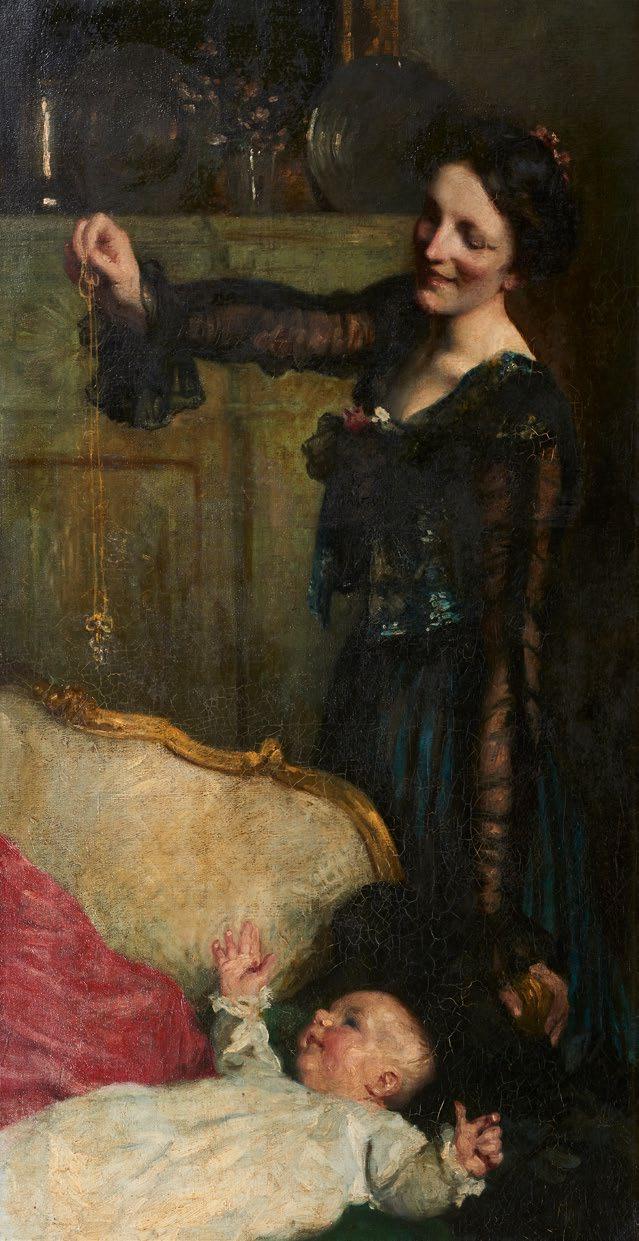
124 43
43
A Ricketty Dick International Exhibition medal, Sydney, 1873 2cm diameter
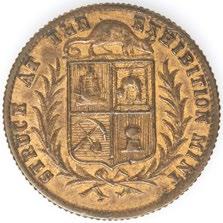
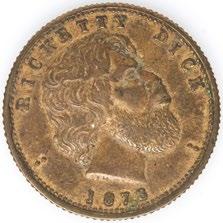
Quoting from Australian commemorative medals and medalets from 1788 L.Carlisle B and C Press 1983, p.13.
"The Aboriginal whose head is struck on this medal and others struck, both in Australia and overseas in the later part of the 19th century, was known as Ricketty Dick. This Australian native was born around 1798 an died in June 1863. He was well known to people who travelled along the New South Head road on their way to Watson's Bay. He camped on a dry patch of ground in the swamps of Rose Bay. In his later years he was looked after by W.C Wentworth"
More information on Ricketty Dick is available on request, see the additional online photos.
$200–300
44
A pair of silver-plated and emu egg cups by Evan Jones, incorporating the head of Ricketty Dick, Sydney, Australian, circa 1880

16.5cm high, 9.5cm diameter at rims
PROVENANCE
Acquired by the vendors in the UK at auction Andrew Smith and Sons, Hampshire, circa 2020 (1900 pounds hammer)
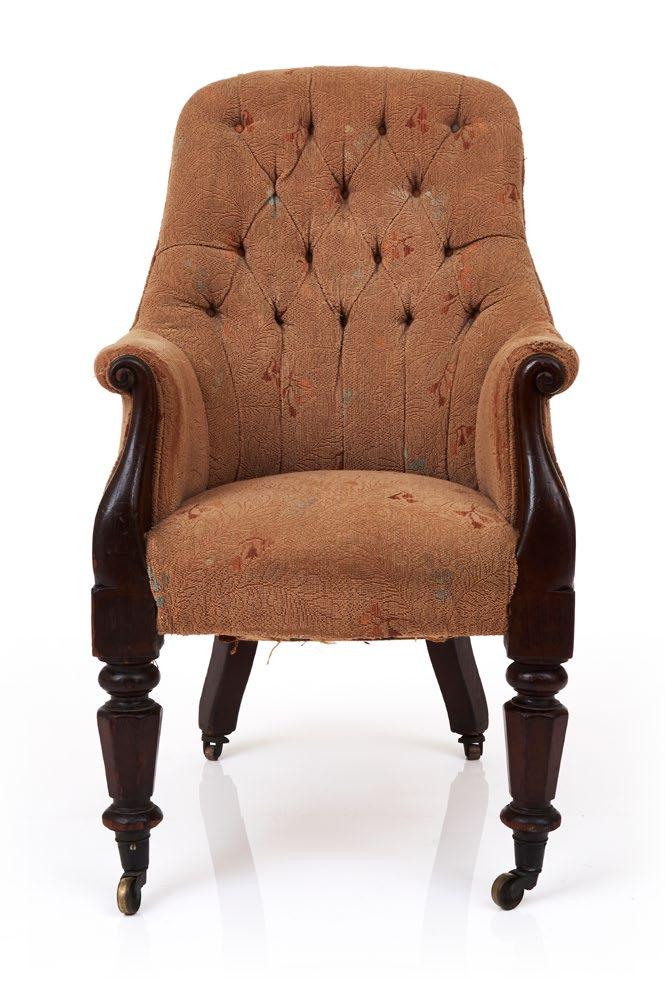
REFERENCE
Nineteenth Century Australian Silver, J.B. Hawkins, Vol 1, Page 159, plate 126 for a candlestick of related design.
$1,000–1,500
45 43 44 44
A very rare and elegant fully upholstered cedar lady's armchair, Australian, circa 1835
58cm wide, 100cm high
$3,000–5,000
A finely figured and patinated cedar two-door wardrobe, Australian, circa 1830
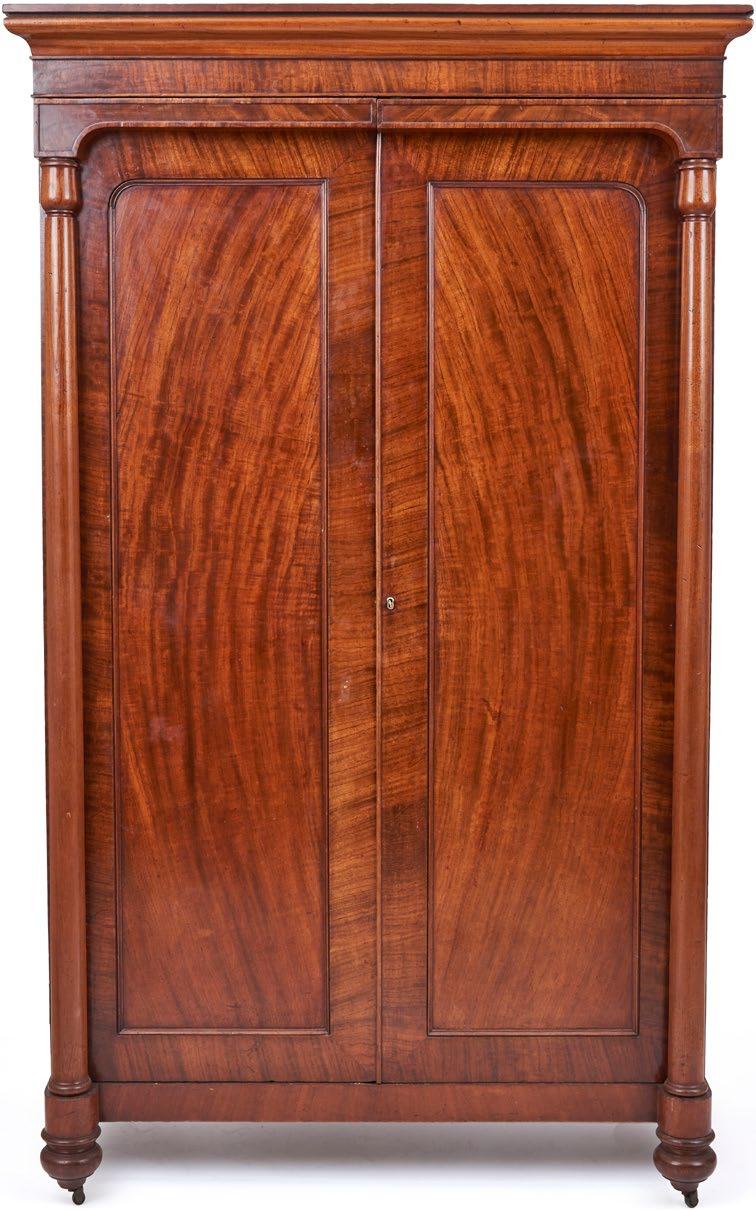
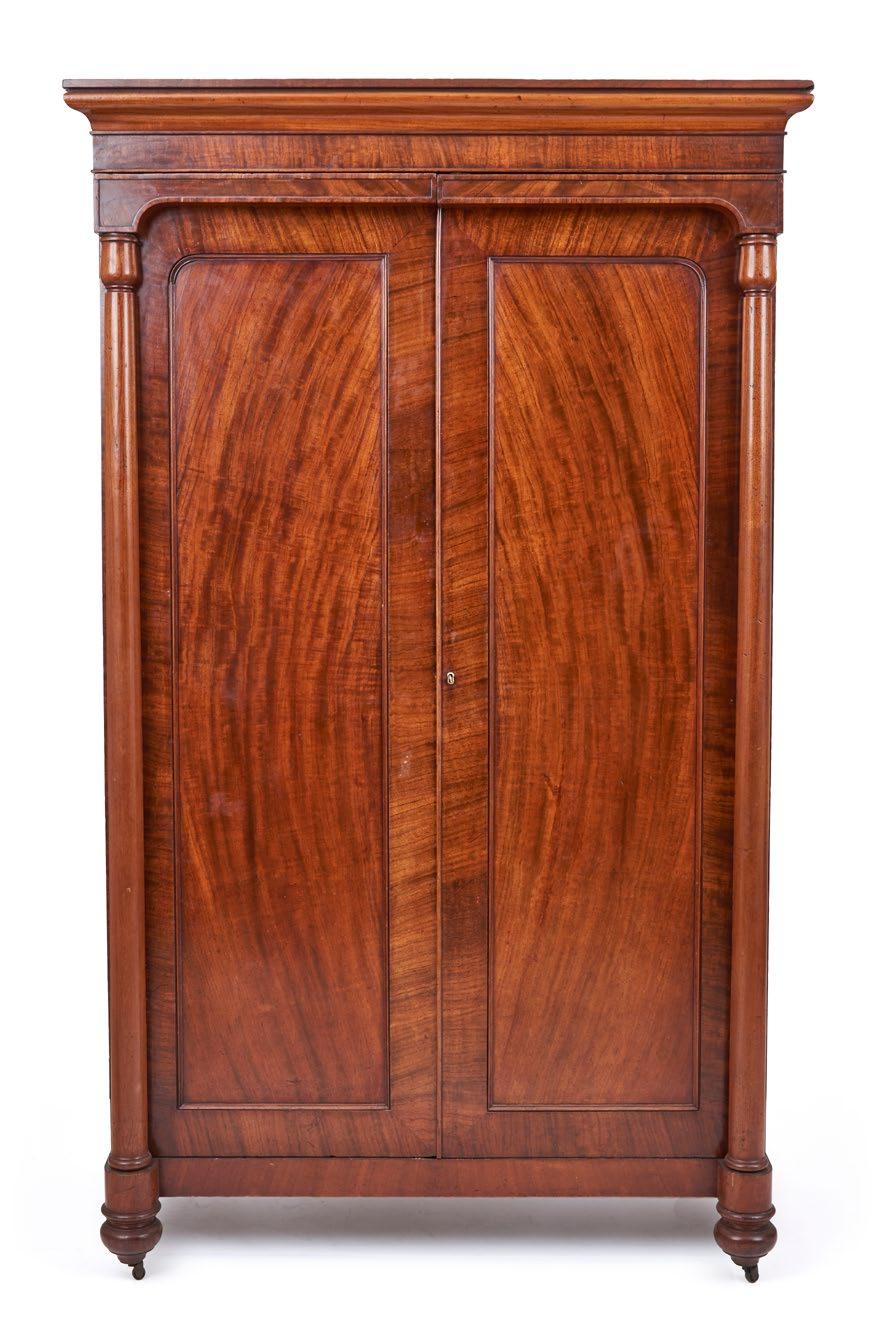
130cm wide, 71cm deep, 216cm high
PROVENANCE
The Keith Okey Collection, Denham Court, Sotheby‘s, Sydney 2010
$3,000–5,000
45
46
46 45
47
An unusual cedar dished-seat chair, Australian, circa 1845


47cm wide, 37cm deep, 88cm high $600–1,000
48
A fine cedar lyre pattern armchair, Australian, circa 1845
76cm wide, 80cm deep, 97cm high $8,000–12,000
49
A rare blackwood cross-banded circular top pillar table, Australian, circa 1845

65cm diameter, 76cm high
REFERENCE
Australian Furniture Pictorial History and Dictionary 1788-1938, Kevin Fahy and Andrew Simpson, Casuarina Press, Sydney, page 444, No 496.
$2,000–3,000
49 48 47 46
A rare cedar long-case clock, Australian, 19th century circular dial with brass two-train movement 50cm wide, 220cm high, 24cm deep

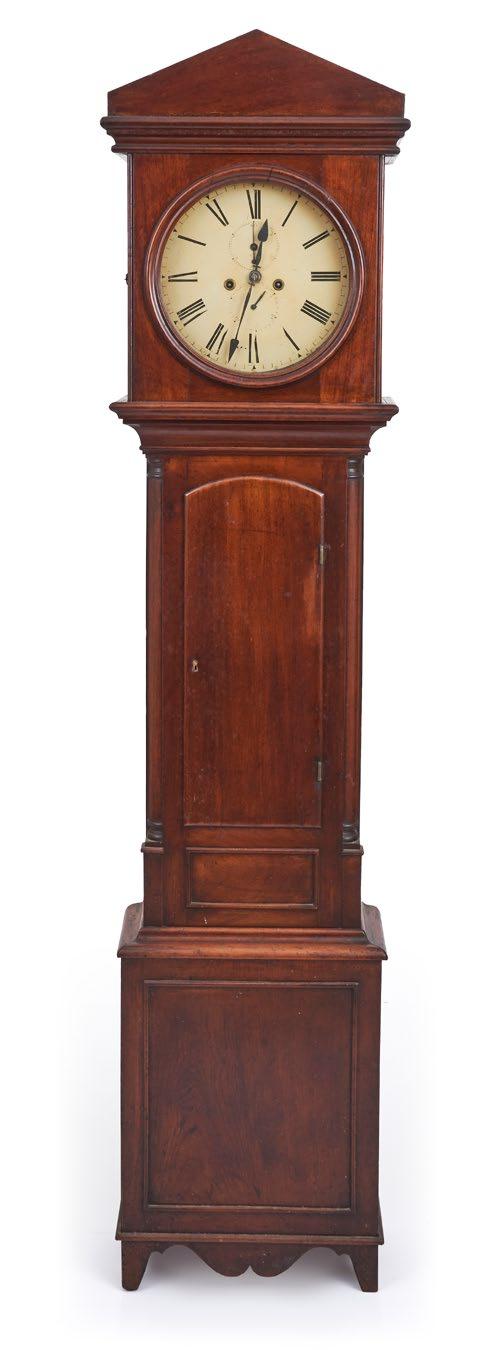
PROVENANCE
The family of Cunningham McFarlane clockmakers of Melbourne, circa 1853-1900, Sold Aingers Auctions, Melbourne 16/03/2008, lot 257 ($28,500)
$6,000–10,000
50
50 47
ARTIST UNKNOWN
(Australia, 19th century)



Five painted cedar panels from Burdekin House, Sydney, since demolished for St Stephens Church, Macquarie Street, Sydney oil on five cedar panels with label to verso


83 x 26cm
$1,000–2,000
51
51 48
A rare and significant Grecian-key strung cedar eight-leg sideboard, Australian, circa 1820 the six legs displaying ring turned bee-hive balusters 183cm wide, 56cm deep, 90cm high

PROVENANCE
Lawsons, Sydney
This sideboard relates in its unusual and distinctive design to the Butheroe sideboard sold Mossgreen, Melbourne, 30 May 2017, lot 461. $10,000–15,000
52
52 49
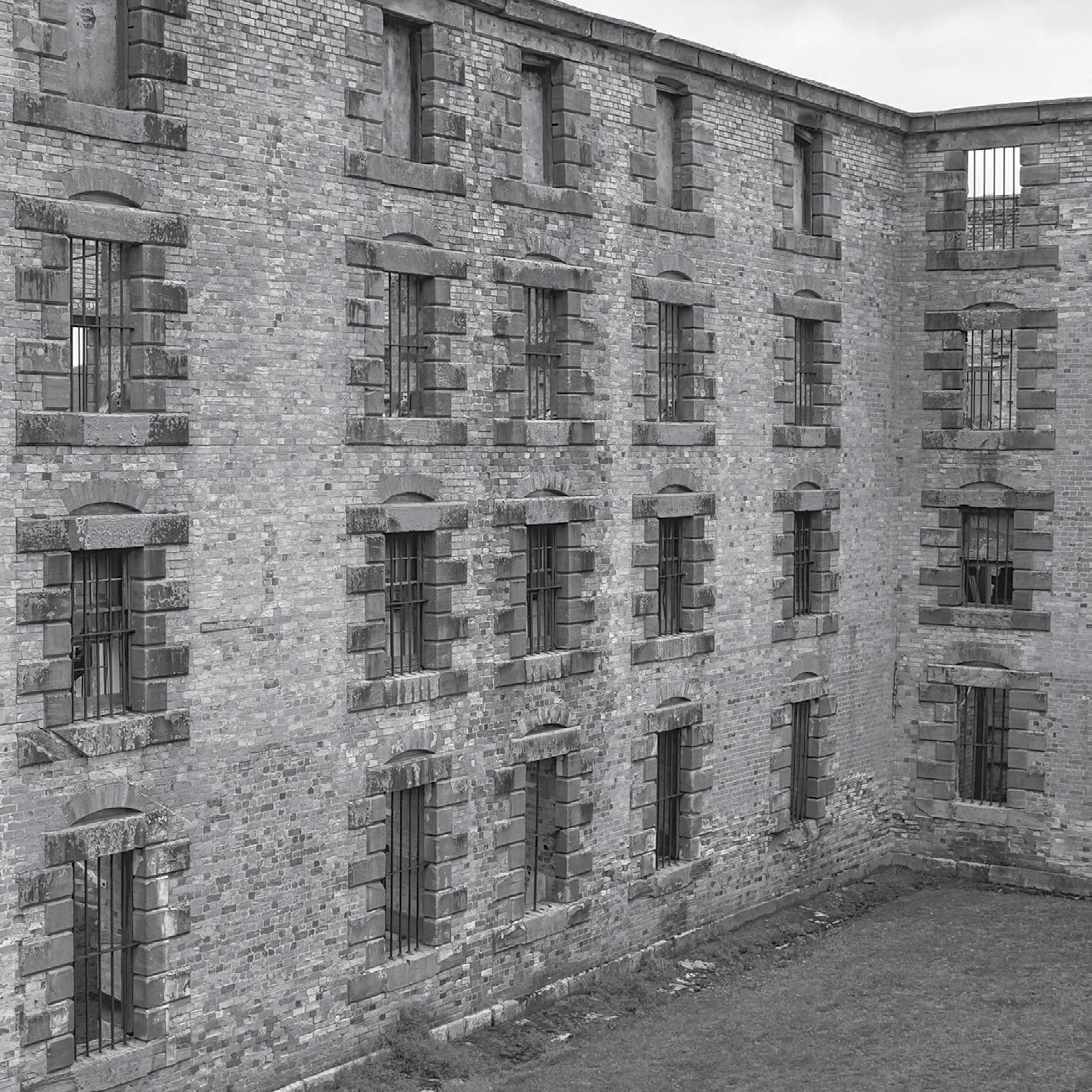


50
A rare cast-iron convict's bed Australian first half of the 19th century 215cm long, 76cm
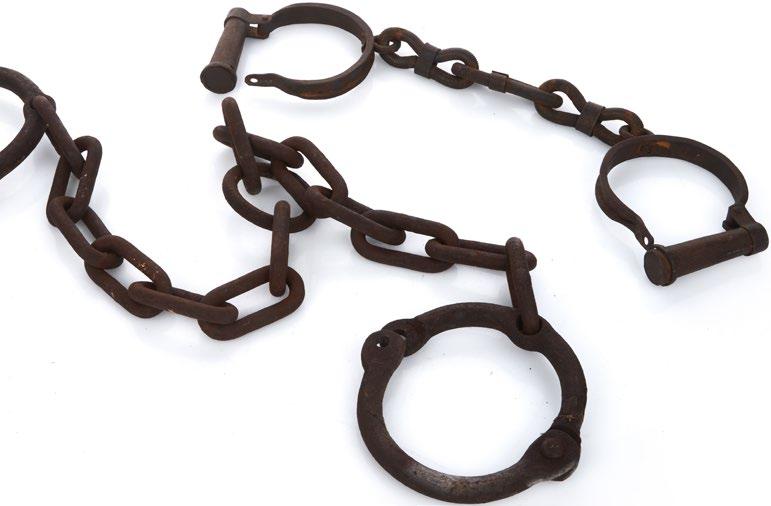



53
A set of convict leg-irons and a set of manacles cuffs 13cm wide $120–180
54
55
A pair of large and very heavy cast-iron convict leg weights 20cm high $200–400
53 54 55 51
wide $500–800
ARTIST UNKNOWN (Irish, 18th century)
Miniature portraits of Henry Joy McCracken (1767-1798) and Mary Ann McCracken (1773-1866)

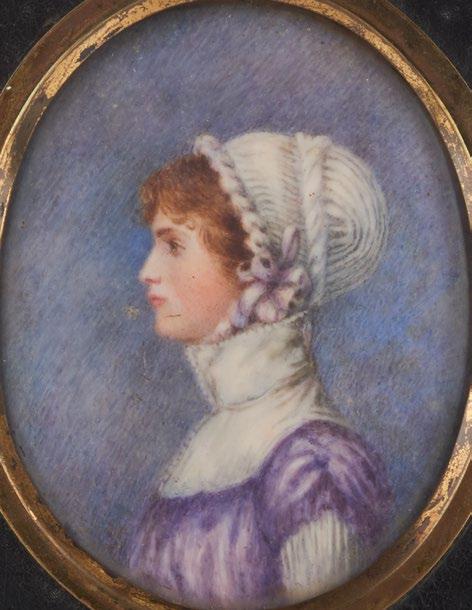
watercolour inscribed in ink to verso
7.5cm high, 5cm wide
$800–1,200
56
56 52
ARTIST UNKNOWN (Irish, 18th century)
Portrait of Henry Joy McCracken (1767-1798)
oil on canvas
titled upper left 110 x 81cm
$6,000–8,000
Henry Joy McCracken (1767 - 1798): United Irishman
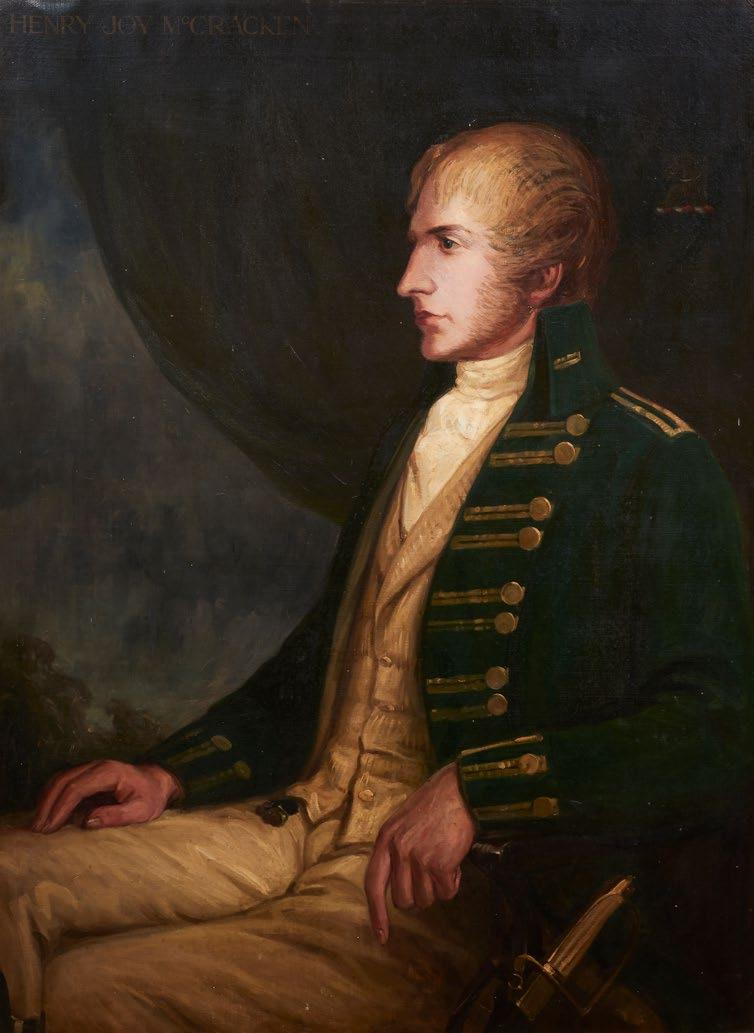
Henry Joy McCracken – Born: 31 August 1767. Executed: 17 July 1798
Henry Joy McCracken was born in High Street, Belfast on 31 August 1767. Proud to belong to two important Belfast Presbyterian families, he always used his full name. His father, John McCracken, was an entrepreneur and associated with many of Belfast's leading philanthropic ventures; his maternal grandfather, Francis Joy, owned important paper mills and was the founder of The Belfast News-Letter. The Joys – of Huguenot descent – were also a public-spirited family. Henry was early interested in radical politics and used his position as owner of a cotton mill, of which he was put in charge at the age of 22, to travel extensively, making political contacts; he was always concerned with the welfare and education of his workers.
In 1791 he joined with Thomas Russell in forming the first Society of United Irishmen in Belfast. In 1796 he was imprisoned for over a year in Kilmainham Gaol, Dublin. When the insurrection broke out in June 1798, McCracken was made general of the forces mustered at Donegore, which then attacked Antrim town. They were defeated by government troops. After a month on the run McCracken was captured in Carrickfergus while trying to escape to America. He was tried for treason and hanged in the Cornmarket, Belfast, on the same day: 17th July 1798. His sister Mary Ann had a doctor standing by in case there was still life in the body after it was cut down; but in vain. McCracken was buried at St George's, High Street, but the remains were later transferred to the Clifton Street cemetery.
57
57 53
58
A rare and impressive cedar black marble top console table, Australian, circa 1830 120cm wide, 55cm deep, 84cm high
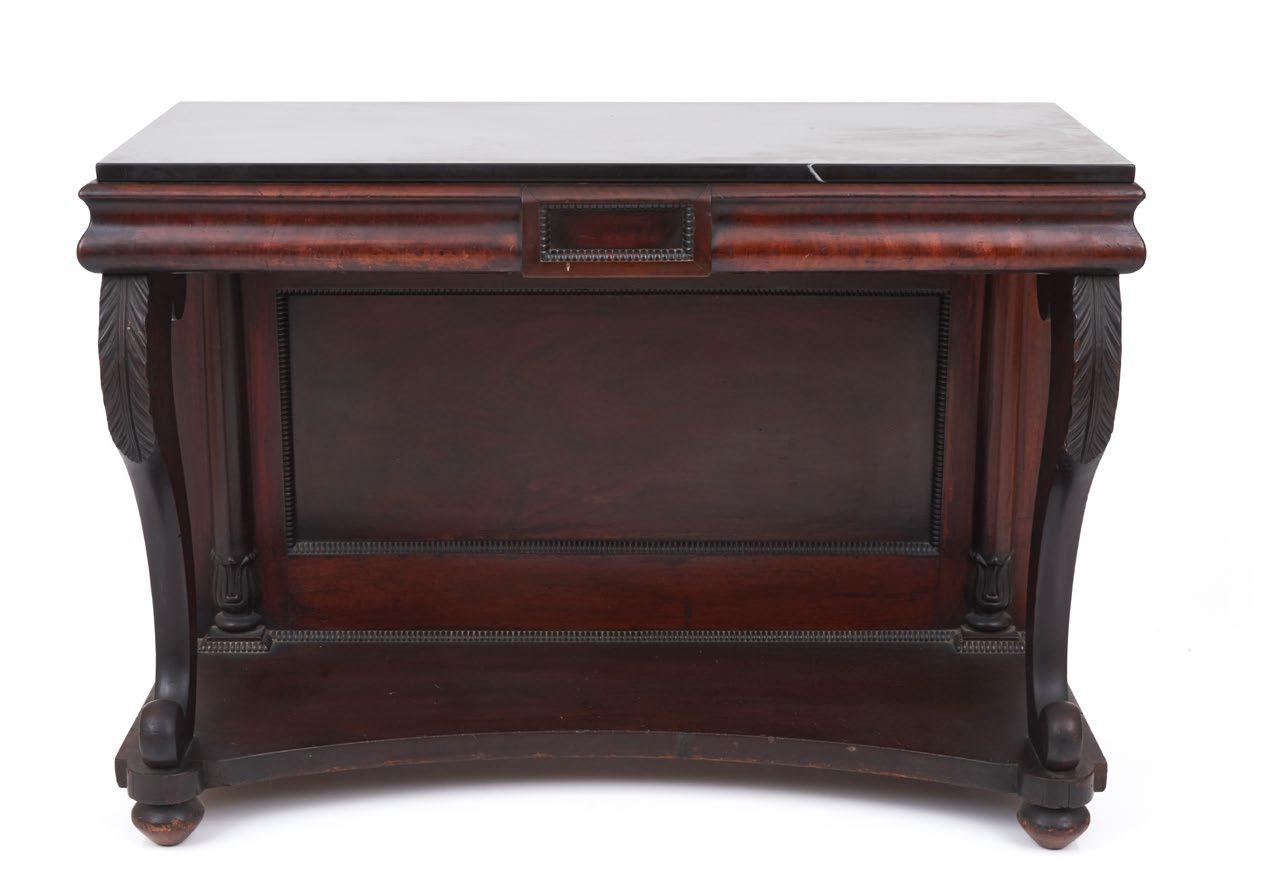
PROVENANCE
The Owston Collection, Bonham's Sydney, 25 June 2010, lot 537 (Sold $28,000 hammer) $10,000–15,000
58 54
ARTIST UNKNOWN
(Australian Colonial School, 19th century)
Portraits of Mr and Mrs Florant Martel (Florant arrived on board the barque ‘John’ Port Jackson 1 July 1838)
pair of oils on canvas
92 x 71cm
PROVENANCE
Davidsons Auctions, 23 July 2012, lot 29a
Aalders Auctions, Sydney, circa 2017
$3,000–5,000
These portraits are believed to be of Florant Martel (born Boulongesur-mer 1810) and his wife Cherubim Hannah Bloomfield (born 1816) Florant Martel arrived on the barque "John" on July 1 1838 and he married Cherubim Hannah Bloomfield at St Mary's cathedral Sydney in 1845. They lived at Molong and leased land at Copper Hill where he built the Union Inn. Then at Dandaloo Florant built a homestead and planted a vineyard and established a post-office. He died in 1870 and Cherubim then built the Dandaloo church in 1888, on the banks of the Bogan River – the oldest church in that parish. See accompanying document used to source this information and provided from the previous owner and descendant of the sitter's.

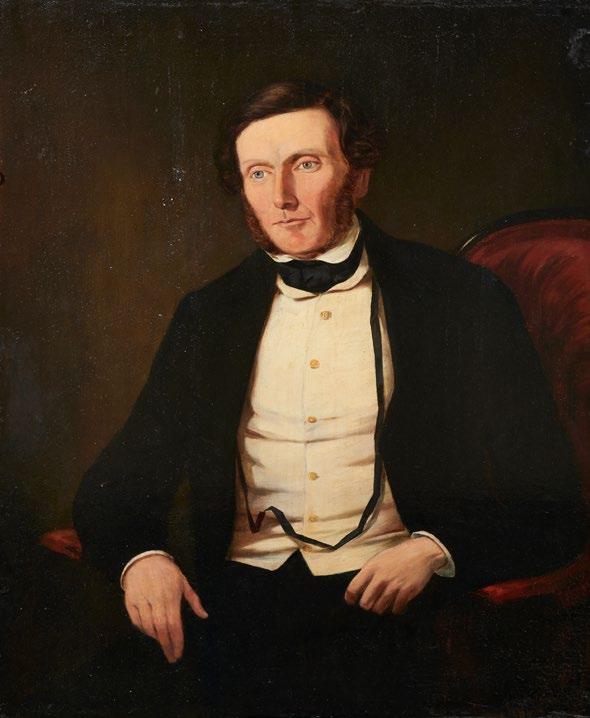
59
59 55
60
ATTRIBUTED TO ALFRED J. COFFEY (Australian, 1869-1950)
By the bend oil on canvas on board signed lower left 23 x 13cm
PROVENANCE
The artist's estate
Inherited by Mrs Maryanne Eastway
(Coffey was her great uncle)
Sold Alison McSweeney, 13 August 2000
Sold Davidson's Auctions, Sydney, 25/05/2020 lot 312
$400–600
61
ALFRED. J. COFFEY (Australian, 1869-1950)
Prawn Fishing at Rose Bay, Sydney Harbour 1917
watercolour signed lower right and titled to mount 14 x 37cm
PROVENANCE
Sotheby's, Fine Australian Paintings and Books, Sydney, 29/11/1993, lot 436 (sold $1,100 hammer)
$800–1,200
62
ALFRED. J. COFFEY (Australian, 1869-1950)
Terrigal Beach View oil on board signed and dated 1917 lower right 13 x 28cm
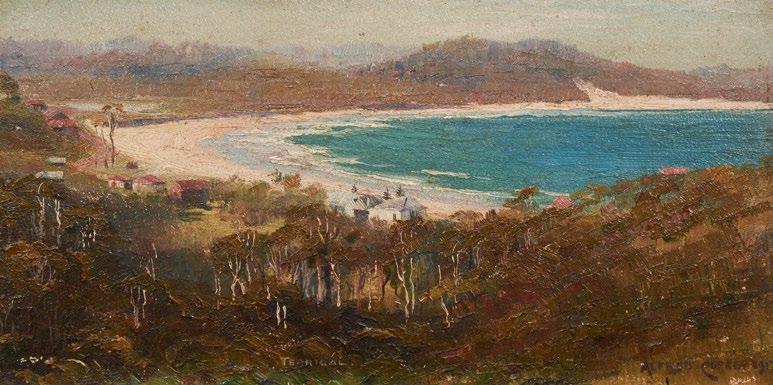
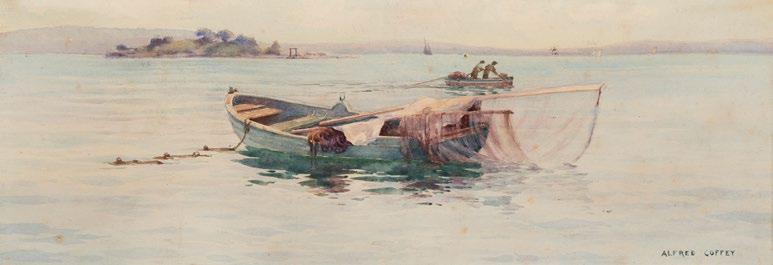
PROVENANCE
Christie's, November 1988, lot 127 (sold $3,000 hammer)
Savill Galleries, Sydney Davidson Auctions, Australian & International Art, Sydney, 19/06/2016, lot 303 (sold $1100 hammer)
$1,500–2,500
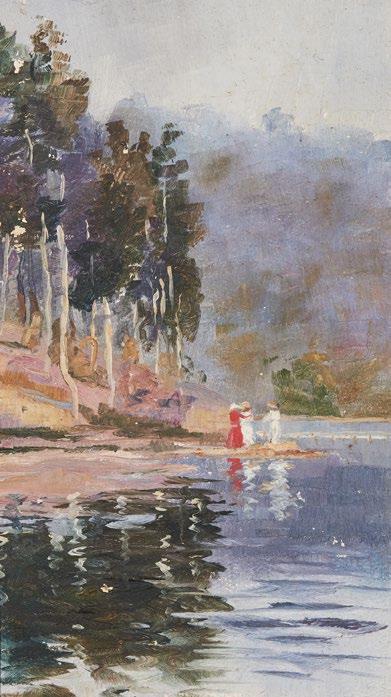
60 62 61 56
ALFRED. J. COFFEY (Australian, 1869-1950)
Terrigal watercolour signed and titled lower left and dated 1918 55 x 29cm
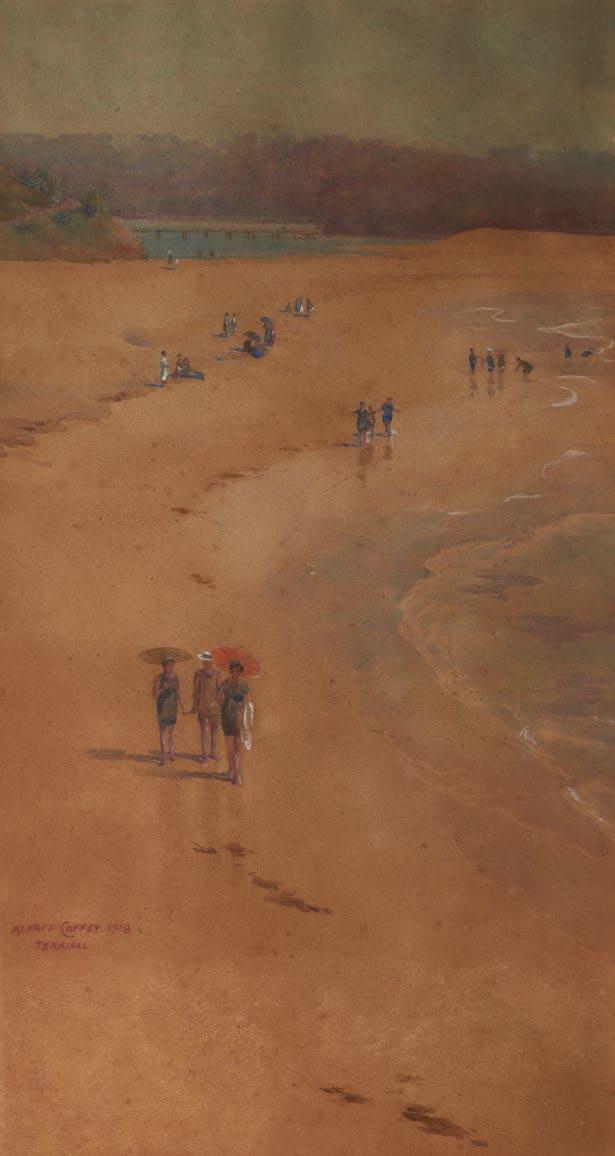
Probably the work sold at Lawsons as Scene of Terrigal 3/11/98 lot 239 (AUD$5,500)
$3,000–5,000
63
63 57
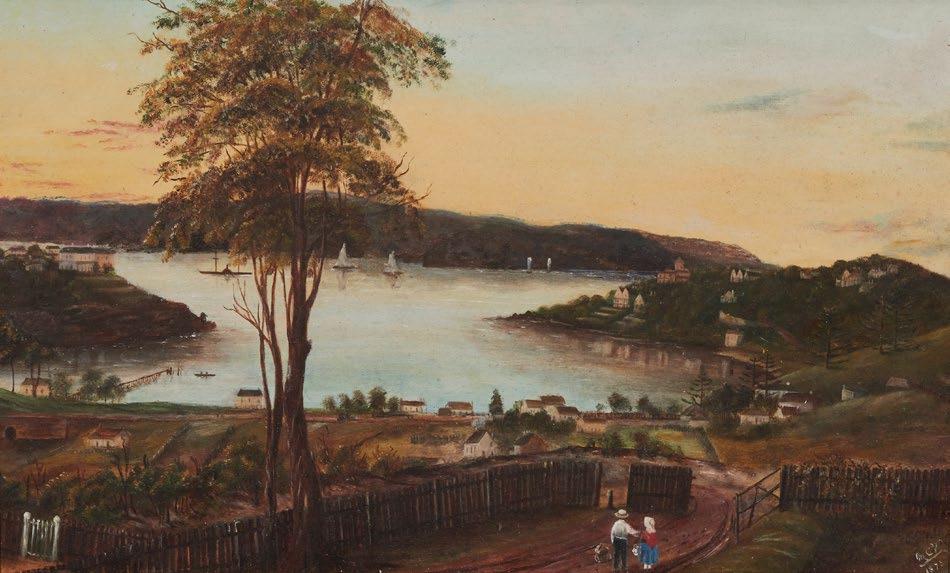
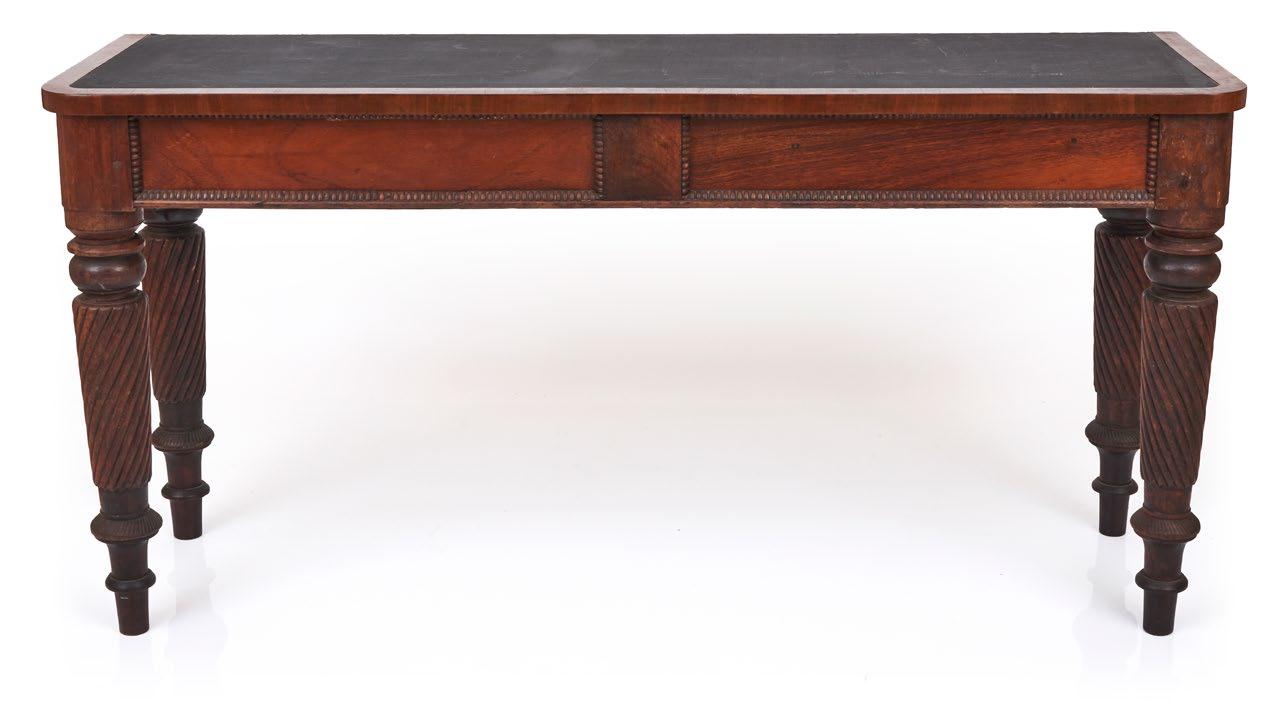
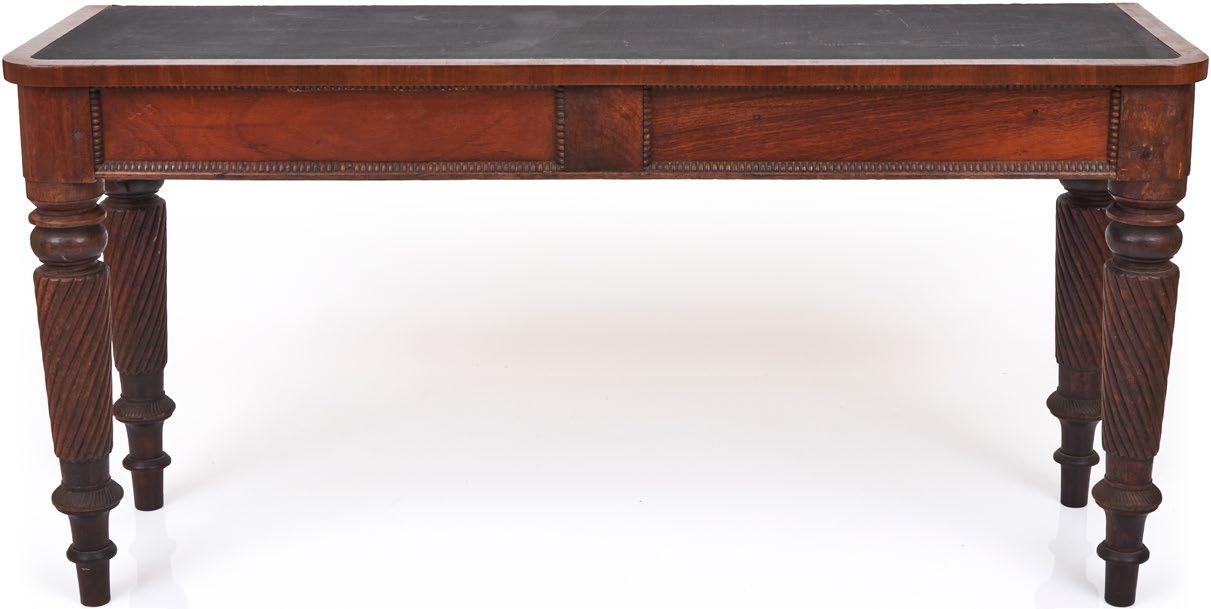
65 64 58
ARTIST UNKNOWN
(Australian School, 19th century)
Sydney Harbour with figures on a track, 1873
oil on board
initialled MCV lower right and dated 1873 25 x 43cm
$2,000–4,000
A large and impressive cedar rectangular library table, Australian, circa 1835 167cm wide, 62cm deep, 82cm high
PROVENANCE
Purchased privately through Walter & Co
Tasmania 1990s
$2,500–4,000
A large and rare New South Wales rosewood straight-fronted chest-of-drawers, Australian, circa 1860 counter-sunk brass handles 128cm wide, 59cm deep, 118cm high
$3,000–5,000
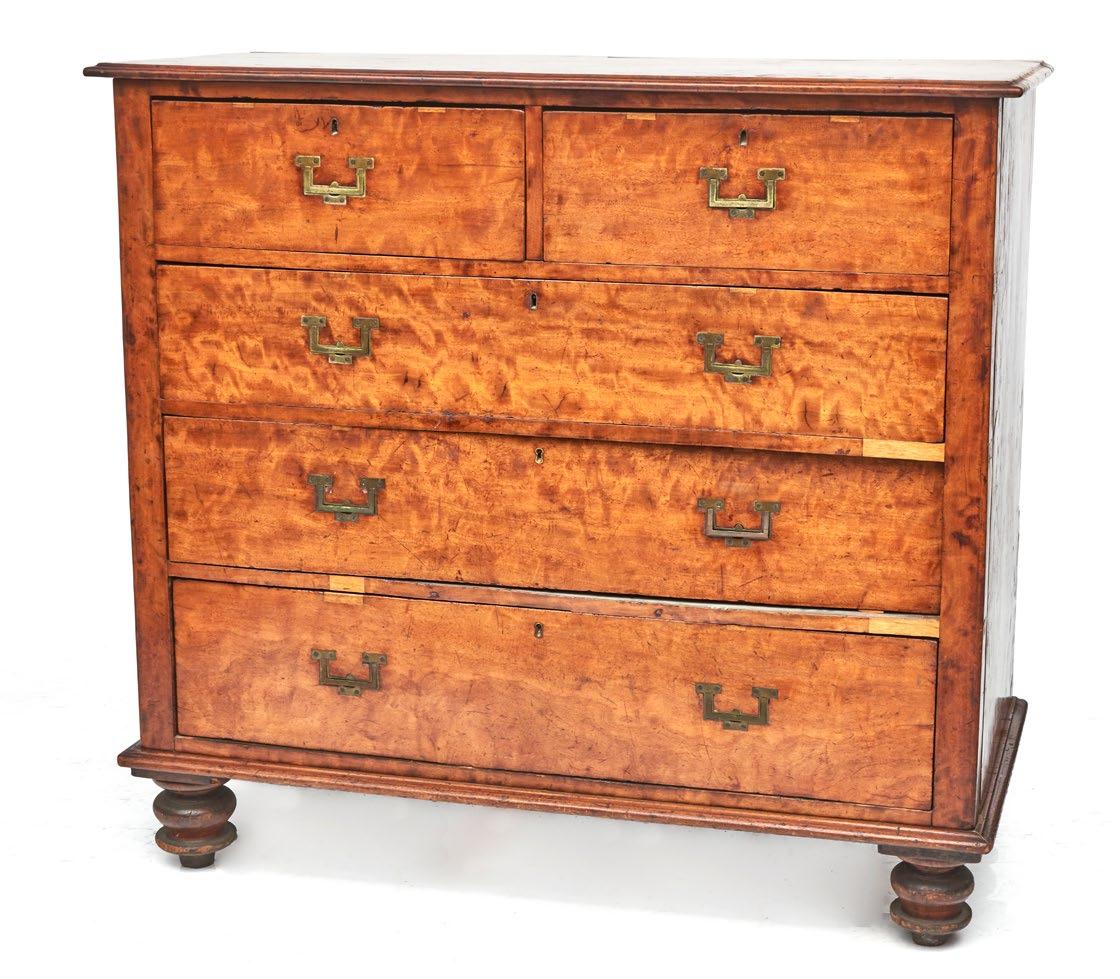
64
65
66
66 59
WILLIAM S. REAY
(Australian Colonial School, 1831-1903)
Frank Gardiner, the infamous bushranger oil on canvas signed and dated 1867 lower left 118 x 92cm
PROVENANCE
The Contents of Mount Pleasant (The Estate of J.Forsythe) Paul Taylor Auctions, East Maitland NSW, 1 December 2007, lot 525 (sold for AUD$12,000 hammer)
Sold with a copy of the book Frank Gardiner, A Definitive History Edgar F. Penzig. Published by Tranter Enterprises. 1987.
$5,000–8,000
William S.Reay was born Newcastle on Tyne, United Kingdom in 1830. The painter, art teacher, poet and coal-miner, migrated to Australia in response to the colonial success of his painting, 'Adam and Eve Expelled from Paradise'. However, Reay's poetry lamented his exile from England, the beloved 'North Countree ..its meadows, foaming torrents, and rippling brooks'.
Reay, his wife Mary and their young child migrated to New South Wales in 1861. Reay discovered that no artistic patronage awaited him and he was soon working as a coal-miner in Newcastle, New South Wales. His large oil painting which toured to Newcastle, Maitland and Sydney, Adam and Eve Expelled from Paradise, was, his obituarist implied, painted as an allegory of the Reays’ colonial situation.
The success of Reay’s Expulsion picture in Sydney led to a commission to paint the portrait of Governor Sir John Young (later Lord Lisgar), for which purpose Reay was granted several sittings at Government House. However after this promising start his painting career never blossomed in Australia and he returned to the more lucrative mining for many years before ultimately taking on the post of art master at Newcastle Grammar School in The Hunter Valley, a position he held for nineteen years.
In old age Reay was respected as Newcastle’s 'painter-poet’ and the painter-miner was forgotten. His poem 'To an English primrose growing in Australia’ includes references to his 'banishment’. He died at Waratah NSW in May 1903 and was survived by his wife, four sons and two daughters.
Frank Gardiner (1830 – c. 1882) was an Australian bushranger who gained infamy for his lead role in the a robbery of a gold escort at Eugowra, New South Wales in June 1862. It is considered the largest gold heist in Australian history. Gardiner and his gang, which included bushrangers Ben Hall, John O'Meally, Johnny Gilbert, Henry Manns, Alexander Fordyce, John Bow and Dan Charters, made off with a pile of cash and 77 kilograms of gold, worth over AUD$12 million today.
In 1850, Gardiner was working as a stockman in central Victoria. Perhaps realising that this career meant hard work and little money, he and two accomplices stole a large mob of horses from William Morton's station near Serpentine on the Loddon, 40 km northwest of present-day Bendigo. They planned to sell the horses in Portland. However, Morton followed
their tracks to Bilston's Inn, near Heywood, where the trio were arrested. Gardiner was tried under his real name, Christie, at Geelong on 22 October 1850 and sentenced to five years' hard labour.
On 20 March 1851, Gardiner was part of a work party working outside Pentridge Prison when they rushed the guards and escaped. Most of the convicts were rounded up within days but Gardiner escaped and made his way to New South Wales, perhaps stopping at the station in central Victoria where his father and younger sisters were living. There are scattered reports of him having been arrested at the McIvor diggings on suspicion of robbing the gold escort the previous week. However, there is no record of him ever appearing in court in this matter.
It is likely that he moved up to NSW and teamed up with a youth named Prior to resume his horse stealing career. In February 1854 Gardiner (now calling himself Clarke) and Prior were caught trying to sell stolen horses at Yass. This time he was sentenced to fourteen years (seven years for each charge). While imprisoned on Cockatoo Island he met the bushranger John Peisley.
Frank Clarke was granted a ticket-of-leave in December 1859, conditional on him staying in the Carcoar district. Calling himself Frank Jones he opened a butcher shop at Spring Creek, Lambing Flat, but was arrested in May 1861 on a cattle-stealing charge and committed for trial but allowed bail. He then absconded, after which it was discovered he was a prisoner absent from his district. Gardiner joined with Peisley for a short period and was briefly captured after a gunfight with two troopers at Fogg's hut near Reids Flat. Gardiner and Fogg managed to bribe one of the policemen to allow Gardiner to escape.
In June 1862 he bailed up the Lachlan Gold Escort near Eugowra with a gang including Ben Hall, Dan Charters and Johnny Gilbert. This holdup is considered to be one of the largest gold robberies in Australian history. The total value of the gold and bank-notes taken was estimated at £14,000 (approximately A$12.5 million in today's terms). Much of the gold was recovered by mounted police after they surprised the gang on Wheoga Hill near Forbes. What happened to the remaining gold is still the subject of much speculation and rumour. Treasure hunters still visit the area and it is even rumoured that two Americans who were thought to be Gardiner's nephews visited the Wheogo Station near the Weddins in 1912 claiming to be miners.
While the rest of the gold robbers stayed in the district and were rounded up and caught, Gardiner opted to flee to Queensland. In 1863–1864, Gardiner was living with Ben Hall's sister-in-law Kitty Brown, at Apis Creek near Rockhampton, Queensland, where he was running a general store. [14] He was recognised and reported to the police in Sydney. Gardiner was apprehended in controversial circumstances by both NSW police operating outside their jurisdiction and by troopers of the paramilitary Native Police. One of the NSW policemen used Gardiner's own horse 'Darkie' during the capture. He was taken back to Sydney, and sentenced in July 1864 to 32 years hard labour "on the roads".In 1872 a petition was organised by Gardiner's sisters seeking Gardiner's early release, prepared for presentation to the newly appointed Governor of New South Wales, Sir Hercules Robinson. The Governor, as representative of the English sovereign, had the power to exercise the Royal prerogative of mercy for felony cases not subject to the death penalty. By the time it reached the Governor in September 1872 it had attracted the signatures of a number of prominent public men, including members of parliament and the
67
60
former Colonial Secretary, William Forster. After consideration, Robinson decided that Gardiner could be eligible for a pardon, but only after he had served ten years incarceration and providing his conduct in prison remained good, conditional upon him leaving the country on release and becoming an exile from the Australian colonies and New Zealand.
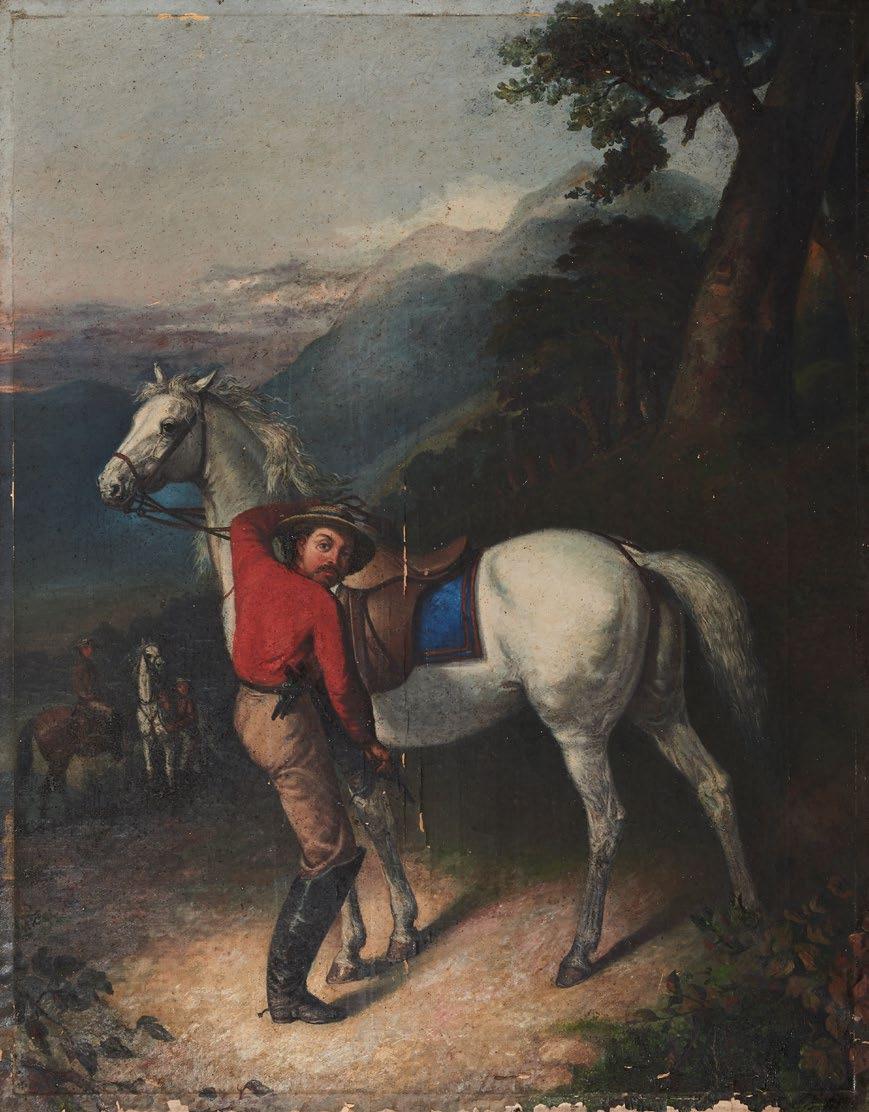
In late 1874, Gardiner arrived in California having travelled via Hong Kong. He is just one of many Australians exiled from this country during the bushranging era. Gardiner owned the Twilight Star Saloon on Kearny Street in the Barbary Coast area of San Francisco. A couple of months later he relocated to a more upmarket Brannan St which was closer to the docks. Australians arriving in San Francisco would often ask about him and have a drink at his premises. By 1882 he was out on the street, it was reported that Gardiner had overextended credit to his clientele and couldn't pay the bills.
There are numerous reports of his death having occurred in 1882 (Evening News, Sydney 28 August 1882 and other similar articles) and that he was buried in a pauper's grave near the Legion of Honor park in San Francisco. The circumstances of his death are not known with any degree of certainty, due in large part to the destruction caused during the 1906 San Francisco earthquake.
There are many rumours about his life there, including a claim that he married a rich American widow and had two sons. Another rumour was that he died in Colorado in 1903. None have been proven.
67 61
An unusual and impressive carved cedar two-door Paladian style press, Australian, circa 1835 with six internal full width slides. 118cm wide, 46cm deep, 196cm high $6,000–8,000
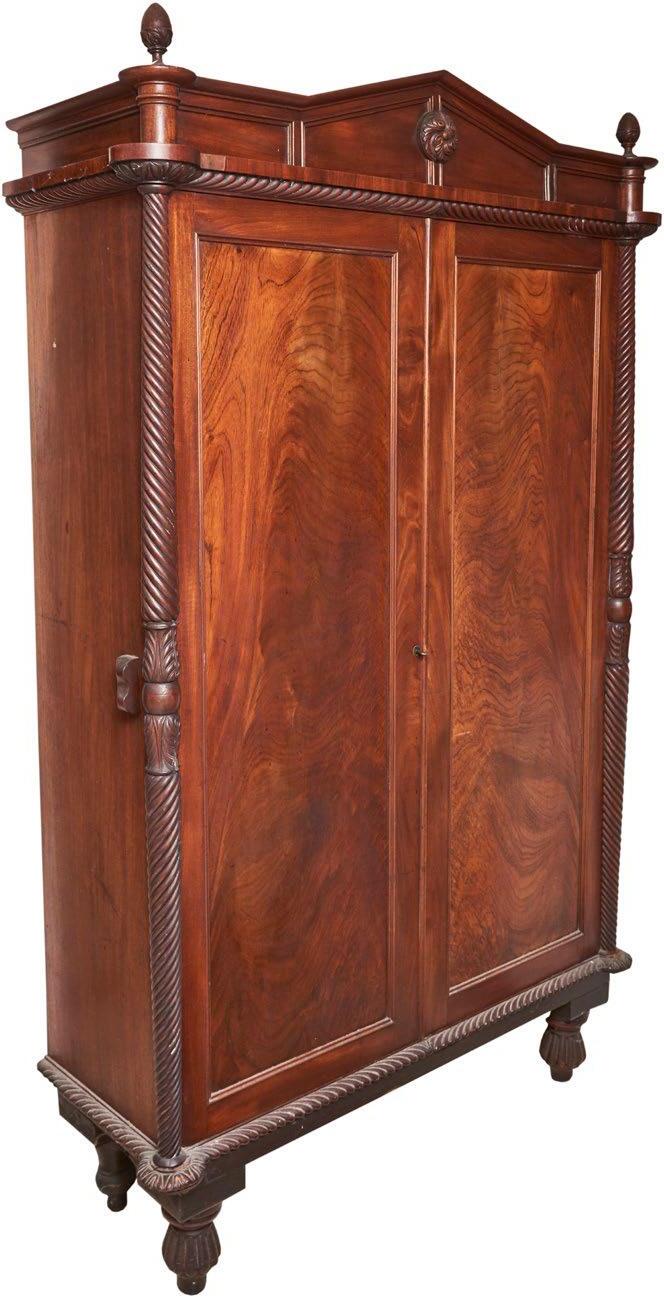
68
68 62
A significant cross-banded and inlaid cedar turned leg dining table, Sydney origin, Australian, circa 1820 one original leaf, original brass casters
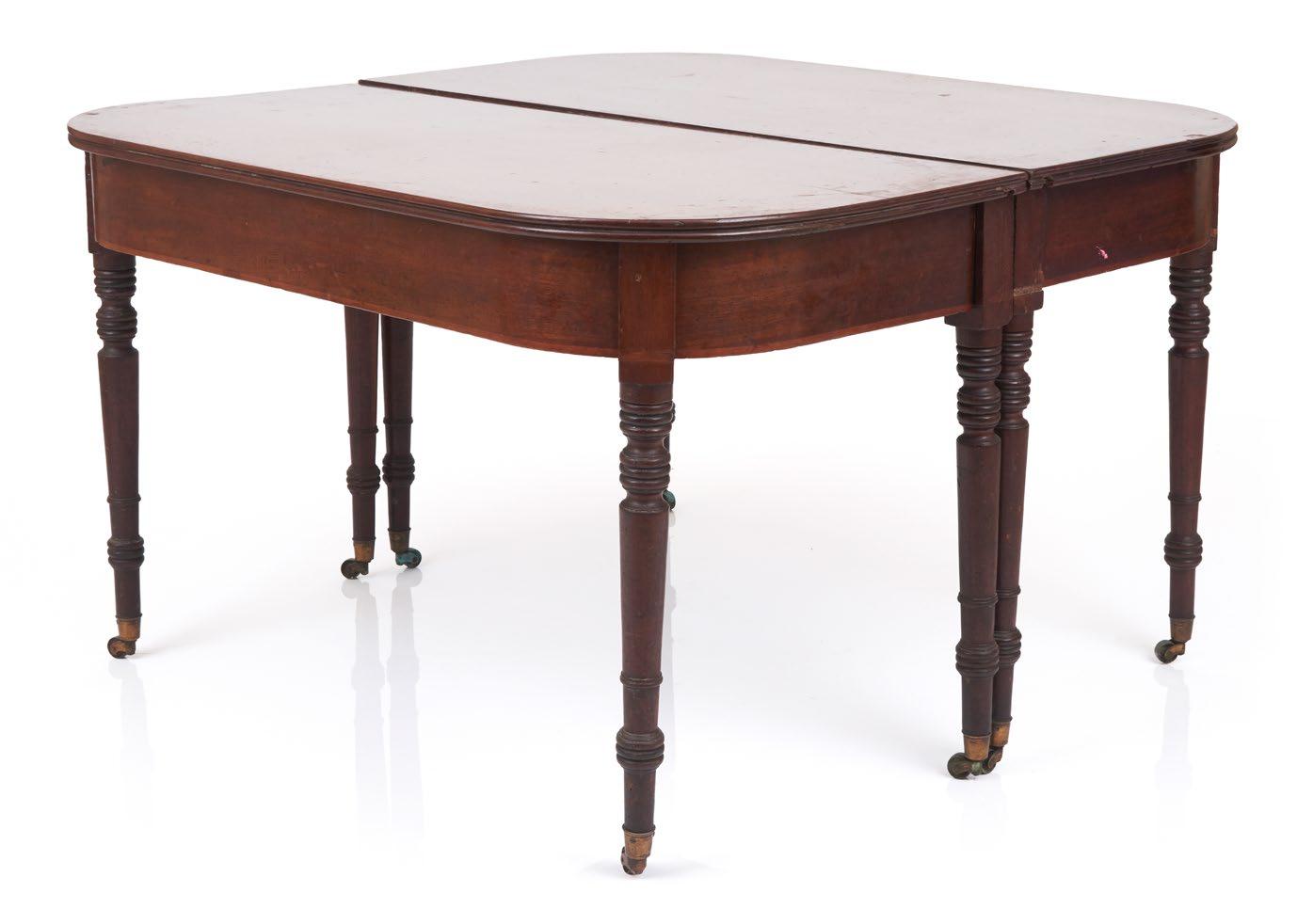
118cm wide, 74cm high, 170cm long
PROVENANCE
Acquired by the vendors from The collection of Caressa Crouch & Carl Consalves, Mossgreen, Melbourne, 2015, lot 162 (AUD$24,000 hammer)
See ‘Australian Furniture: Pictorial History and Dictionary, 1788-1938 Fahy and Simpson, Illustrated page 417
$10,000–15,000
69
69 63

64

65
A rare and fine long-case cedar long-cased regulator clock, by R. Broad, Sydney, circa 1830
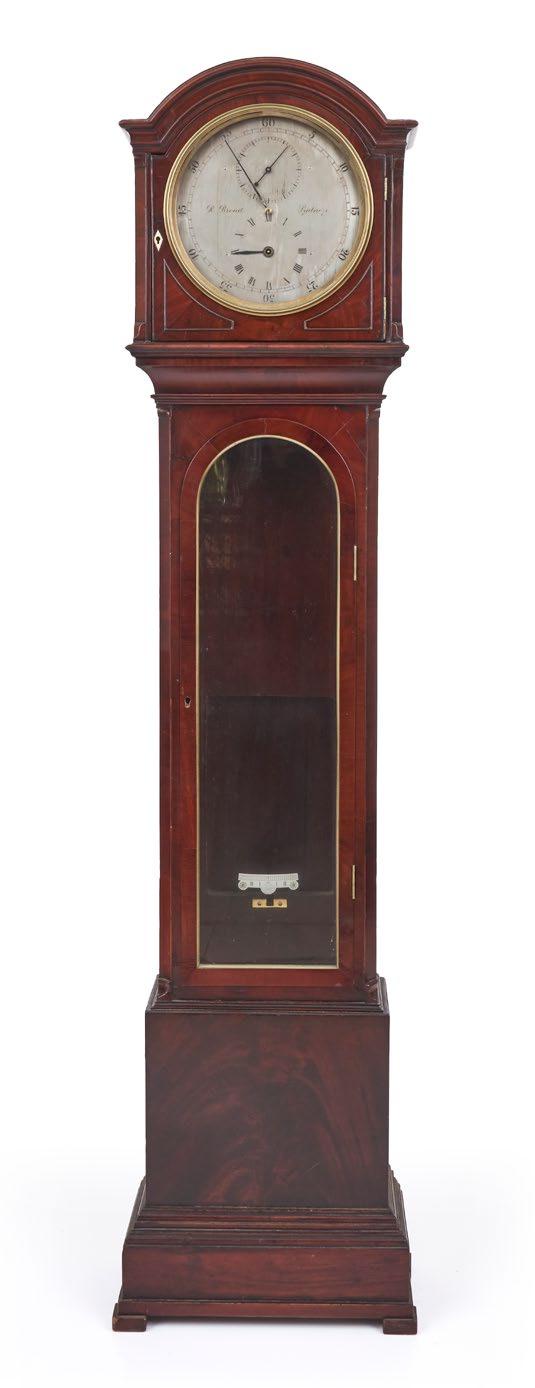
192cm high, 42ccm wide, 21cm deep $10,000–15,000

70
70 66
An impressive Tasmanian cedar double-ended sofa, Australian, circa 1845 220cm long, 65cm deep, 94cm high $3,000–5,000

71
71 67
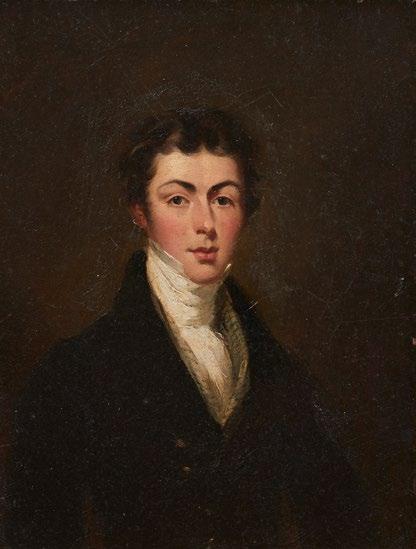



74 73 72 68
ARTIST UNKNOWN (Australian School, 19th century)
Double Portrait of a lady and gentleman watercolour heightened with bodycolour each portrait 18 x 13cm
$300–500
73
ARTIST UNKNOWN (Australia, 19th century)
Half length portrait of a lady, with satin dress and lace collar oil on canvas with Isaac Whitehead Melbourne paper label to verso 65 x 54cm
$500–1,000
74
GEORGE HENRY HARLOW (British, 1787-1819)
Portrait of George Innes who arrived in Australia in 1825 oil on board attributed and titled to verso with various attached labels, see photos 25 x 20cm
PROVENANCE
Timothy Potter Limited, New Bond street, London. July 2000.
George Inness is recorded as having emigrated to Australia from Scotland in 1825 and died here in 1840.
$1,500–2,500
75
A rare Australian cedar display cabinet in the Gothic revival manner, circa 1840 120cm wide, 203cm high, 42cm deep
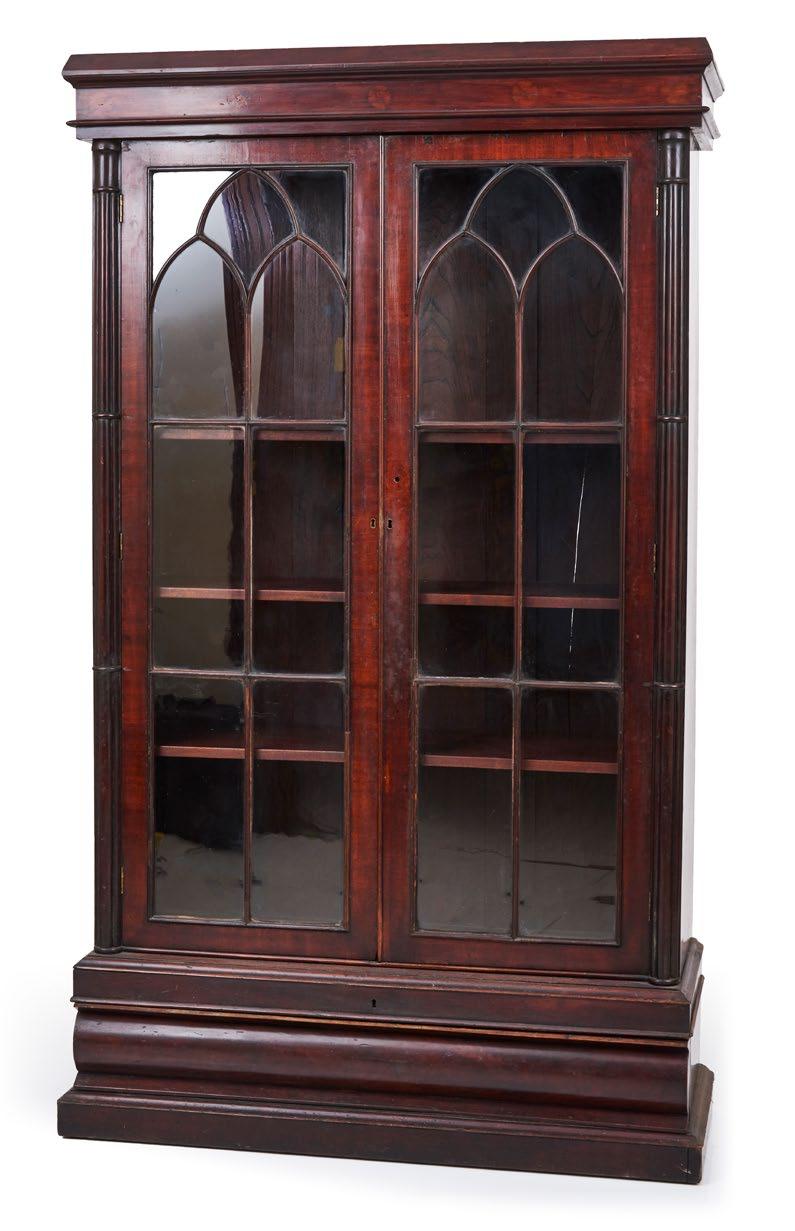
PROVENANCE
The Collection of Dr Keith Oakey, Sotheby’s, Denham Court, May 2010, lot 40 (AUD$17,500 hammer)
$6,000–9,000
72
75 69
76
A painted arched dial wall clock, Dutch, early 19th century 125cm high, 42cm wide $800–1,200

77
A cedar cased New South Wales government railway clock, by the Seth Thomas Clock Co, American made, circa 1880 with a compact pendulum and numbered on the brass plate 1499 with original Seth Thomas paper label internal, with key 81cm high, 40cm wide, 14cm deep $800–1,200
78
A rosewood cased rectangular mantel-clock, by T.Jones Sydney, English made, 19th century double fusee movement with repeat mechanism
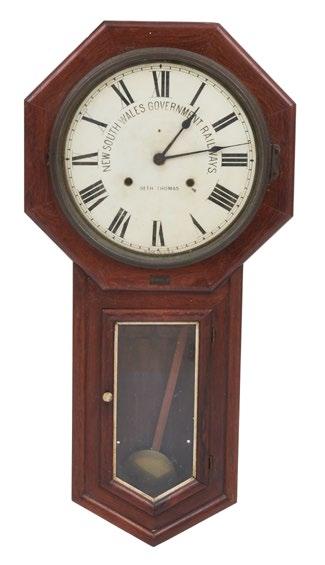

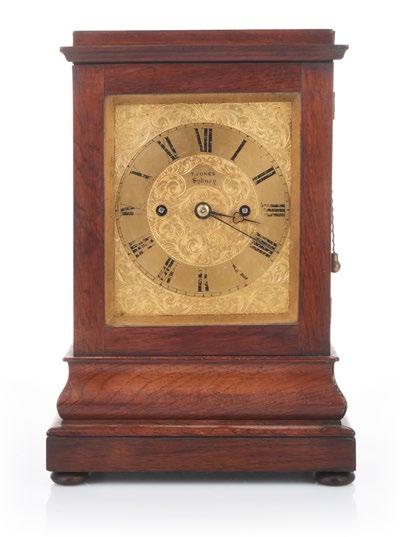
PROVENANCE
The Collection of Graham and Elizabeth Cocks, Bonhams, November 2012, lot 57
Timothy Jones and Sons were clockmakers 330 George Street Sydney and London. (See Sands Directory of 1863) In Sydney, the business operated more as a retailer of imported clocks, some of which the business made at its headquarters in London $1,500–2,500
79
A very unusual American style reverse glass, gilt-gesso and walnut wall clock, labelled T.R. Hamilton, Hobart Town, 1848 90cm high to top of brass finial and 29cm wide $1,500–2,500
79 78 76 77 70
A mahogany-cased painted dial longcase two-train clock by George Young, Dunedin, Scottish, circa 1845 with subsidiary calendar and seconds dials 208cm high, 50cm wide, 24cm deep

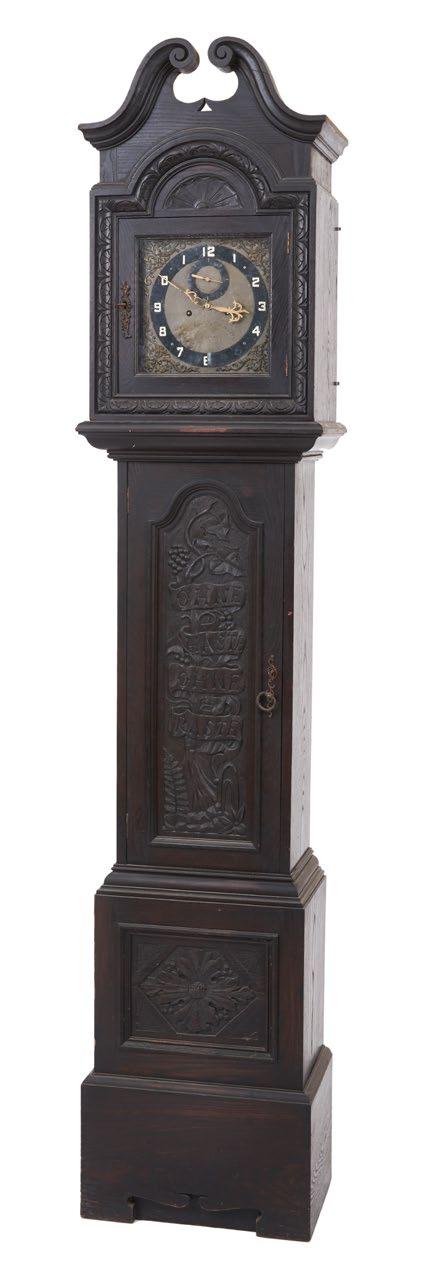
PROVENANCE
Bought privately by the vendors from a schoolmaster in Newcastle By repute: Governor Hunter estate NSW when sold in the 19th century Swift family Maitland NSW
$2,000–4,000
81
An Arts and Crafts carved oak longcase clock, maker Walker, Bond and Bartholemew London and Sydney, circa 1910 with brass dial and two train movement 230cm high, 38cm wide, 30cm deep,
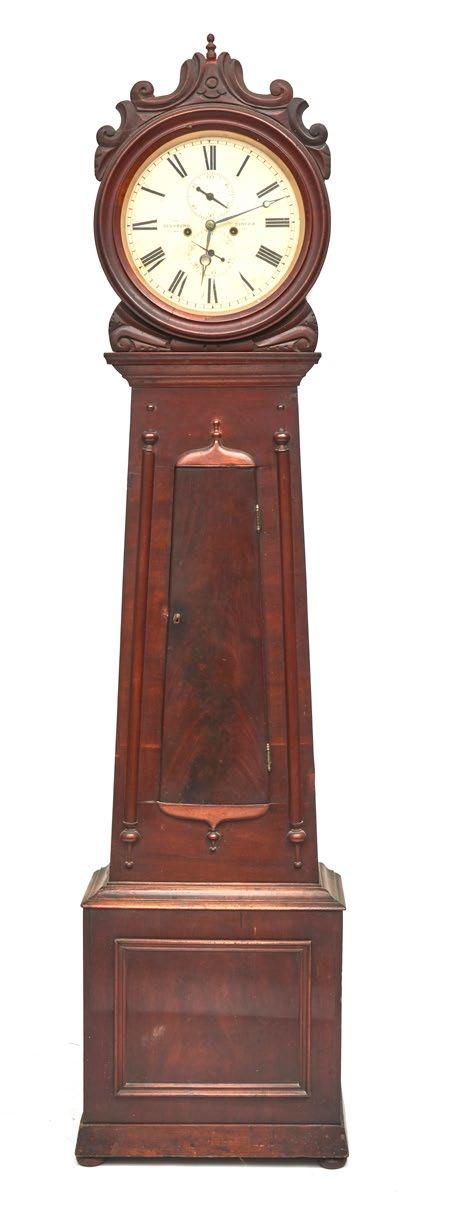

PROVENANCE
Purchased privately in 1990s
$1,500–2,000
80
81 80 71

72
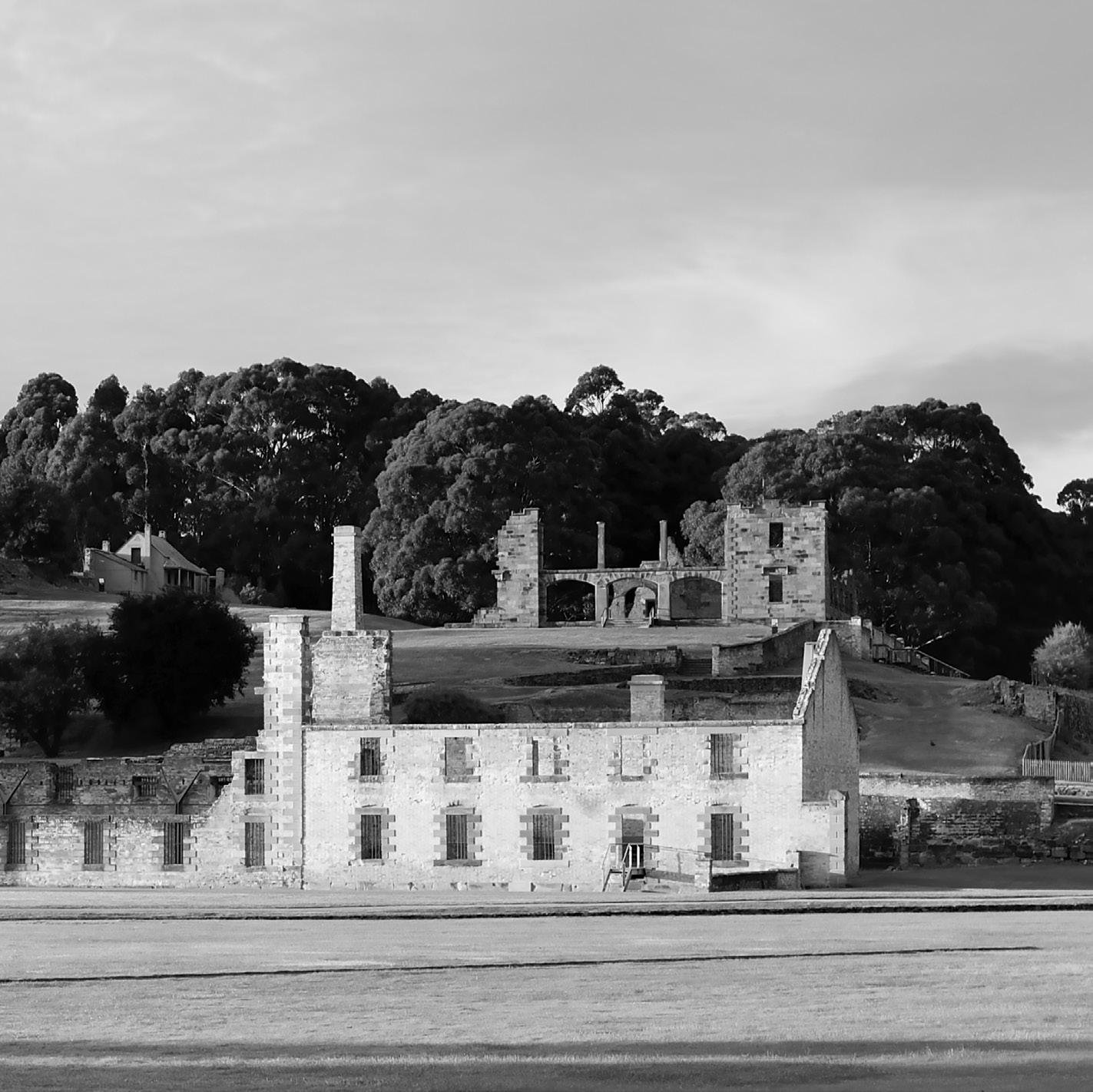
73
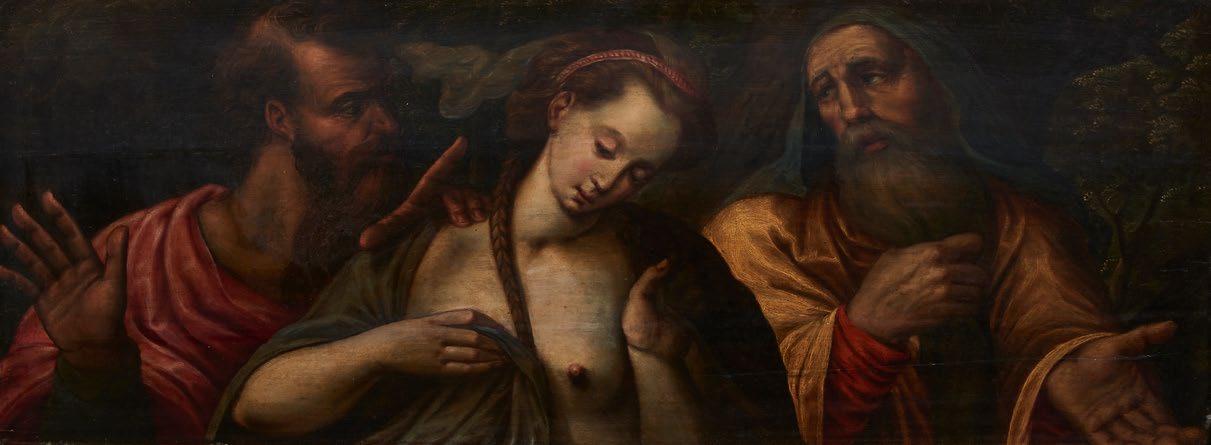


82 83 74
ARTIST UNKNOWN (Italian School, 16th/17th century)
The Virgin Mary with two disciples oil on panel gilt decorated later frame 30 x 77cm
$1,500–2,500
83
ARTIST UNKNOWN (European, 19th century)
Pair of still life's with fish, lures, cherries and fruit, eggs, and utensils with velvet curtain backdrops
pair of oils on glass
one signed indistinctly Guilu??? oval 45 x 36cm
$800–1,200
84
A good carved cedar scrolled-arm carver Chair, Tasmanian, circa 1825

52cm wide, 92cm high
PROVENANCE
The Juliana and Toby Hooper Collection, Sotheby’s, Melbourne, October 2007, lot 145 (estimated then at $5,000–7,000)
$3,000–5,000
82
84 75
85
A large and very impressive carved cedar and rose-mahogany four-poster bed, Australian, circa 1845 unusually supported by cast iron brackets with wood wheels to aid in mobility and ease of bed-making
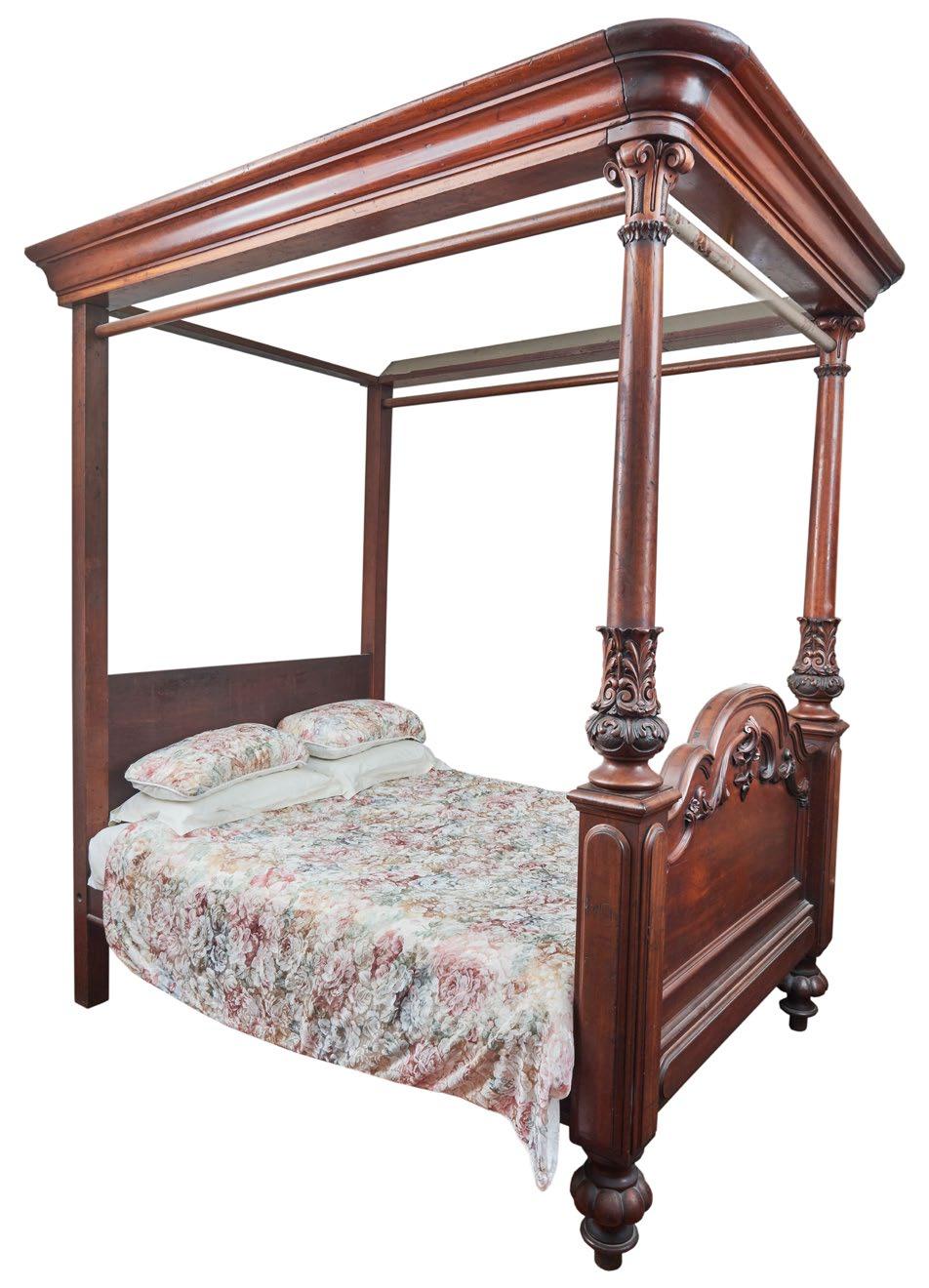
258cm high, 160cm wide, 220cm long, to fit mattress 180 x 150cm
PROVENANCE
The Collection of Graham and Elizabeth Cocks. Bonhams, November 2012, lot 198
($4,880)
$6,000–10,000
85 76
A cedar X frame foot-stool, Australian, circa 1855

59 x 60 x 41cm high
$1,000–2,000
87
A fine cedar drop-leaf sewing table, Australian, circa 1840 original brass castors
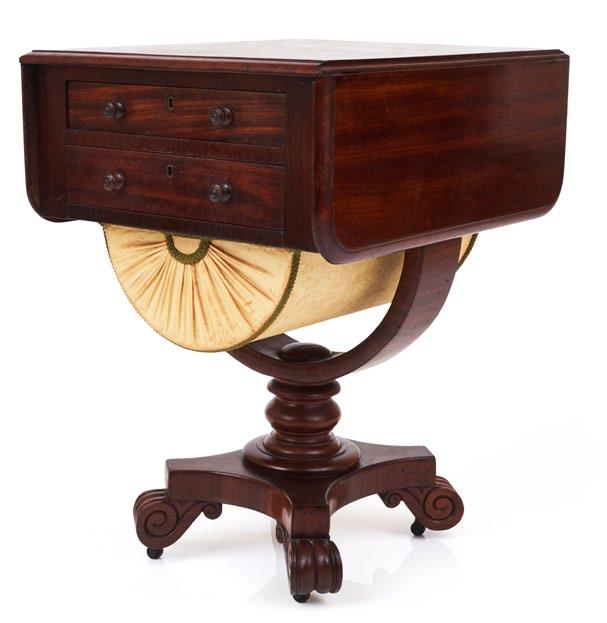
51cm wide closed, 62cm deep, 74cm high
PROVENANCE
The Keith Okey Collection, sold Sotheby’s, Sydney, lot 121
$2,500–3,500
88
An Australian cedar scrolled-arm reclining armchair, circa 1840 after a design in John Claudius Loudon’s
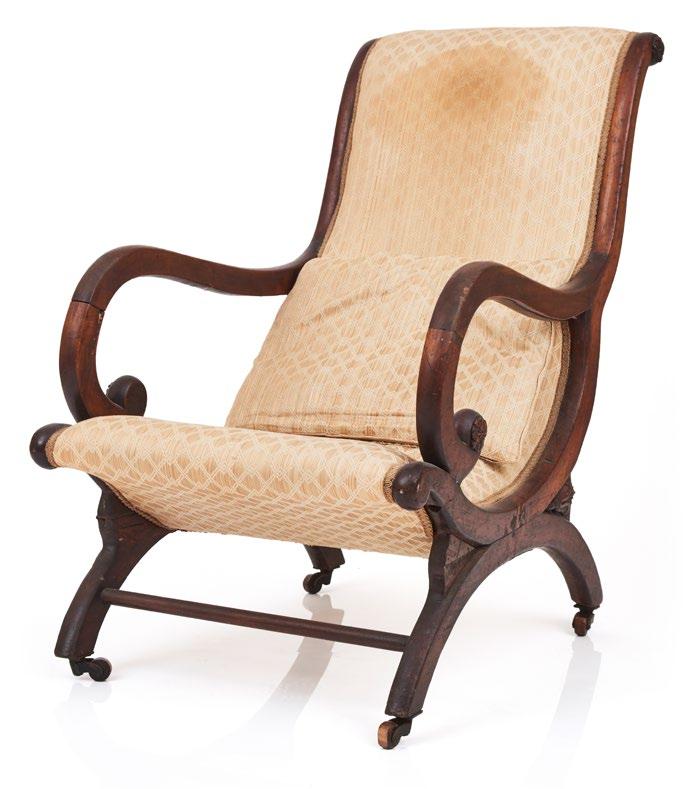
An Encyclopaedia of Cottage, Farm and Villa Architecture and Furniture (1833)
63cm wide, 103cm deep, 100cm high
$1,500–2,000
86
88 87 86 77
89
An unusual sterling silver-gilt and emu egg mechanical case on stand, (Lady's Companion) makers mark of J M Wendt Adelaide, Australian, 19th century emu finial and gilt interior, push down spring mechanism that opens the two sides of the egg to reveal the interior, supported on chains 51cm high, base diameter 9cm
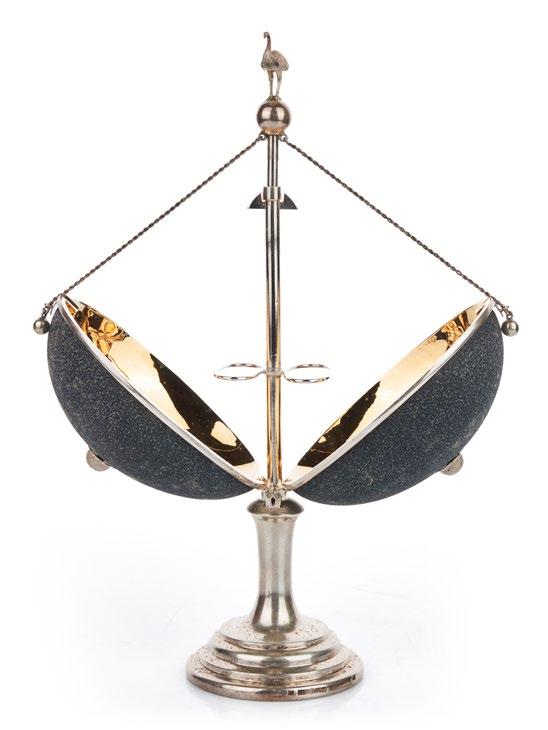
PROVENANCE
Acquired by the vendors, Bonhams, London, 27/06/2009, lot 234 (sold 5,166 pounds)
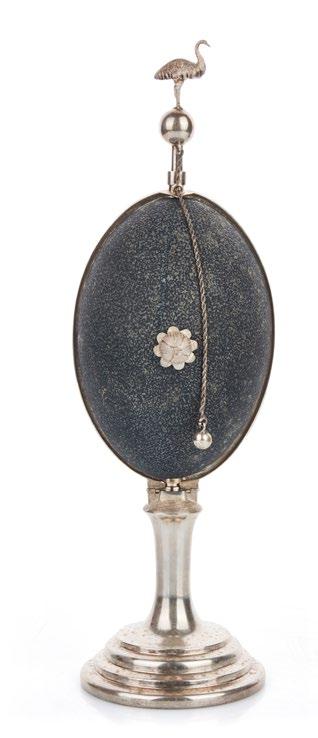
$4,000–6,000
90
An elaborate white metal and emu-egg presentation pedestal bowl and cover, Australian, 19th century emu finial and fern tree apparently unmarked 29cm high, 22cm wide across the handles
$800–1,200
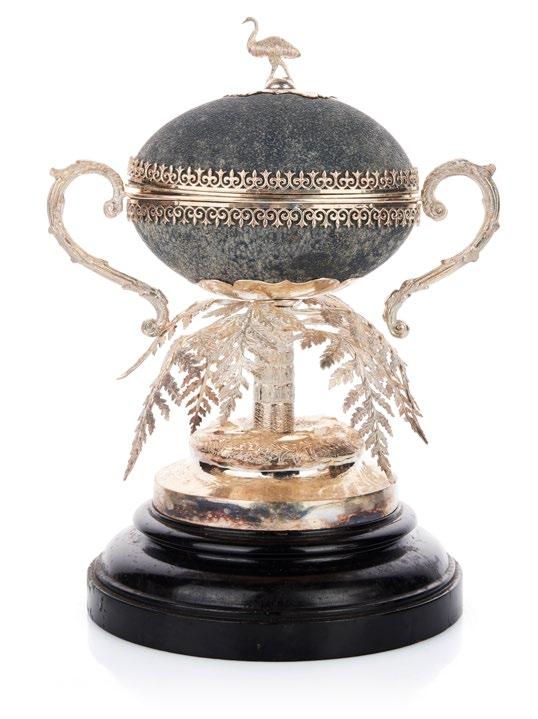
89 89 90 78
A highly Important first-period early colonial Cedar demi-lune string-inlaid fold-over side-table, Sydney origin, Australian, circa 1810
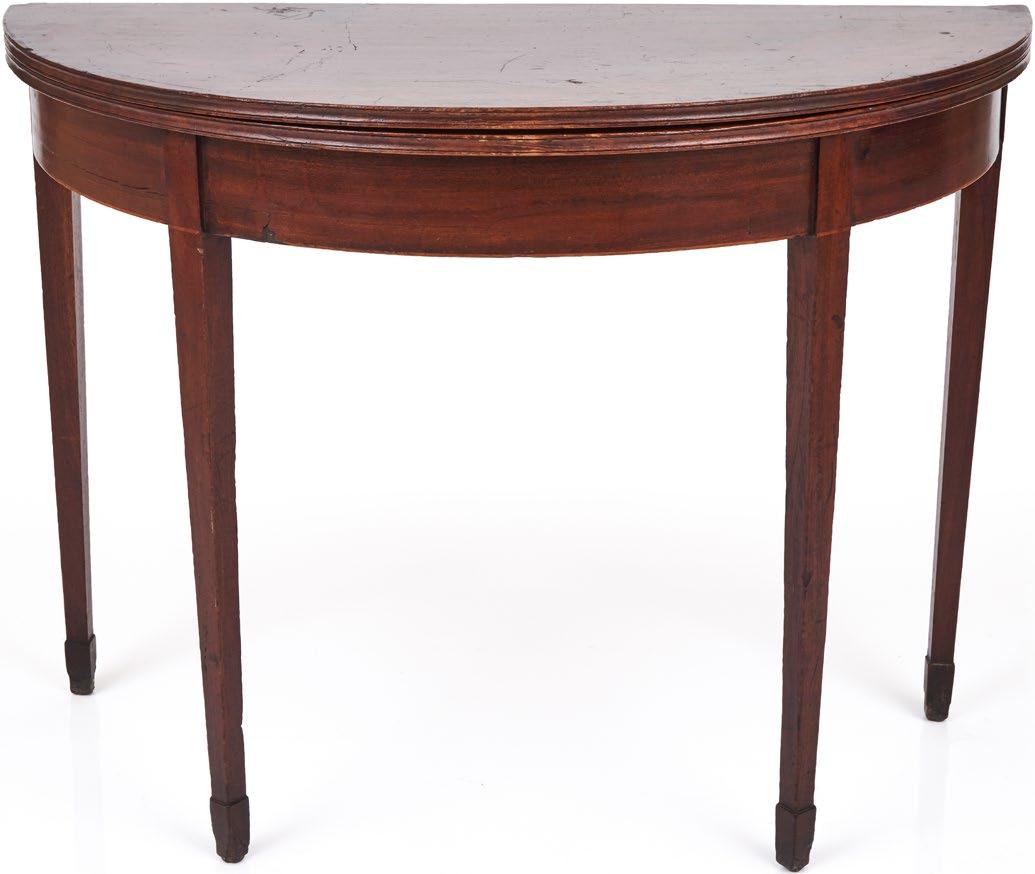
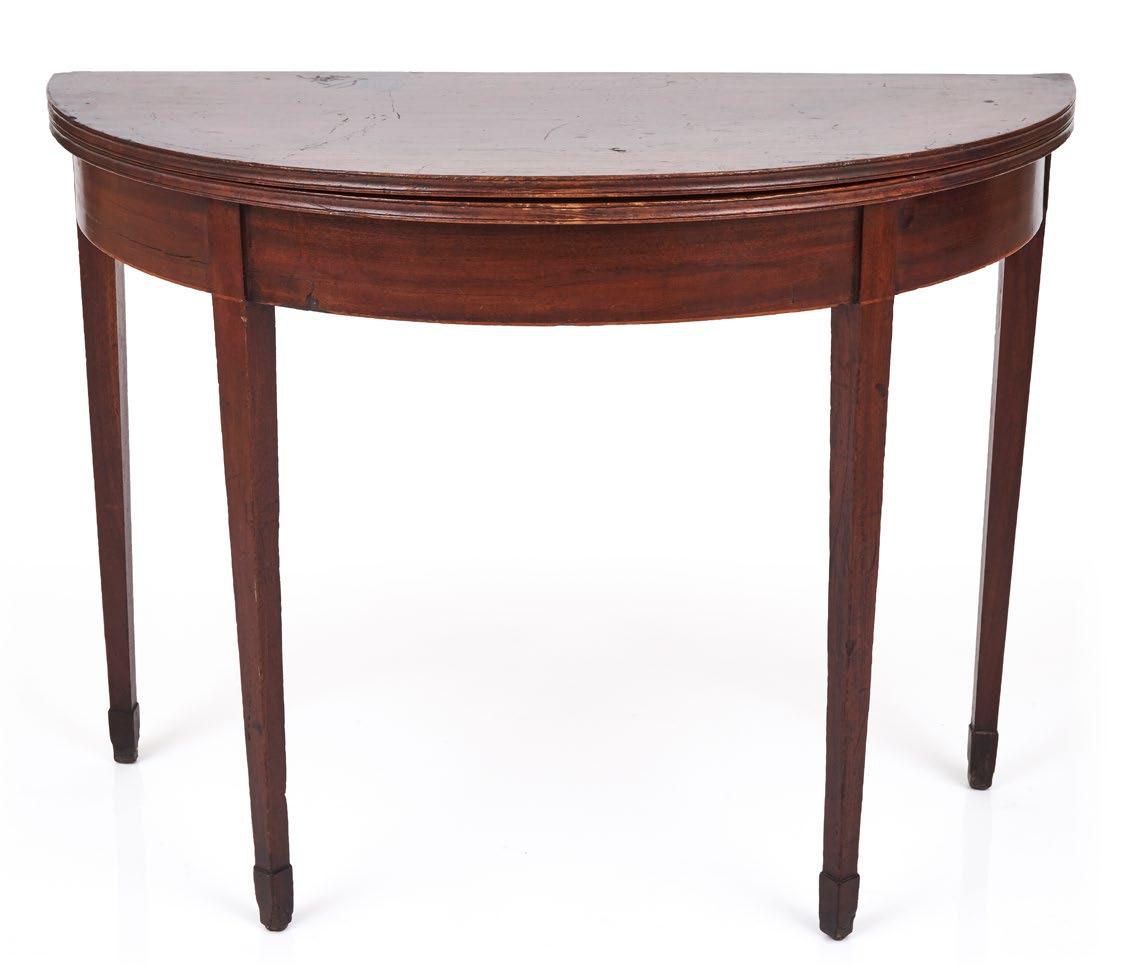
Primary timber tested as red cedar, secondary timber [back rail] tested as eucalypt, scientific wood test document supplied on request. Concave, scratch moulded edge, cedar veneer on cedar apron frieze detailed to the edge with a lighter timber. This detail continues through the squared and tapered legs, which terminate at the base with a spade shape. A remarkably early piece of Australian furniture, the only other one known was sold by Sotheby’s 16 August 2000 from a private collection, almost certainly by the same cabinetmaker $35,650.
98cm wide, 72cm high, 46cm deep
PROVENANCE
Private Collection NSW Acquired at the auction held at Somercotes, Mossgreen, Ross, Tasmania, 7 December 2008, lot 35 ($40,000.00 hammer)
A full and very detailed condition report and analysis of this table by Julian Bickersteth of International Conservation Services Sydney is included with the online photographs
$20,000–30,000
91
91 79

80
92
A rare and significant set of three brass King plates: King John of Wagala, Ellen First Queen of Iluka and Sandyman and Biddy, King and Queen of Ashby, Clarence River region, New South Wales, Australian circa 1840/50
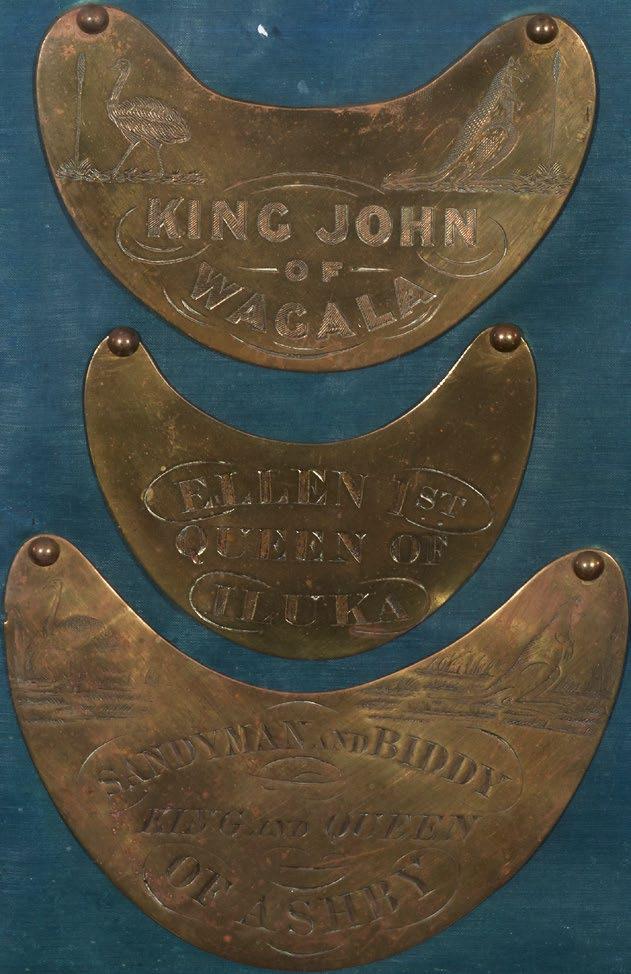
17cm wide, 14cm wide and 20cm wide, framed as one
PROVENANCE

By repute: Sold to a sea-captain in 1907
Left by him 65 years later to a member of the original family (?)
Then sold in 1985
Sold by a Mrs G Campbell Longueville, Sydney at Lawsons, Sydney, 21 July 1985, lot 316.
Sold Davidsons Auctions, Sydney, October 2019
92
$8,000–12,000 81
93
HENRY GRANT LLOYD (Australian, 1829-1904)
On Parramatta River from St. Leonard's, Sydney, NSW watercolour on paper 25 x 35cm
PROVENANCE
Christie's, Sydney 7 October 1986, lot 264A Private Collection
Christie's, Melbourne, 09/04/1991, lot 191 Private collection, Melbourne Deutscher~Menzies, Australian & International Fine Art, Sydney, 07/12/2005, lot 200 (sold $2400 hammer)
$1,500–2,500
94
HENRY GRANT LLOYD (Australian, 1829-1904)
Fairview on the Hawkesbury watercolour on paper signed, dated 1862 and inscribed lower right 25 x 35cm
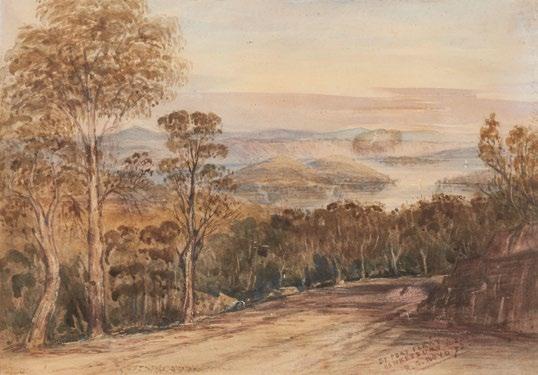
PROVENANCE
Christie's, Sydney, 7 October 1986, lot 264A Private collection
Christie's, Melbourne, 09/04/1991, lot 192 Private collection, Melbourne Deutscher~Menzies, Australian & International Fine Art, Sydney, 07/12/2005, lot 199 (sold $2400 hammer)
$1,500–2,500
95
HENRY GRANT LLOYD (Australian, 1829-1904)
By Peat Ferry, Hawkesbury NSW, 1873 watercolour signed, dated 1873 and inscribed lower right 25 x 35cm

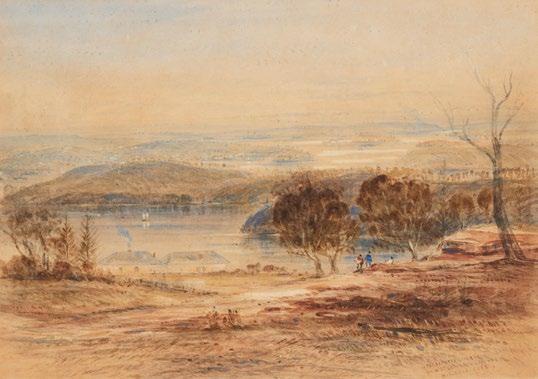
PROVENANCE
Christie's, Australian Paintings & Books, Sydney, 07/10/1986, Lot No. 269B
$1,000–1,500
95 94 93 82
A good and early string-inlaid cedar five-drawer chest, Australian, circa 1825 the top having strung edging of ebony and pine, the drawers all with ebony stringing 115cm wide, 54cm deep, 111cm high $7,000–10,000

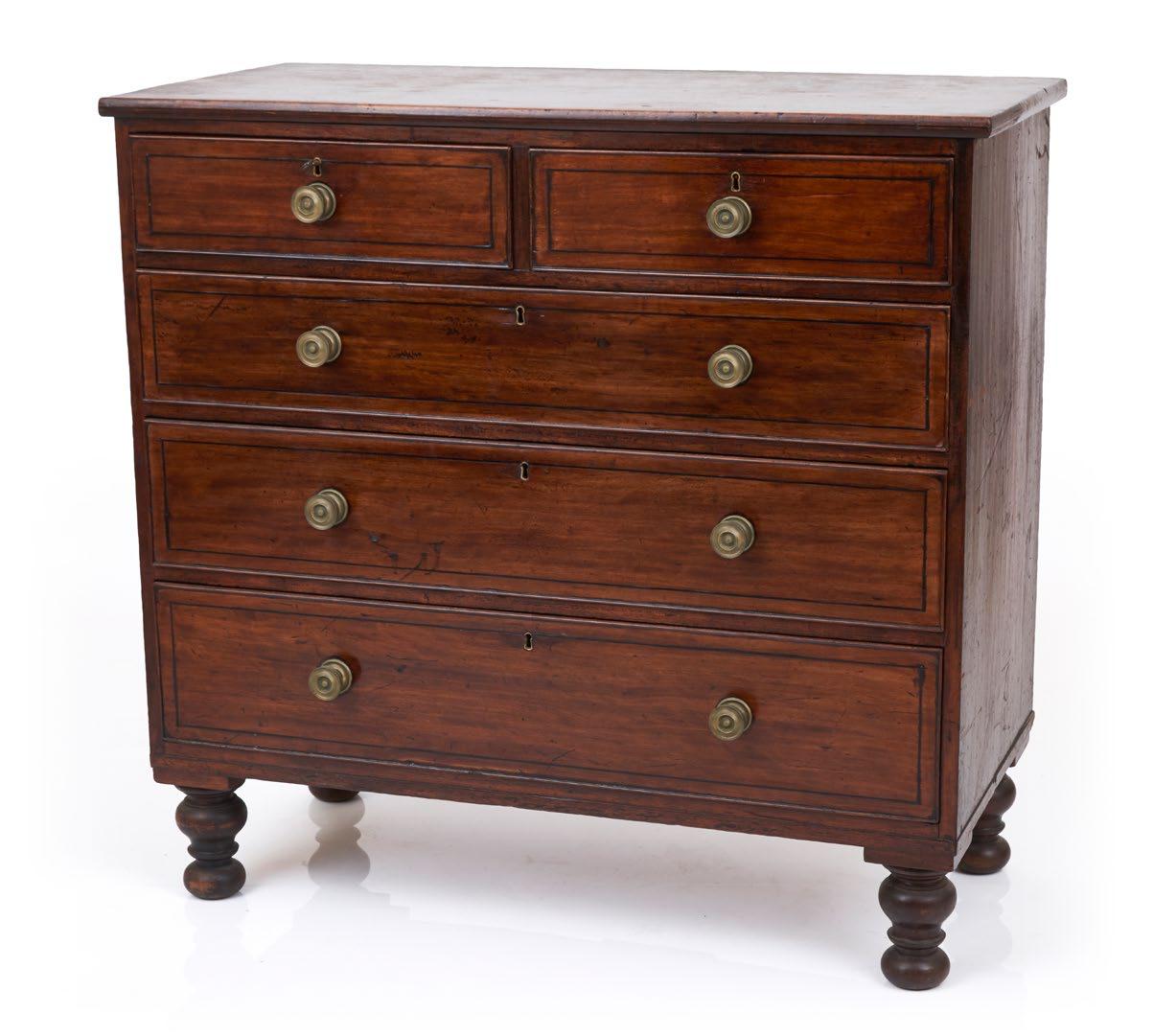
96
96 83
A cedar desk-top writing slope, Australian, circa 1850

flip top enclosing four drawers
40cm wide, 26cm high, 43cm deep
$400–600
98
A cedar lyre back swivel-seat desk-chair by Andrew Lenehan, Sydney, Australian, circa 1860
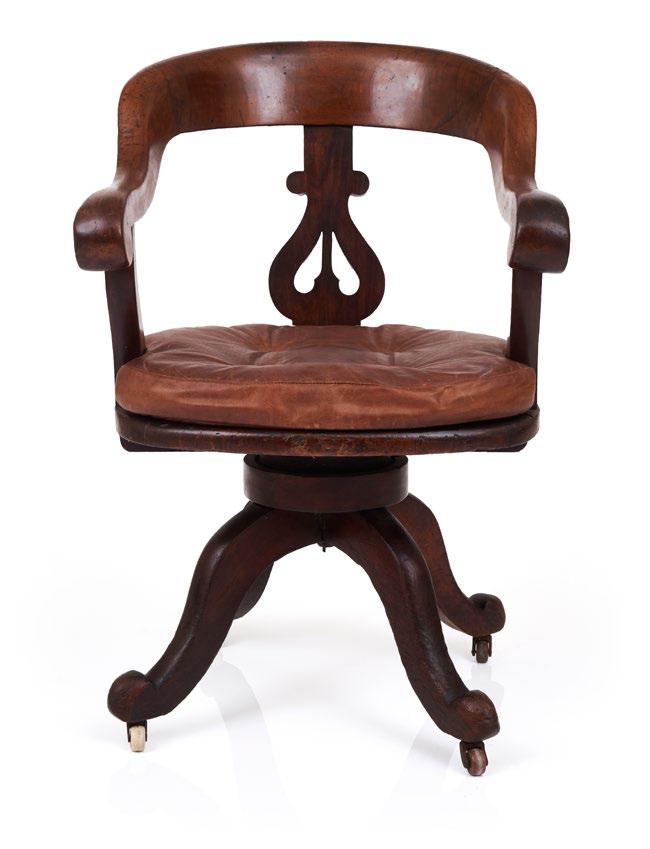
on ceramic castors, stamped to reverse of back-rail
62cm wide, 50cm deep, 82cm high
$1,500–2,500
99
A cedar pedestal drop-leaf work-table, Australian, circa 1845
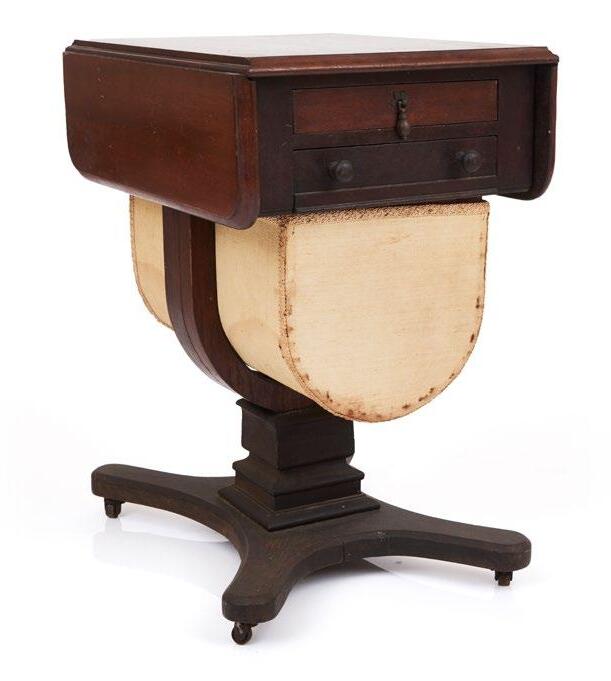
single drawer, with original wooden castors and Pembroke leaf action
54cm long 43cm deep closed, 68cm high
$1,500–2,000
97
99 98 97 84
A good cedar and cypress pine elevated bookcase, attributed to Andrew Lenehan. Sydney, Australian, circa 1850 with a feature rectangle of tulip-wood veneer to the raised centre the base 138cm wide, 57cm deep, 241cm high
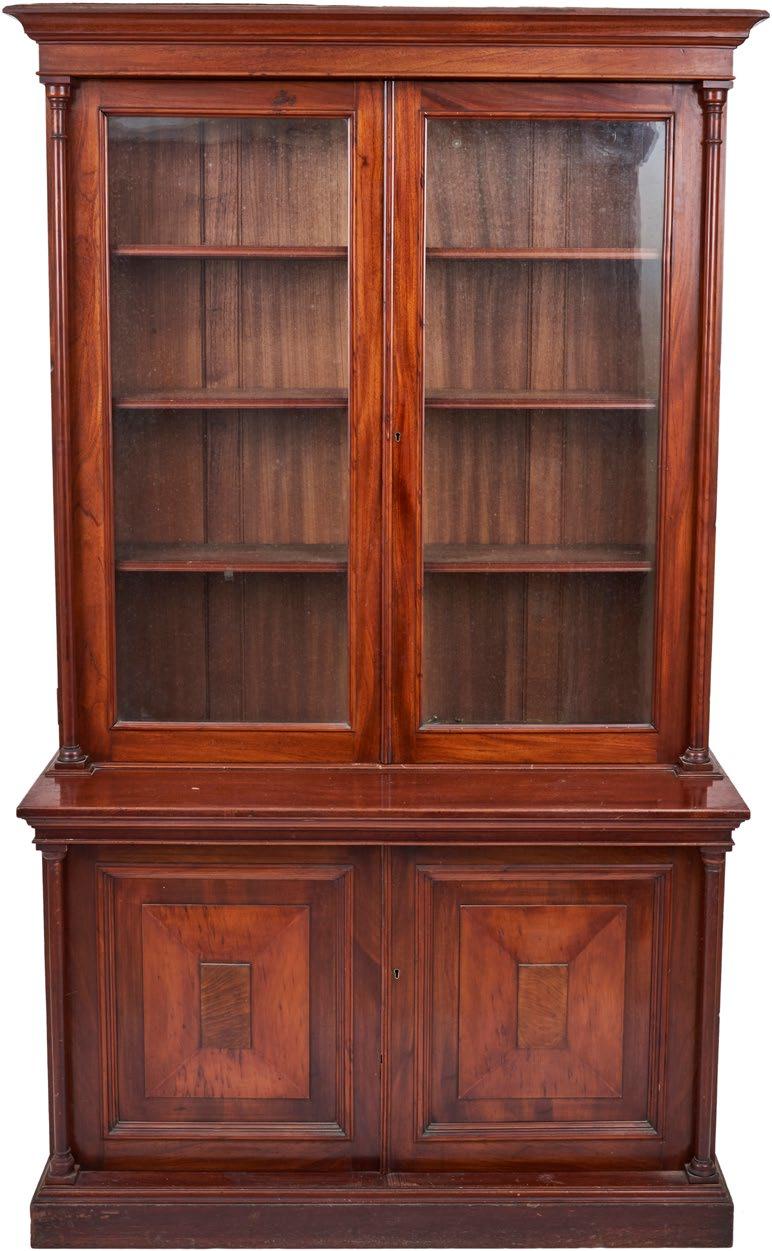
PROVENANCE
Sir Percy Spencer collection, Acquired by the current vendors from Goodman's, Sydney, July 2002, lot 379 (AUD$30,000 hammer)
$10,000–15,000
100
100 85
101
A Colonial cedar circular pedestal sewing table by Andrew Lenehan, Australian, circa 1845
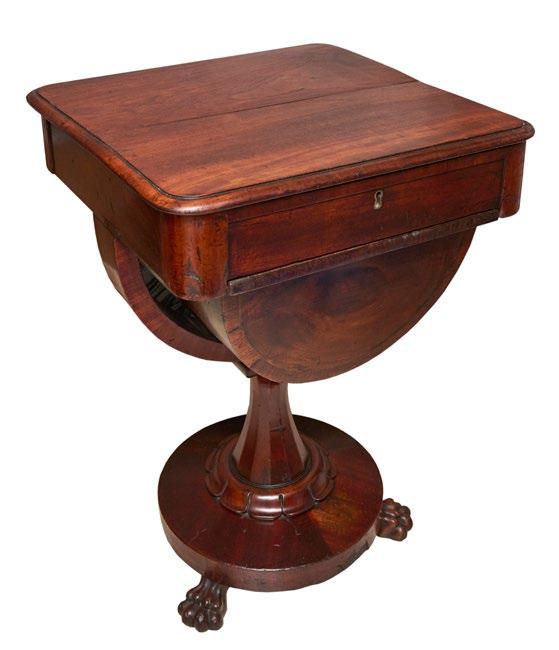
with hinged top that reveals two removable sewing trays and with a Lenehan label on the base of sewing trays
53cm wide, 50cm deep, 80cm high $4,000–6,000

102
A good Colonial cedar Grecian key inlaid five-drawer chest-of-drawers, Australian, circa 1835
inlaid with ebony and pine stringing 120cm wide, 53cm deep, 114cm high $5,000–8,000

103 102 101 86
A good cedar armchair in English George IV style, Australian, circa 1835 with brass and ceramic casters
72cm wide, 74cm deep, 92cm high
$3,000–5,000
104
A fine early Colonial cedar two shelf chiffonier, Australian, circa 1835 92cm wide, 45cm deep, 155cm high $4,000–6,000


103
104 87
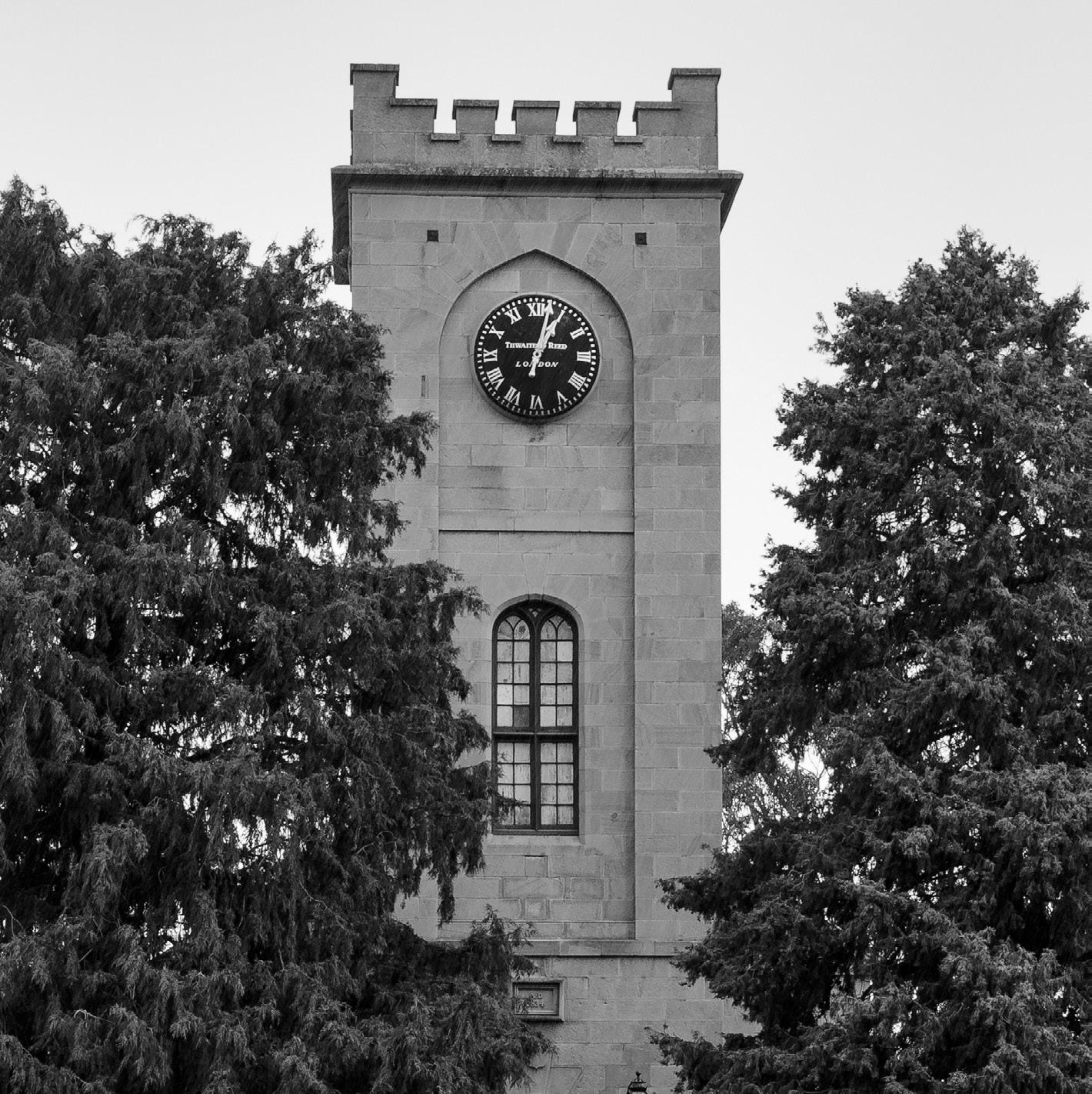
88
A fine red-cedar six-drawer Colonial cantilevered chest, Australian, circa 1835 122cm wide, 54cm deep, 113cm high $4,000–6,000


105
105 89
A very large and significant cedar bookcase on console stand, Australian, circa 1845
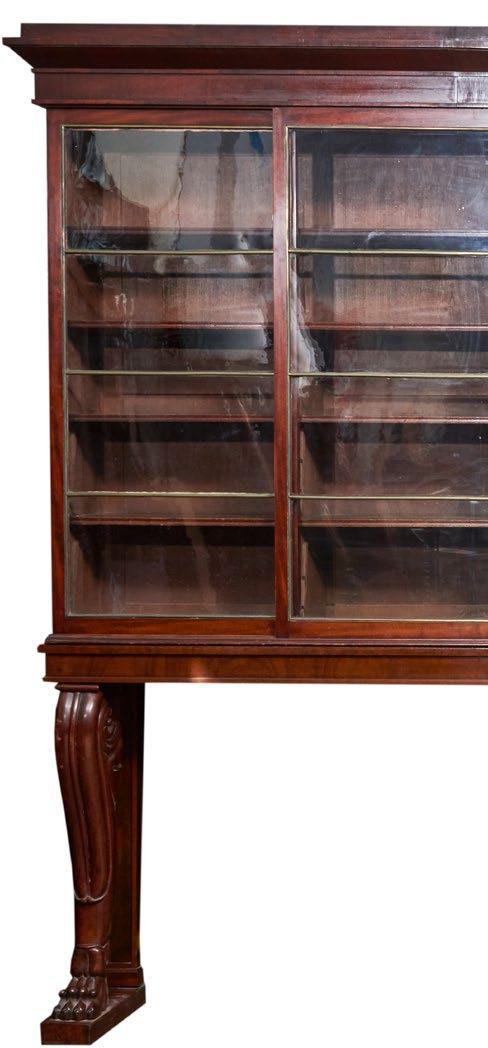
PROVENANCE
Customs House, Launceston. Sold Tullochs Auctions, Tasmania. $8,000–12,000
106
90
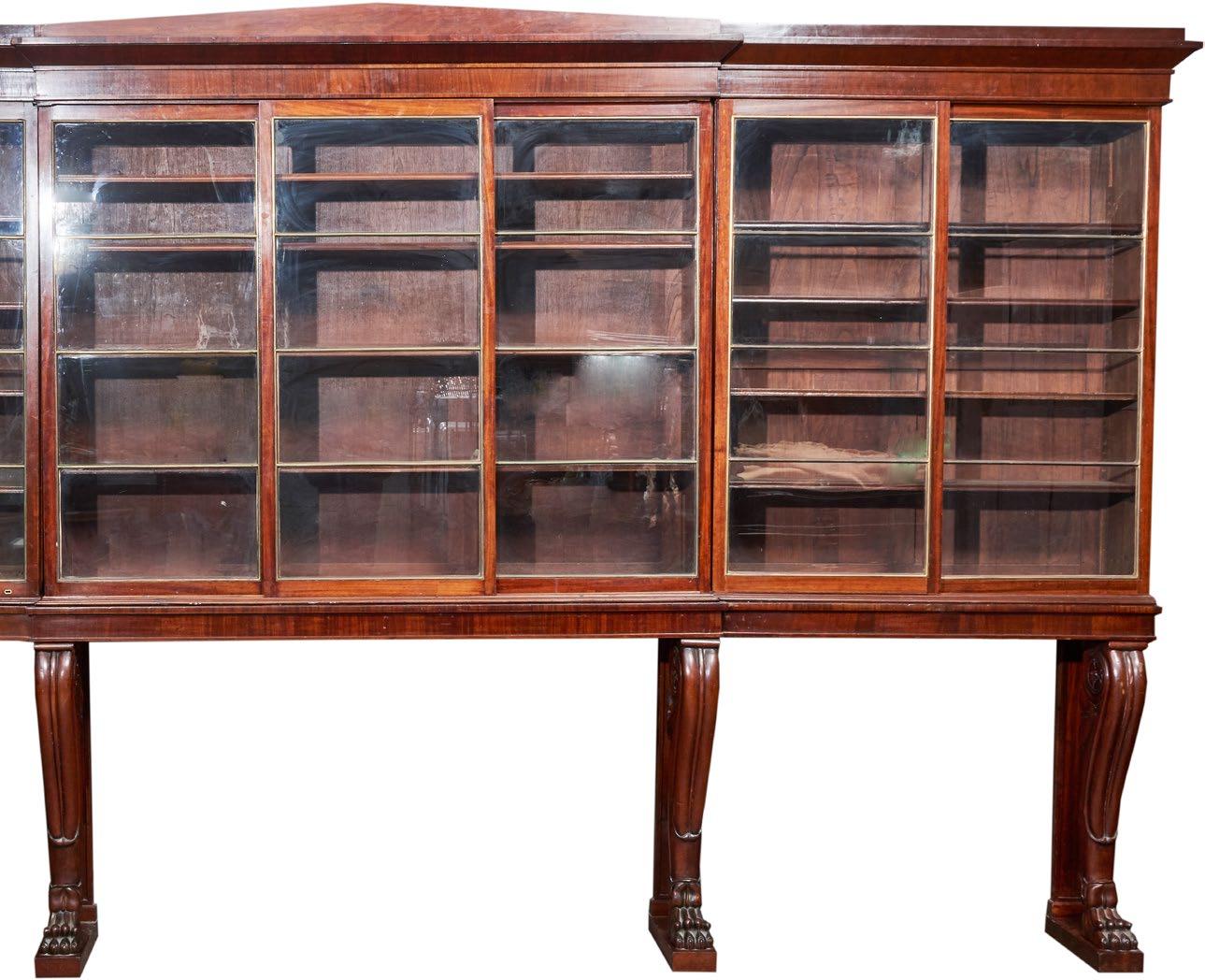
106 91
A good early cedar straight front chest of drawers, Australian, circa 1835 120cm wide, 58cm deep, 120cm high $2,500–3,500

107
107 92
A very unusual cedar double sided breakfront pedestal desk, by Andrew Lenehan, Sydney, Australian, circa 1855 with paper Lenehan, Sydney, trade-label 139cm long, 91cm wide, 76cm high

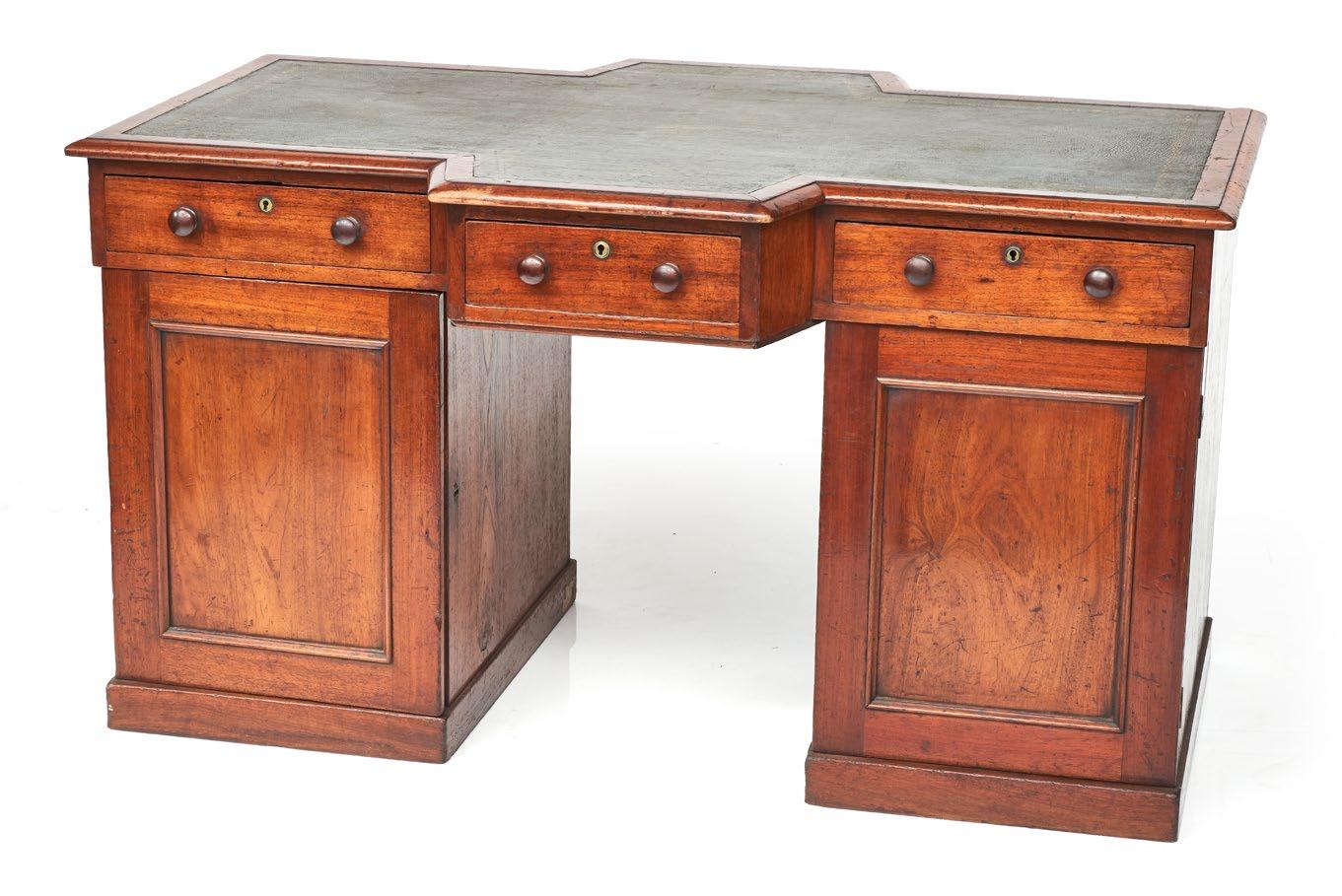
PROVENANCE
John Williams Auctions, Sydney $4,000–6,000
108
108 93
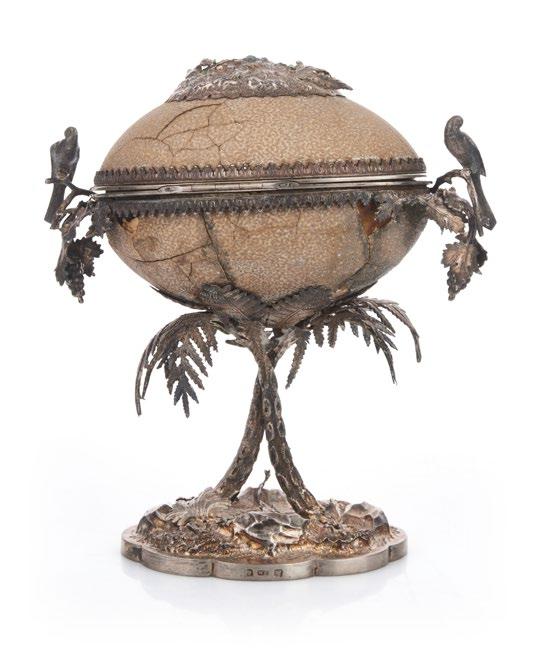
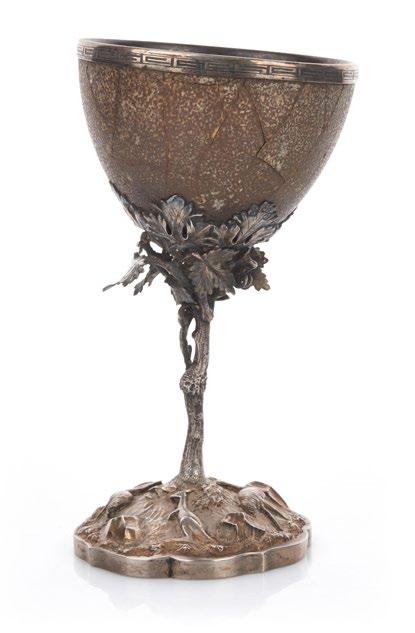
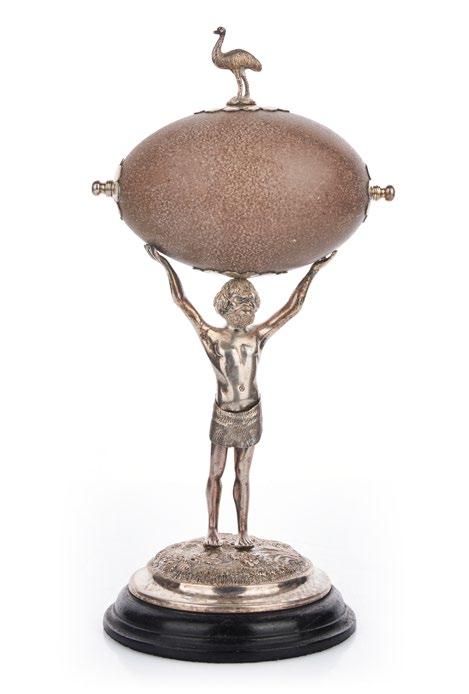
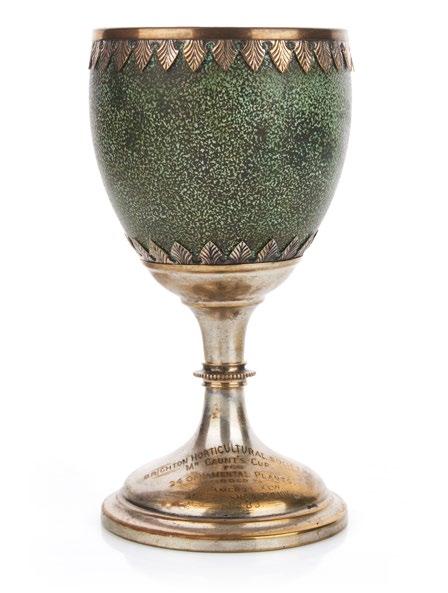
109 111 112 110 94
A historically significant sterling-silver mounted emu-egg presentation covered cup on pedestal base, makers mark of William Edwards, Australian, 19th century with sewing and other fitments in velvet lined interior
20cm high, 29cm wide
PROVENANCE
Descended from the family of Theodore Roosevelt. Acquired by the current vendors at Sloans and Kenyon, Chevy Chase MD, USA, 14 December 2018, lot 238 (2,300 US$ hammer)
Gifted to First Lady Eleonor Roosevelt, wife of then US president Franklin D.Roosevelt, at Rockhampton on September 9, 1943, on the occasion where she visited Australia to visit US troops stationed here. At 5pm on September 9 1943, Eleanor Roosevelt, the wife of then US President Franklin D Roosevelt, arrived by plane on the seventh day of her tour of Australia. The main purpose of her visit to Rockhampton was to visit American troops stationed there and to convey the thanks of her nation. Mrs Roosevelt wearing the uniform of the American Red Cross attended various formalities and prior to her departure the then mayor of Rockhampton Major Henry Jeffries presented her with an emu egg with native birds and animals.
$4,000–6,000
110
A silver-plated and emu-egg decoration, Australian, 19th century 30.5cm high
$400–700
111
A silver-plated and gilt emu egg presentation cup Brighton Horticultural Society, Mr Gaunt's Cup of 1883 presented to J. Cameron of Kew, Melbourne, Australian, circa 1880
16.75cm high, 8.5cm diameter
$500–800
112
A sterling silver-mounted emu egg cup, makers mark of William Edwards, Melbourne, Australian, 19th century stamped WE top base foot-rim and BB MD and emu and kangaroo stamped to one leaf
16.5cm high, 9cm diameter
PROVENANCE
Christie's South Kensington 22 March 2007, lot 1331 (1049.00 pounds)
$1,000–1,500
An impressive silver merino and treefern pattern centre-piece with glass bowl, attributed to William Kerr, Sydney, Australian (1838-1896), circa 1860


35cm high, 24cm diameter with glass dome and base 55cm high
$3,000–5,000
109
113
113 95
114
RAYMOND LINDSAY (Australian, 1904-1960)
Panama is burning –Henry Morgan and his buccaneers oil on canvas signed lower left and signed and titled to verso 60 x 75cm

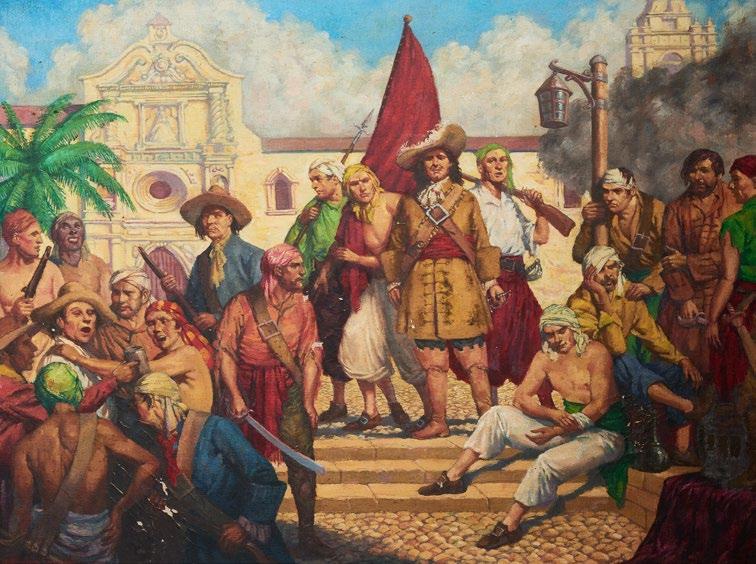
PROVENANCE
Lawsons, Australian & International Paintings, Sydney, 11/04/2000, lot 610 (sold $1100 hammer)
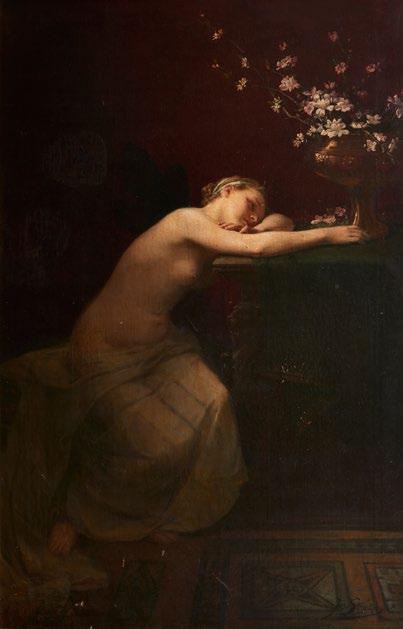
$1,000–1,500
115
RAYMOND LINDSAY (Australian, 1904-1960)
The Knight Errant no 2 oil on board signed and dated 30 lower right 56 x 45cm
$700–1,000
116 114 115 96
ARTIST UNKNOWN
Nude sleeping oil on canvas signed Jos Strockaul? and dated 1895 lower right
111 x 72cm
$3,000–4,000
117
A large cedar yoke-back carver-chair, Australian, circa 1870 upholstered in red chenille
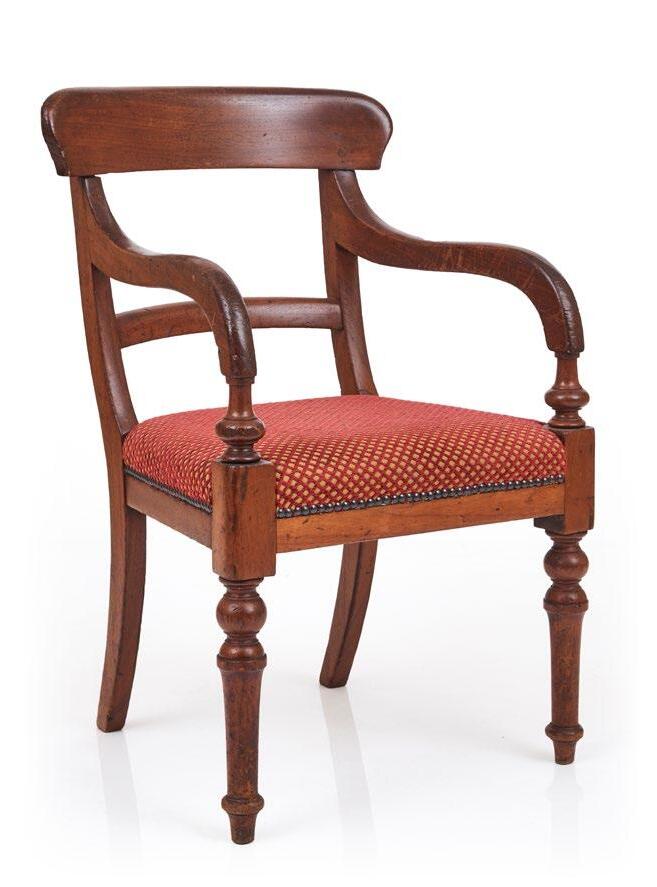
52cm wide, 48cm deep, 91cm high $800–1,200
118
A good quality cedar carver chair, Australian, circa 1835 58cm wide, 47cm deep, 87cm high $800–1,200
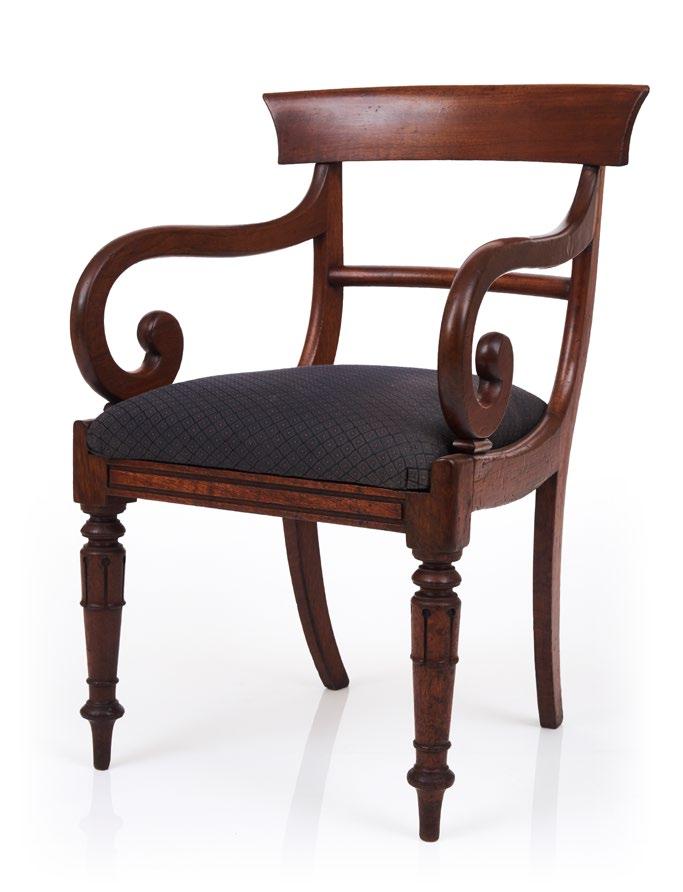
116
118 117 97
119
A Georgian mahogany Stilton cheese stand, English, early 19th century
$300–500
120
A set of cedar turned-leg and carpeted bed-steps, Australian, circa 1850 49cm wide, 70cm deep, 68cm high
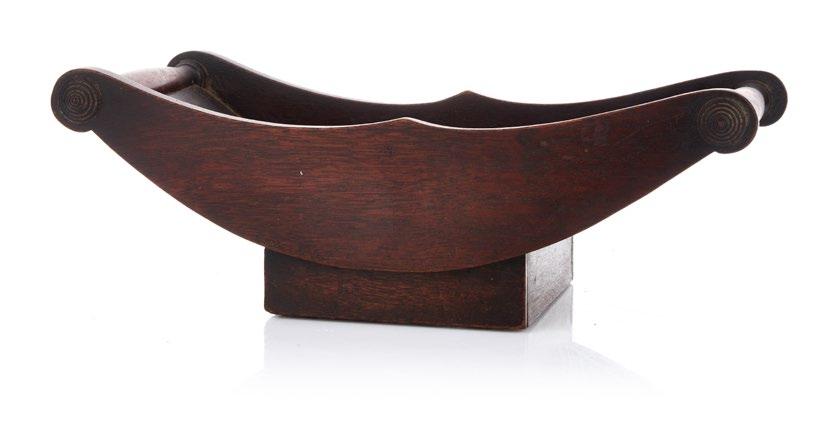
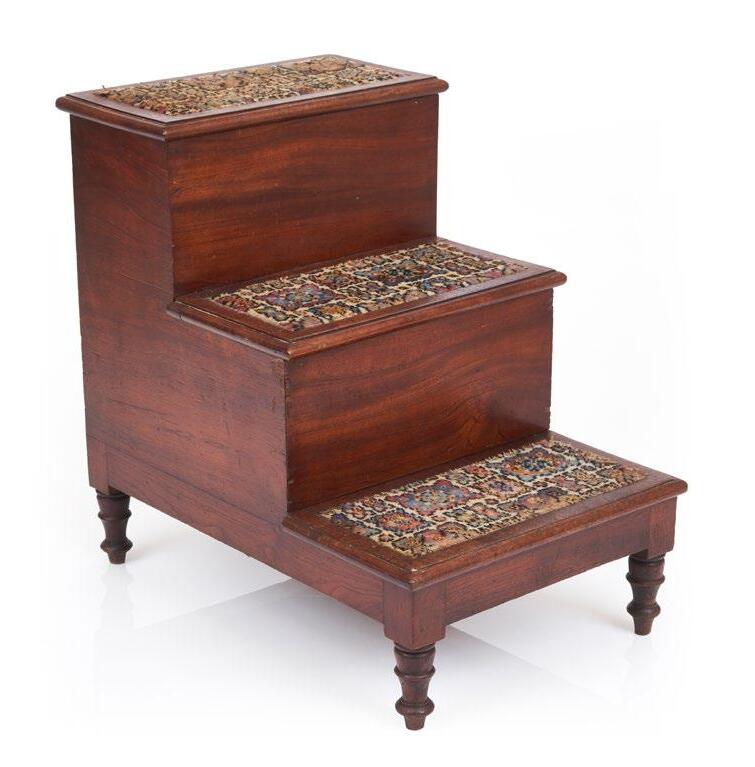
$600–900
121
A circular cedar umbrella stand, Australian, circa 1860 with removable top and original circular brass insert; stamped in bottom inside “A and Y Svensson La Trobe St., Melbourne - European Labour Only”
$500–800
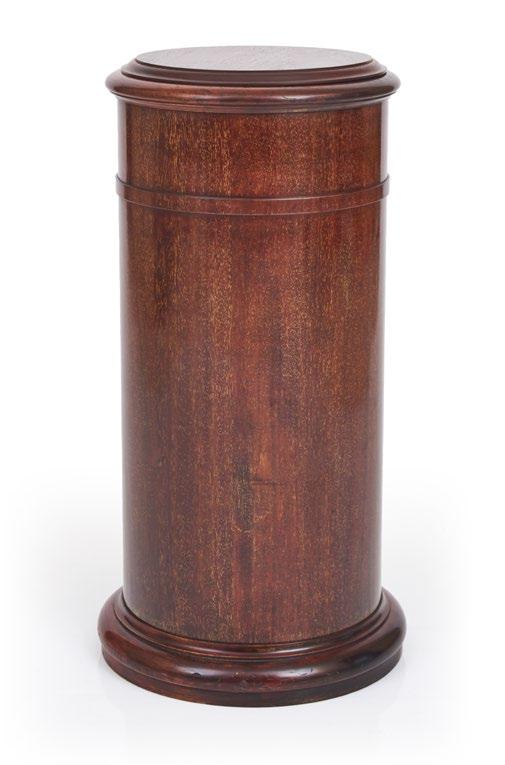
119 120 121 98
CONRAD MARTENS
(English/Australia, 1801-1878)
Sydney from the North Shore (View of Sydney from St Leonard’s) hand coloured edition heightened with bodycolour printed signature title and date 1842
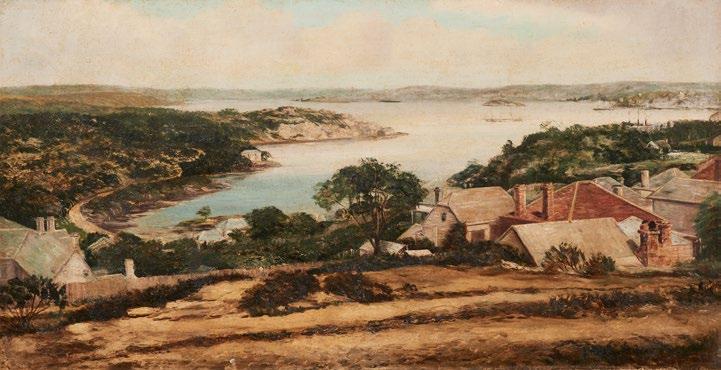

27 x 49cm
$800–1,200
123
E. M. RAWORTH (Australian, 19th century)
Indigenous encampment by a river with two people in a sailing boat

watercolour signed lower right and dated 93 30 x 65cm
$500–800
124
ARTIST UNKNOWN (Australian School, 19th century)
Sydney harbour oil on canvas
45 x 80cm
$2,000–4,000
122
124 123 122 99
A rare colonial cedar chiffonier by Joseph Sly, New South Wales, Australian, circa 1845

impressed stamp “J Sly“ twice to rear 108cm wide, 52cm deep, 165cm high
PROVENANCE
Once the property of descendants of Joseph Sly and thence to current owner $5,000–8,000
125
125 100
TOM HUMPHREY (Australian, 1858-1922)
Among the hills, circa 1905 oil on canvas signed lower left 90 x 120cm
PROVENANCE
Inherited by a Mr Don Hall whose grandfather was US Consul General in Australia in the 1950's It had been passed to the owners wife then in Melbourne who then sent it to the US where it hung in their family collection until being handed down the family and ultimately sold in 2002 to the present owners. Tom Humphrey was a painter of landscapes and a photographer. He was born in Aberdeen and studied at the National Gallery of Victoria under Oswald Campbell. He was a member of the Buonarotti club and painted with the Heidelberg school painters. He exhibited at the VCA and at The Victorian Artist Society.
$4,000–6,000

126
126 101
127
ABY ALTSON
(British, emigrated to Australia 1883, 1866-1948)
Portrait of a young lady in a revealing lace camisole and red dress oil on canvas signed lower right 60 x 49.5cm
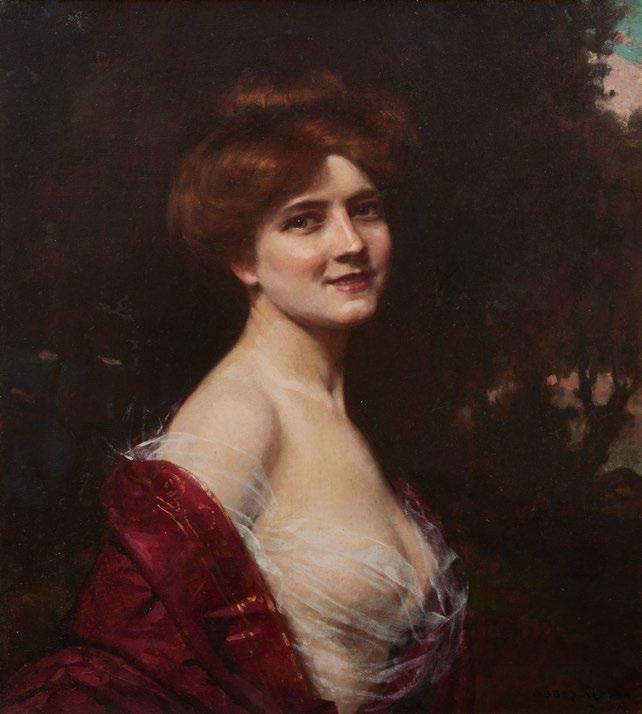
$3,000–5,000
128
H. HOFFMANN
(Australia, 19th century)
Australian Landscape with indigenous man and dwelling oil on board signed lower right 46 x 61cm
$800–1,200

127 128 102
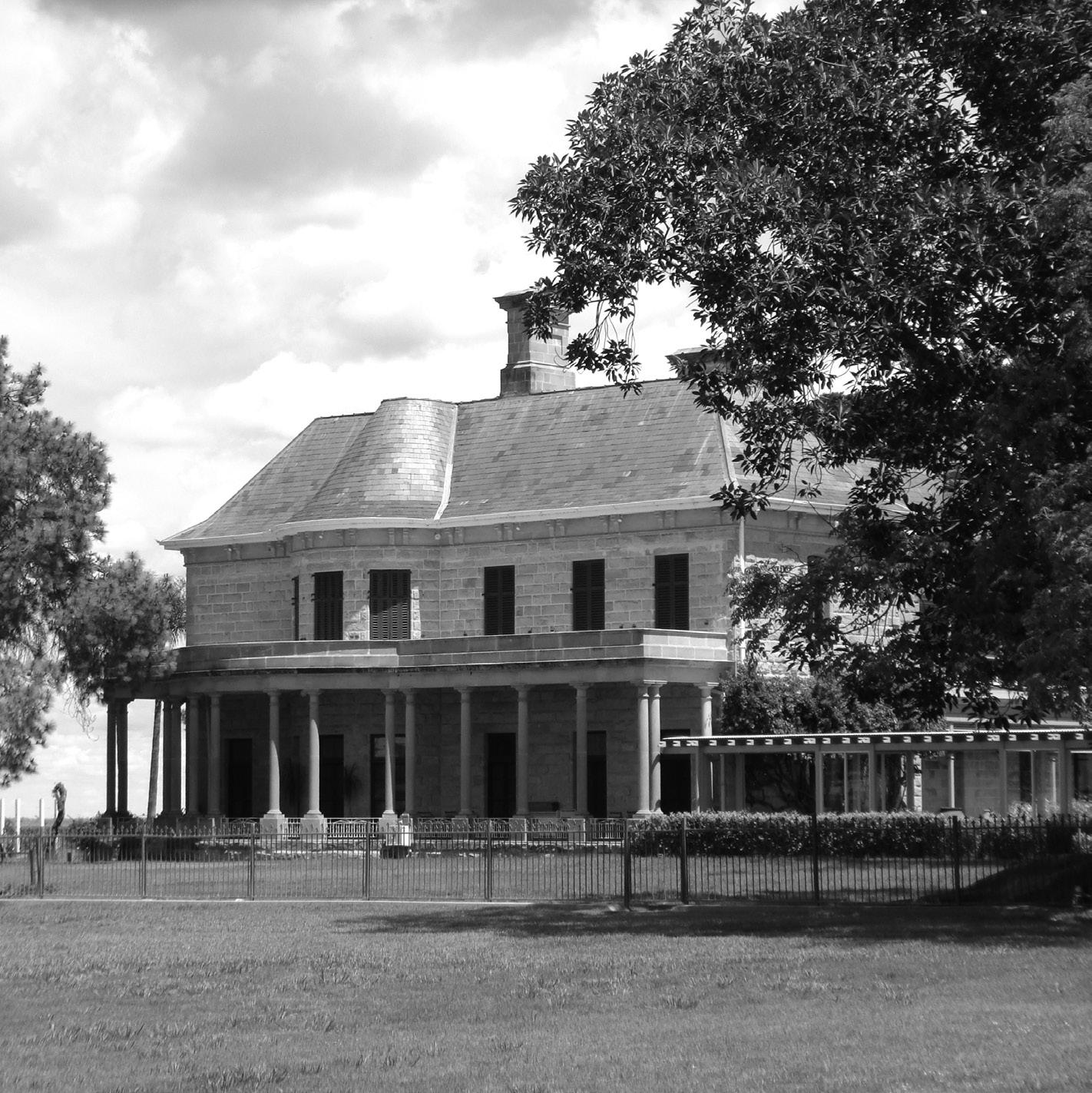
103
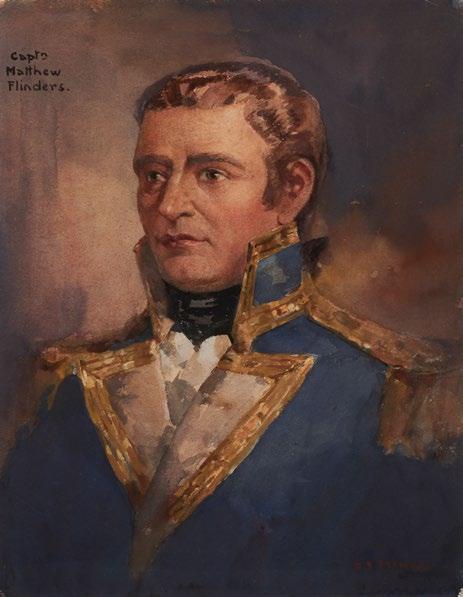
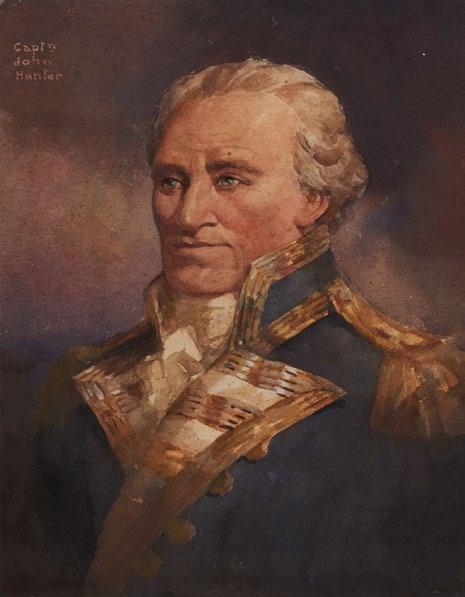
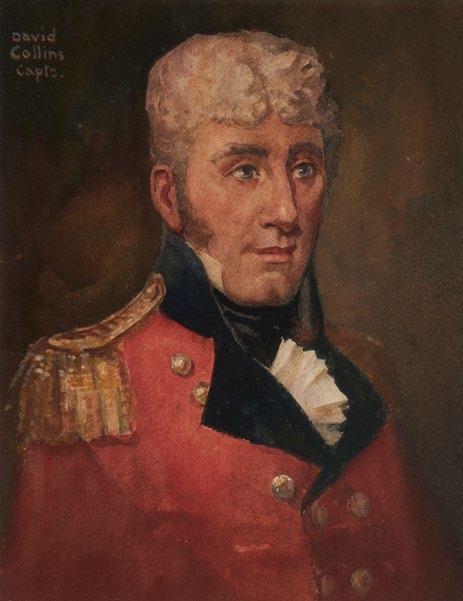

129 129 129 129 104
B. E. MINNS (Australian, 1864-1937)
Four Portraits of: Captain David Collins, Captain Matthew Flinders, Major George Johnston and Captain John Hunter
four watercolours
each titled upper left and signed lower right 38 x 27cm
$2,500–3,500
130
A good rosewood and cedar press-on-chest, attributed to Andrew Lenehan, Australian, circa 1850
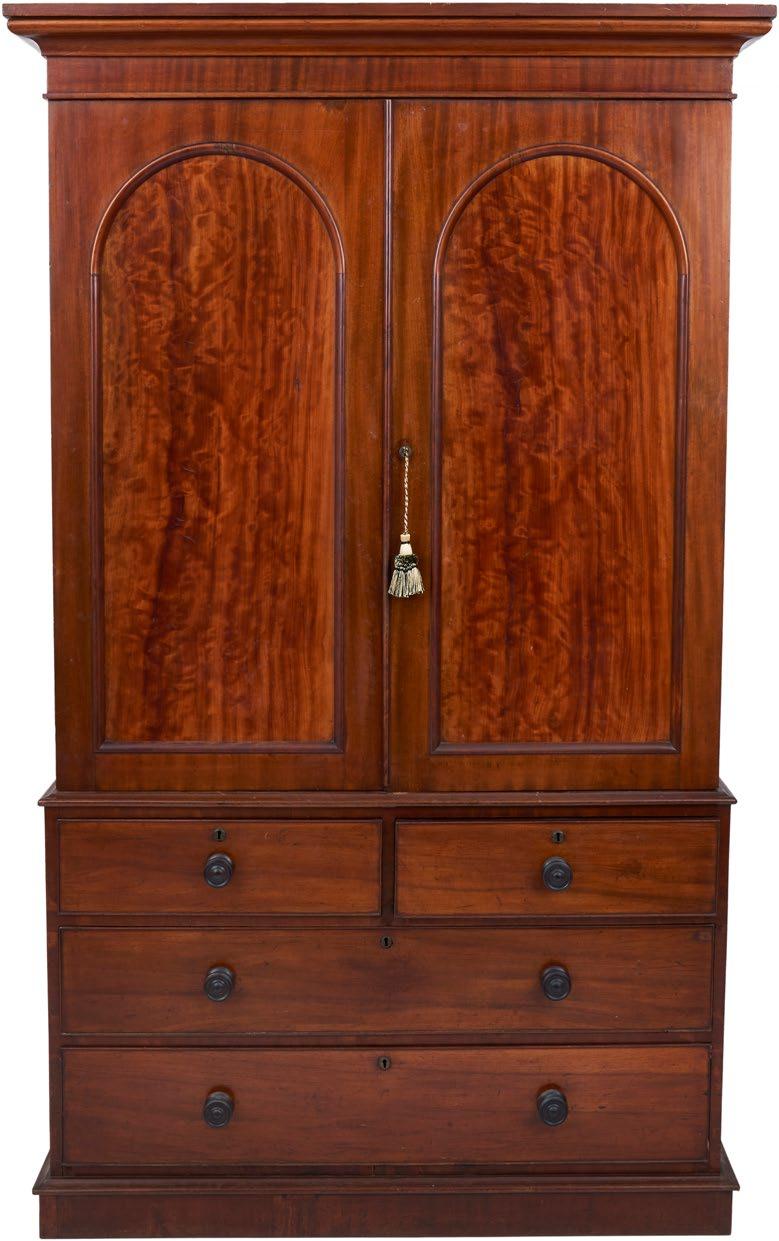
136cm wide, 59cm deep, 220cm high
$6,000–9,000
129
130 105
131
AUSTRALIAN SCHOOL (19th century)
Portraits of Mr and Mrs James Sisdale oil on canvas titled to verso maple frames
76 x 58cm
Sold together with a needlework sampler by Jane Sisdale, nee Jane Pinn Arscott, who married Janes Sisdale and who both became pioneers of the Wyong region of the Central Coast NSW.

$3,000–5,000
A significant rosewood and cedar threedoor wardrobe by Andrew Lenehan, Australian, circa 1855
right-hand side container four original slides on top of two short and two long drawers with military style handles. Left hand side –original hanging handles and boot drawer. The wardrobe has two trade labels and two stamps of Lenehan.
195cm wide, 69cm deep, 216cm high PROVENANCE
William Starkey who set up a ginger beer factory in around 1840-50 in Sydney acquired this wardrobe from Lenehan premises in Castlereagh street Sydney. It then passed by descent to Rosemary Watson (nee Hanson) who then sold it via Mossgreen Auctions, Melbourne
$6,000–8,000
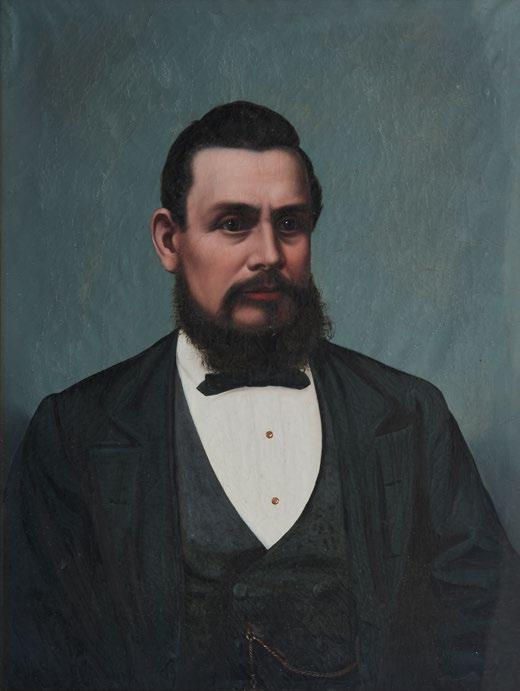
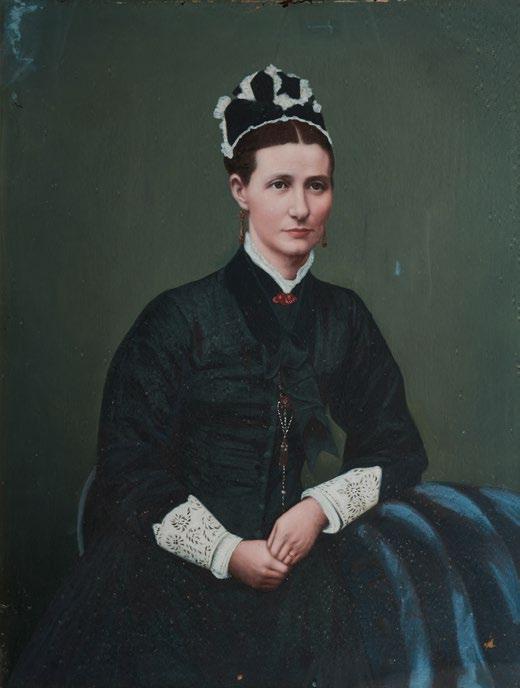 132
132
131 131 131 106
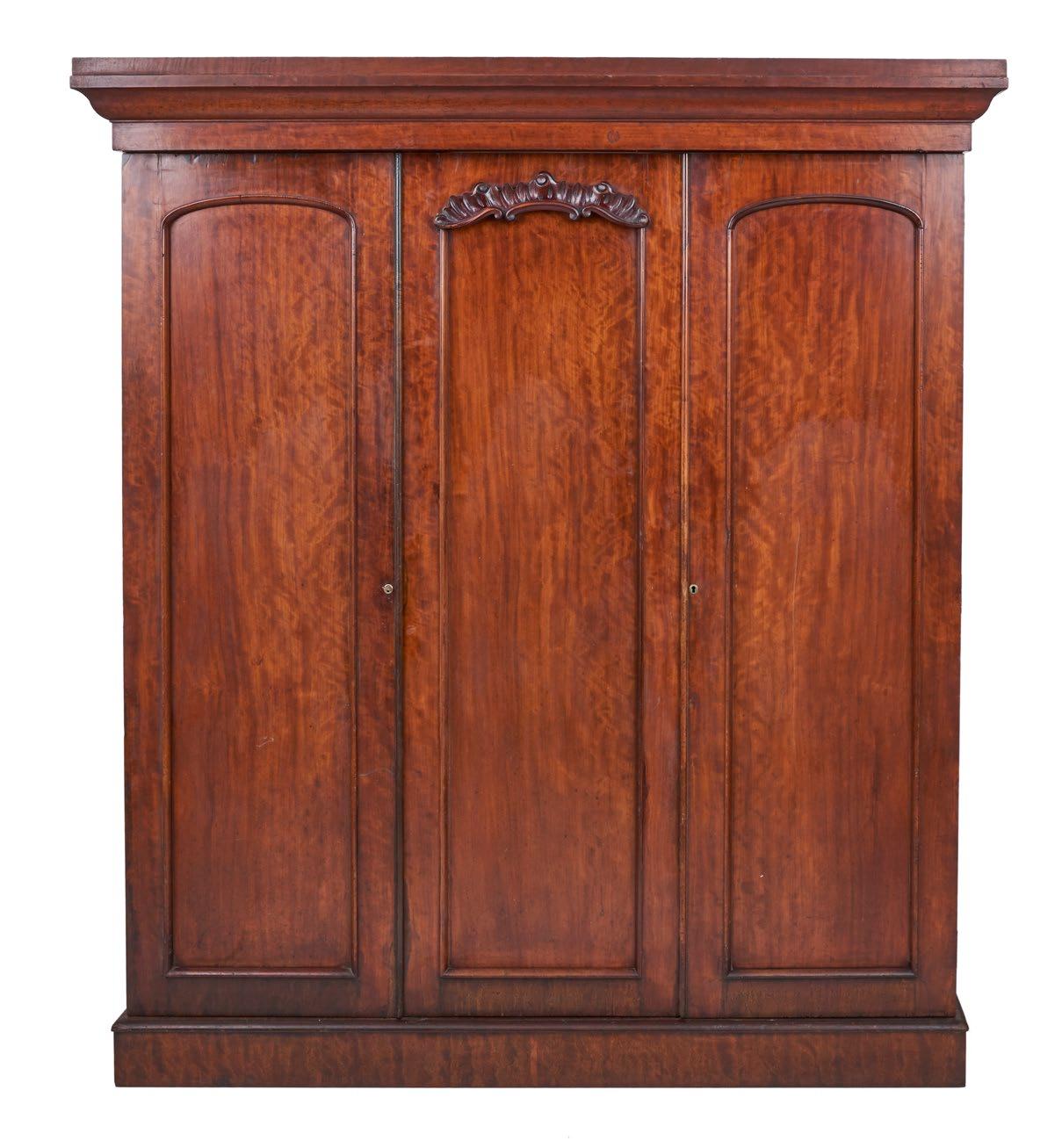
132 107
133
A cedar turned column rectangular hall-table, Australian, circa 1850 with wooden castors

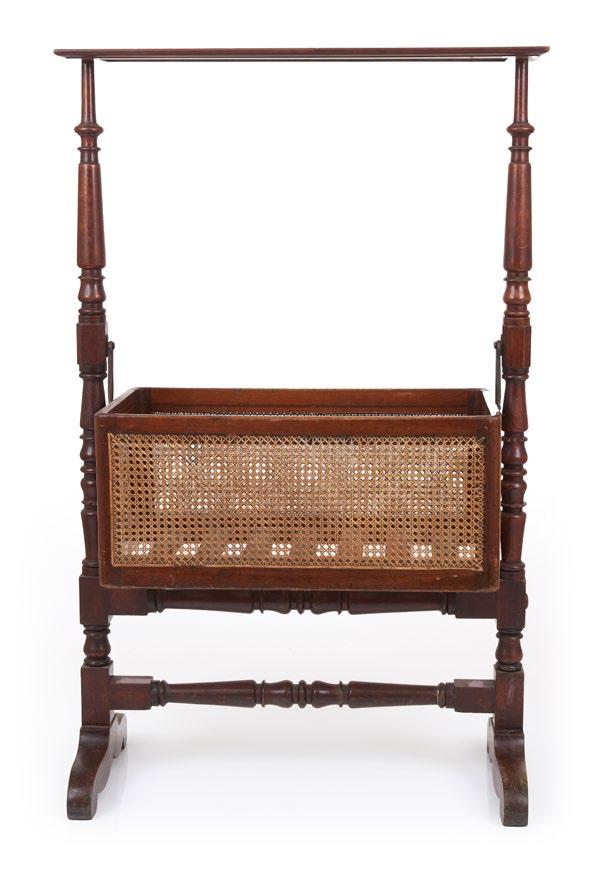
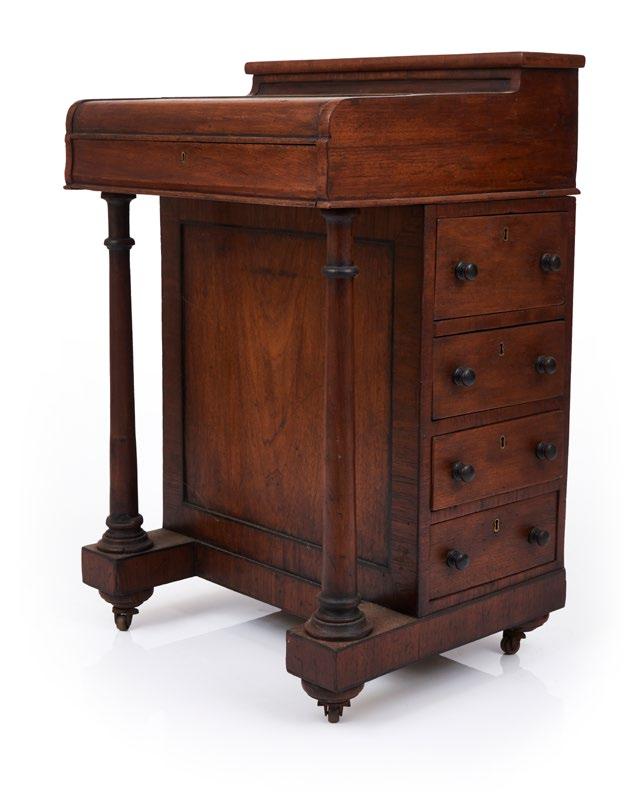
77cm wide, 41cm deep, 75cm high $1,200–1,500
134
A rare cedar Davenport desk, Australian, circa 1860 four side-drawers, pull-out leather tooled writing drawer complete with four small drawers with pen compartments with rear stationery compendium
61cm wide, 51cm deep, 91cm high $1,500–2,500
133 134 135 108
A large cedar trestle-form baby's cradle, Australian, circa 1850
107cm long, basket 51cm deep, 178cm high
PROVENANCE
The Collection of Michael and Maria Hobden, Lawson-Menzies, Sydney, 2001 ($3,100) $1,500–2,500
136
A fine and rare cedar Pembroke table, Australian, circa 1825
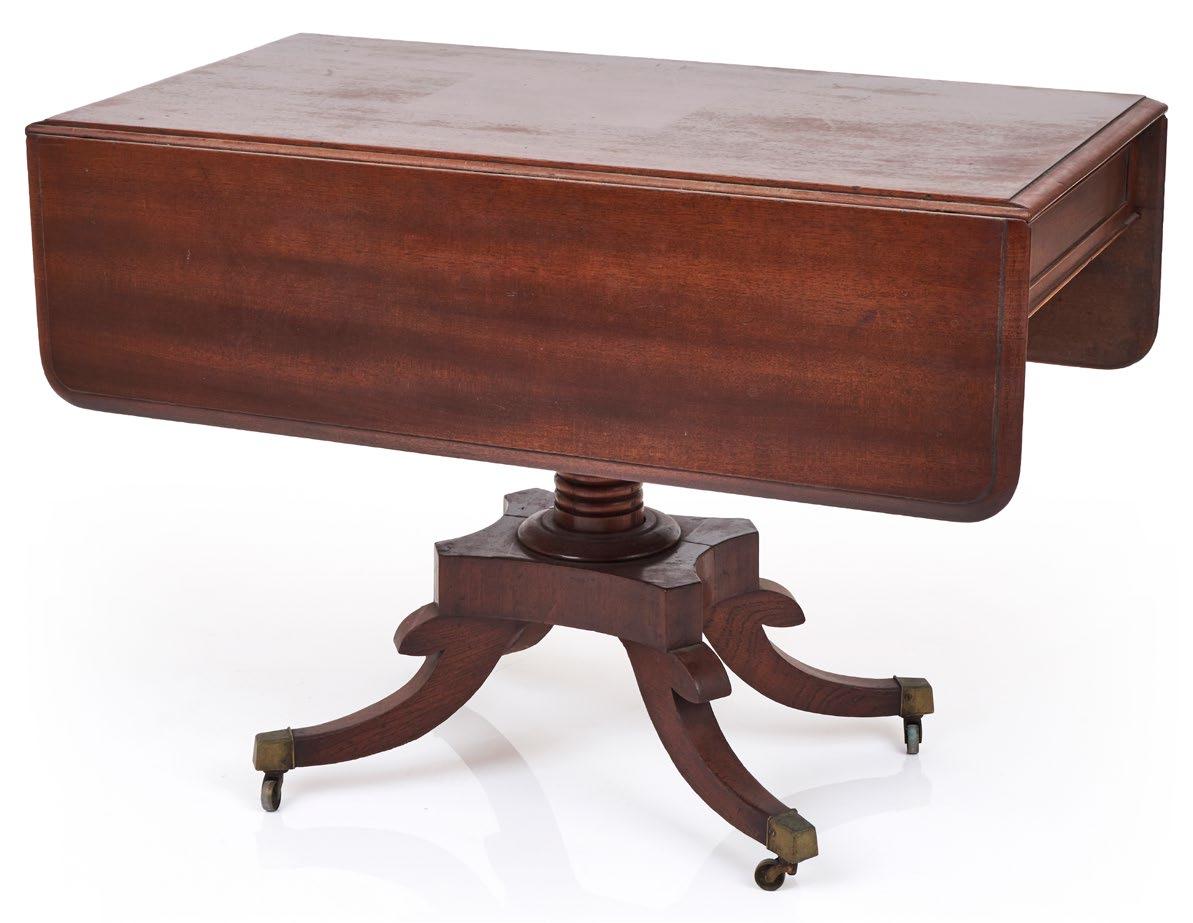
57cm wide closed, 106cm long, 76cm high $5,000–7,000

135
136 109
137
A cedar rectangular trestle-form library table, Australian, circa 1845
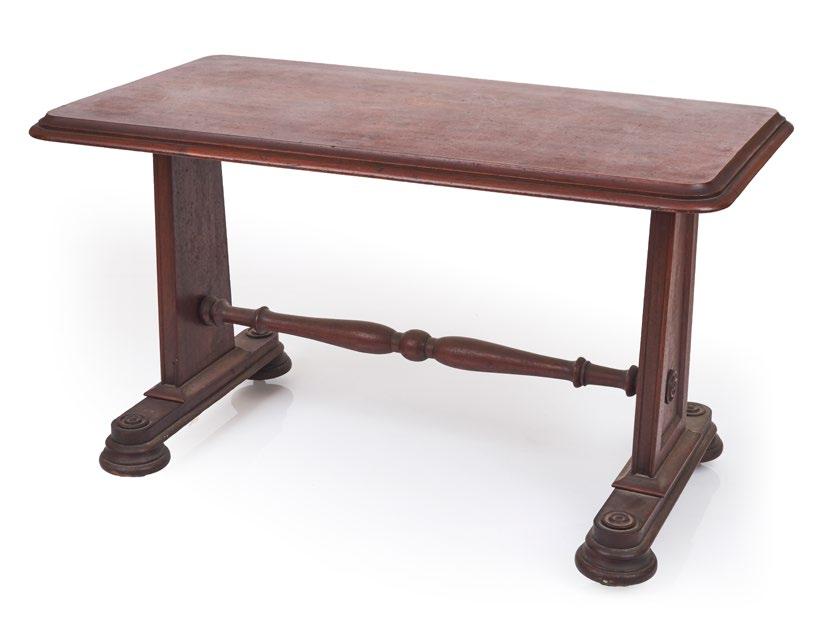
130cm long, 70cm deep, 74cm high
PROVENANCE
Sotheby's 2002, lot 7 (sold for $7,500 hammer) The Estate of the late E Bassett, Daughter of Dr W Bassett who commenced medical practice in Bathurst in 1862. The table came from his house Tal-Y-Garn in Bathurst.
$3,000–5,000
138
An early cedar fold-over rope-twist carved leg card-table, Australian, circa 1835

92cm wide, 45cm deep, 75cm high
PROVENANCE
Swan, Murray and Hain, Hunter Valley NSW 2002 lot 425 ($10,800)
See Australian furniture, ‘A Pictorial History’ [Fahy and Simpson] page 383, plate 420 for a similar example.
$4,000–6,000
137 138 110
An impressive flame cedar press-on-chest, Australian, circa 1835 110cm wide, 49cm deep, 204cm high $4,000–6,000
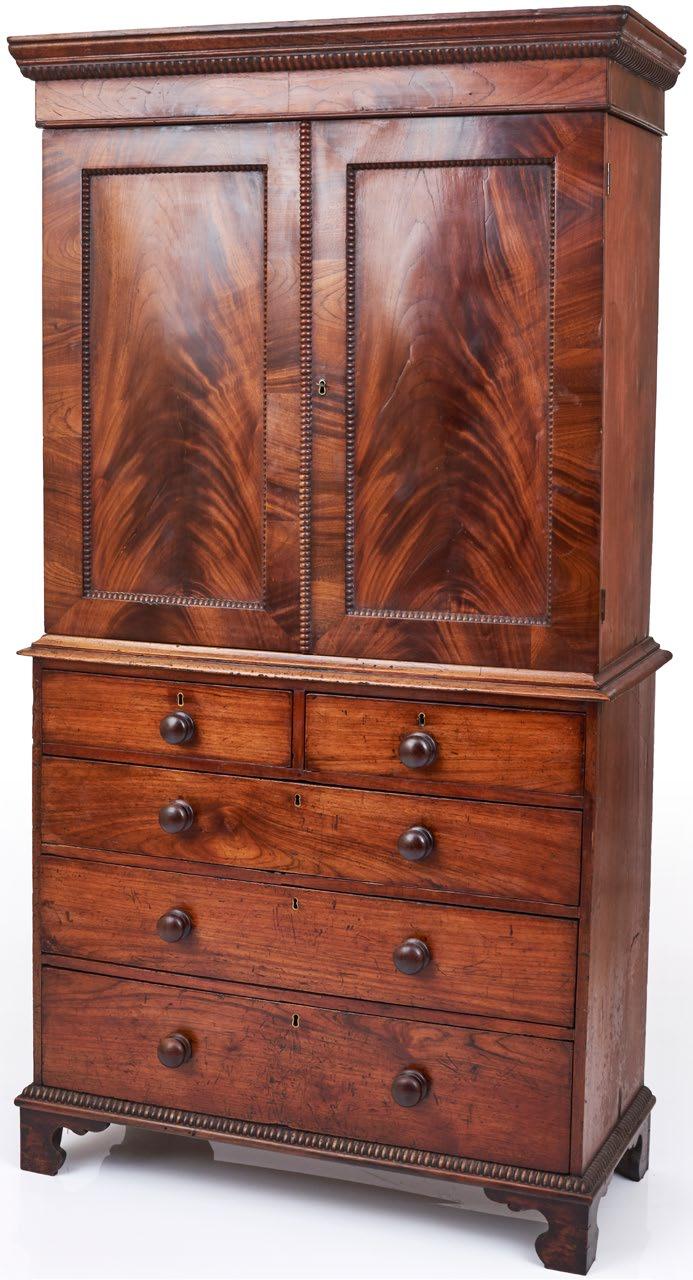
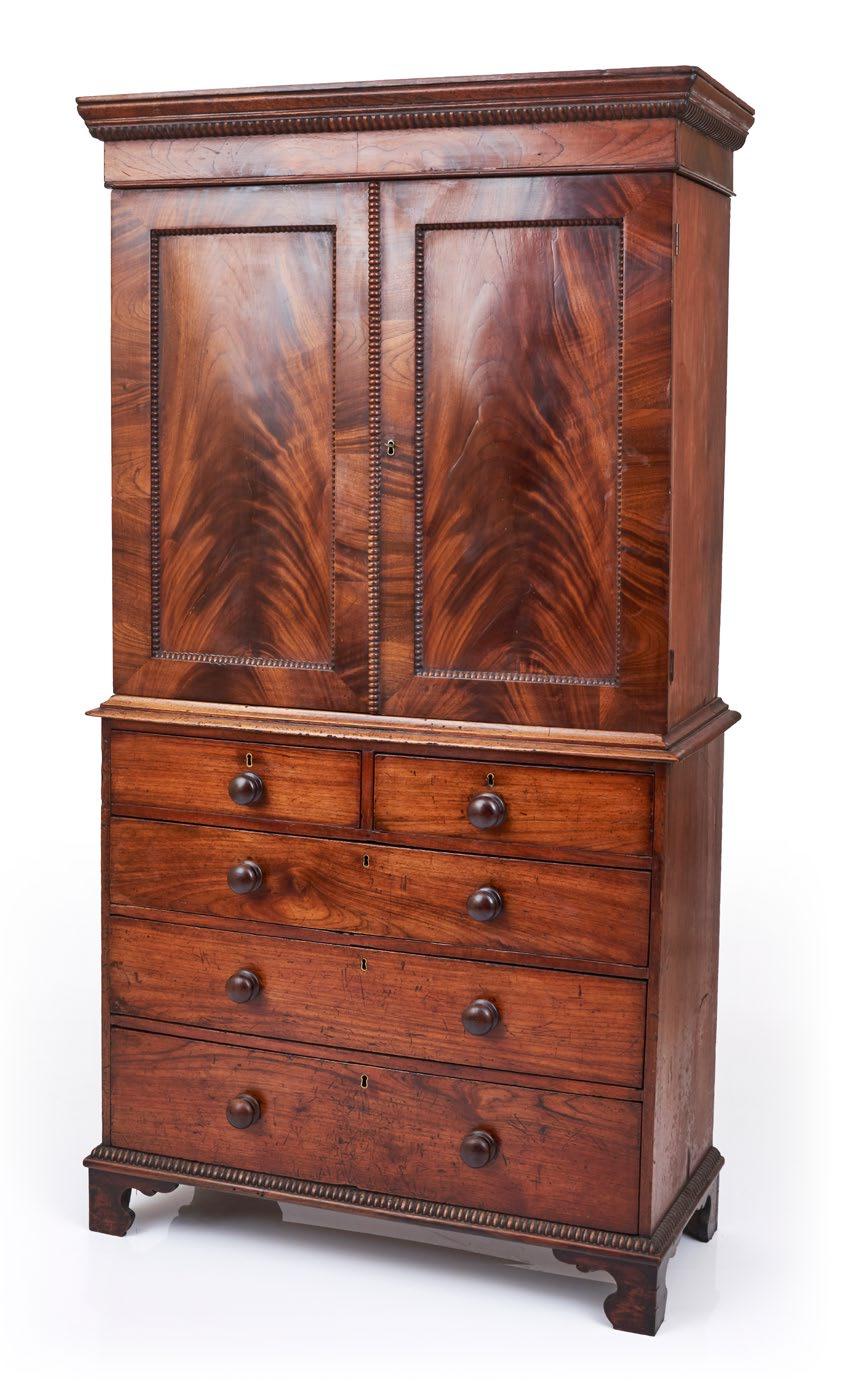
139
139 111
140
A rare and unusual string inlaid oval cedar toilet mirror, Tasmanian origin, Australian, circa 1840 with pierced scroll supports 73cm high, 59cm wide, 28cm deep
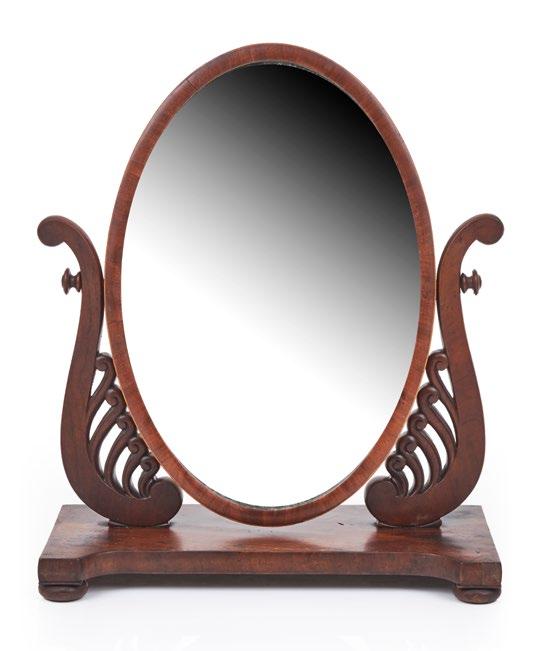
PROVENANCE
The Collection of Caressa Crouch and Carl Gonsalves, Mossgreen, Melbourne February 2015 lot 213 (sold for $2,600)
REFERENCE
Australian furniture: Pictorial history and dictionary, 1788 -1938, Kevin Fahy & Andrew Simpson page 309 (illustrated) $1,000–2,000
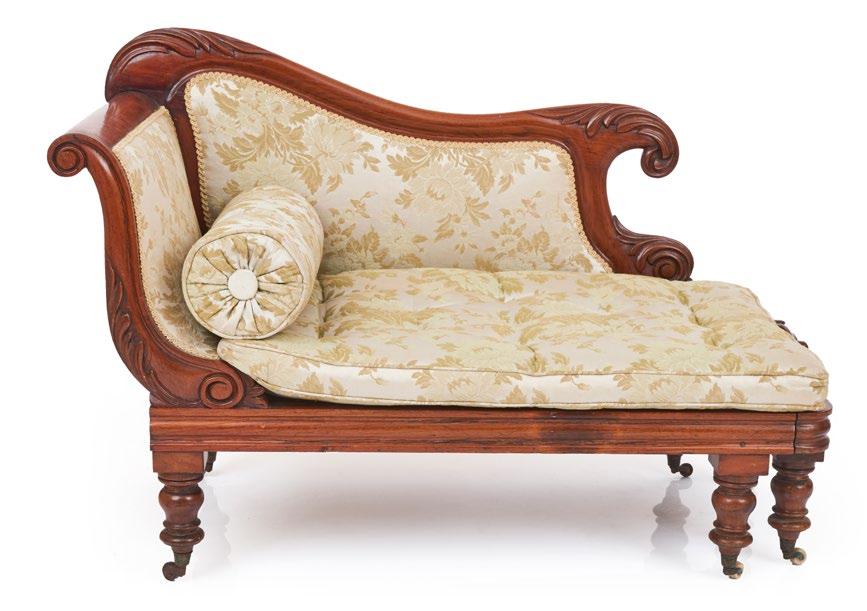
141
A good Colonial cedar six drawer chest-of-drawers, Australian, circa 1860 104cm high, 91cm wide, 54cm deep $1,500–2,000
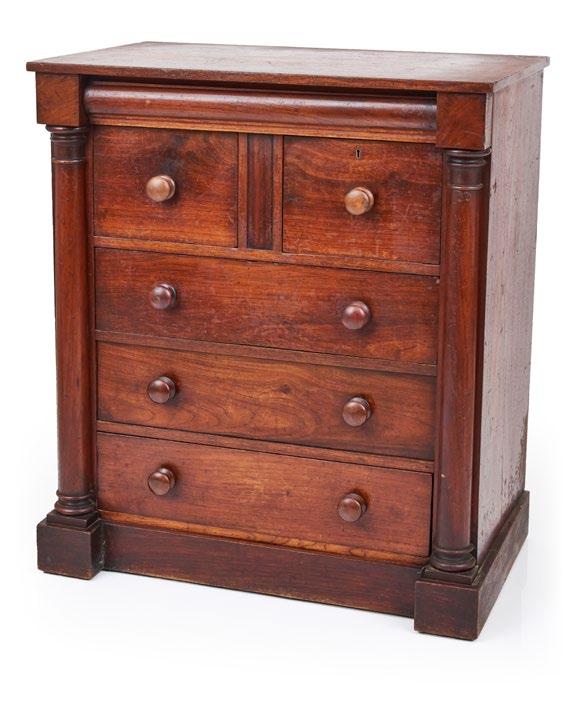
141 140 142 112
142
A rare and unusual extendable campaign chaise by S. W. Silver London, English, mid 19th century with pull out slide to facilitate a full length chaise, assisted by the double length swab and bolster cushion with a brass retailers label attached to the back for S W Silver London
115cm long, 54cm deep, 86cm high $1,000–1,500
143
A rare cedar cheval-mirror by Andrew Lenehan, Sydney, Australian, circa 1855 with carved feet and supports, shaped front to stretcher Paper label to back of Mirror “ A Lenehan, 66 Castlereagh St Sydney [1855-1857]”



133cm high, 91cm wide, 51cm deep
PROVENANCE
Davidson Auctions, April 2007, lot 76 (sold $18,500 hammer) $3,000–5,000
143
113
143 (Detail)
144
FRED LEIST (Australian, 1878-1945)
Antony Hordern's fire at Sydney's Haymarket, 1901
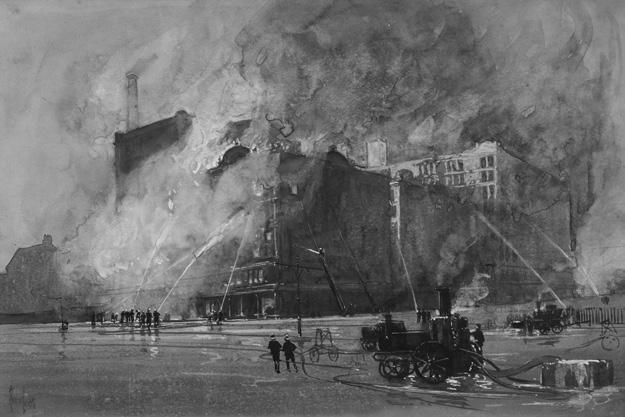
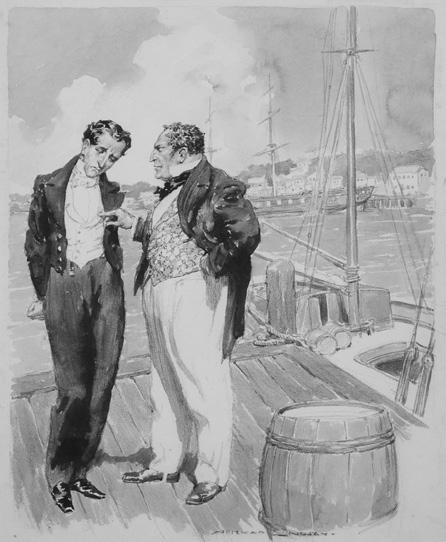
monochrome watercolour signed and dated lower left with attached label about the fire to verso 23 x 34cm
$400–600
145
PROFESSOR G. DUVAL (European, 19th century)
Yes or No
oil on canvas titled and attributed to gilt plaque 64 x 49cm
$1,500–2,500

144 145 146 114
NORMAN LINDSAY (Australian, 1879-1969)
The Quartermaster ink on paper signed lower right 34 x 26cm
PROVENANCE
The Collection of Helen Glad (Daughter of the artist) Warren Elstub auctioneers, 26 June 2000, lot 38 $1,000–1,500
147
A fine and impressive cedar and marble top console table, Australian, circa 1835 green Italian marble top 130cm wide, 56cm deep, 90cm high

PROVENANCE
Swan, Murray and Hain 2003 $5,000–8,000
146
147 115
148
A colonial cedar X frame stool, Australian, circa 1850 covered in traditional horse hair 60 x 50 x 40cm high

PROVENANCE
Tocal auction (Most likely Swan Murray and Haine), 2005, lot 195 (for $2,400)
$1,000–2,000
149
A fine and well figured Grecian string inlaid cedar Pembroke table, Australian, circa 1840 early triple ringed turned legs. 6cm wide closed, 115cm long, 74cm high $3,000–5,000
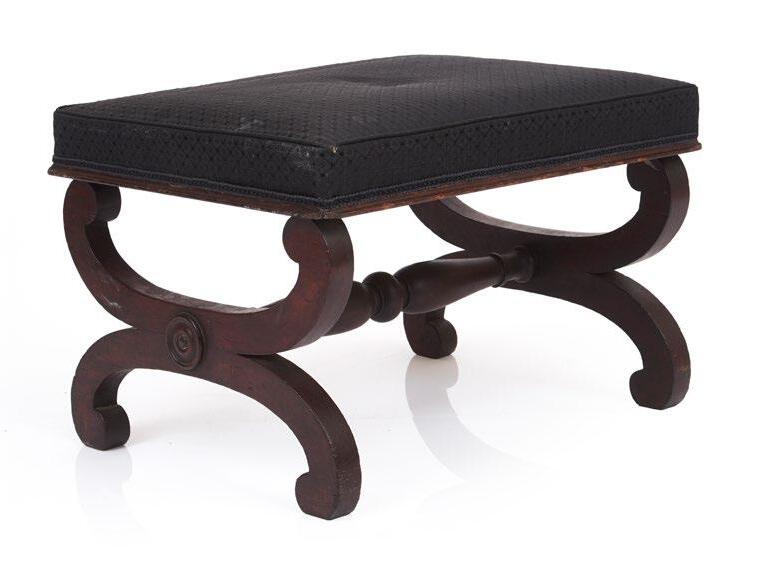
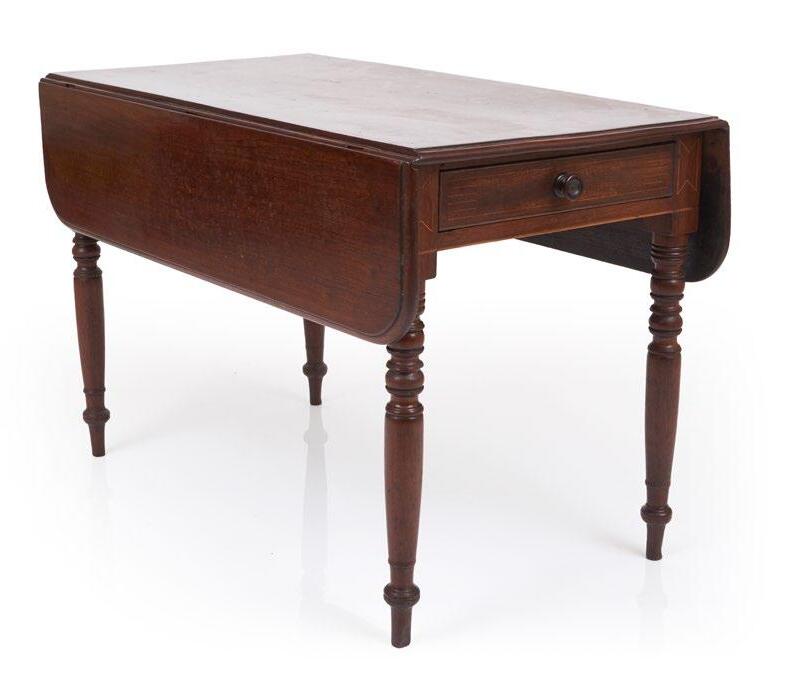
148 149 150 116
A Colonial cedar turned leg and scrollarm library chair, in the style of Andrew Lenehan, Australian, circa 1845 upholstered in burgundy and black decorative horsehair 50cm wide, 90cm high $2,000–3,000
151
CIRCLE OF SIR PETER LELY (English, 18th century)
Portrait of Mary II (1662-1694) of England when Princess c.1672 oil on canvas 124 x 96cm
This is a version of the famous work in the Royal Collection London with the Princess depicted as Diana the huntress, with bow and arrow. $6,000–8,000

150
151 117
152
A rare full cedar priest's arched-door robing cabinet, Australian, circa 1840 the doors enclosing 8 small and 2 large slide out drawers
143cm wide, 60cm deep, 132cm high $1,500–2,500
153
An unusual cedar rectangular turned leg servery, Australian, circa 1850 on bun feet

148cm wide, 53cm deep, 83cm high $800–1,200
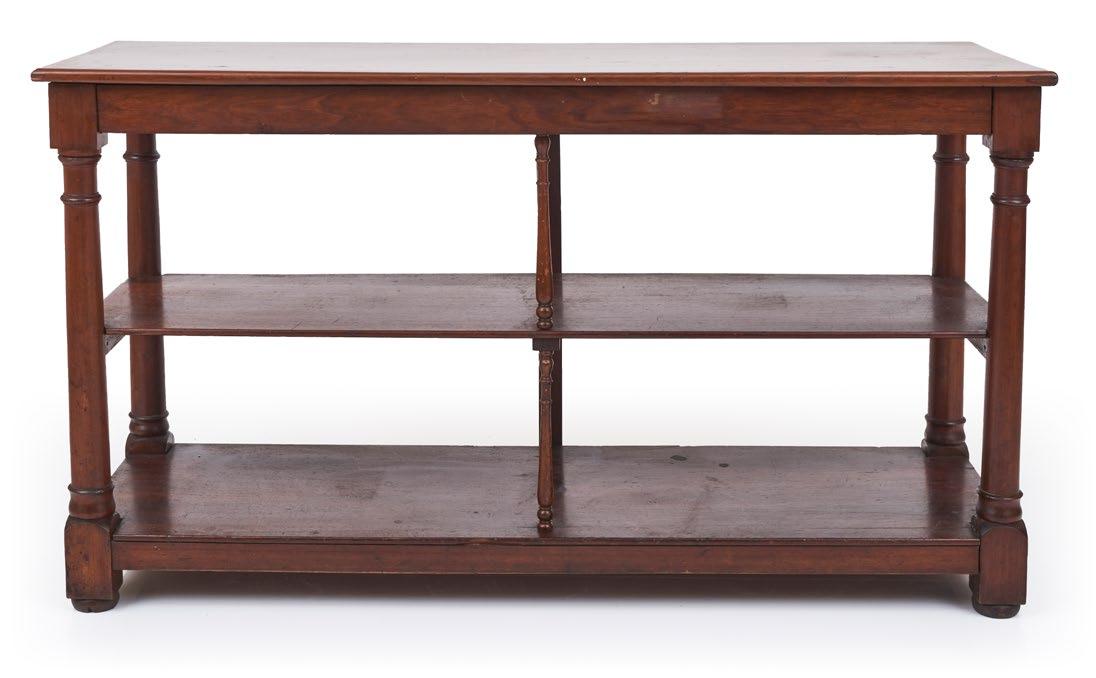
152 153 118
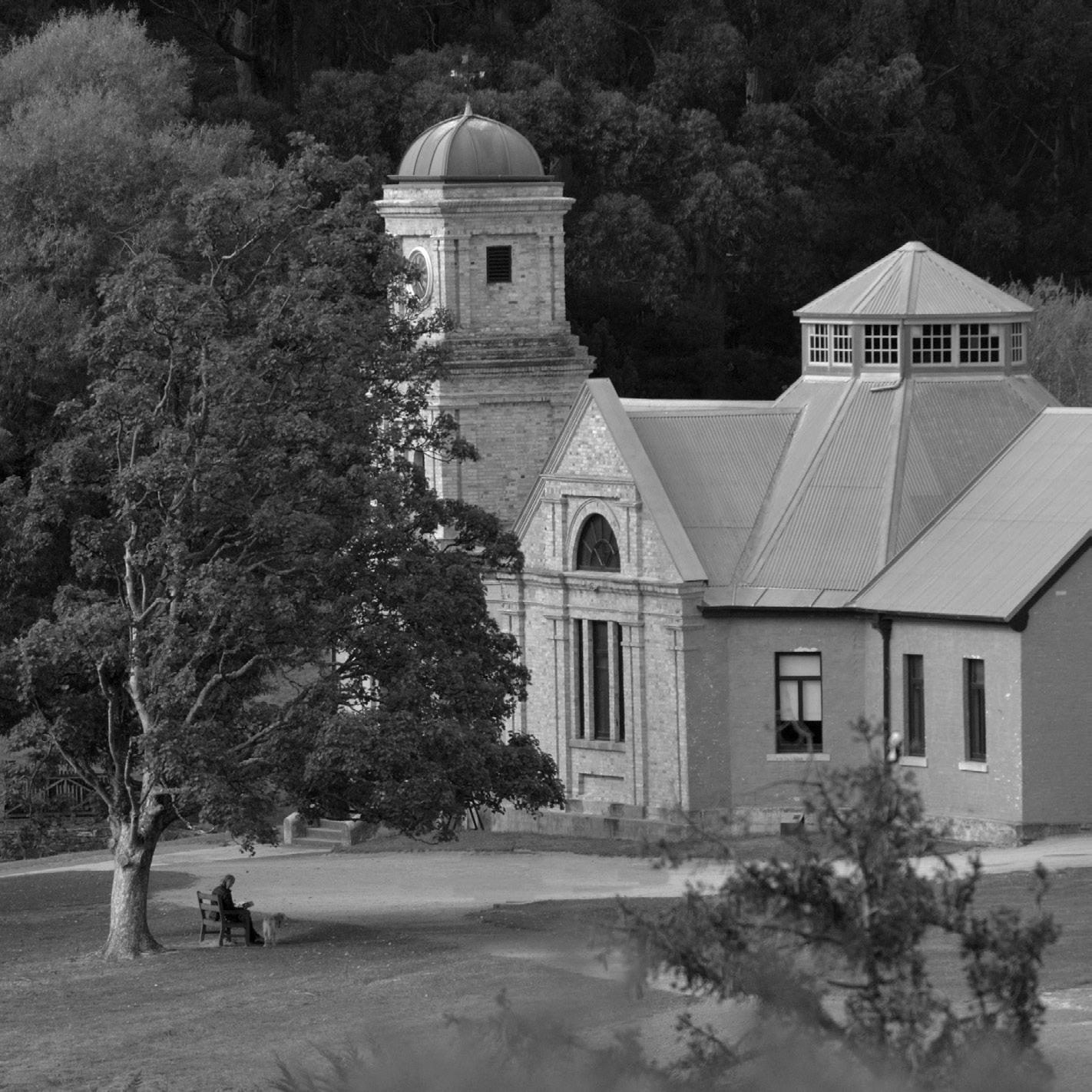
119
A good carved cedar twin-pedestal raised back sideboard, Australian, circa 1840 184cm wide, 73cm deep, 137cm high
PROVENANCE
Swan, Murray and Hain – Tocal – April 2001 $2,000–4,000
155
A very impressive Australian cedar and rose-mahogany four poster bed, Australian, circa 1835 with rope twist turned posts. all round, double acanthus leaf carving, carved feet and feather carved bolt covers, with “Thomas Hope”, scroll 224cm high, 145cm wide, 215cm long, to fit mattress 150 x 180cm
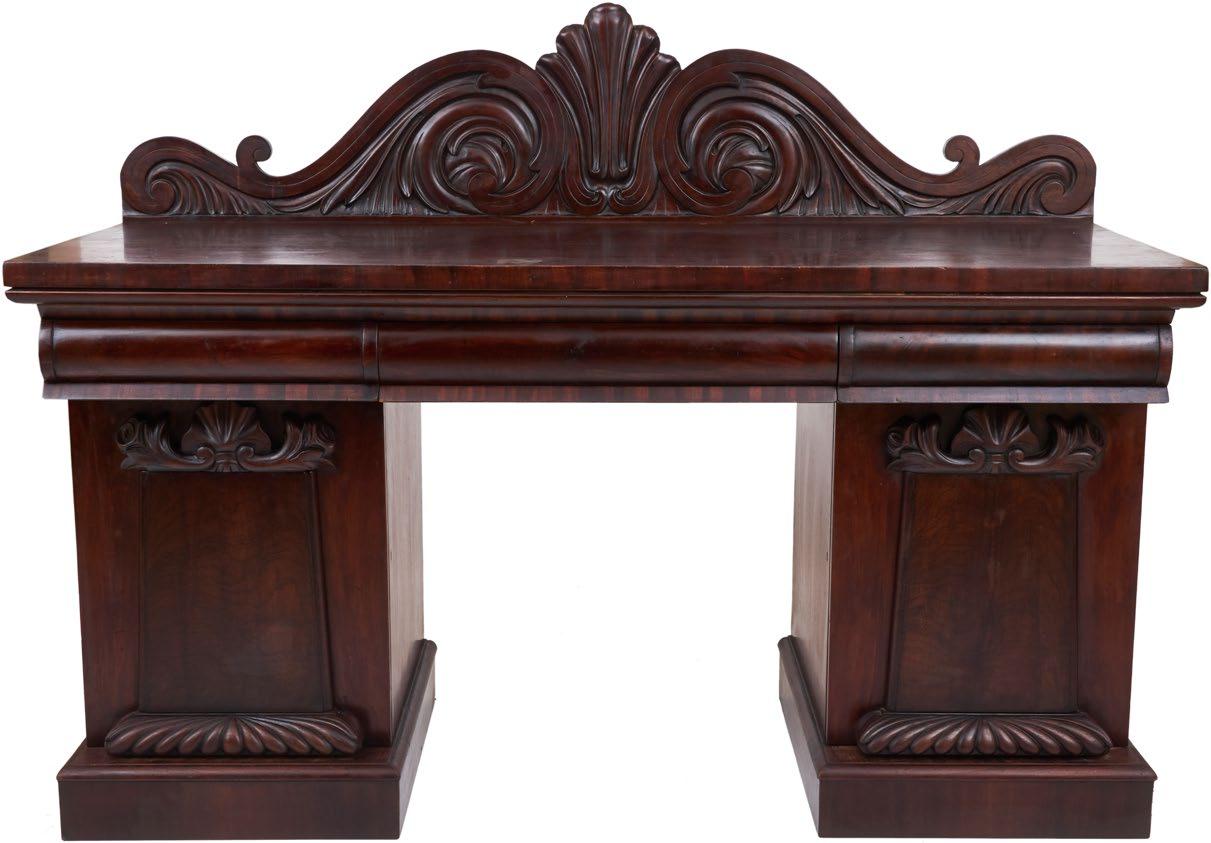
PROVENANCE
Swan, Murray and Hain, Hunter Valley, Tocal, March 1990, lot 367 (AUD$19,000 hammer) The Private Collection of Mr Tom Collins, NSW. $4,000–6,000
154
154 120

155 121
156
A pair of Victorian cut ruby glass lustres, Bohemian, 19th centruy with clear glass pendants and glass domes with ebonised circular bases
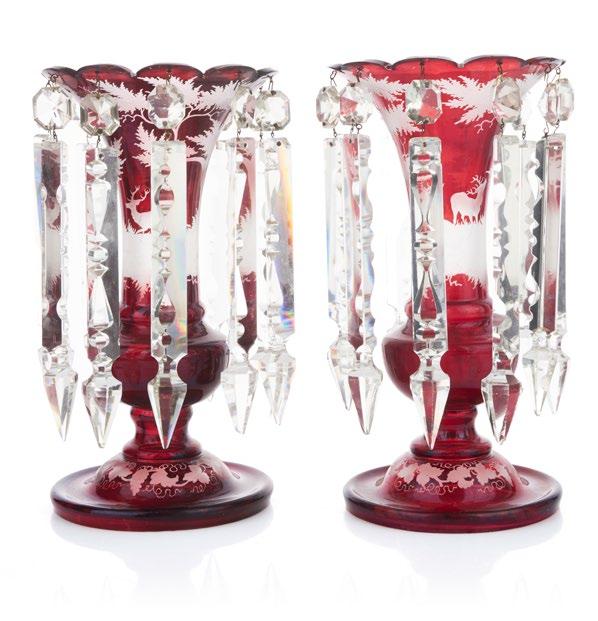
43cm high

$700–1,000
157
A very rare and fine quality set of twelve cedar dining chairs, Australian, circa 1845 consisting of ten side chairs and two carver chairs all with drop in horsehair fabric seats 51cm wide, 46cm deep, 90cm high
$8,000–12,000

156 157 122
A magnificent and finely carved and turned cedar banquet table, Australian, circa 1860
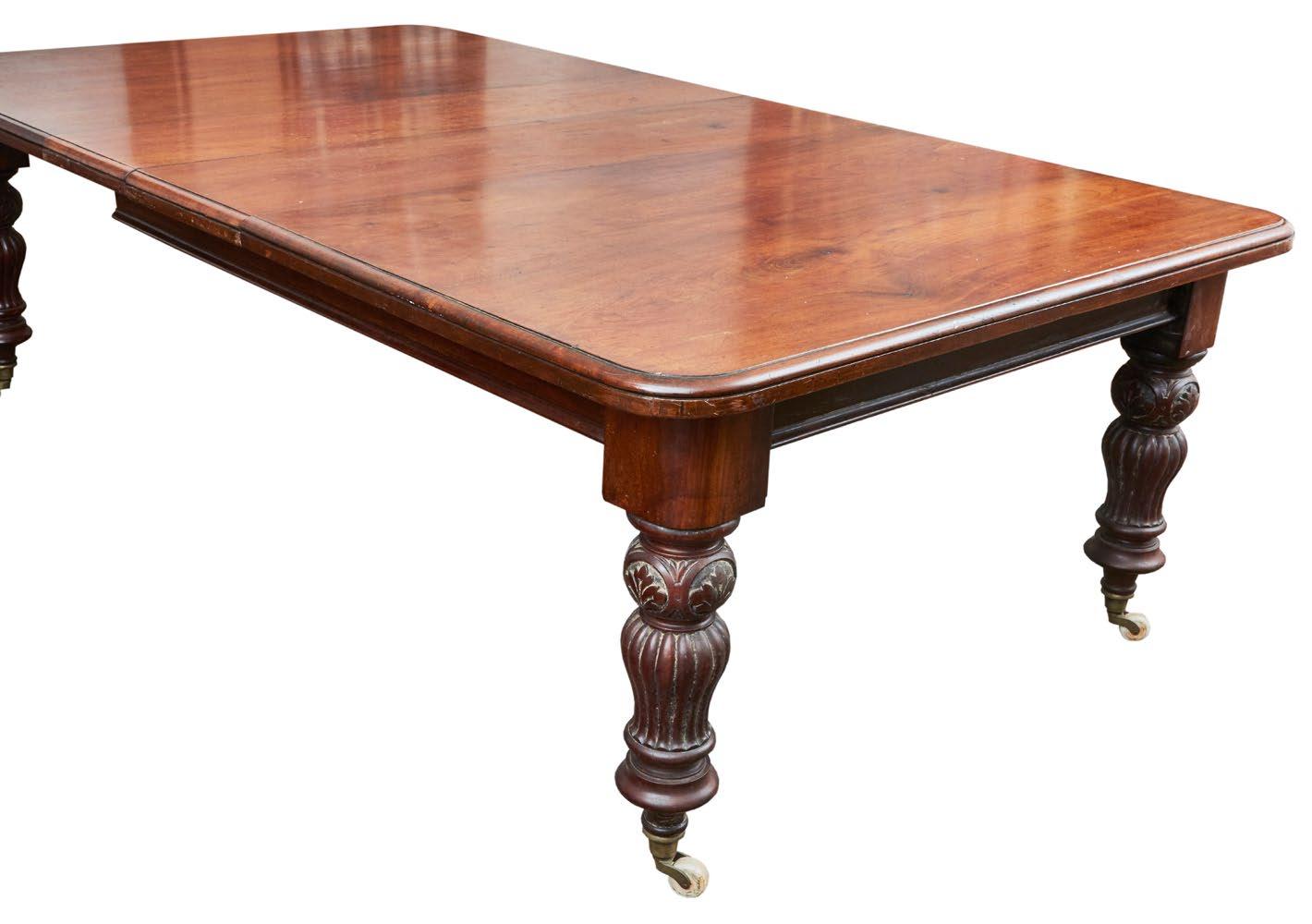
Telescopic crank handle mechanism with four extension leaves, together with a free-standing original leaf holder
135cm wide, 72cm high, approx. 300cm long fully extended $6,000–9,000
158
158 123
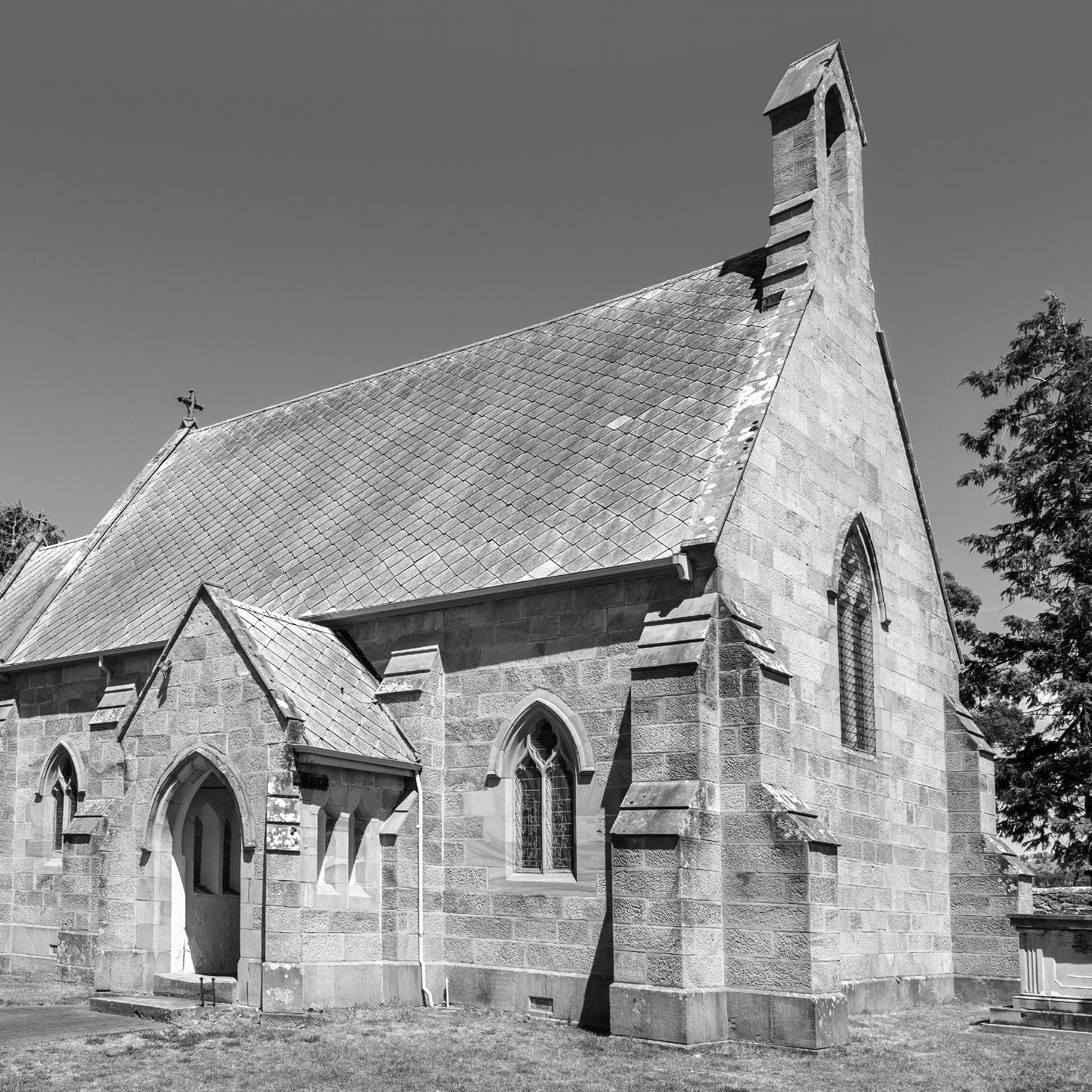
124
An impressive cedar Grecian inspired wardrobe, Australian, circa 1845 124cm wide, 47cm deep, 209cm high $7,000–10,000

159
159 125

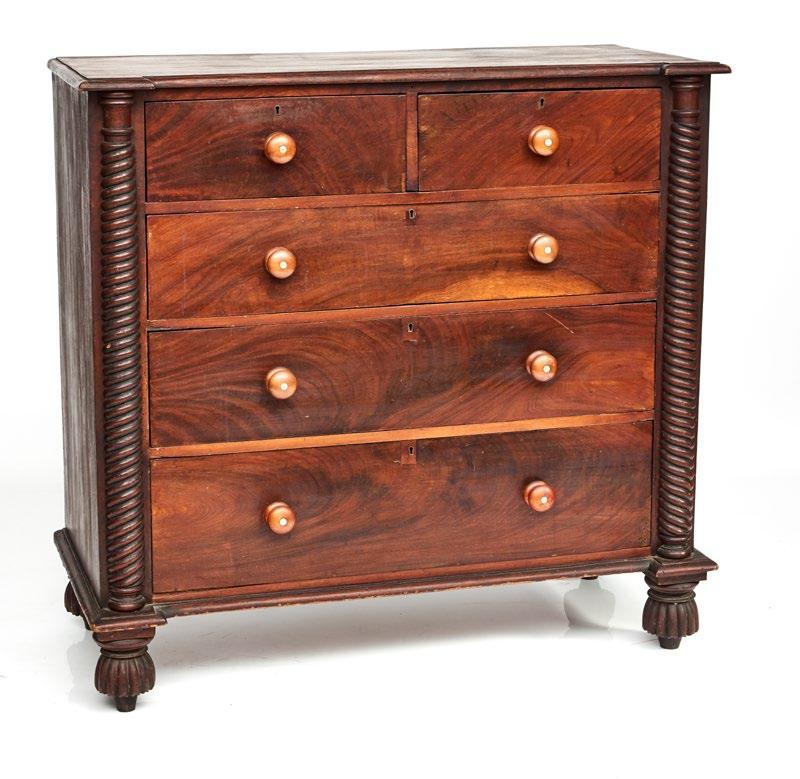

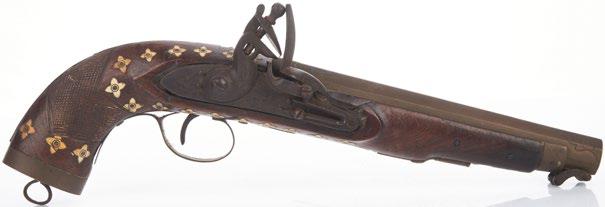
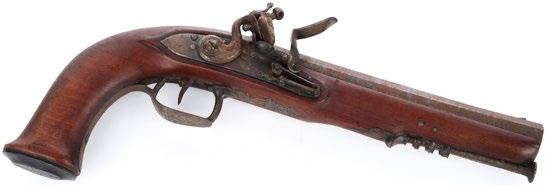
161 160 162 163 164 126
160
An antique flintlock pistol
barrel length 20cm, barrel inner diameter 1.7cm, overall length 35cm
$400–600
161
An antique bone inlaid flintlock pistol
barrel length 21cm, overall length 37cm, barrel inner diameter 1.7cm
$600–900
162
An antique flintlock percussion pistol impressed Tower and Crown barrell length 20.5cm
$300–500
163
A rare cedar lyre pattern armchair, Australian, circa 1850
97cm high, 63cm wide, 82cm deep
$2,500–4,000
164
A good cedar chest of drawers, Australian, circa 1855
shell inlaid turned handles
124cm wide, 54cm deep, 115cm high $1,500–2,500
165
A rare Tasmanian black-wood two-part campaign dining table, Australian, circa 1835
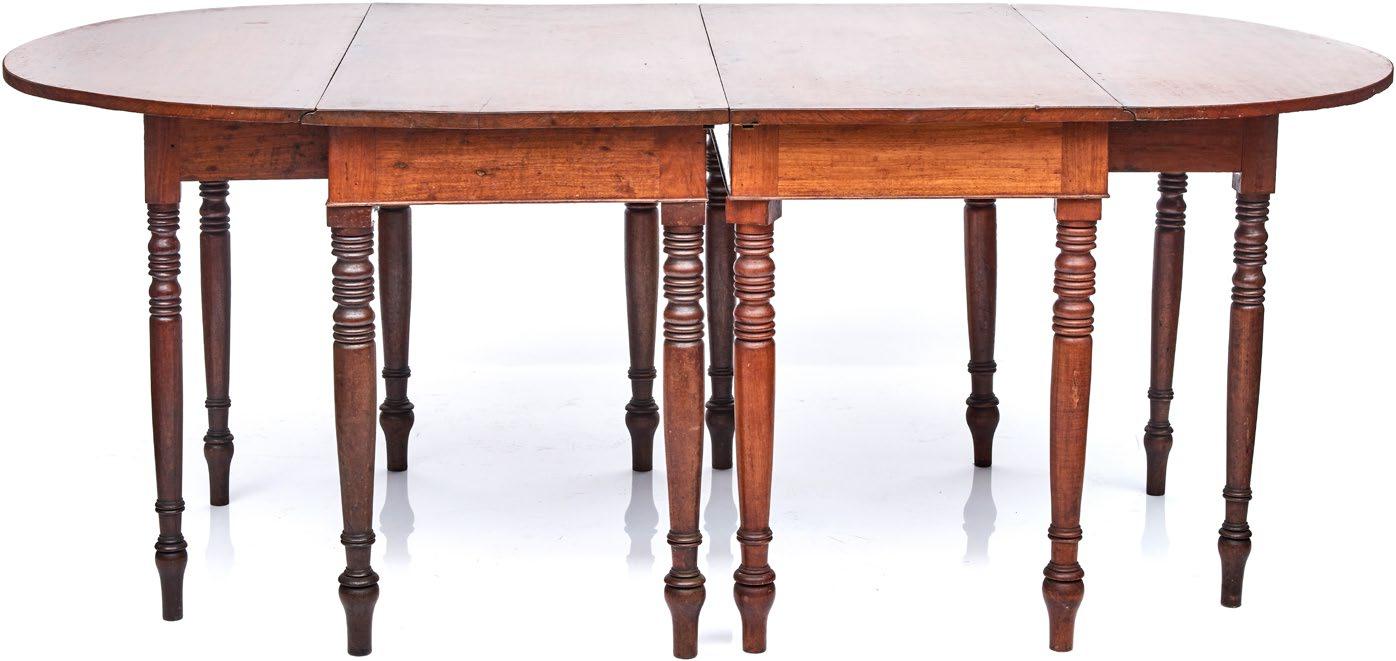
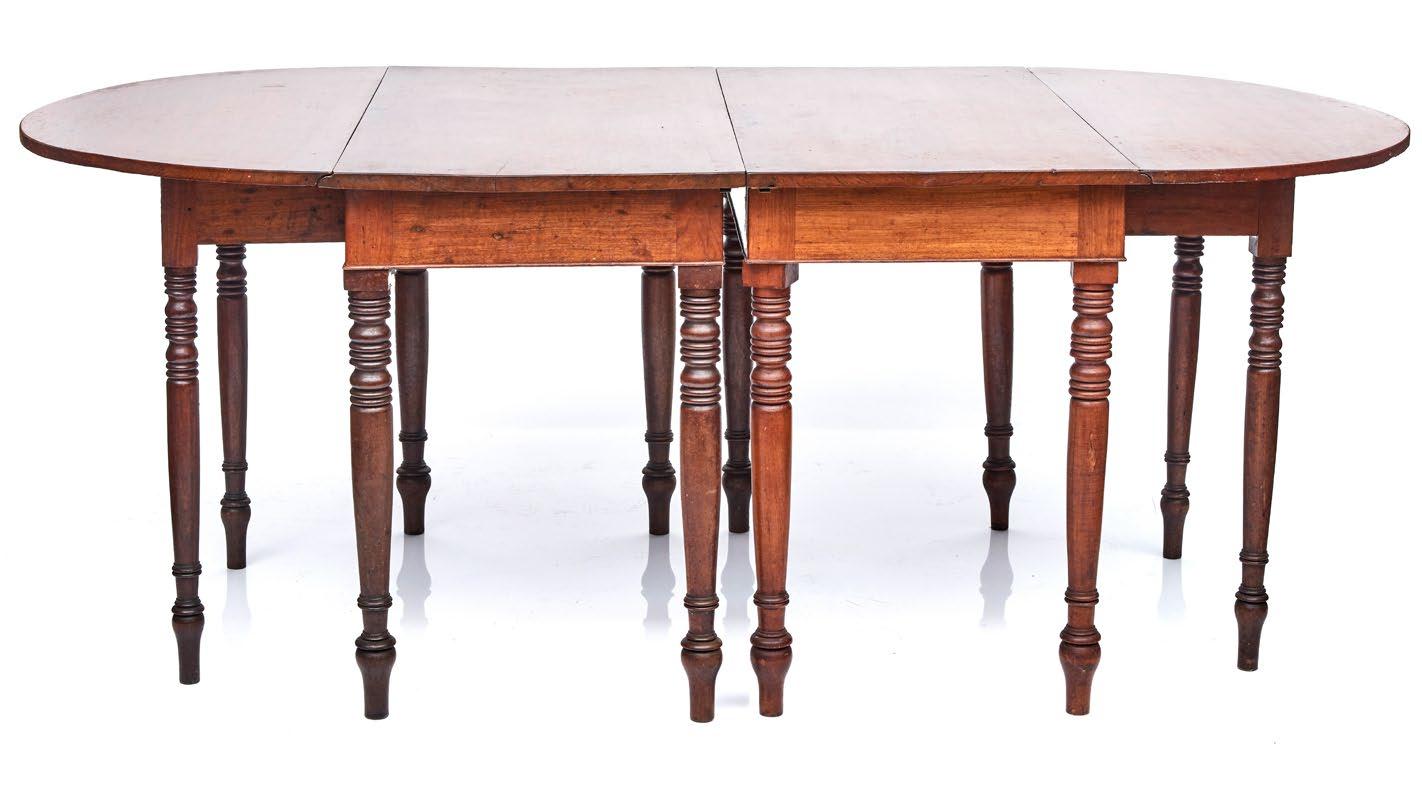
with legs which unscrew
106cm long, 109 cm wide, closed 77cm high $3,000–5,000
165 127
166
AFTER CONRAD MARTENS (Australian School, 19th century or later)
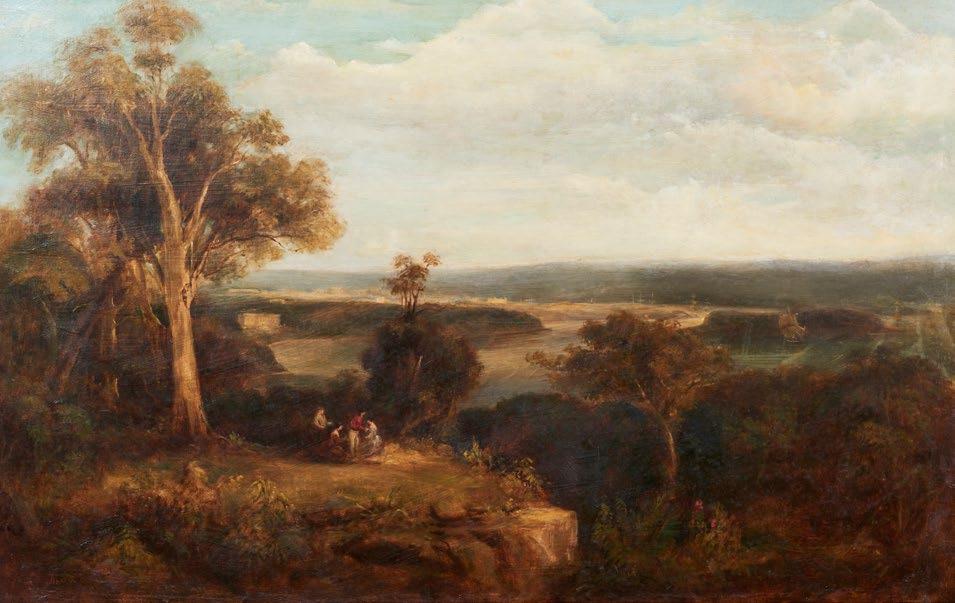
Sydney harbour from Darling Point oil on canvas
bears signature C Martens lower left and the date 1847 60 x 90cm
PROVENANCE
De-Accessioned from the Queensland Art Gallery
Deutscher-Menzies, Major Fine Art Auction, Brisbane, including works de-accessioned from the collection of the Queensland Art Gallery, 22 February 2006, lot 65
$5,000–8,000
167
JANET AGNES CUMBRAE-STEWART (Australian, 1883-1960)

Nude seated on a chair pastel
signed lower right 44 x 35cm
$4,000–6,000
166 167 128
An impressive cedar Gentleman's press-on-chest, Australian, circa 1845

138cm wide, 67cm deep, 232cm high
PROVENANCE
The Reynolds Family, Rokeby House, Clarence Plains, Tasmania
Acquired by the present vendors at the auction of The Collection of Michael and Maria Hobden, Lawson-Menzies, October 2003, lot 436 ($8,347)
$4,000–6,000
168
168 129
169
A substantial yoke-back cedar armchair, Australian, circa 1855
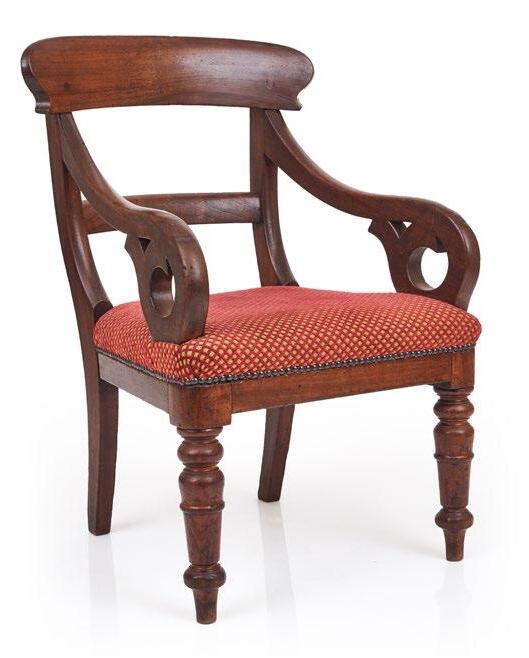
upholstered in red and gold chenille
58cm wide, 50cm deep, 91cm high $800–1,200
170
An Australian colonial cedar armchair, Australian, circa 1850 in the style of Andrew Lenehan
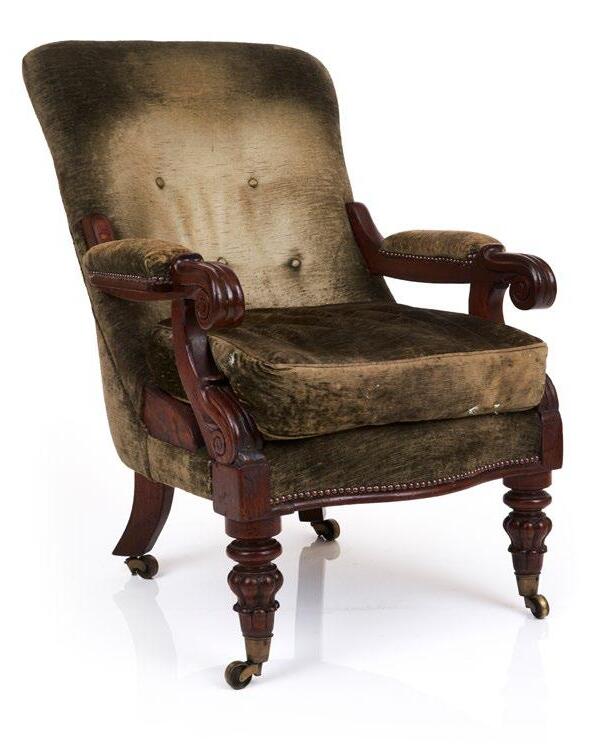
55cm wide, 60cm deep, 89cm high $800–1,200
171
A good quality cedar carved and upholstered armchair, Australian, circa 1845 63cm wide, 74cm deep, 100cm high
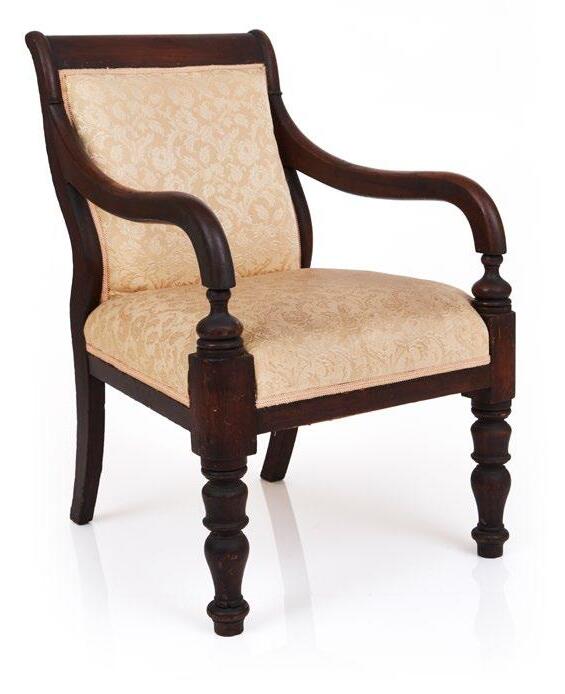
PROVENANCE
Bonhams, Sydney, November, 2012, lot 410 ($3,050)
$1,500–2,500
171 170 169 130
A rare and early Casuarina Inlaid circular cedar tilt-top centre table, Australian, circa 1830
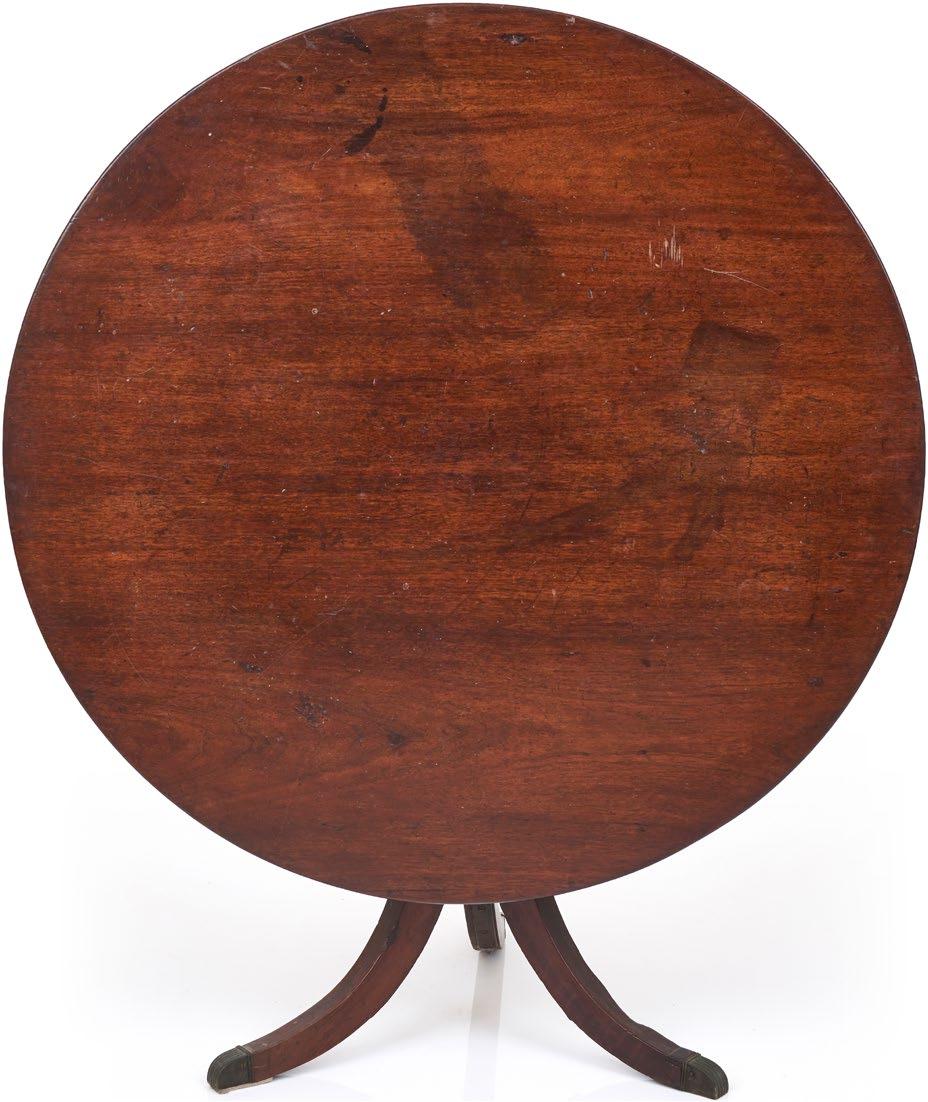

120cm diameter, 72cm high
PROVENANCE
Acquired from the auction of the Carissa Crouch and Carl Consalves
February 2015, lot 234 ($4,800)
$2,500–4,000
172
172 131



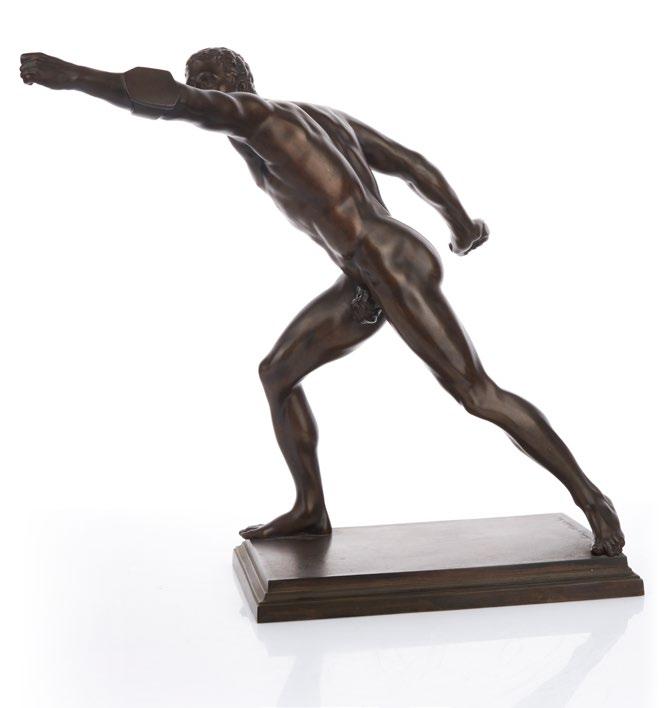
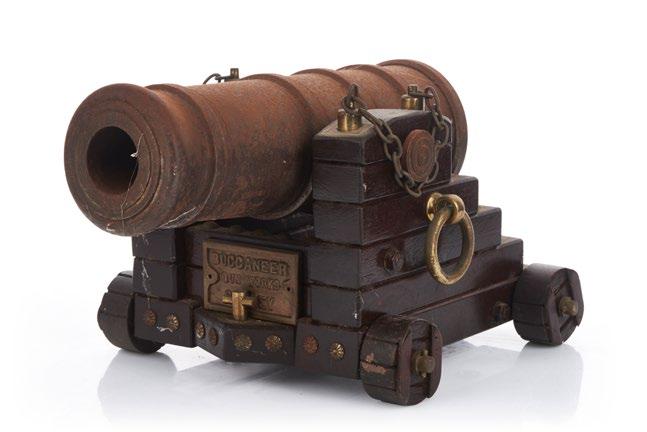
173 174 176 176 175 132
A foliate cast antique bronze cannon
Lantaka, 19th century
118cm long
$500–1,000
174
An antique foliate cast bronze cannon, Lantaka, 19th century
94cm long $500–1,000
175
A cast-iron starters cannon, with brass plate Buccaneer gun-works, Sydney, with brass inlaid and mounted stand marked to base SS Iron Yampi February 1974. cannon 33cm long, mounted height 18cm $300–500
176
A bronze figure of a naked male athelete, French/Italian, circa 1920 signed 48cm high, approx. 51cm wide $500–800
177
A rare and early cedar turned-leg dining table, Australian, circa 1830 with one original extra leaf and brass clips 123cm wide, 74cm high, 190cm long extended $4,000–6,000 177

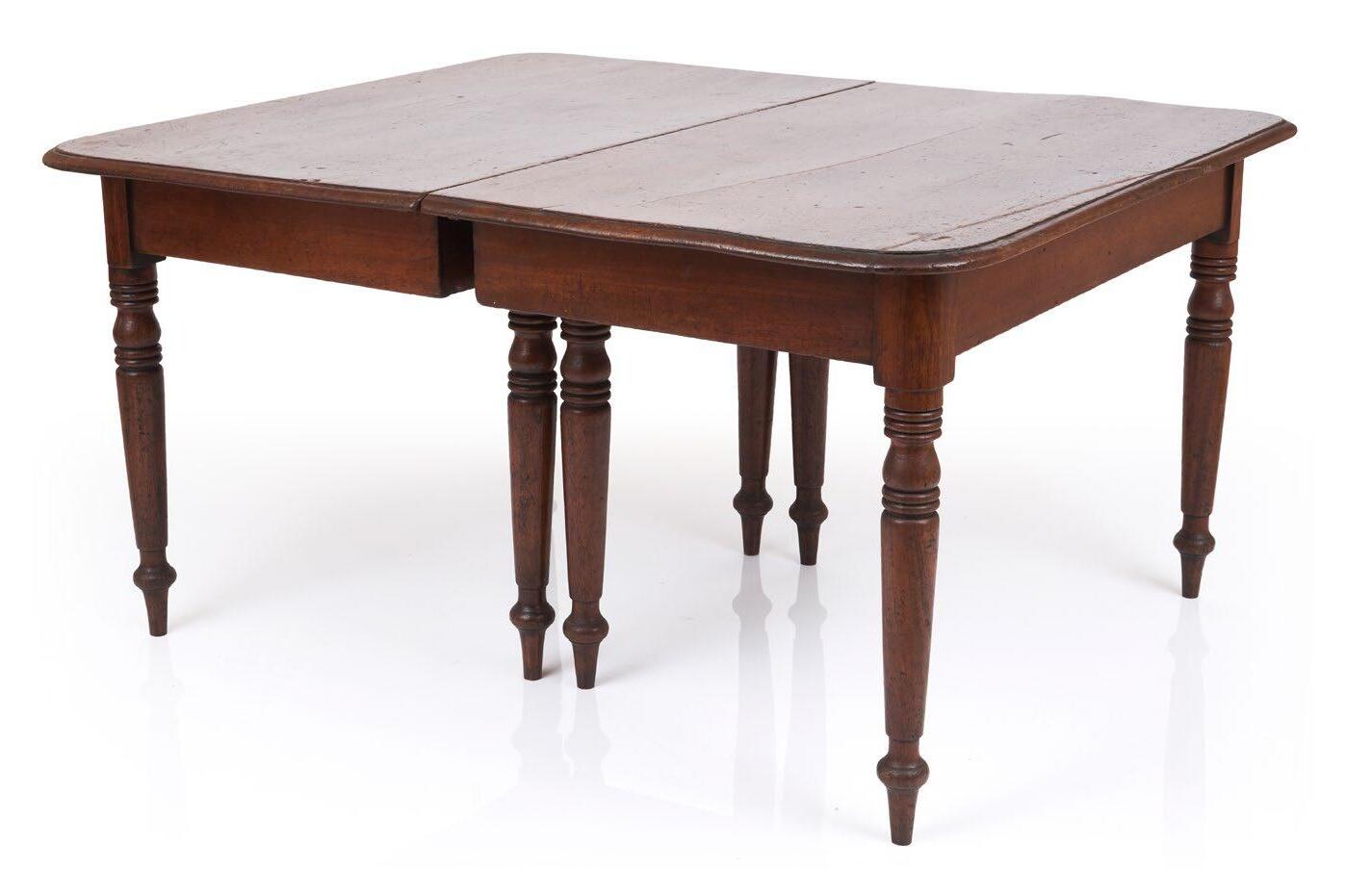
173
133

134

135
178 FAQUAND (European, 19th century)
Portrait sitting and Boys playing indoors pair of oils on board signed lower right each 24 x 21cm $800–1,200

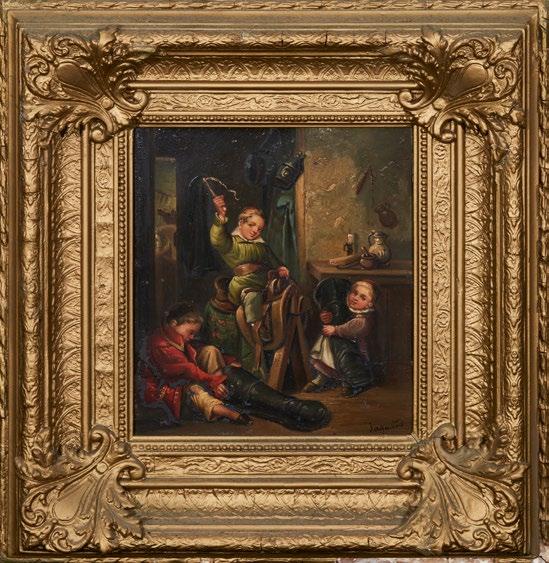
179
ARTIST UNKNOWN (Italian School, 19th century)
Portrait of a young raven-haired lady oil on canvas 45 x 36cm $1,500–2,500
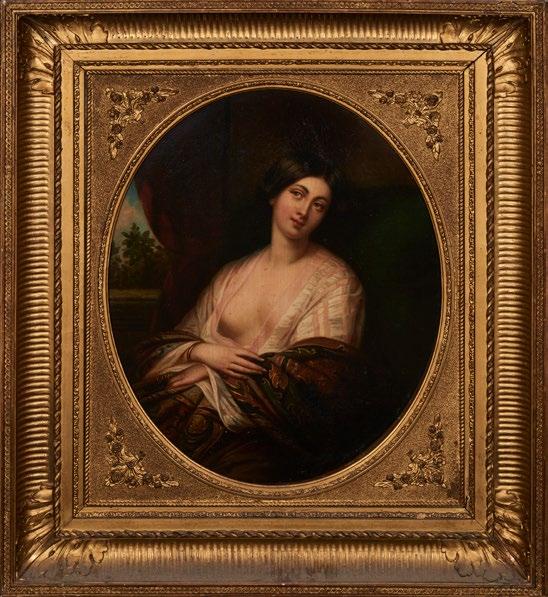
178 178 179 136
180
reclining nude oil on canvas signed lower right sold with Certificate of Authenticity from The Bloomfield Galleries signed by Lin Bloomfield 42.5 x 58cm $4,000–6,000
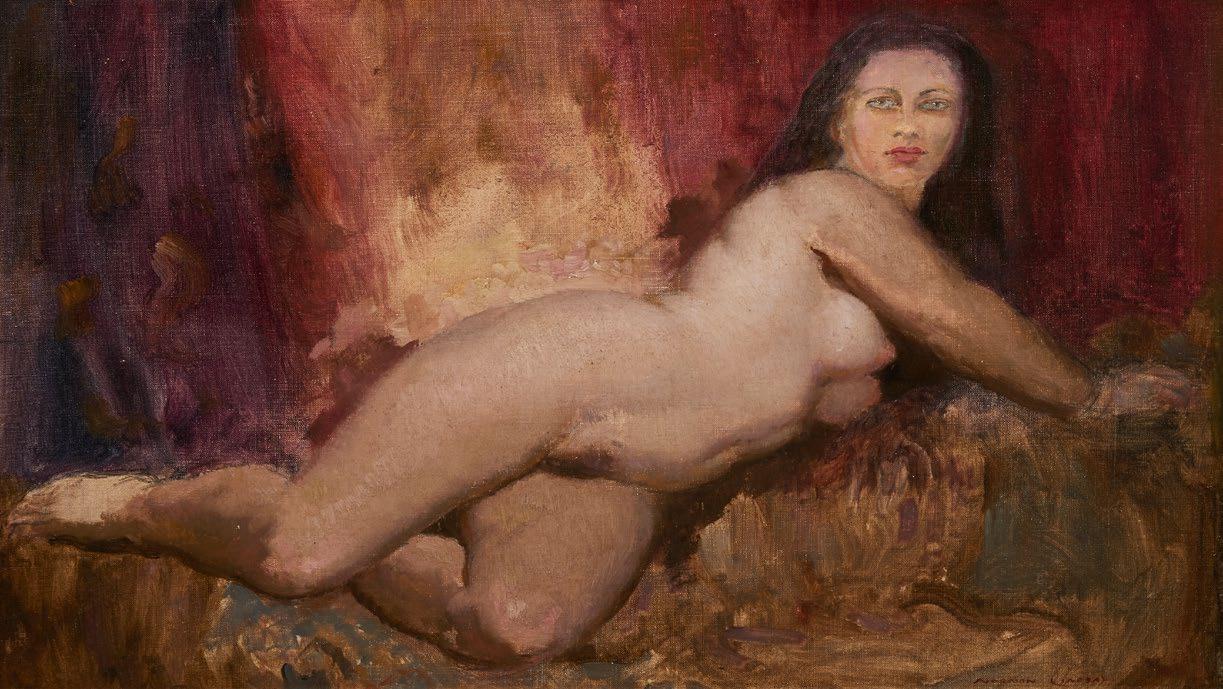 NORMAN LINDSAY (Australian, 1879-1969)
NORMAN LINDSAY (Australian, 1879-1969)
180 137
181
A significant set of six foliate carved cedar dining chairs, Australian, circa 1840 comprising of 1 carver and 5 side chairs carver 50cm wide, 48cm deep, 91cm high These chairs are part of a much larger and important set of chairs numbering 24 as evidenced by the chair numbers stamped into chair rails. There would be very few sets of cedar chairs made on this scale for a colonial property and it would be great, albeit unlikely, to find out who they were commissioned for. $5,000–7,000
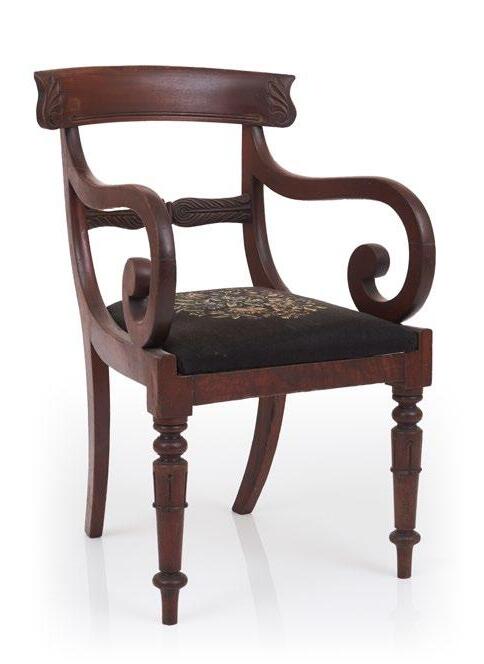
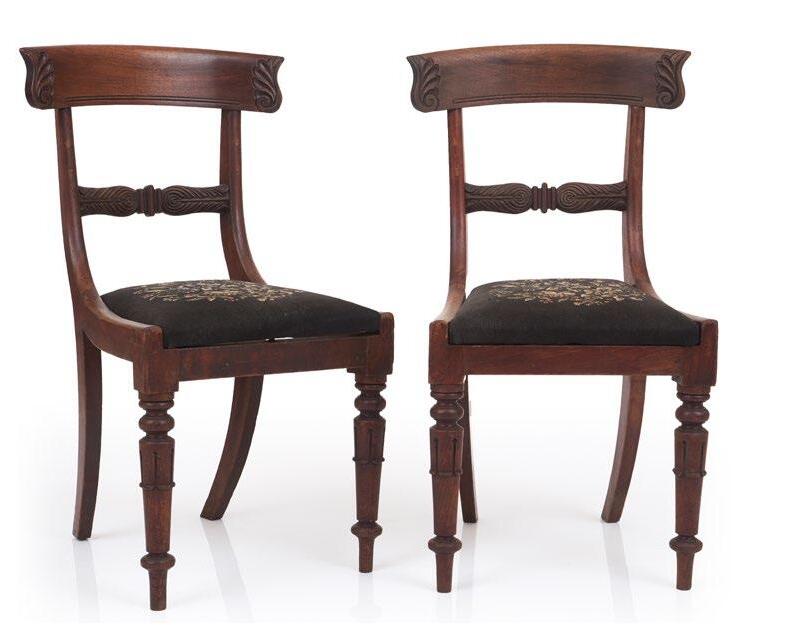
182
A small early colonial three-drawer chest, Australian, circa 1845 strung in pine 80cm wide, 94cm high, 45cm deep $800–1,200
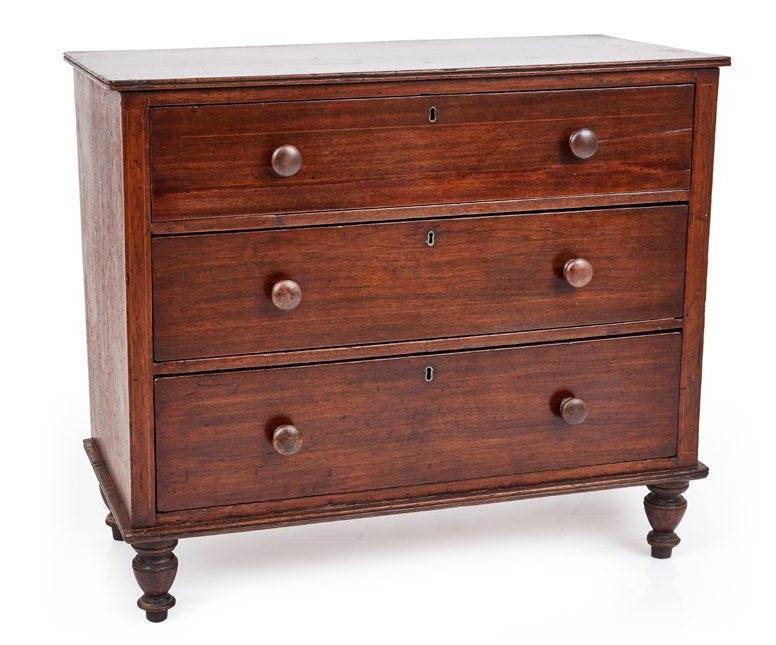
181 182 138
A large four door cedar New South Wales Government railway cupboard, Australian, circa 1880 stamped VR June 1881 – two, two door sections with five original cedar shelves with well constructed cedar panel back 195cm wide, 58cm deep, 224cm high $2,000–3,000
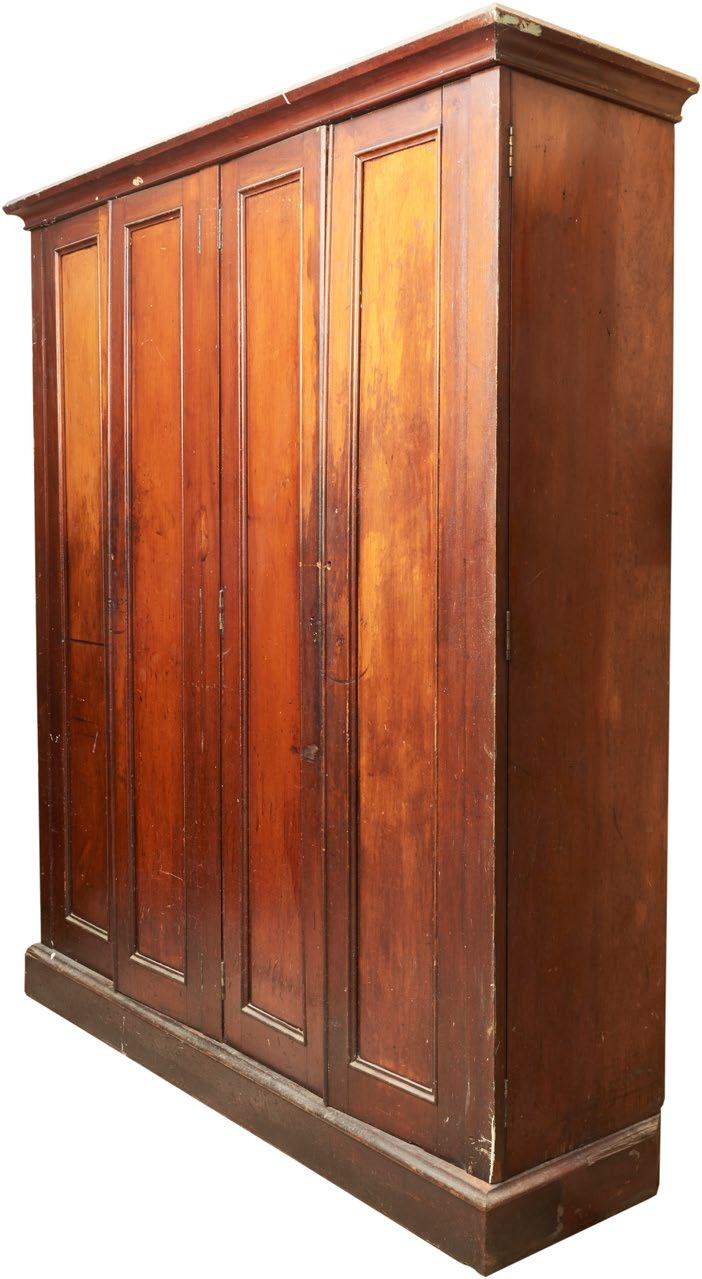
183
183 139
184
A Colonial cedar turned support wall-shelf, Australian, circa 1860
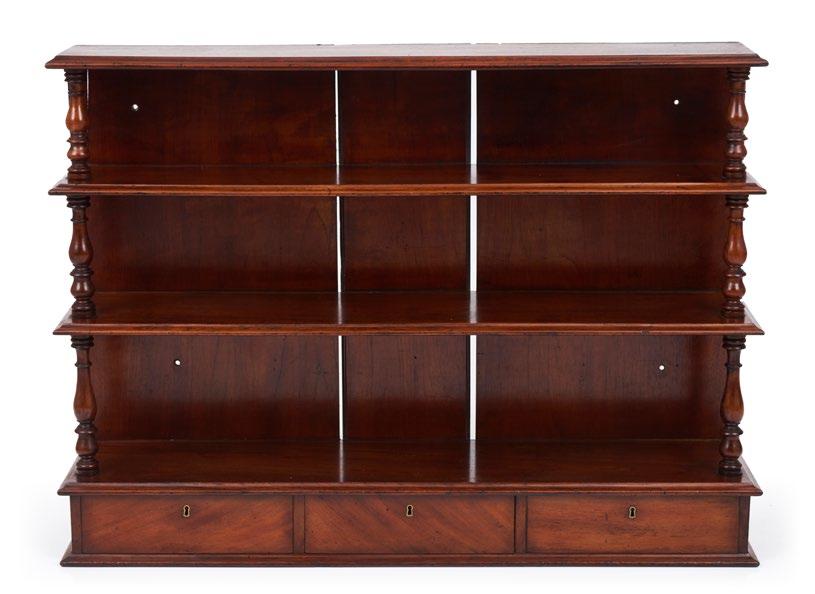
113cm wide, 26cm deep, 81cm high
PROVENANCE
Gowans, Tasmania, June 2012
lot 377 ($1,850 hammer)
$1,000–1,500
185
A Cedar nine drawer knee-hole desk by Andrew Lenehan, Australian, circa 1860 Leather inset topped table with secret door at back of knee-hole with paper label to secret drawer
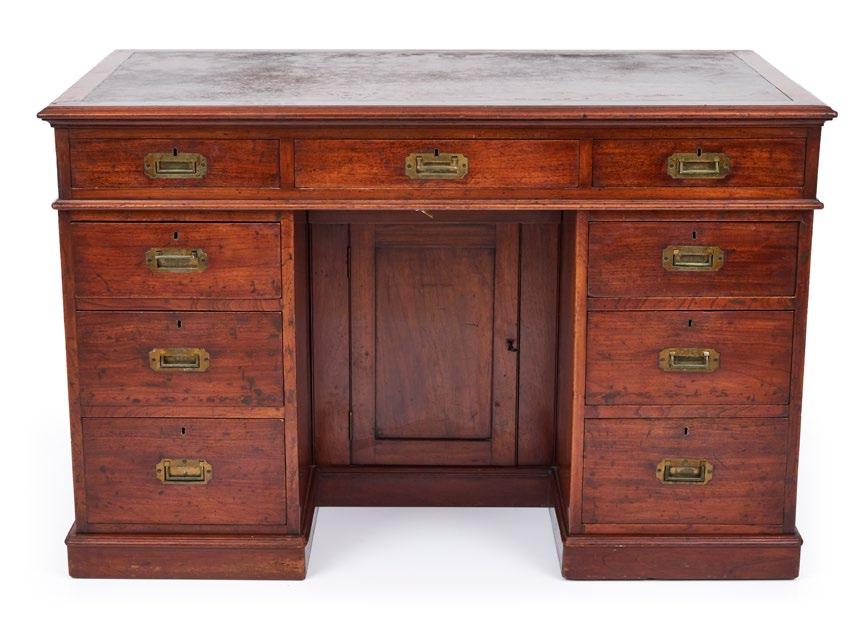
120cm wide, 62cm deep, 76cm high
PROVENANCE
Sotheby's, 2002, Lot 112 (Sold $9,500 hammer)
REFERENCE
The Australian Antique Buyers Companion, AH and AW Reed, Sydney. P.Cook, page 41, plate 33 $3,000–5,000
184 185 140
GLADSTONE EYRE (Australian 1862-1933)
Mountain Landscape near Sydney, NSW oil on canvas signed lower right

122 x 61cm
$3,000–5,000
186
186 141
187
A rare early cedar mule chest, Australian, circa 1840
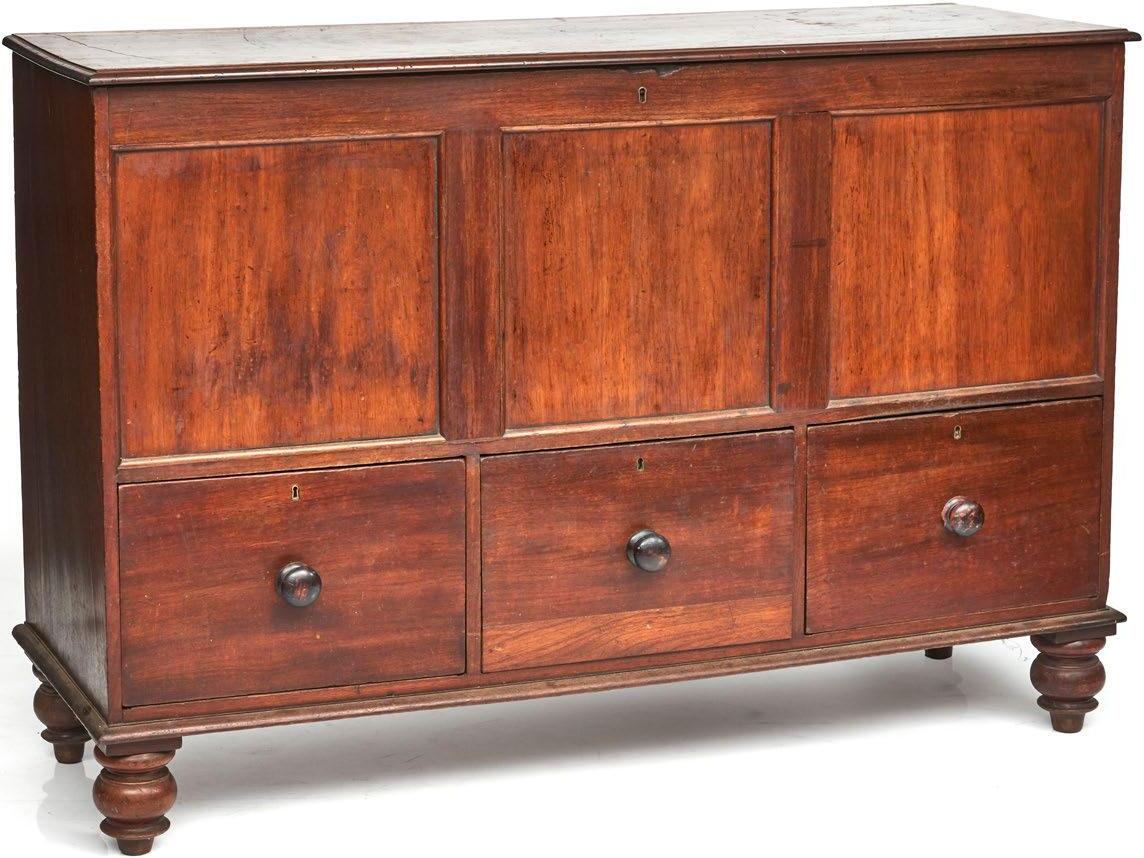
151cm wide, 52cm deep, 106cm high $1,500–2,500
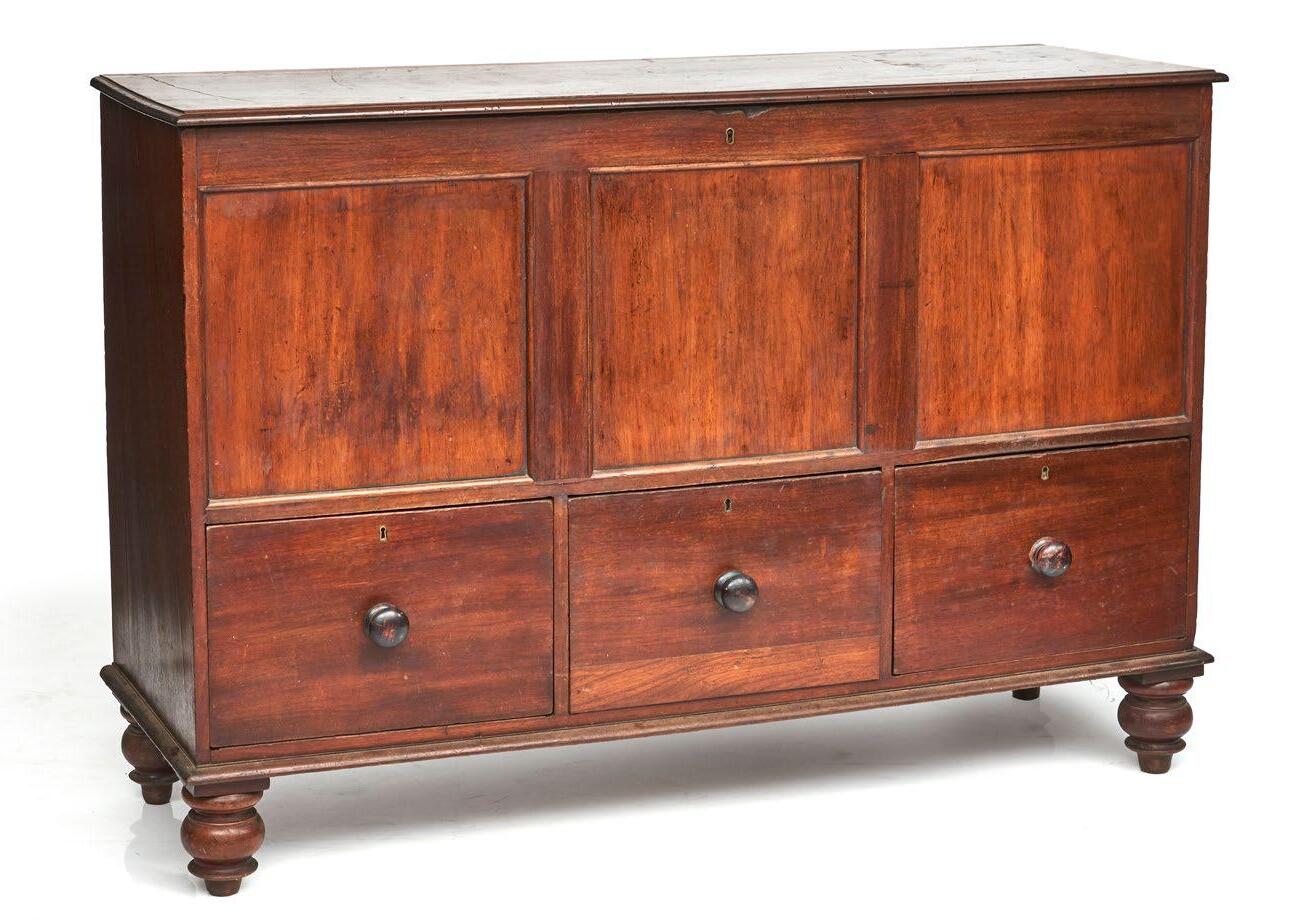
187 142
A rare and early Regency design brass inlaid colonial cedar press-on-chest, Australian, circa 1825
223cm high, 114cm wide, 48cm deep $3,000–5,000
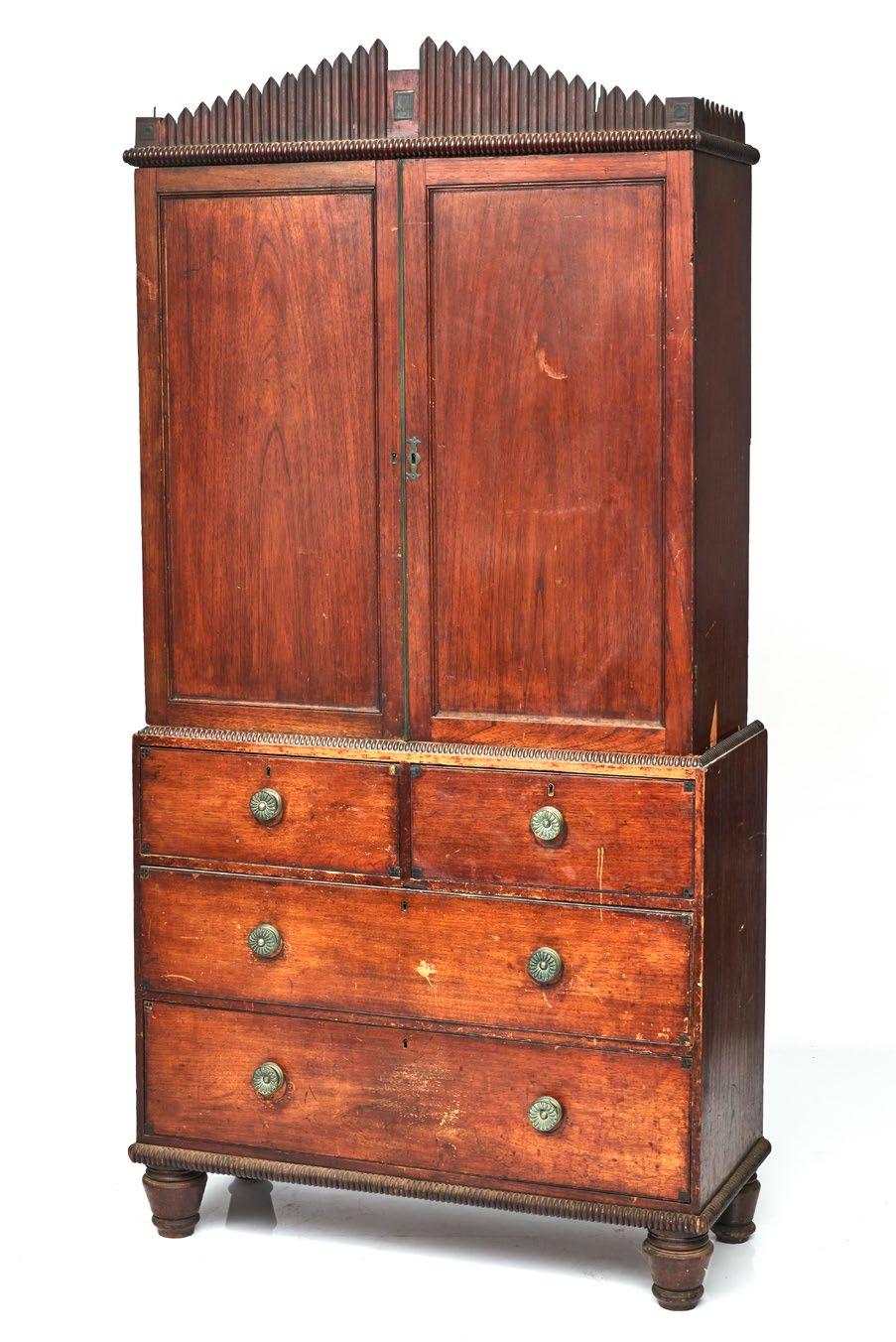
188
188 143
189
A silver-plated and gilt arched column desk clock and barometer by Howell James London-Paris, English, circa 1900 labelled given by Disreali to his private secretary Sir Charles Wilson etc see online photos
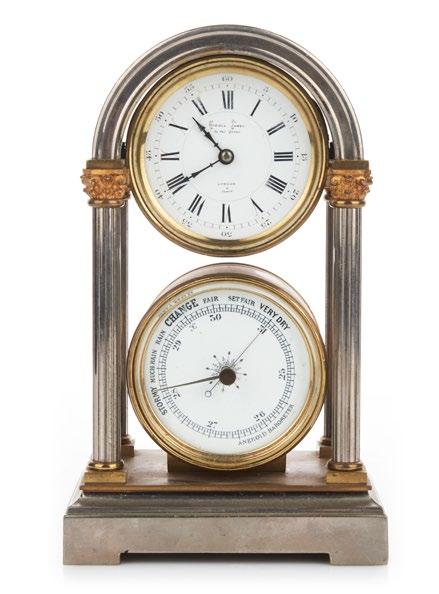
19cm high, 11.5cm wide
$400–600
190
A brass four-glass mercury regulator timepiece by Waterbury Clock Co USA, circa 1900

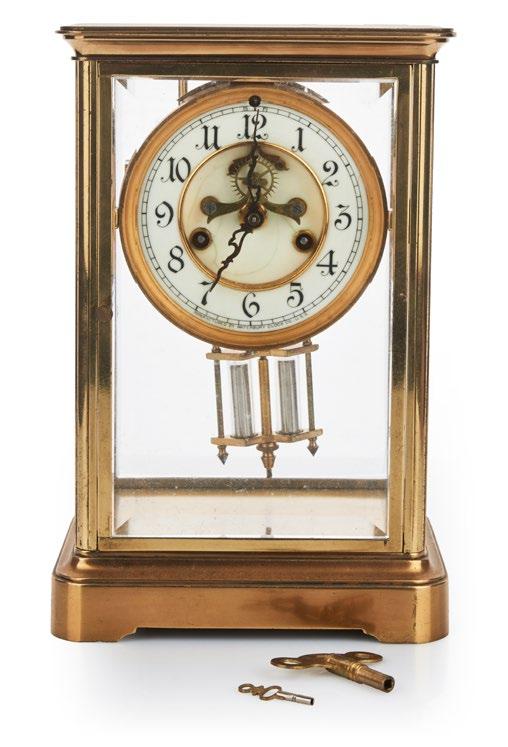
27cm high, 17cm wide, 13cm deep
$400–600
191 190 189 144
191
An unusual green onyx, bronze and glass magnifying cannon form timepiece, French, circa 1900
30cm high, 20cm wide
$800–1,000
192
A charming early cedar glass front two-section elevated cabinet, Australian, circa 1840 83cm wide, 51cm deep, 211cm high $4,000–6,000

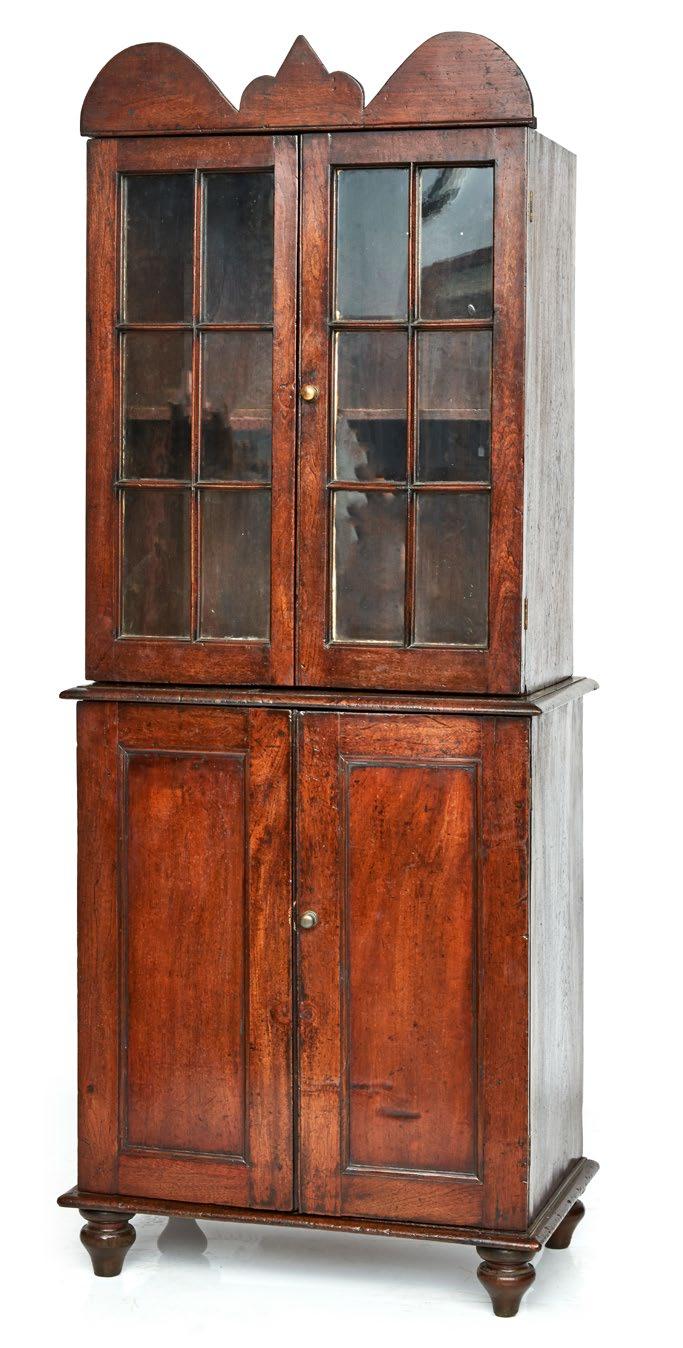
192 145
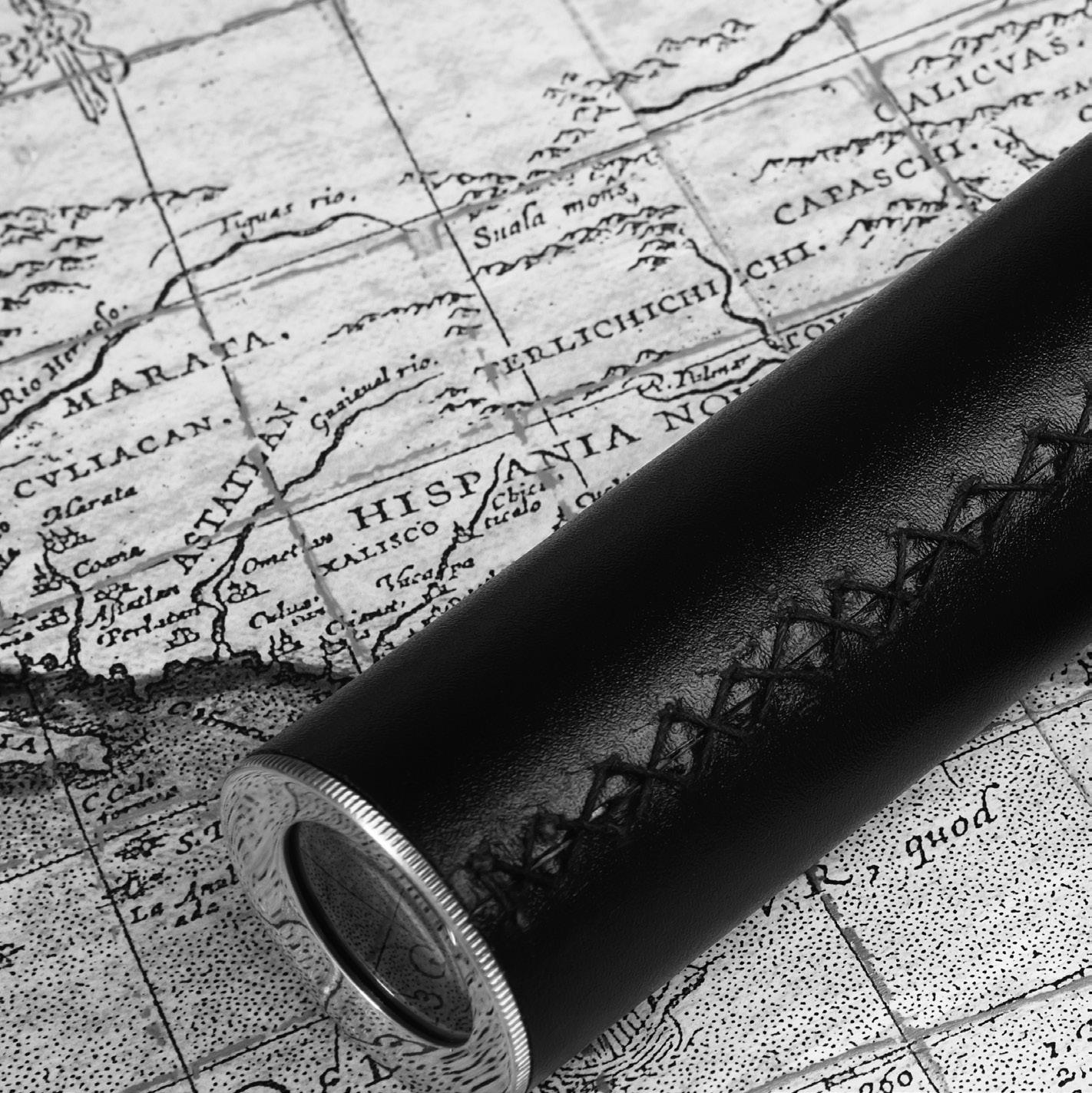
146
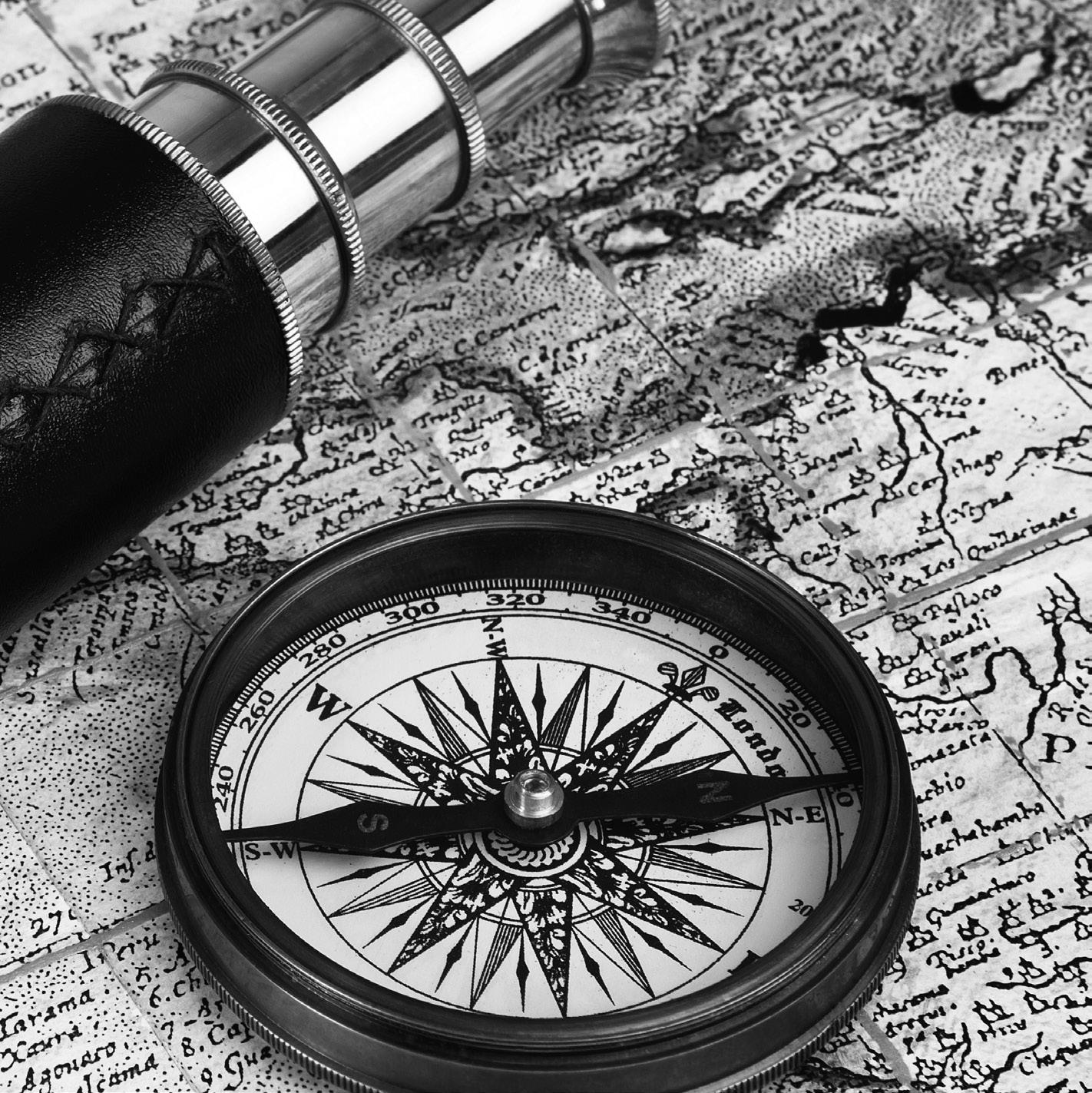
147
193
A pair of very unusual and good quality white-metal and etched glass Lyre-Bird pattern specimen vases, Australian, 19th century
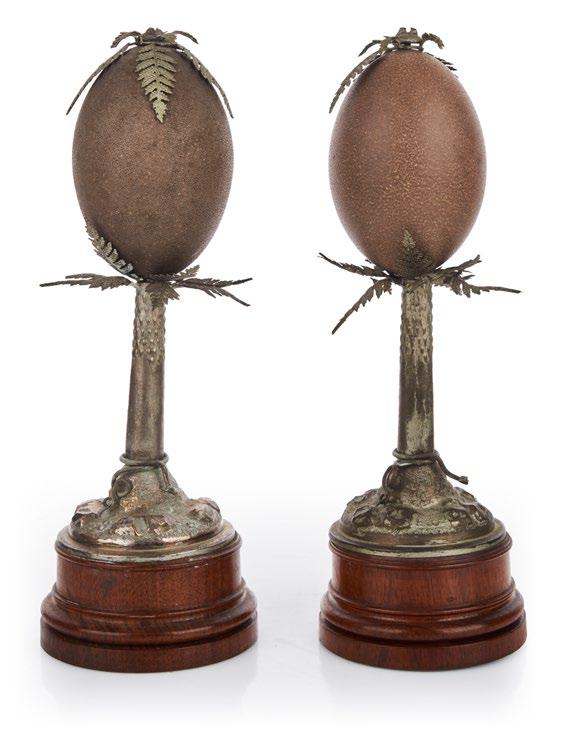
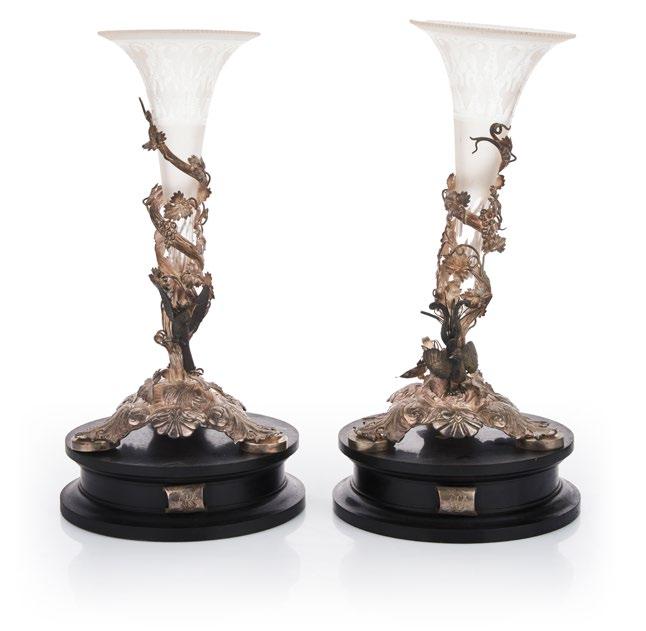
ebonised circular bases with silver plaque monogrammed BC
5.5cm high, 18cm diameter
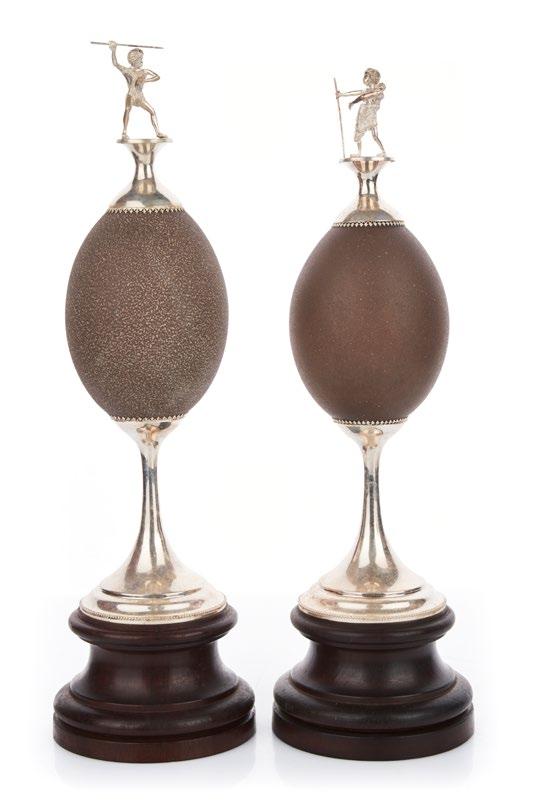
30cm high, 12cm diameter at the glass rims
PROVENANCE
Phillips Melbourne, 5 September 2004, Lot 295 sold then with provenance from Stokes Australasia Ltd
$2,500–3,500
195 194 193 148
194
A pair of silver-plated palm tree and emu-egg decorations, Australian, 19th century
34cm high
$400–600
195
A pair of silver-plated and emu-egg decorations, Australian, 19th century 41cm high
$500–800
196
An early cedar raised-back chiffonier, Australian, circa 1830
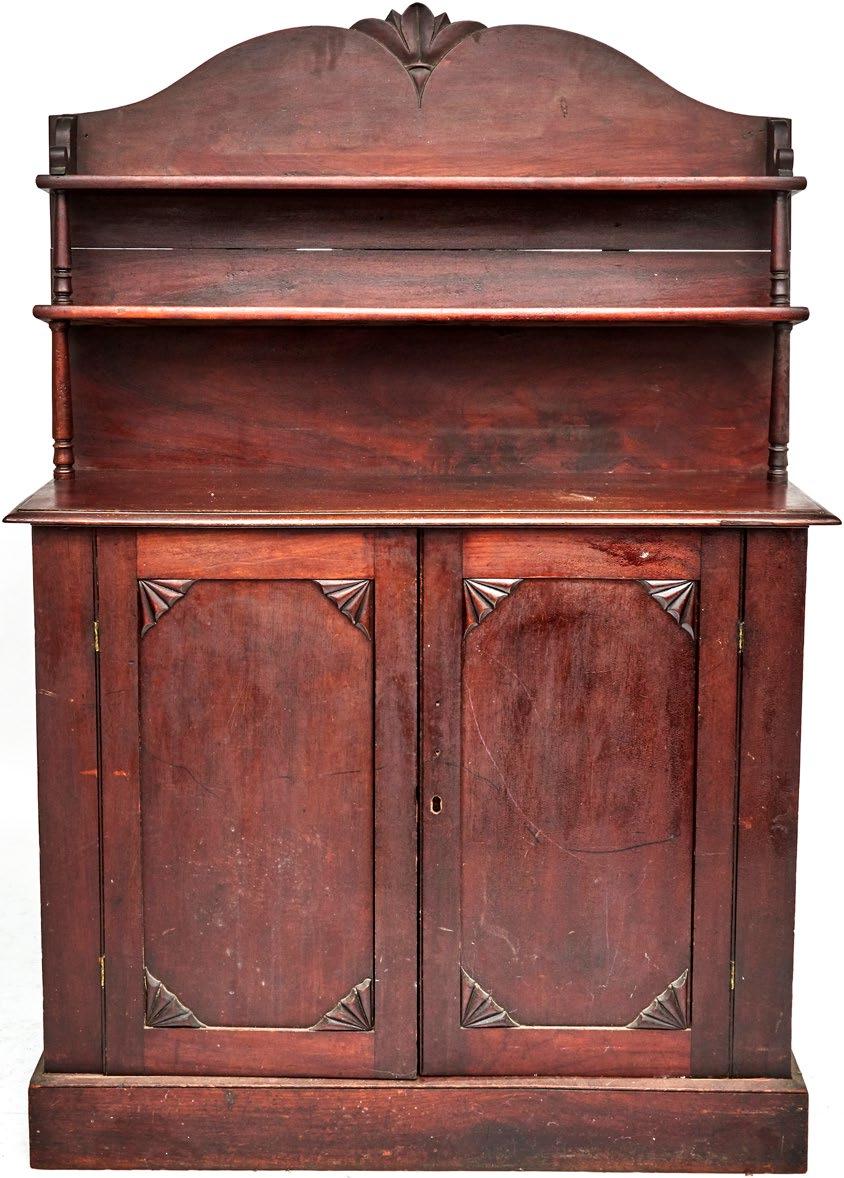
110cm wide, 40cm deep, 137cm high
$2,500–4,000
196 149
A rare casuarina/beefwood two-section elevated bookcase, Australian, circa 1850 103cm wide, 58cm deep, 203cm high $4,000–6,000
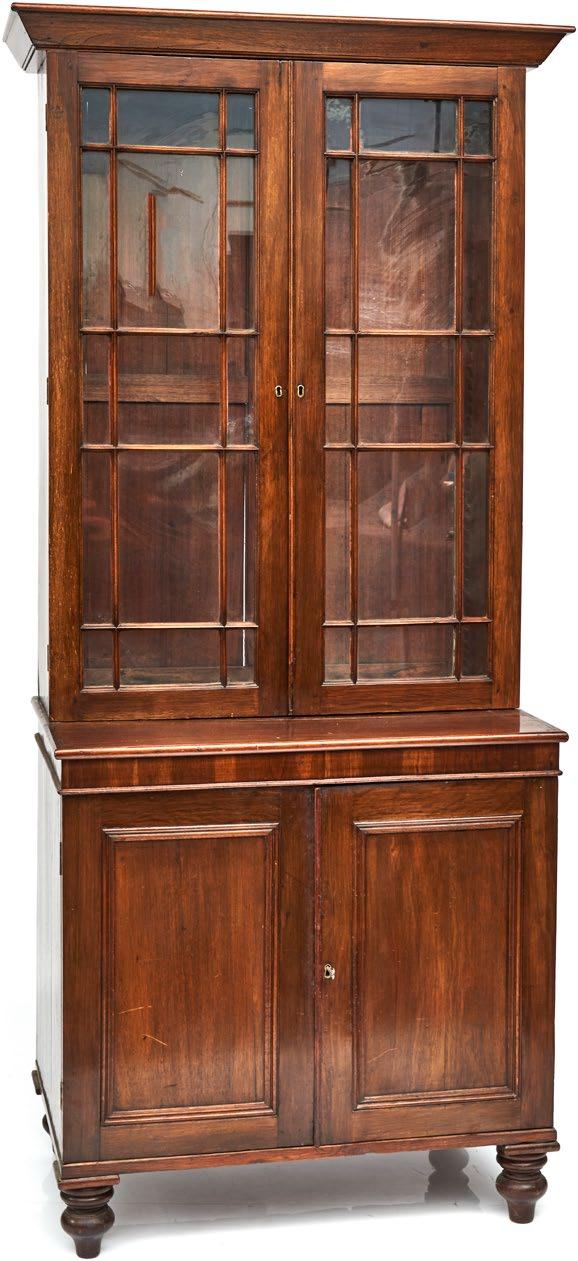
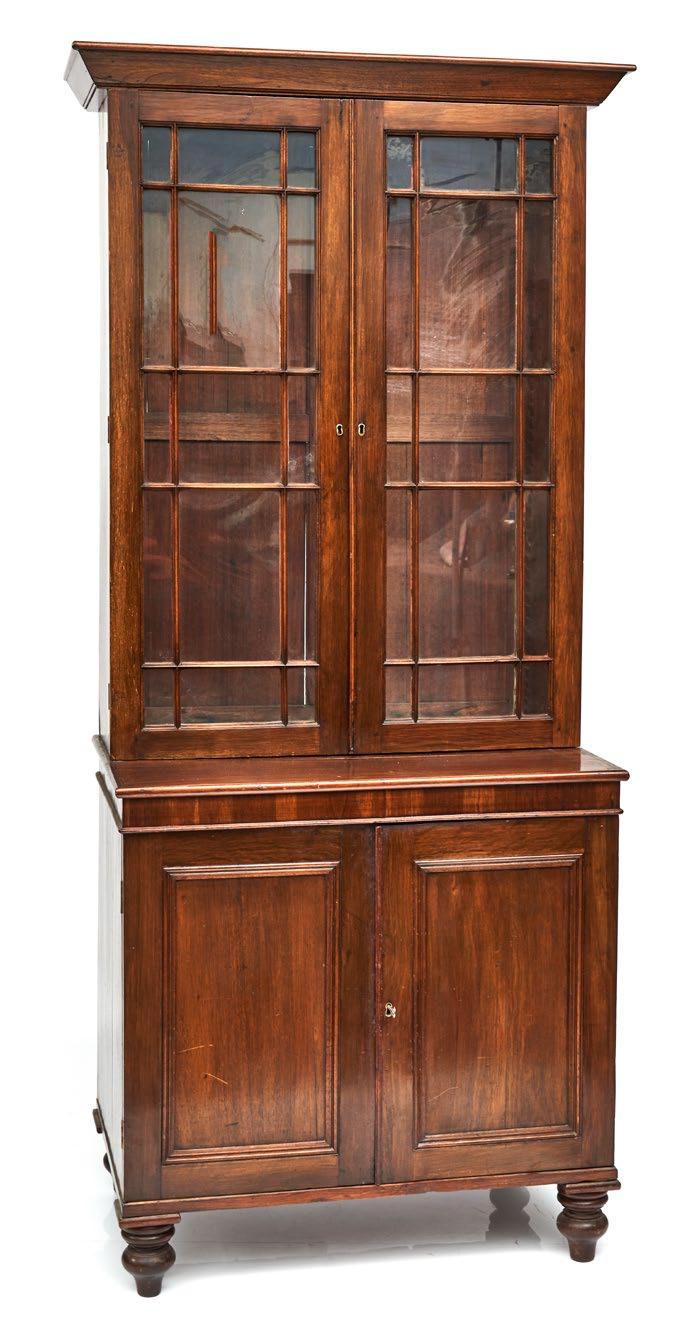
197
197 150
A rare and fine quality early cedar writing table, Australian, circa 1835 88cm wide, 50cm deep, 79cm high $3,000–5,000

198
198 151
199
A carved rosewood, cedar and Kauri-pine dressing table, Australian, circa 1870
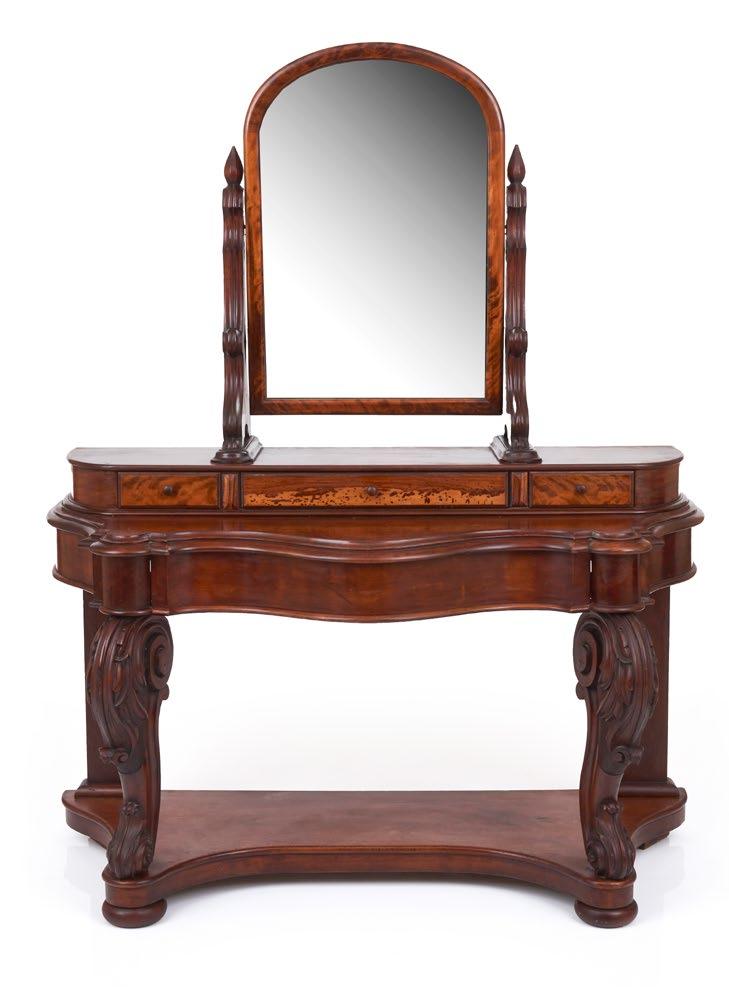
136cm wide, 64cm deep, 172cm high $1,500–2,500
200
An early Colonial cedar carver chair, Australian, circa 1835
56cm wide, 45cm deep, 84cm high $800–1,200

200 199 152
201
P. DE ZOMMARY
(Italian, 19th century)
Drunk man showing off to a girl watercolour
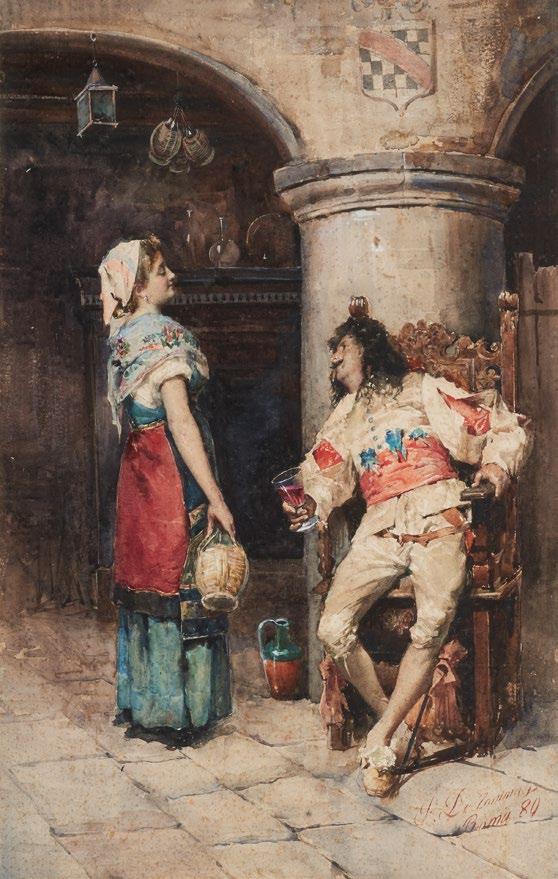
signed and dated Roma 80 lower right
54 x 38cm
PROVENANCE
Deutscher Menzies, 31/08/2007?
$1,500–2,000
202
S. MAREZY
(Italian, 19th century)
Portrait of a raven-haired young lady full length on a terrace oil on canvas
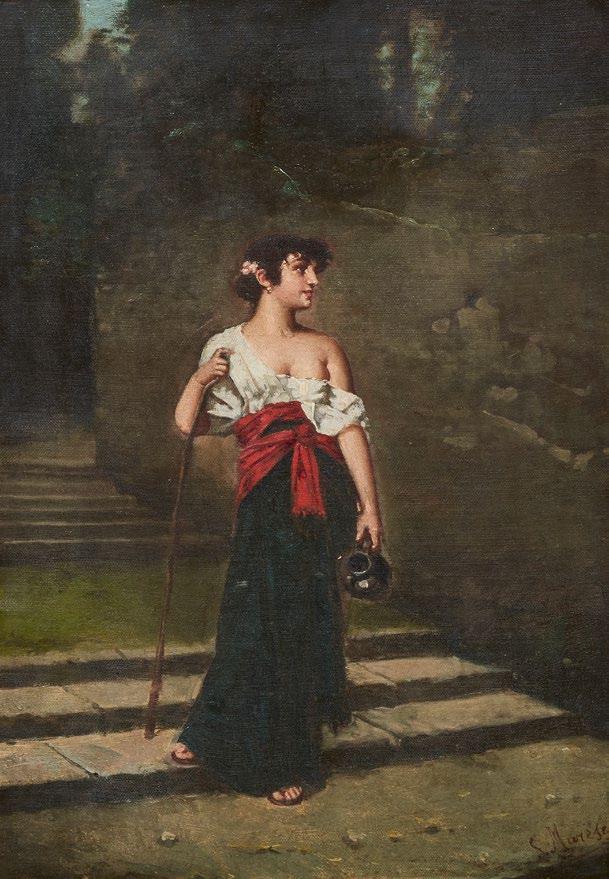
signed lower right
38 x 24cm
$500–800
202 201 153
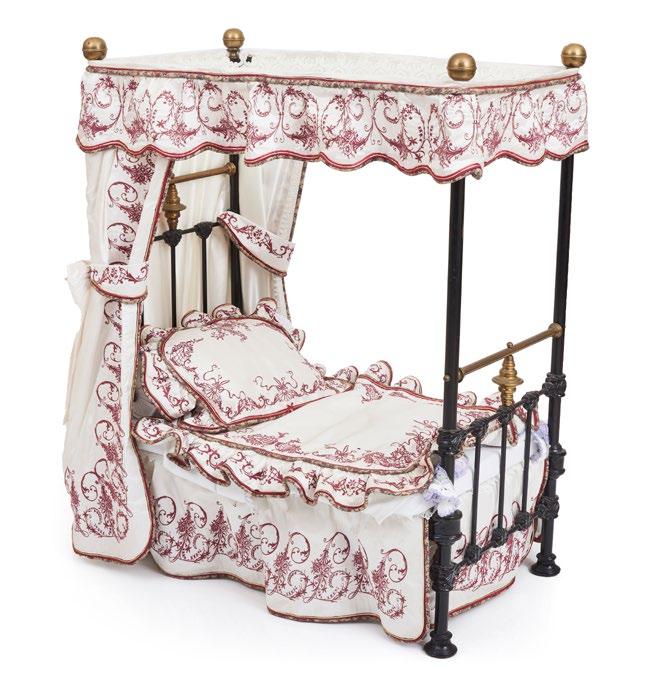
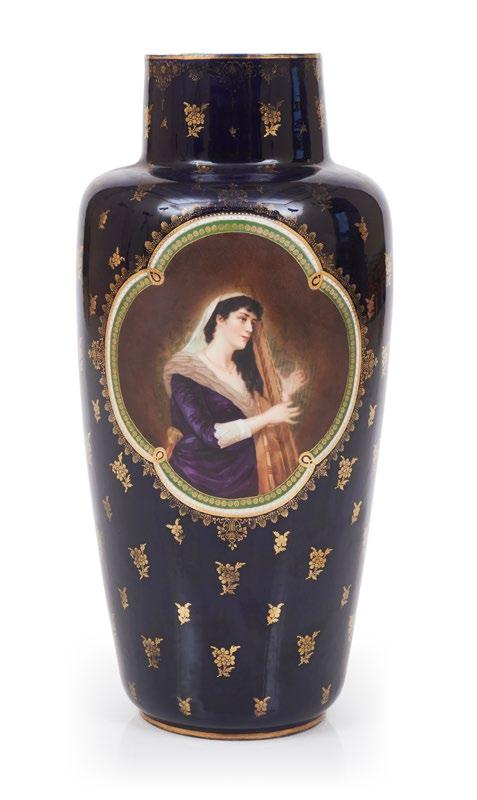
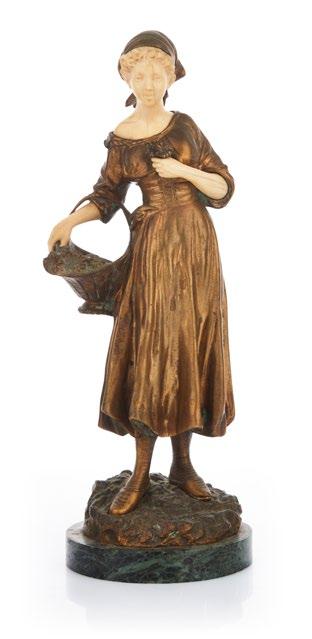

203 205 204 206 154
203
A Victorian cast-iron doll’s bed/window display model, English, circa 1880 complete with all bedding and curtains
53cm wide, 90cm long, 111cm high
$500–800
204
An enamel and silver octagonal trinket box, Austrian, circa 1900
7cm wide, 3.2cm high
$300–400
205
An Art Deco ivory and gilt-bronze figure of a girl with a basket, signed A Daste, French, circa 1920
36cm high
$800–1,200
206
A large Vienna pattern gilt royal-blue ground painted porcelain vase, Austrian, 19th century marks to base that are hard to read, see online photos
52cm high
$600–1,000
207
An unusual and good quality burr-wood floor standing bookcase, English, circa 1845

164cm high, 104cm wide, 36cm deep
PROVENANCE
Dahlia Stanley Auctions, single-owner auction, Mittagong, NSW
$1,500–2,500
207 155
208
A very impressive Grecian inspired cedar three-section inverted breakfront wardrobe, Australian, circa 1845 224cm wide, 63cm deep, 230cm high $5,000–8,000
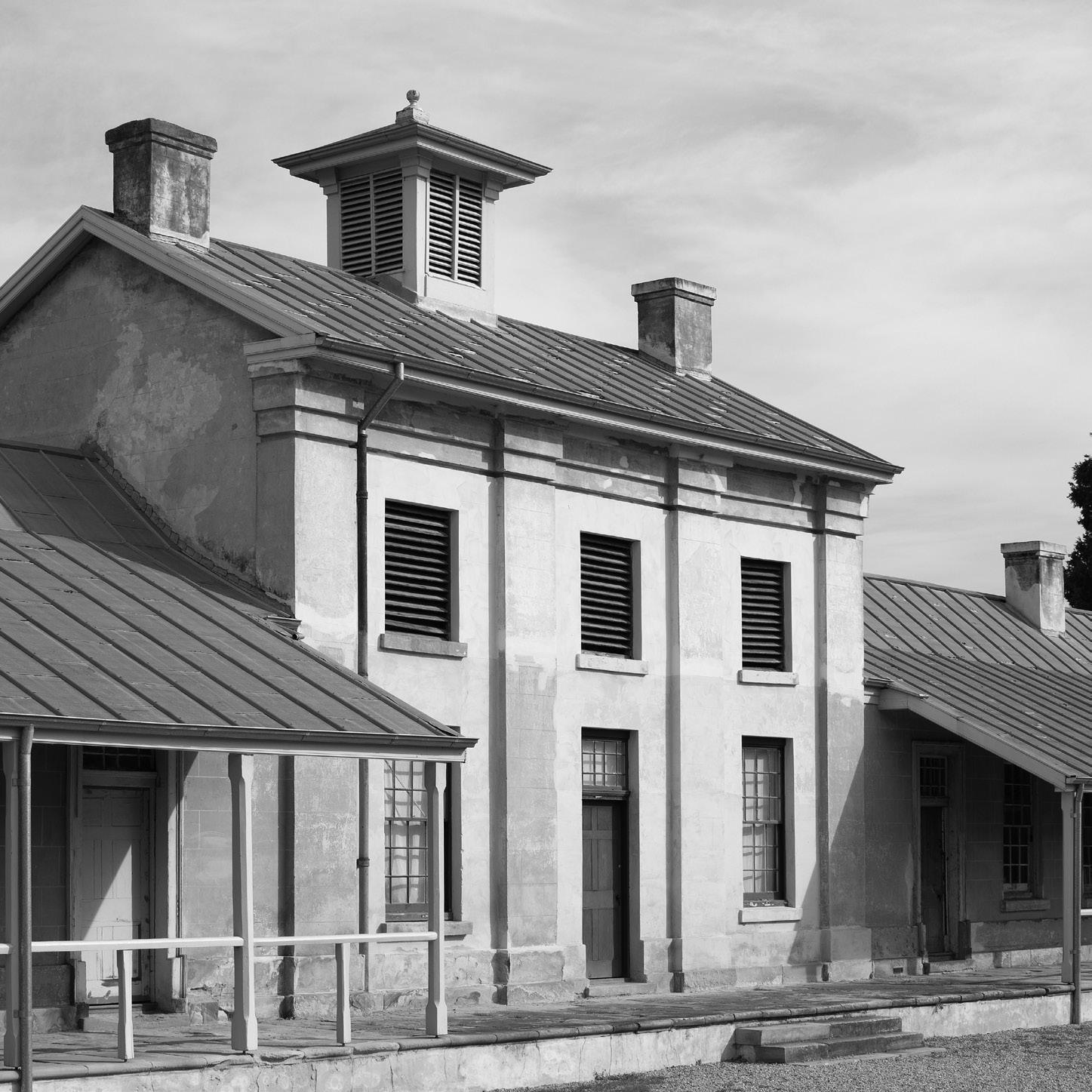
156
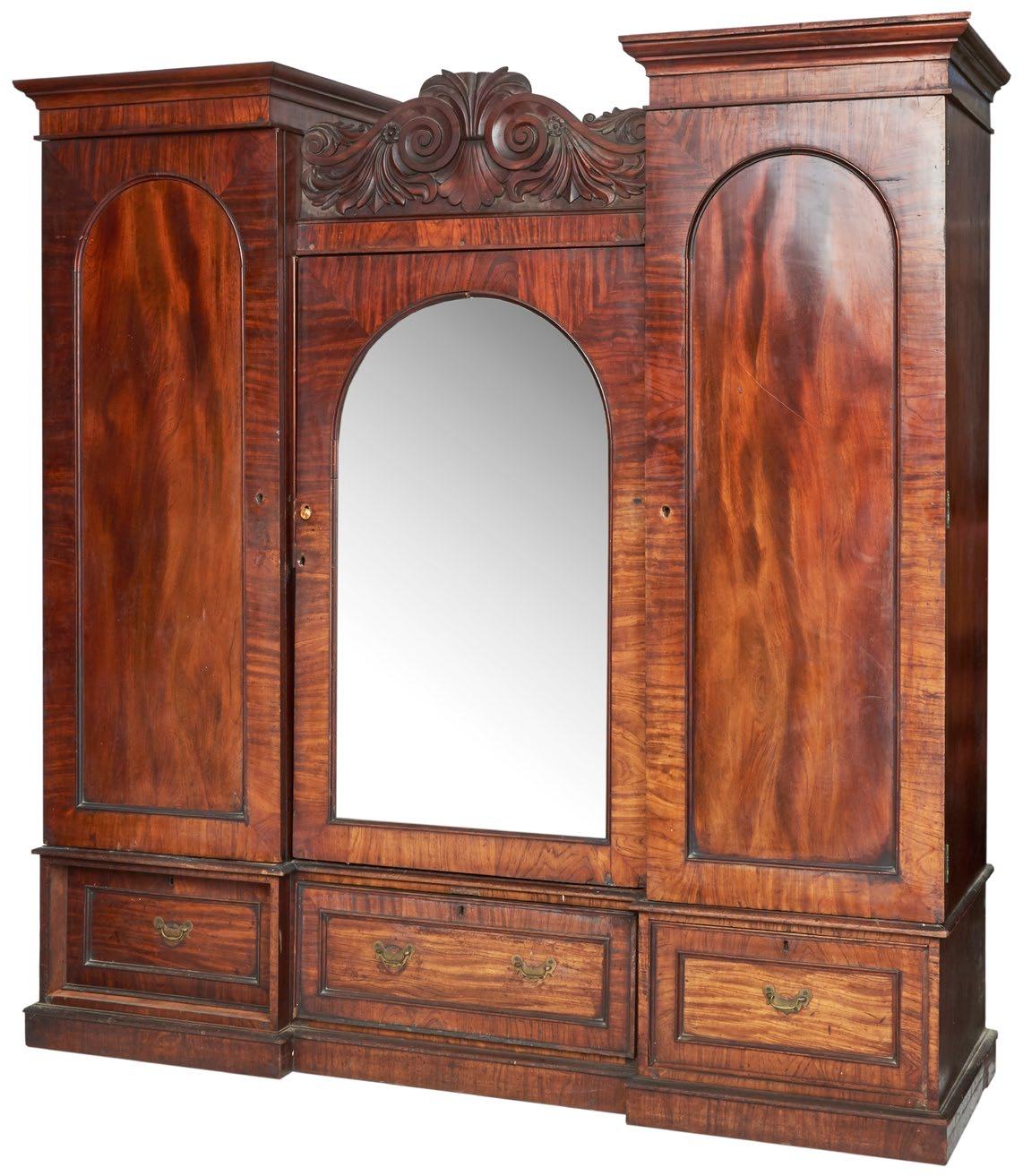
208 157
209
A good musk, black-wood and mixed timbers parquetry writing box, Australian, mid 19th century with inscription to E M Govett Brunswick Melbourne
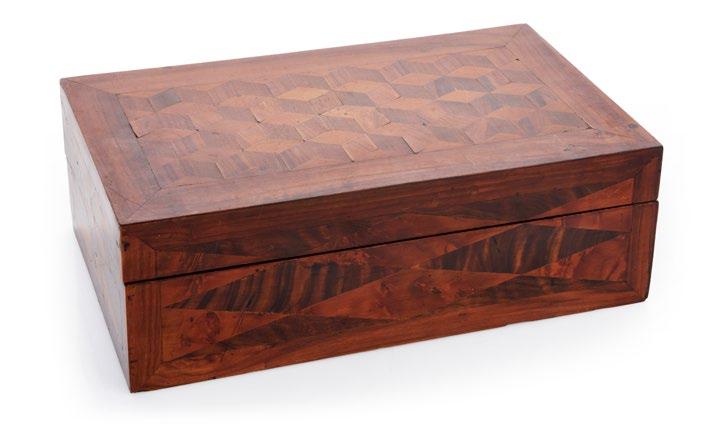
40cm wide, 25cm deep, 14cm high $1,000–1,500
210
A good cedar and specimen wood tilt-top circular top table, Australian, circa 1850 with musk, casuarina, huon-pine, celery top pine, blackwood and others 60cm diameter, 74cm high $2,500–3,500
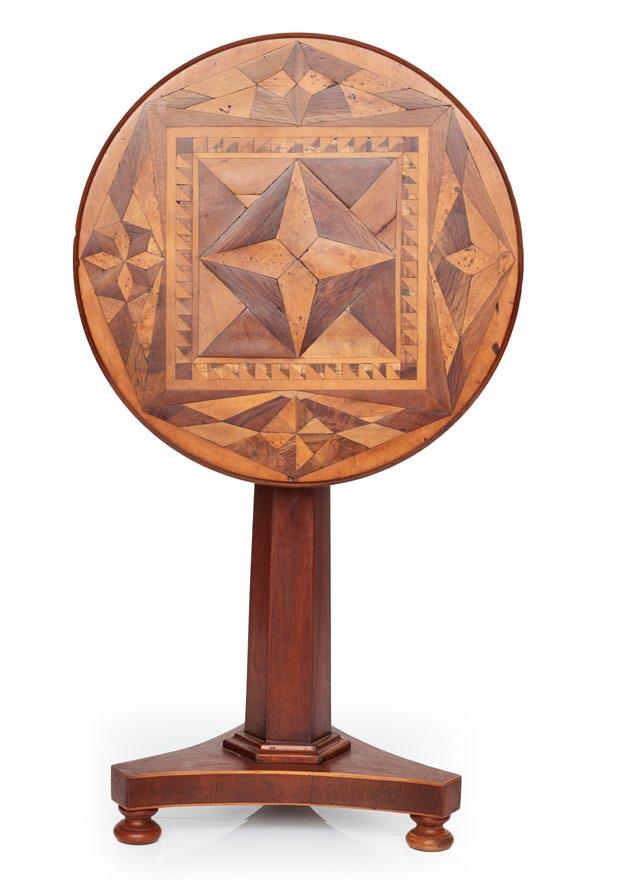
211
A rare and early string inlaid D-shaped cedar side table, Australian, circa 1825 90cm wide, 44cm deep, 78cm high $1,500–2,500
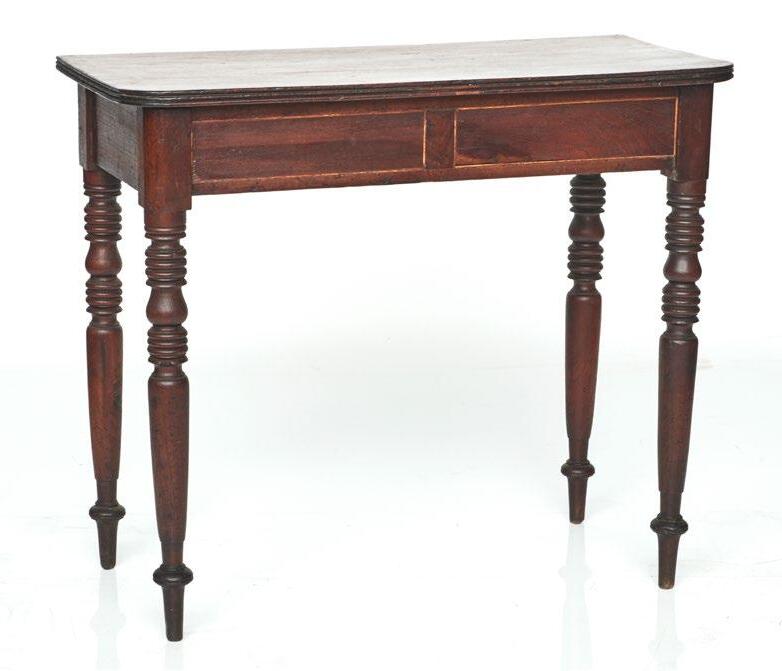
211 210 209 158
A good Colonial ebony Grecian-key stringinlaid cedar chest, Australian, circa 1835 120cm wide, 120cm high, 54cm deep $7,000–10,000
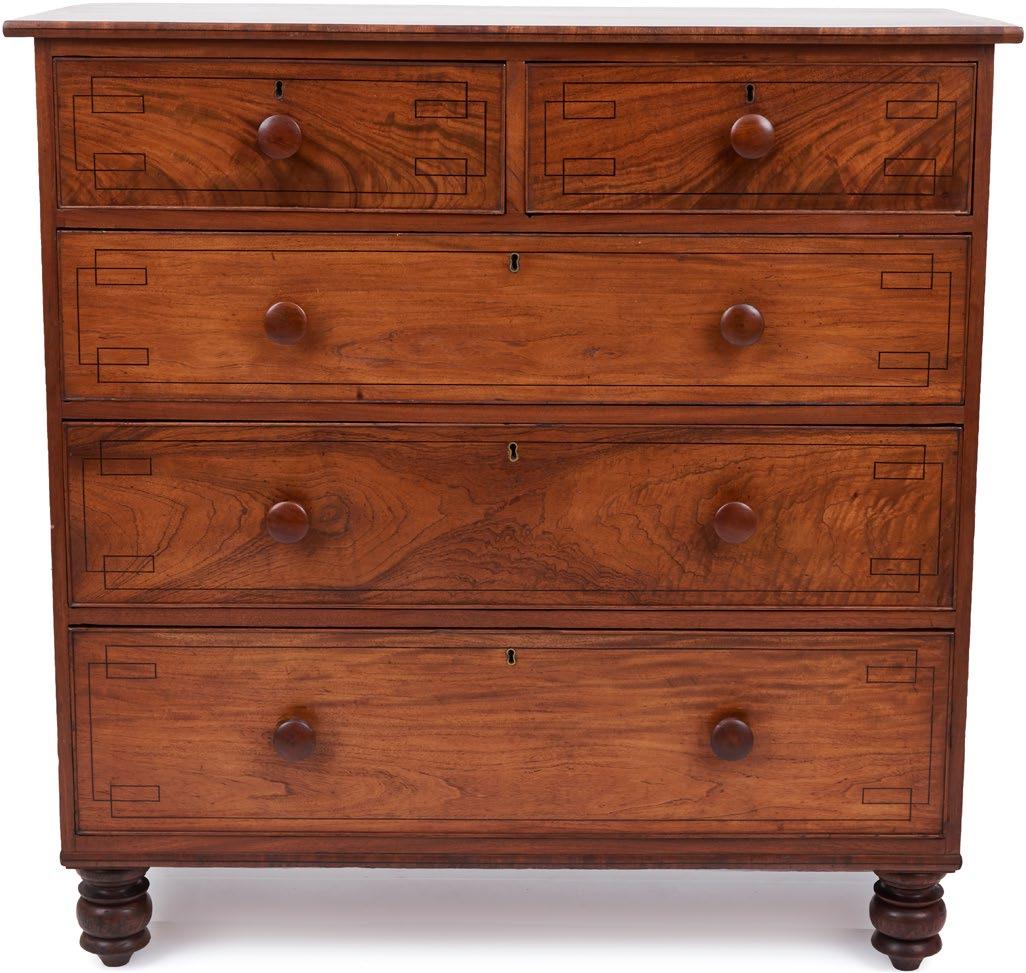

212
212 159

160
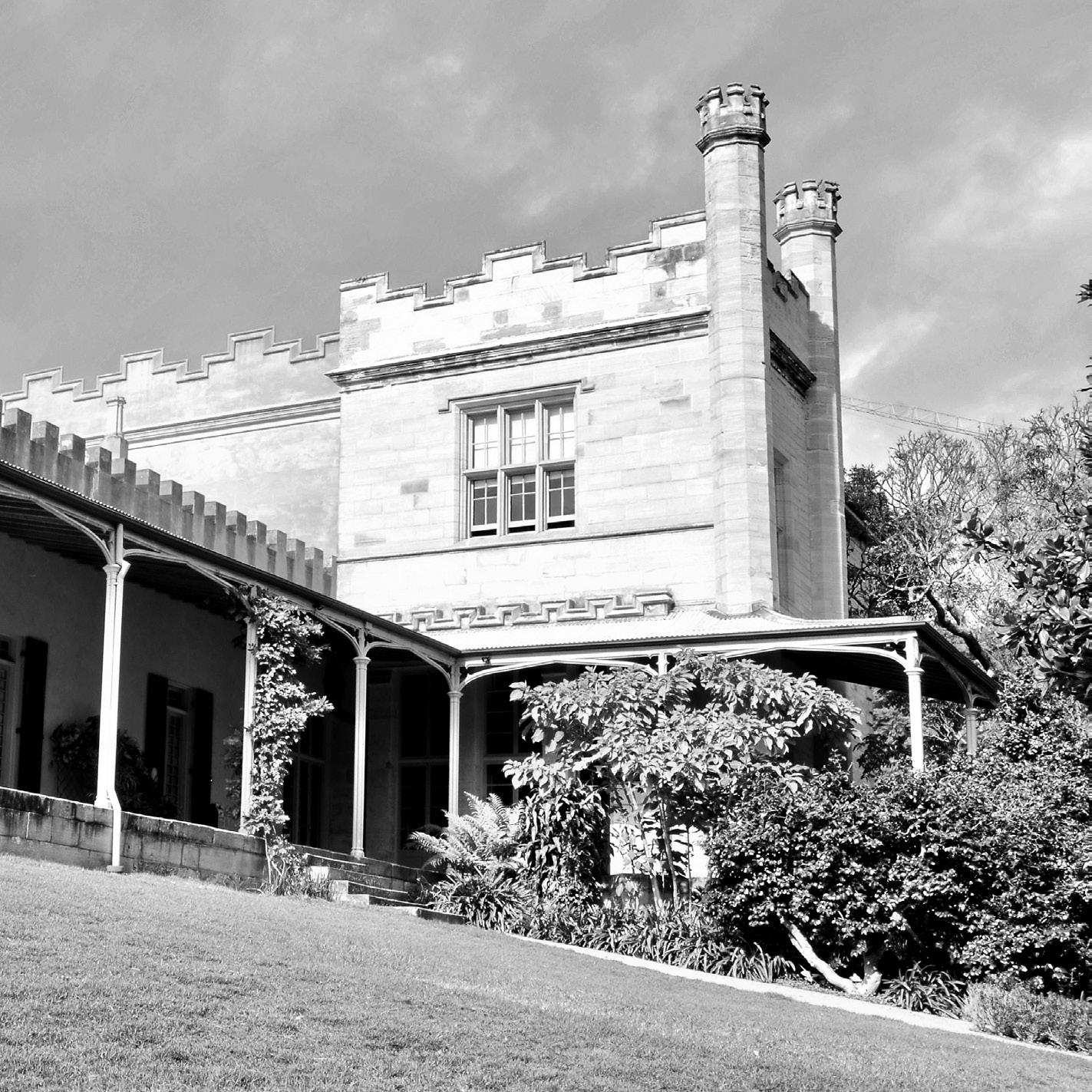
161
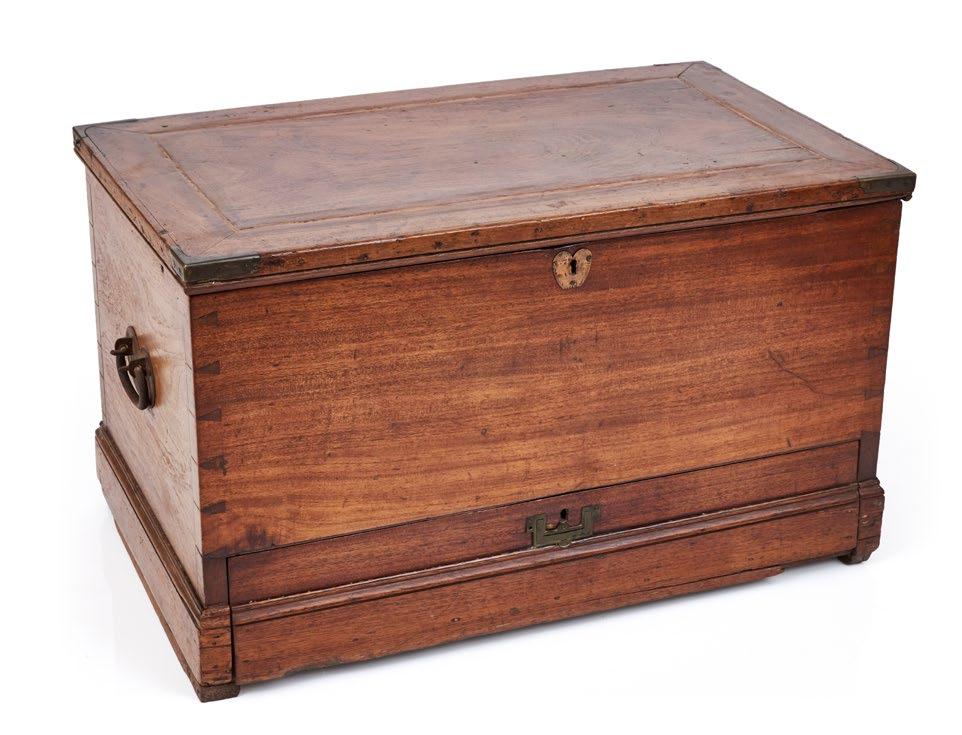

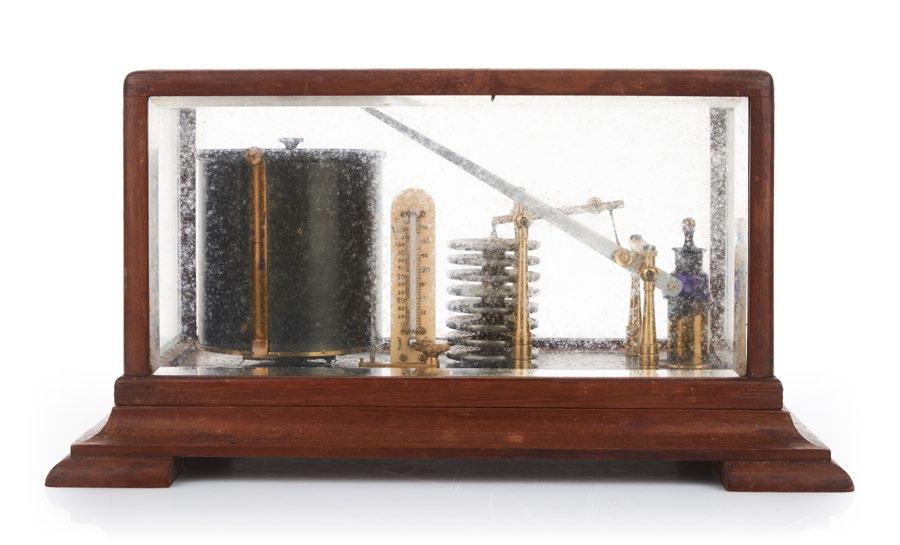
215 214 213 162
A brass and steel barograph by Flavelle Bros, Sydney and London, circa 1910 case 36cm wide, 19cm high, 22cm deep
$300–500
214
An inlaid cedar and brass mounted blanket box, Australian, circa 1870 with original brass corners, original cast iron carry handles with pull out drawer at base with brass military handles.
88cm wide, 53cm deep, 52cm high
$1,000–1,500
215
A rare and very fine quality rosewood and bone gimbal ship’s barometer by G Setta, Sydney, Australian, circa 1820 on an original brass bracket and brass weight at base
95cm high
$2,500–3,500
216
An important fine and early string and feather inlaid bow front side table, Australian, circa 1825

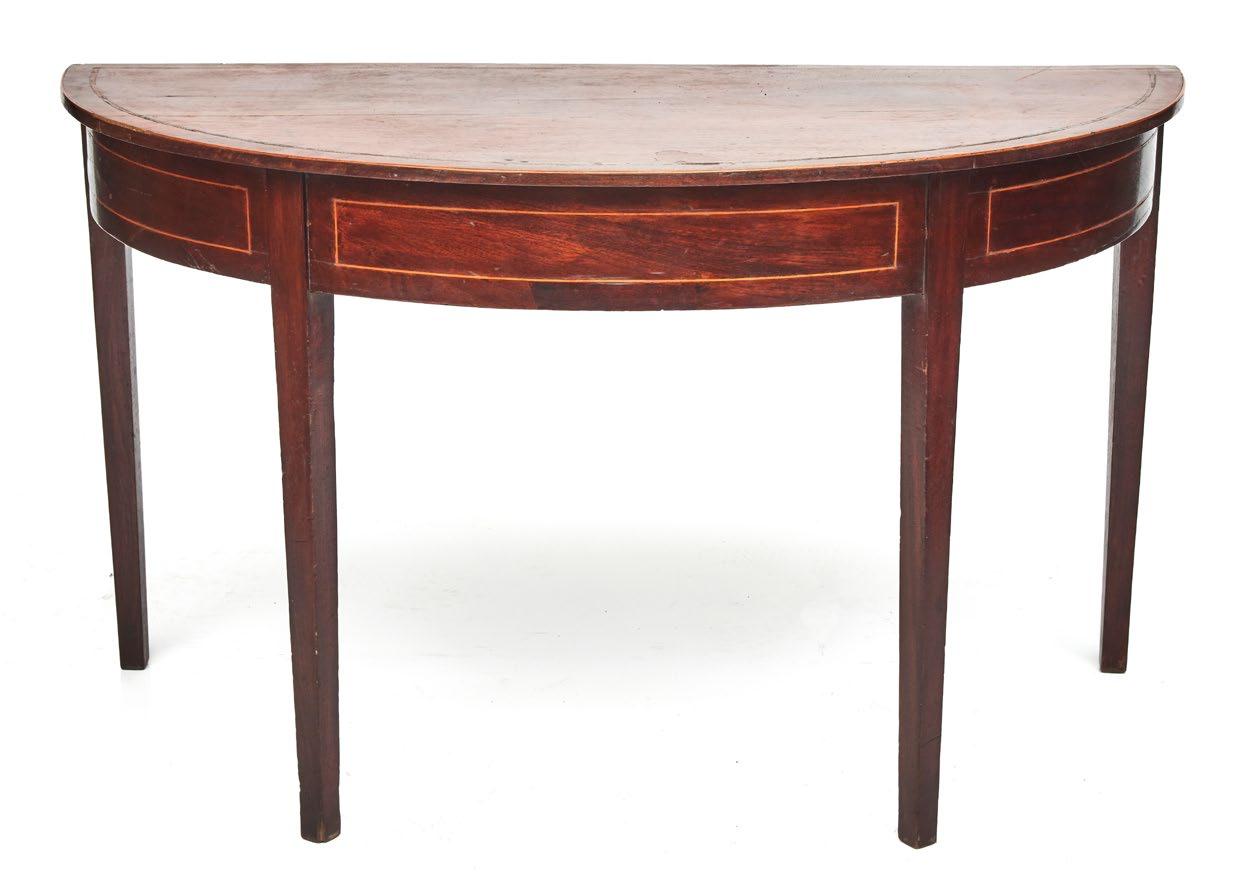
126cm wide, 62cm deep, 72cm high
$7,000–10,000
213
216 163
217
An early cedar fold-over card-table, Australian, circa 1845 with lappet and spiral carved column 79cm wide, 39cm deep, 70cm high $2,500–3,500
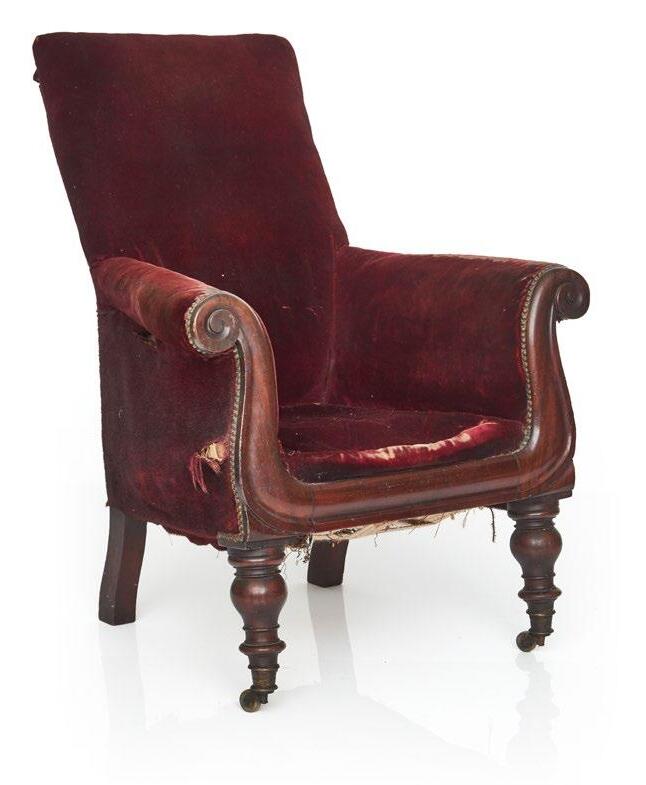

218
A good early cedar work-table, Australian, circa 1845 two operating drawers and two dummy drawers to sides 47cm long, 36cm deep, 73cm high $1,500–2,500

219 218 217 164
A Regency mahogany lyre-pattern armchair, English, circa 1825 76cm wide, 70cm deep, 101cm high
PROVENANCE
Shapiro Auctions, Sydney, sold then as colonial cedar. $1,500–2,500
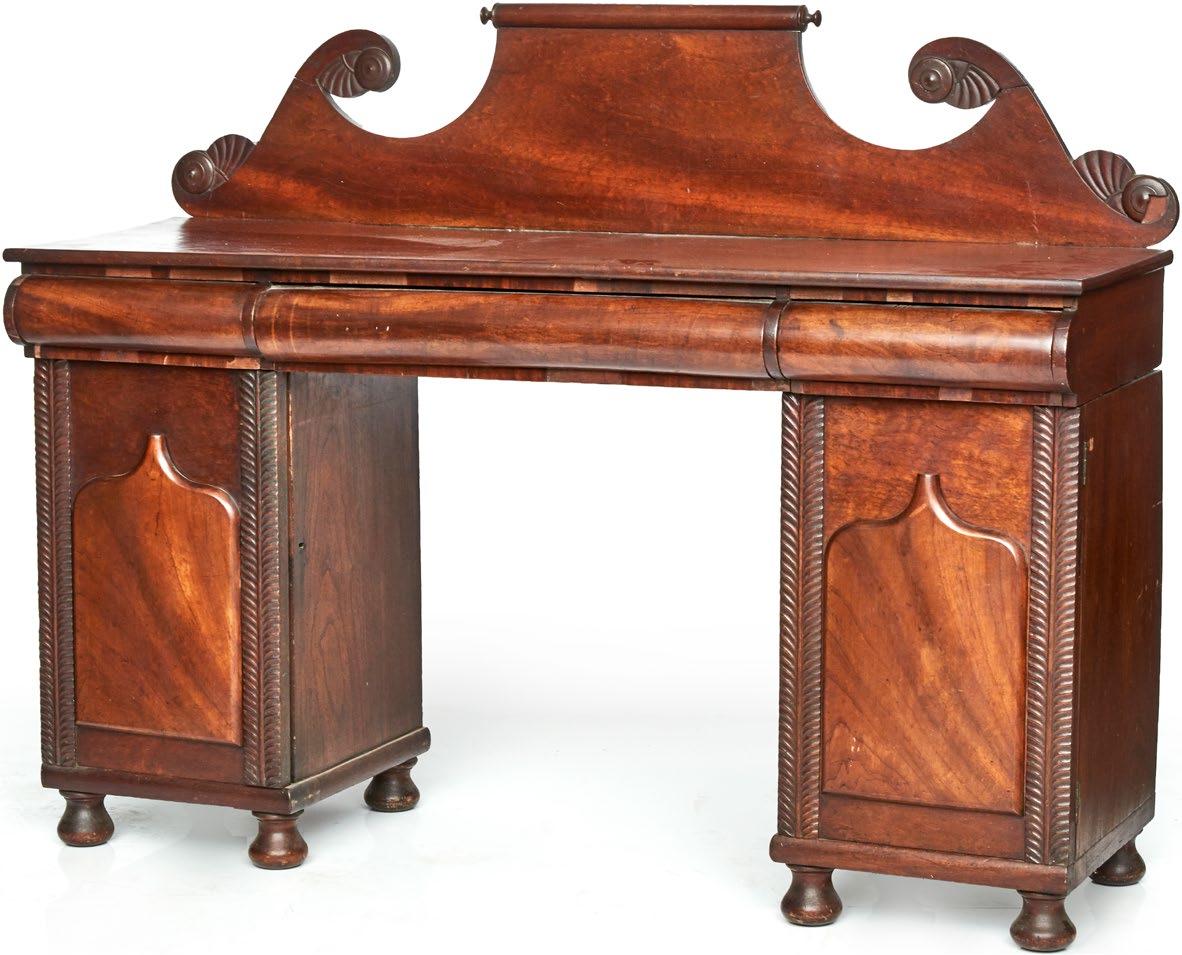

220
An unusual cedar double-pedestal raised back sideboard, Australian, circa 1835 170cm wide, 54cm deep, 130cm high $2,000–4,000
219
220 165

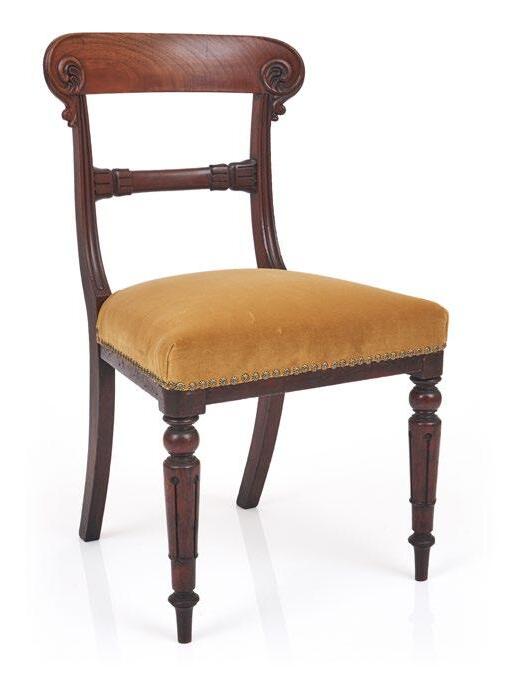
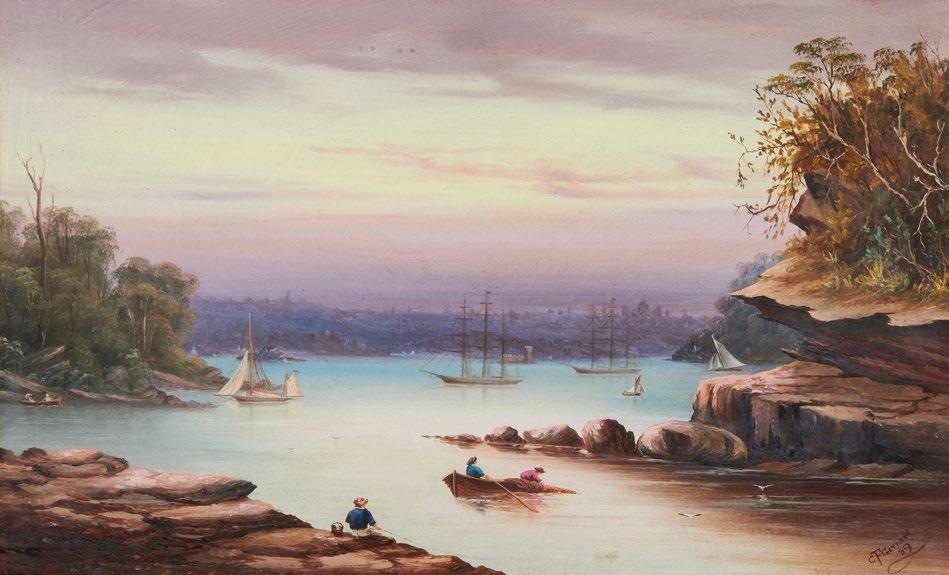
222 223 221 166
CHARLES FREDERICK GERRARD (1849-1904)
Sydney harbour from the North Shore with Fort Dennison and the city of Sydney beyond oil on board
signed lower right and dated 89 lower right 30 x 45cm
$1,000–2,000
222
A good turned leg rectangular cedar cot, Australian, circa 1835 98cm high, 107cm long, 58cm wide
ILLUSTRATED
Australian Furniture Pictorial History and Dictionary 1788-1938, Kevin Fahy and Andrew Simpson, Casuarina Press, Sydney, page 247, no 6.
$1,500–2,500
223
An early and good quality cedar dining chair, Australian, circa 1835
48cm wide, 87cm high
$700–1,000
224
A large cedar and blackwood eight drawer straight-fronted chest-of-drawers, Tasmanian origin, Australian, circa 1860


126cm wide, 61cm deep, 120cm high
$1,500–2,000
221
224 167
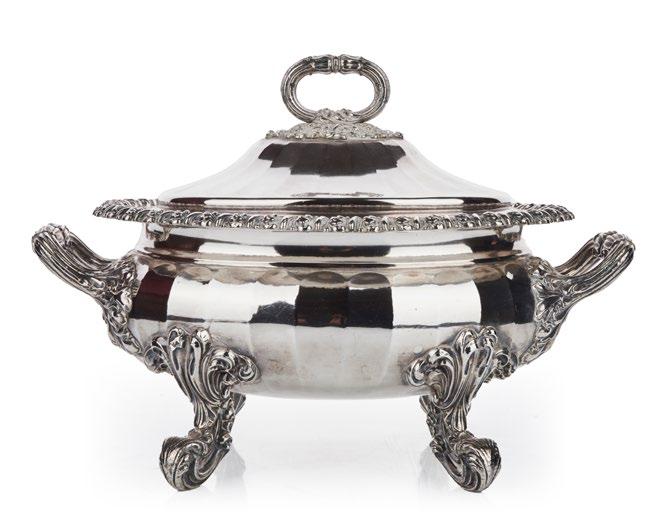

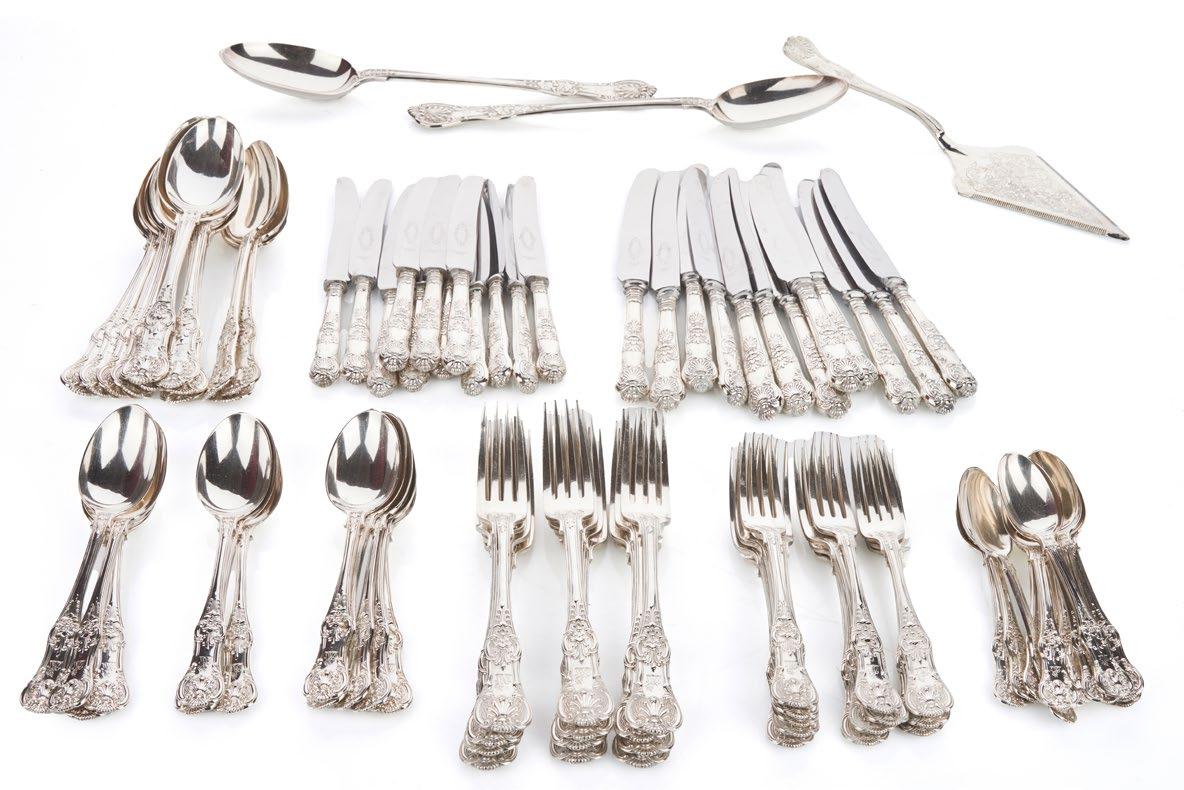
227 225 226 168
225
A good quality and large silver-plated oval two-handled tureen and cover, English, circa 1845
27cm high, 38cm wide
PROVENANCE
Dahlia Stanley Auctions, single-owner auction, Bundanoon, NSW
$600–1,000
226
A silver-plated emu form rectangular inkstand, retailers stamp of W.Kerr, Sydney, English made, 19th century 18cm wide, 14.5cm high
227
A fine Queens-pattern sterling-silver double-struck cutlery service (84 pieces) London 1894 makers mark W.G J.L for twelve place settings, comprising tablespoons, table-forks, dessert-spoons, luncheonforks, and teaspoons, plus two large matching gravy spoons, and with matched dinner-knives various
$5,000–8,000
228
A good cedar rectangular top trestle form library table, Australian, circa 1855 130cm long, 60cm deep, 74cm high
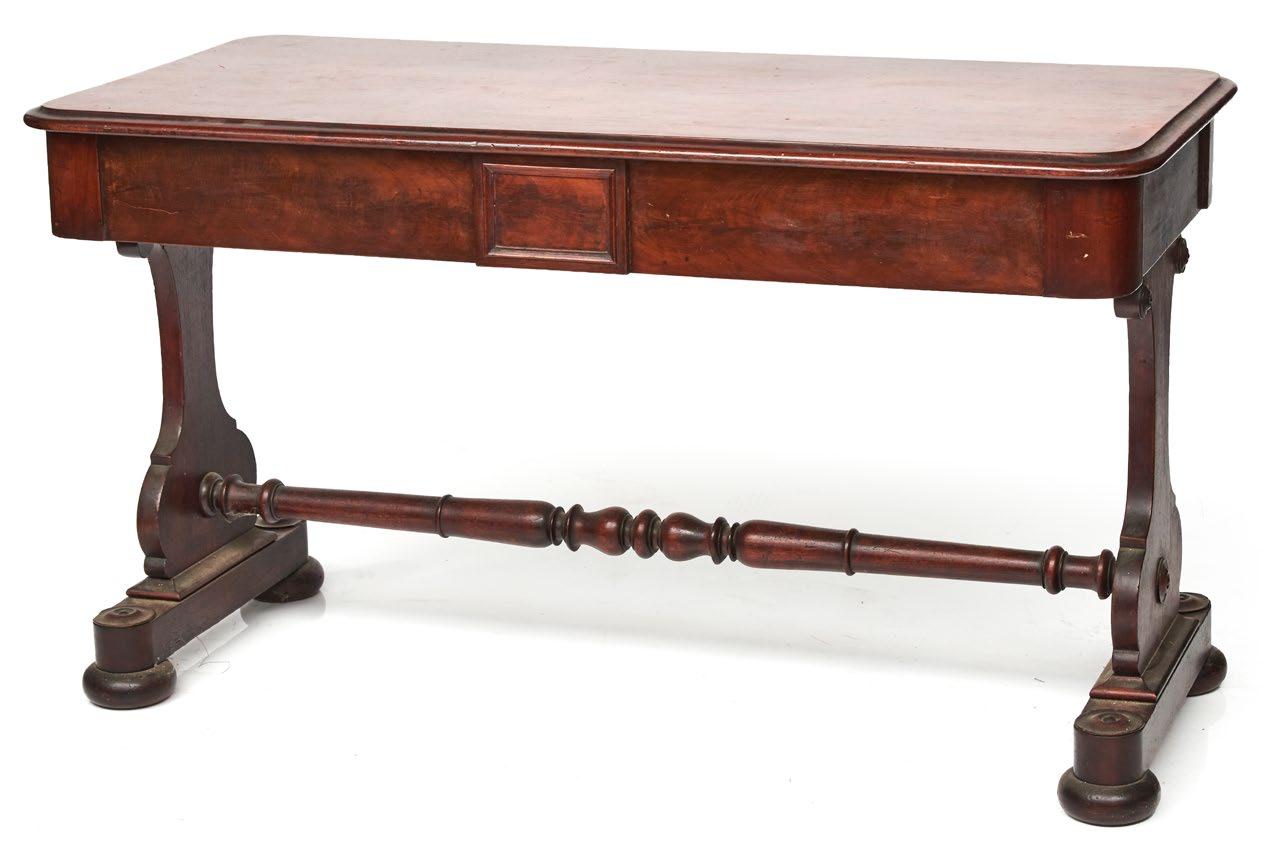
$5,000–8,000

228 169
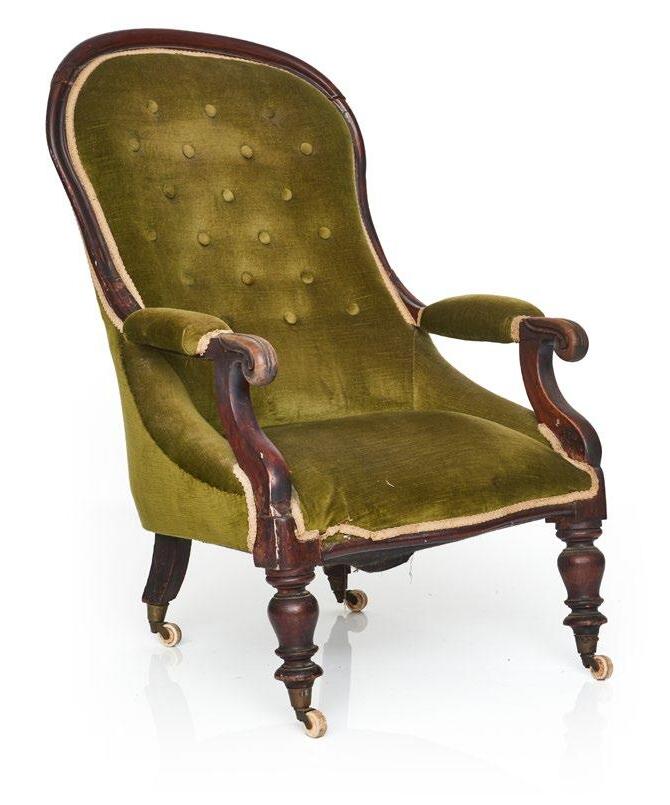

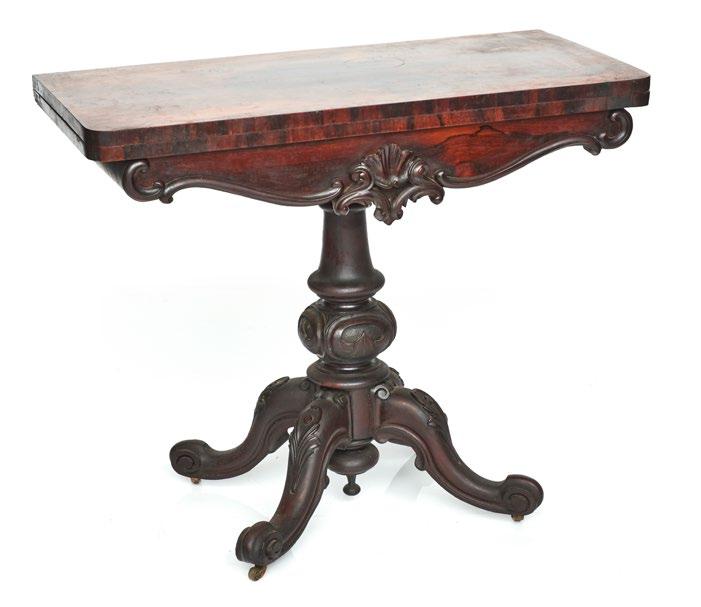

229 230 231 232 170
229
An early cedar armchair, Australian, circa 1855
67cm wide, 90cm high
$1,000–1,500
230
A good cedar rectangular fold-over pedestal card-table, Australian, circa 1835
98cm wide, 49cm deep, 77cm high
$3,000–5,000
231
A rosewood on cedar fold-over card table, Australian, circa 1855
92cm wide, 46cm deep, 78cm high
$1,500–2,500
232
An early cedar armchair, Australian, circa 1850 buttoned green upholstery, scrolled arms
98cm high, 68cm wide
$1,000–1,500
233
ARTIST UNKNOWN (Australian School, 19th century)
The Oxborough oil on canvas
titled lower left and to verso
19 x 39cm
$1,000–1,500
234
ARTIST UNKNOWN (Australian, 19th century)
View at Sorrento Victoria with figures on the beach
watercolour
inscribed: Sketch of Sorento,( sic.) a watering place of Port Phillip, Port Phillip is in the bay of Melbourne Australia



13.5 x 19.5cm
$300–500
235
FREDERICK JAMES ELLIOTT (1864-1949)
Sydney harbour
watercolour
signed and dated 90 lower right
15 x 20cm
$400–600
233 234 235 171

172
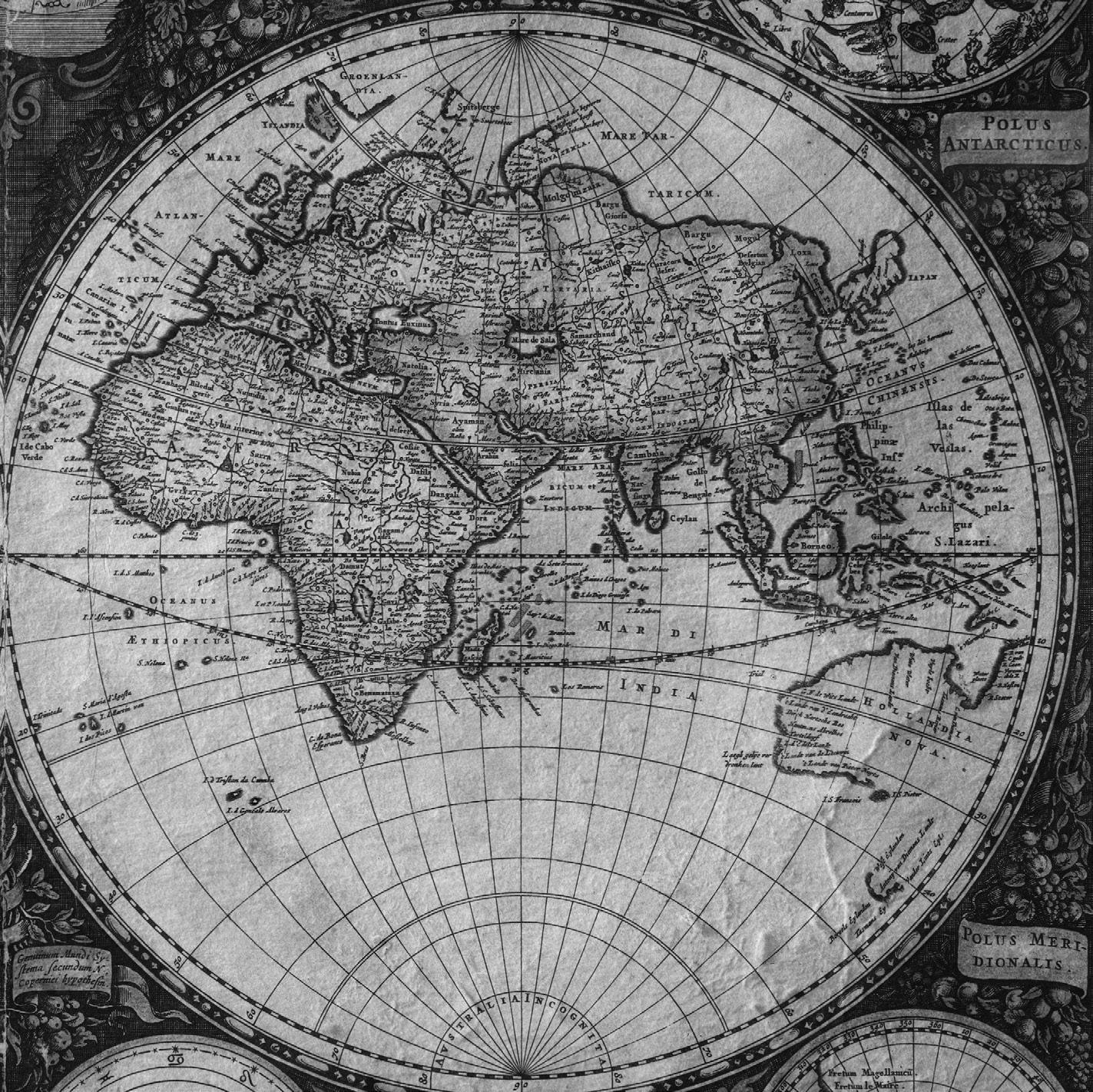
173
236
A good cedar centre table, Australian, circa 1845
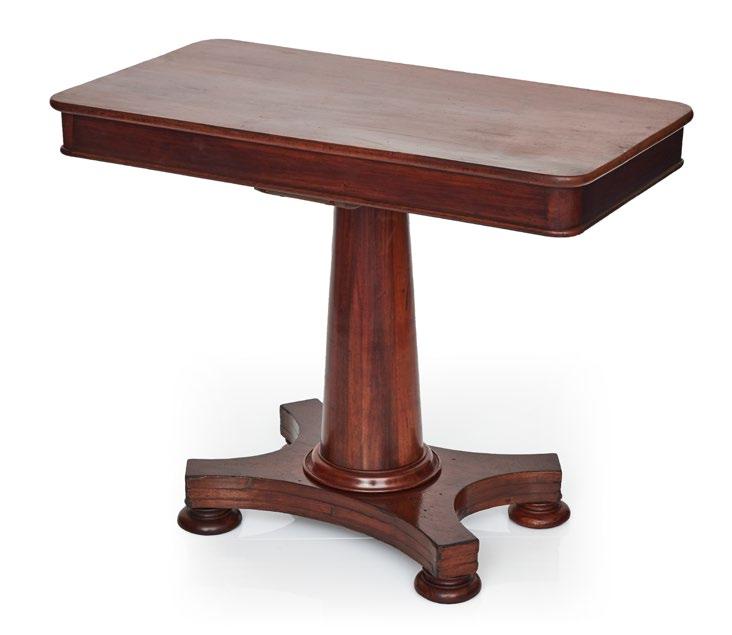
91cm long, 48cm deep, 72cm high
$2,000–3,000
237
A good set of six cedar yoke back dining chairs, Australian, circa 1845
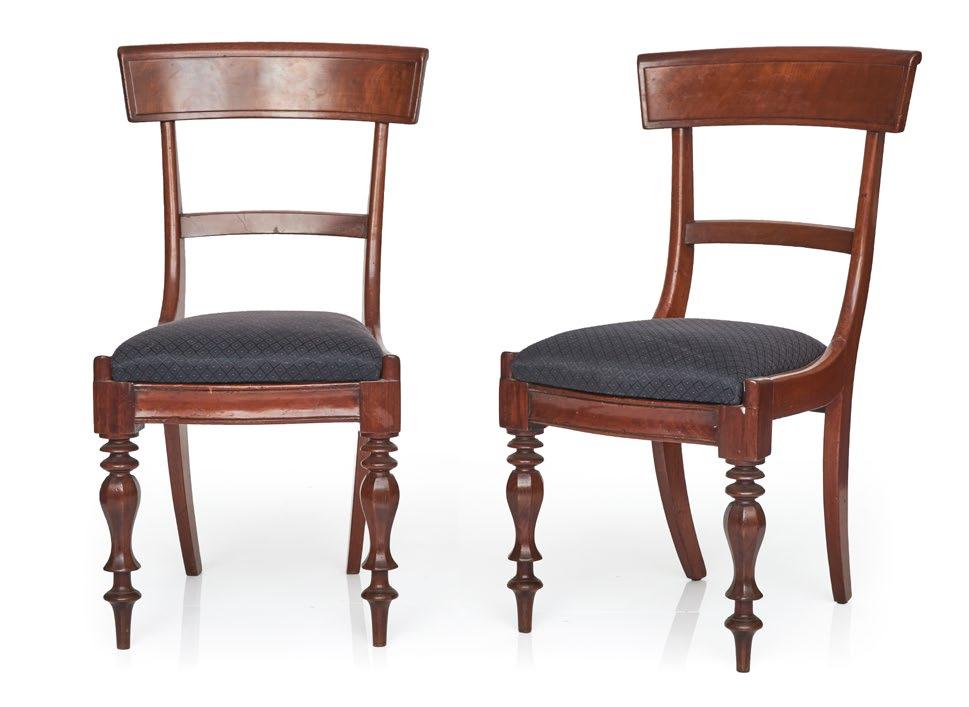
88cm high, backs 51cm wide
$2,000–4,000
238
A small cedar circular top occasional table, Australian, circa 1855
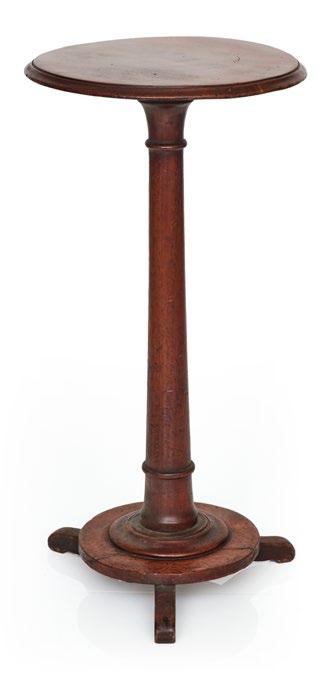
38cm diameter, 77cm high
$700–1,000
236 237 238 174
239
A good quality and very impressive cedar three-door wardrobe, Australian, circa 1850 with tall carved flat pilasters 190cm wide, 230cm high $4,000–6,000
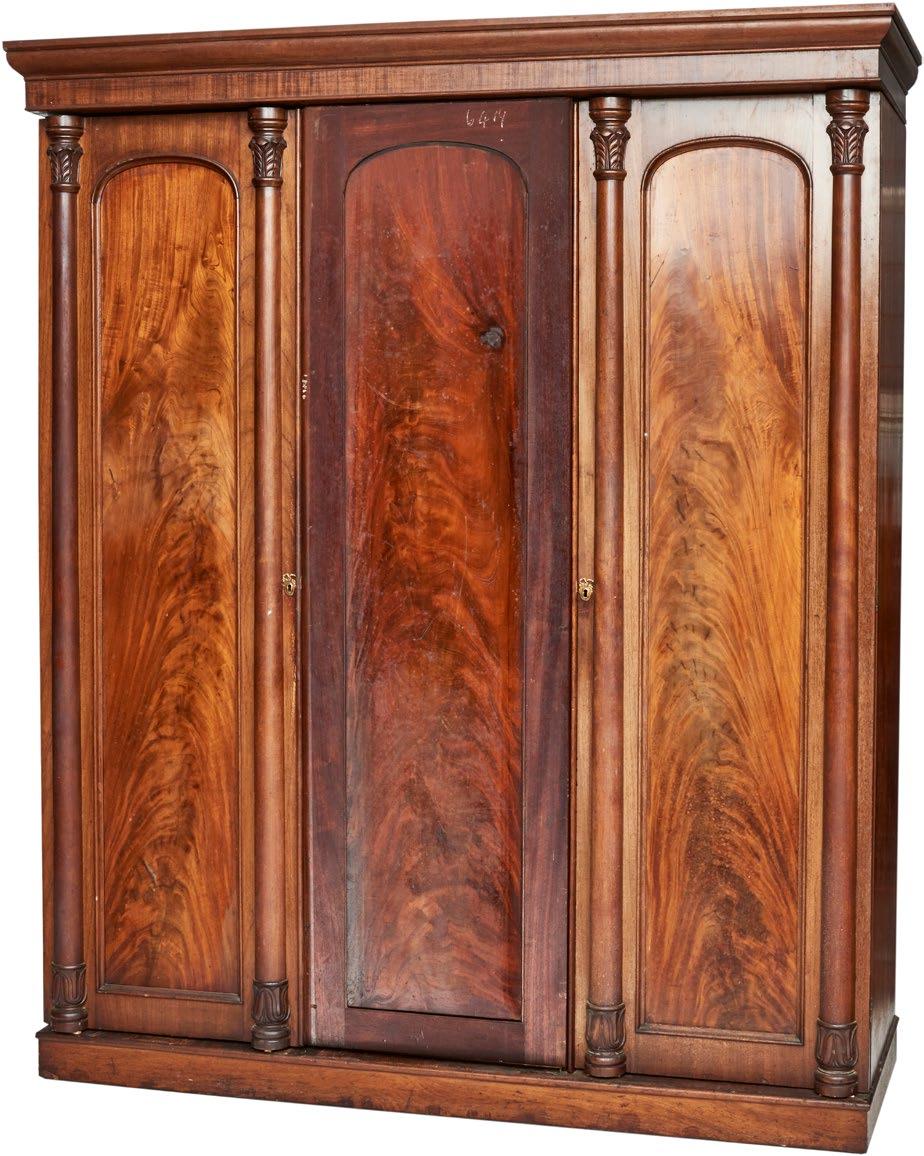
239 175
240
A rare carved cedar rocking armchair, Australian, circa 1845
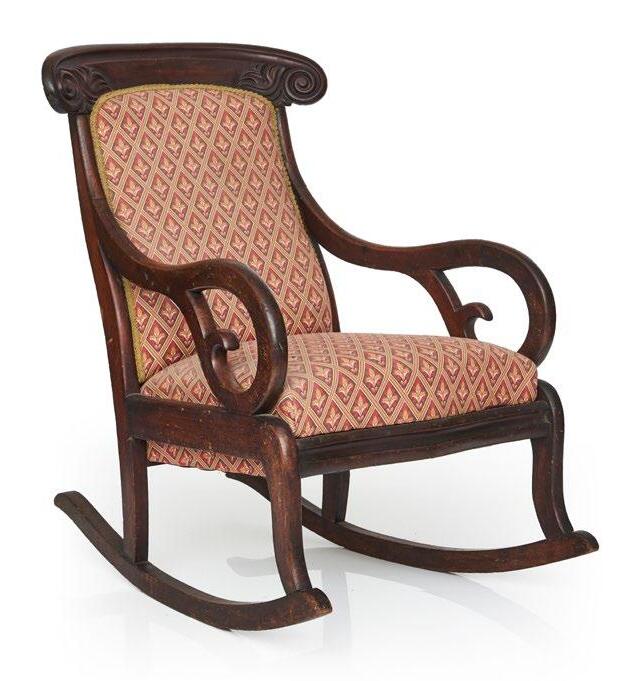
$1,000–2,000
241
A large floral gilt gesso and gilt-wood over-mantle mirror, French, 19th century 175cm high, 130cm wide
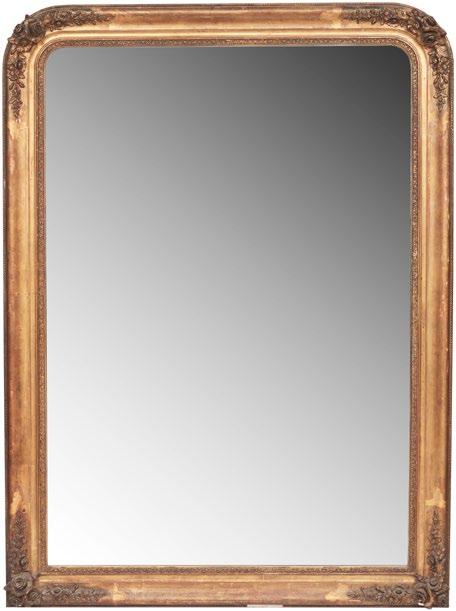
$700–1,000
242
An unusual Australian cedar servery/whatnot, Australian, circa 1850 having a small raised back on top shelf, the middle shelf being reeded. The midsupports have stepped turning with collar at top and bottom. The legs are turned with centurion skirt with tapered bottom legs. Long rectangular shape.

140cm wide, 39cm deep, 87cm high
$1,200–1,800
240 242 241 176
A rare and early string inlaid cedar straight front chest-of-drawers, Australian, circa 1825 119cm wide, 47cm deep, 116cm high $3,000–5,000
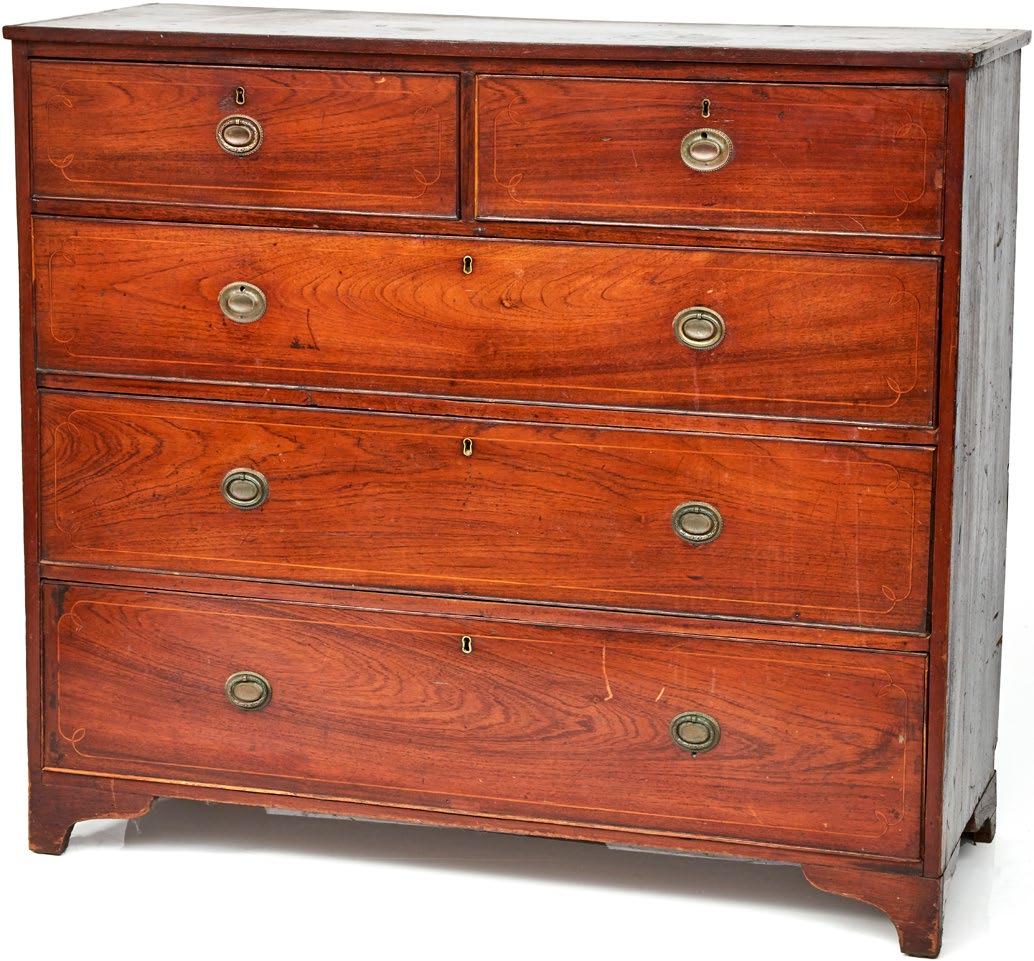

243
243 177
244
A
82 x 27cm

$500–800
245
AUSTRALIAN
Portrait of a young couple with a child charcoal, watercolour and body-colour, signed Alice Hausers? and dated 1857
45 x 37cm
$400–600
246
CHARLES
Miniature Portrait of Mrs Sophie Wiseman paint on ivory inscribed in ink to verso, black lacquer frame of the period and signed and dated 1833 to the sleeve of the lady's dress
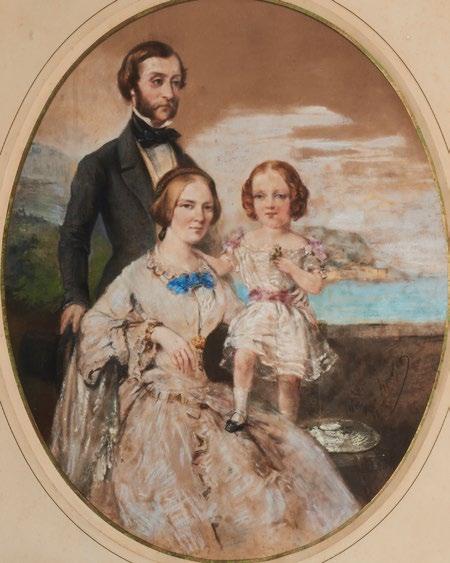

6.5 x 5cm
PROVENANCE
Private Collection, Ireland
Acquired by the vendors in the US in 2003 Mrs Sophie Wiseman was married to Soloman Wiseman of Wiseman Ferry, NSW.
$600–1,000
 flat-back cedar and painted ship model, Australian, 19th century
SCHOOL (19th century)
RODIUS (1802-1860)
flat-back cedar and painted ship model, Australian, 19th century
SCHOOL (19th century)
RODIUS (1802-1860)
244 245 246 178
247
A brass telescope and stand engraved Thomas Dawson Sydney, 19th century in original mahogany case and with extra fitments telescope 87cm long, closed lens diameter 6cm $700–1,000
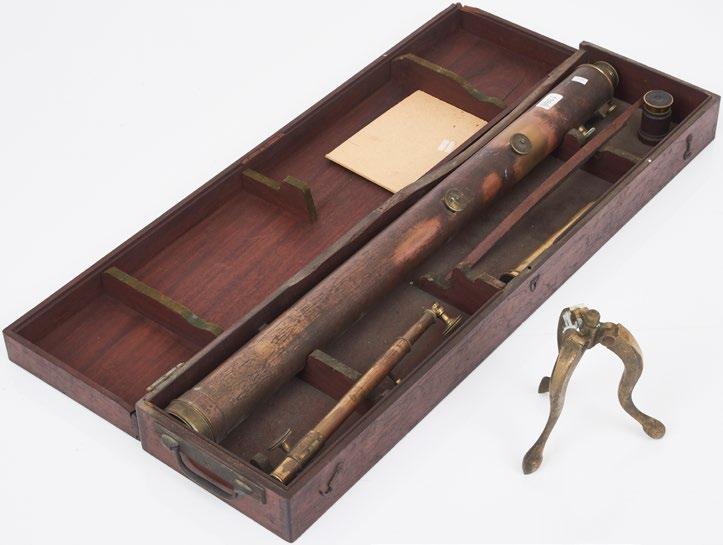
248
A set of twelve good quality George IV mahogany dining chairs, English, circa 1830 two carvers and ten standards
$3,000–5,000
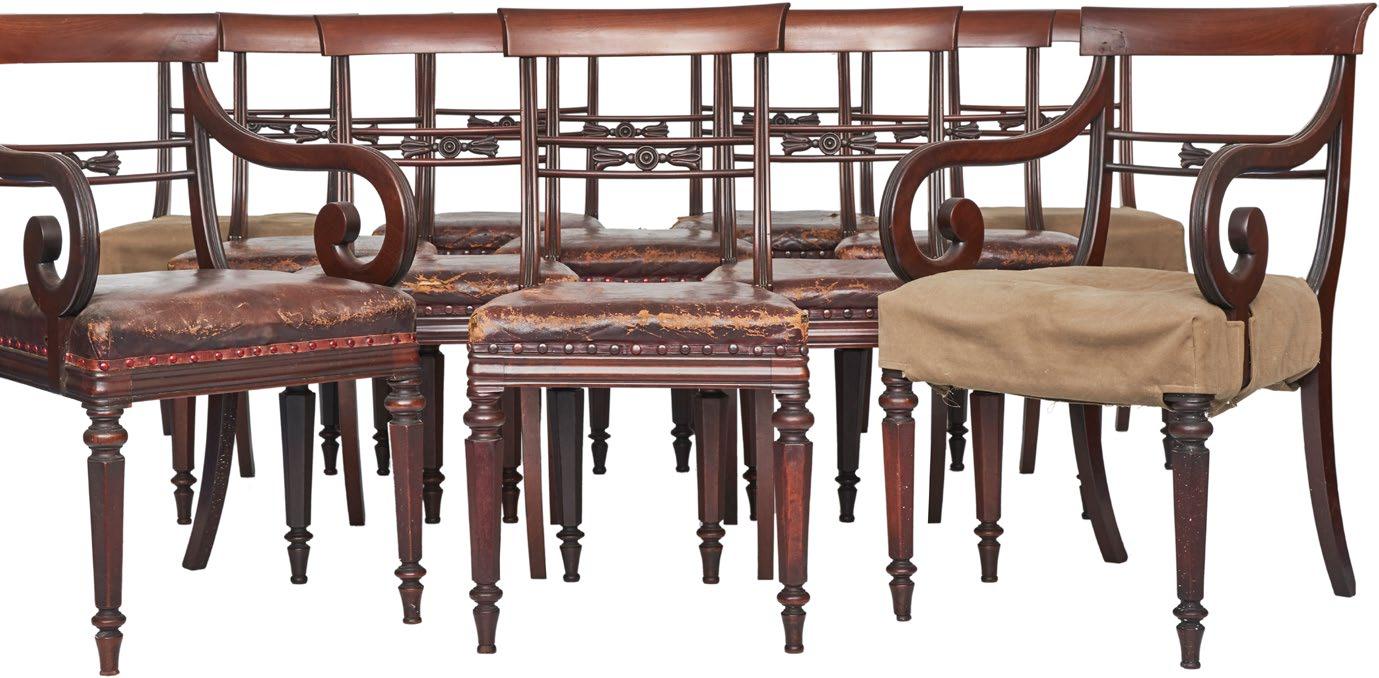
248
179
247
249
A cedar matching set of wash-stand and dressing table of small proportions, Australian, circa 1880 the wash stand with marble top and the dressing table with carved support swivel mirror dressing table: 110cm wide, 50cm deep, 154cm high washstand: 110cm wide, 50cm deep, 98cm high $1,500–2,000
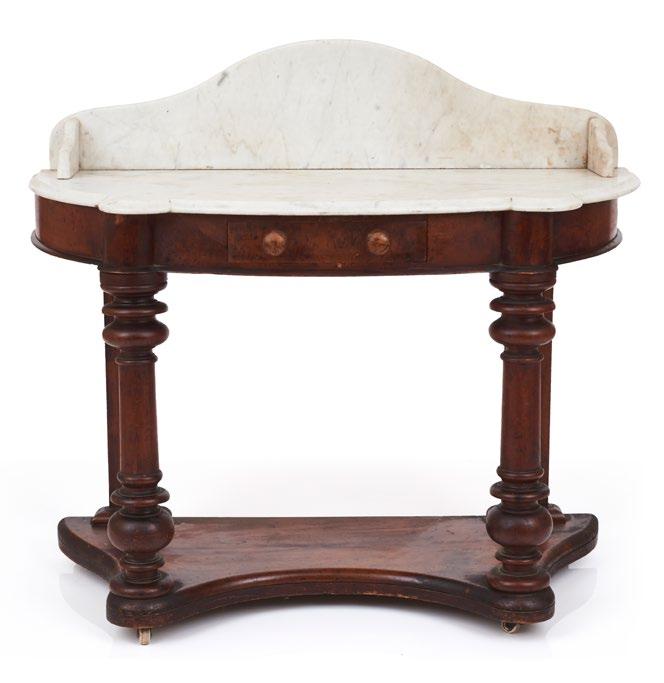
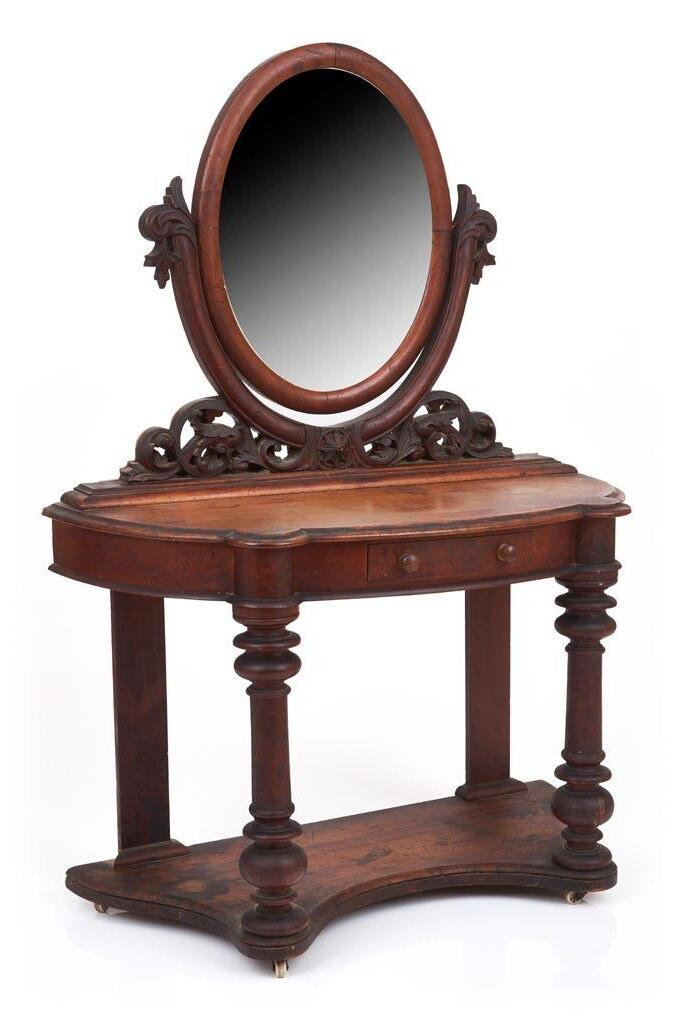
249 249 180
JOHN SAMUEL WATKINS (Australian, 1866-1942)
To The Laughing God oil on canvas signed lower right and signed and titled to verso 125 x 95cm $4,000–6,000
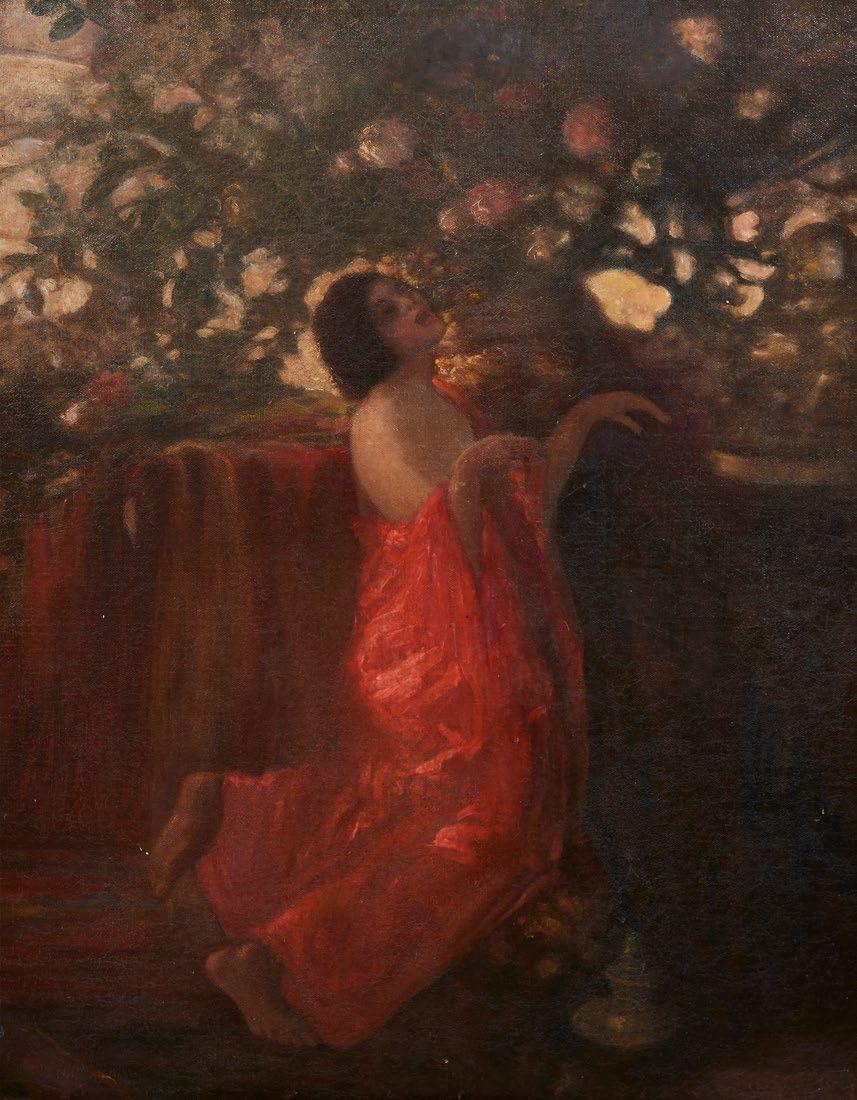
250
250 181
251
GLADSTONE EYRE (Australian, 1862-1933)
Sydney harbour from the north shore watercolour signed lower right
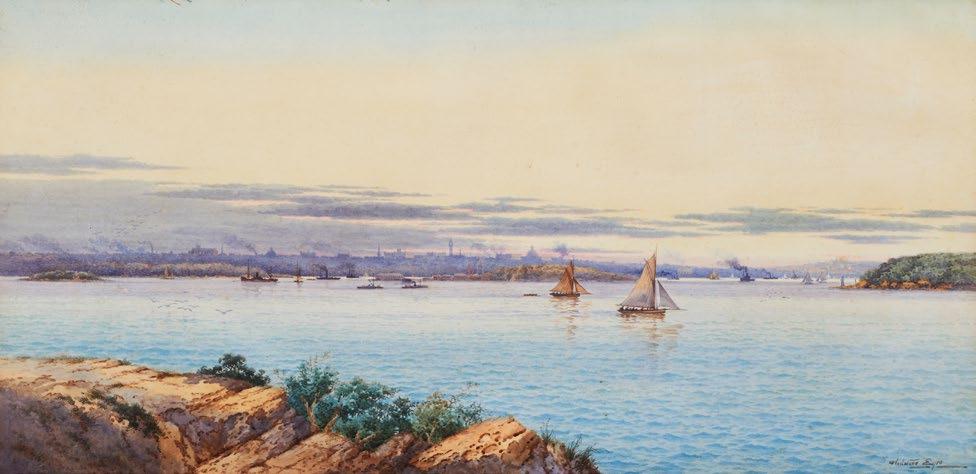
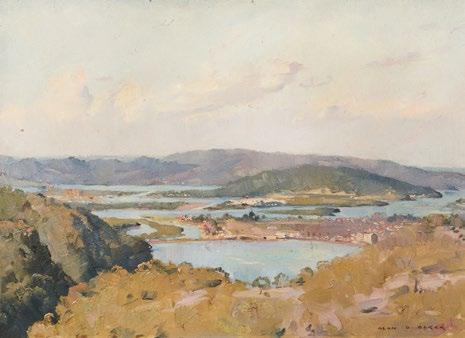
59 x 116cm
PROVENANCE
Acquired by Ian MacArthur-Onslow for McDonald Hamilton and Co Shipping line, Sydney Subsequently sold by John Williams, Sydney, February 2006
$4,000–6,000
252
NORMAN LINDSAY (Australian, 1879-1969)

The Gods of Olympus watercolour unsigned 28 x 36cm
Sold with a letter of authenticity from Helen Glad, the artist's daughter stating it came from the artist's estate
$6,000–9,000
253
ALAN DOUGLAS BAKER (Australian, 1914-1987)
River scene (Woy Woy) oil on board signed lower right 43 x 58cm
$1,000–1,500
251 252 253 182
254
A fine carved cedar breakfront wardrobe by Hill and Sons, Sydney, Australian, circa 1860 with Hill and Sons paper maker's label to verso 245cm high, 242cm wide, 60cm deep
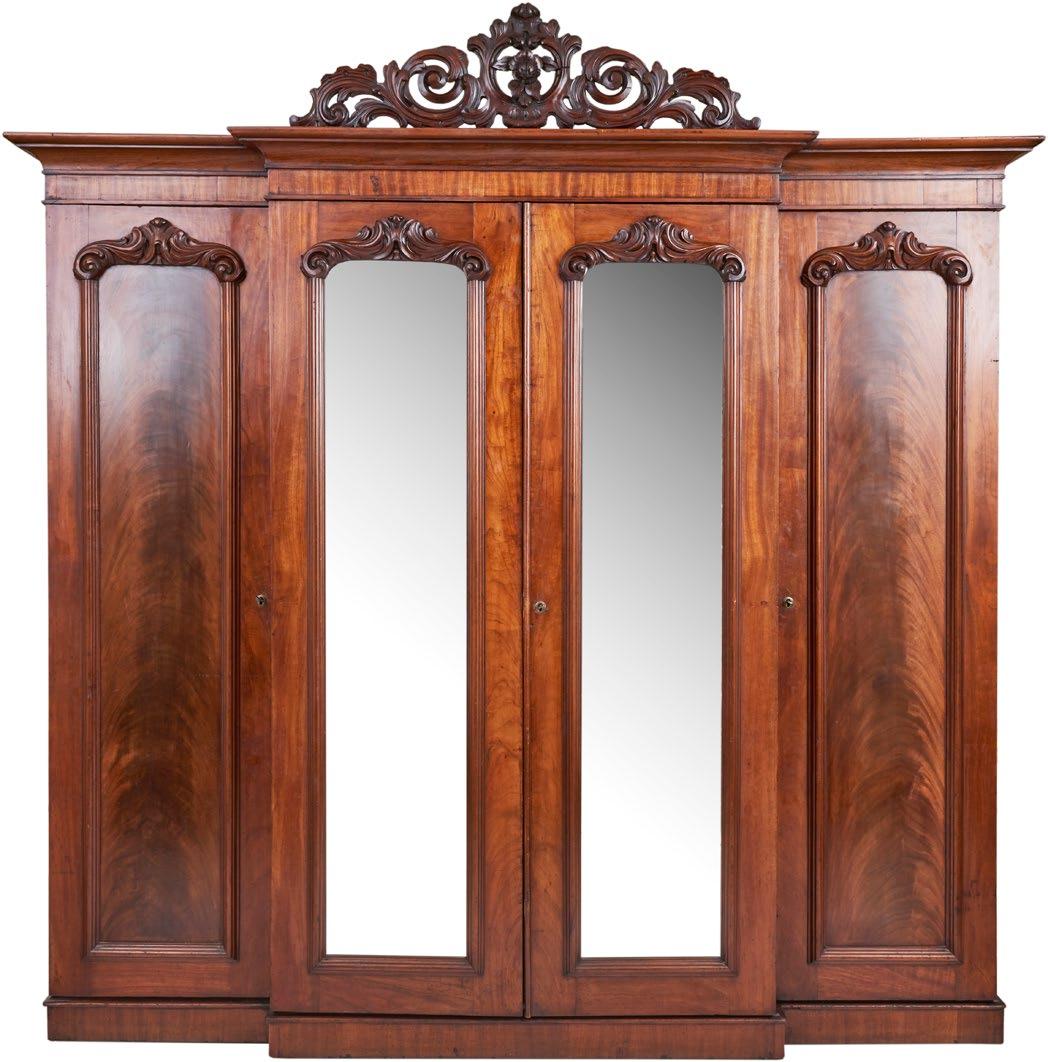
PROVENANCE
Bonhams and Goodman, Sydney, 06/08/2007, lot 9 (AUD$4200 hammer)
REFERENCE
For a pediment carving of almost identical form, refer to the ‘Wallalong Bookcase’ by Hill and Sons illustrated in Australian Furniture Pictorial History and Dictionary 1788-1938, Kevin Fahy and Andrew Simpson, Casuarina Press, Sydney, page 184. It therefore could be suggested that this wardrobe was commissioned for Dr Walter Scott of Wallalong NSW. $2,500–4,000
254 183
255
A carved cedar twin-pedestal dressingtable, Australian, circa 1870
155cm wide, 60cm deep, 178cm high $1,000–2,000
256
A mirror-back hat-tree cedar hall-stand, Australian, circa 1860 82cm wide, 210cm high $1,200–1,500

257
An important cedar Palladianback two-door wardrobe, attributed to Jospeh Sly, Sydney, Australian, circa 1840 with interior boot compartments 230cm wide, 220cm high, 62cm deep
PROVENANCE
Similar to a design based on G.Smith (1808) and W.Smee and sons (1850), pages 52 and 56, Pictorial Dictionary of British 19th Century Furniture Design
A similar Palladian wardrobe stamped Sly was sold at Mossgreen, 7 December 2005, Somercotes, Tasmania, lot 18
$6,000–9,000
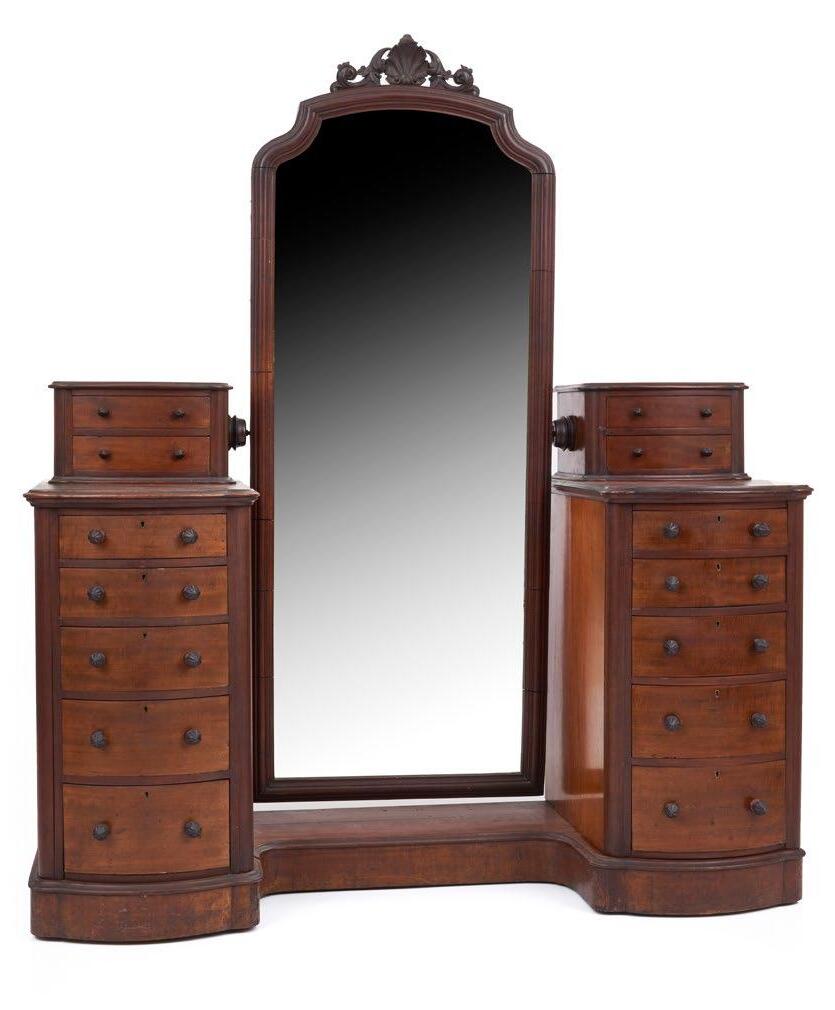
255 256 184
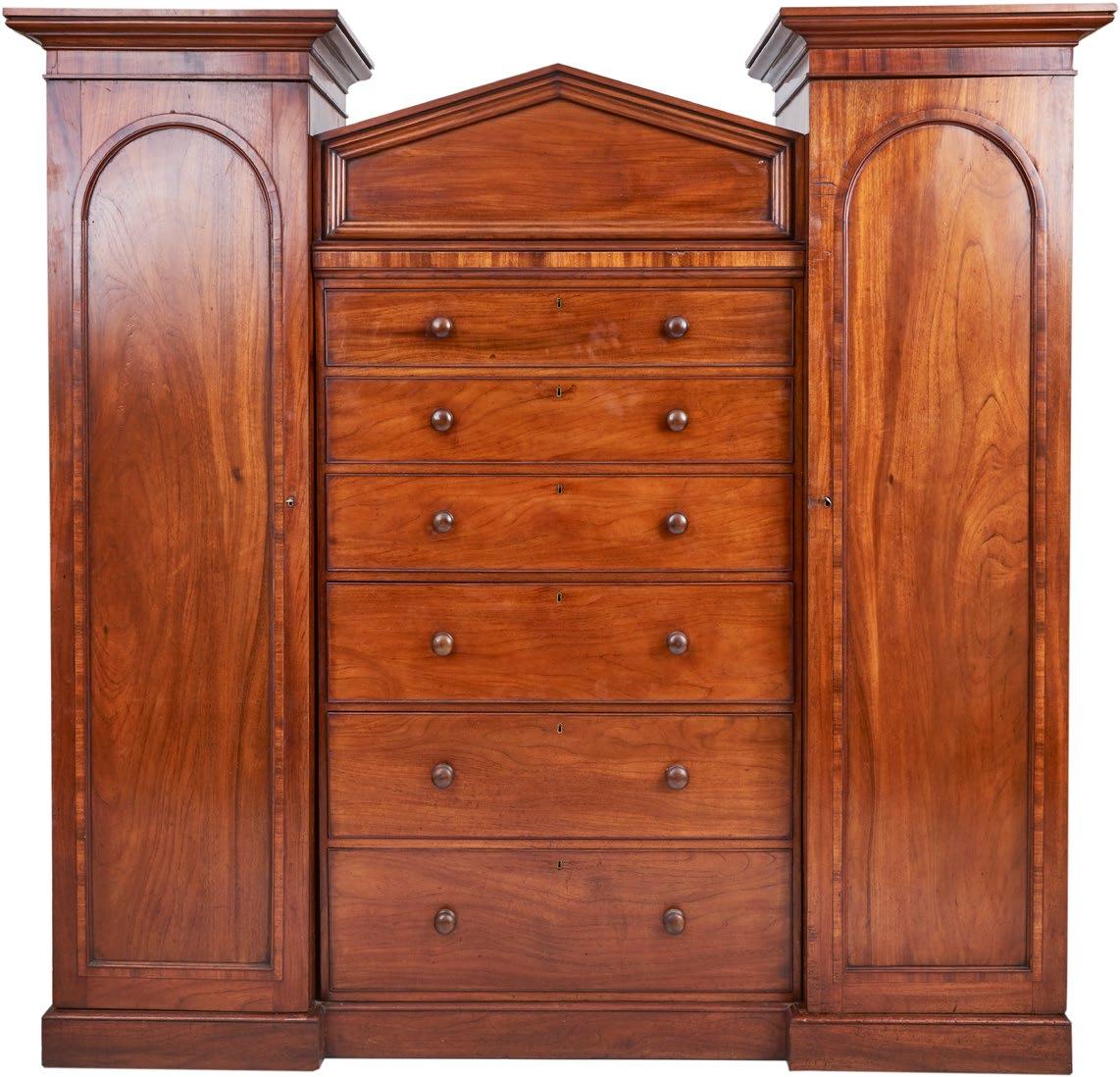
257 185
258
A carved emu egg and silver-plated and pink glass centre-piece, English manufacture for the Australian market, 19th century
30cm high, 30cm long
$400–700
259
A pair of white-metal mounted carved emu-eggs on stands, Australian, 19th century carved with Advance Australia and the Australian coat-of-arms
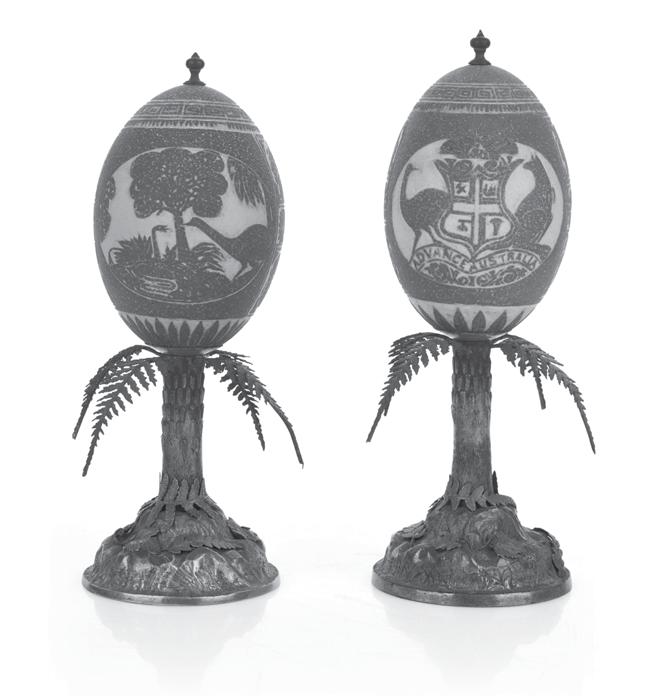
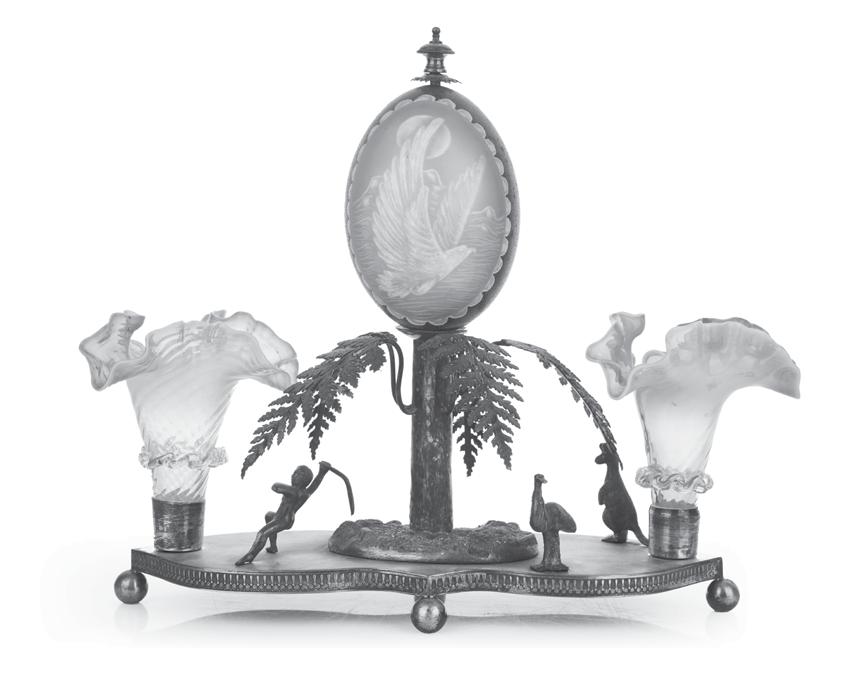
25.5cm and 26cm high
$600–900
260
A silver-plated and carved emu-egg presentation inkwell, Australian, 19th century
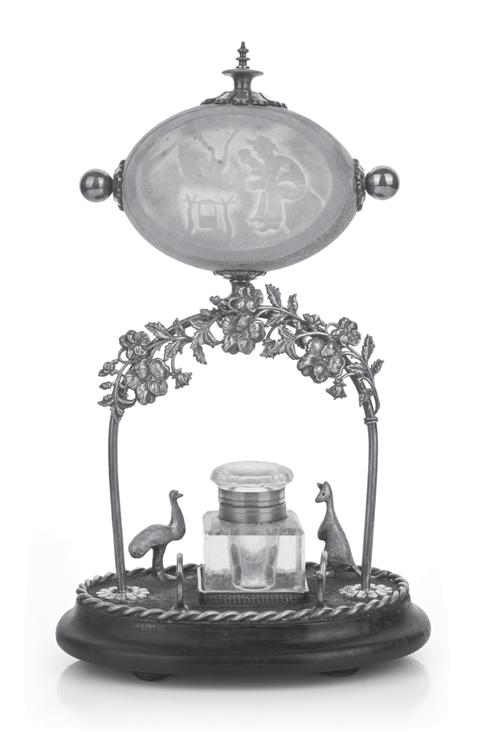
31cm high, 18cm wide
$500–800
258 259 260 186
End of Part 1
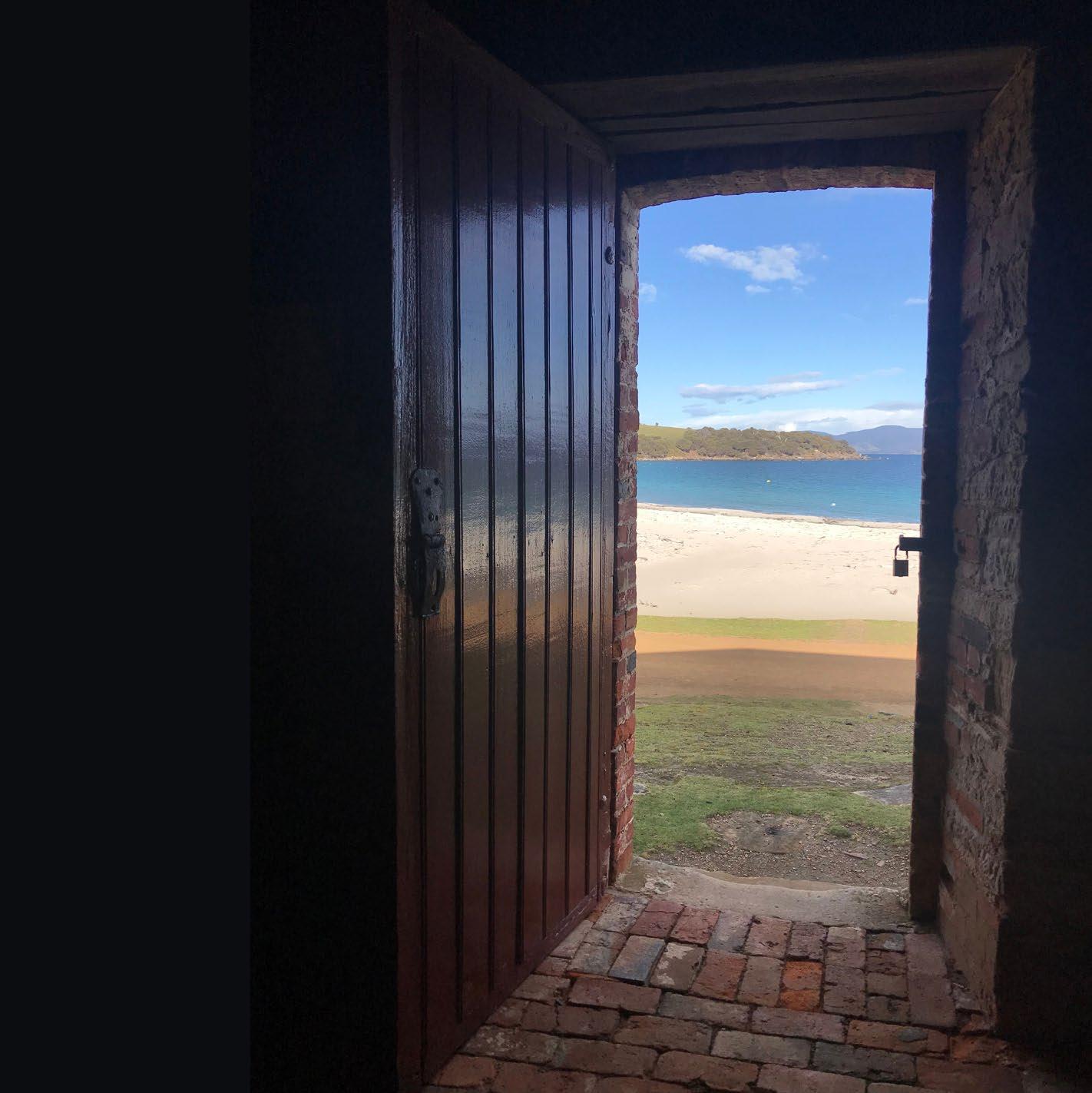
187
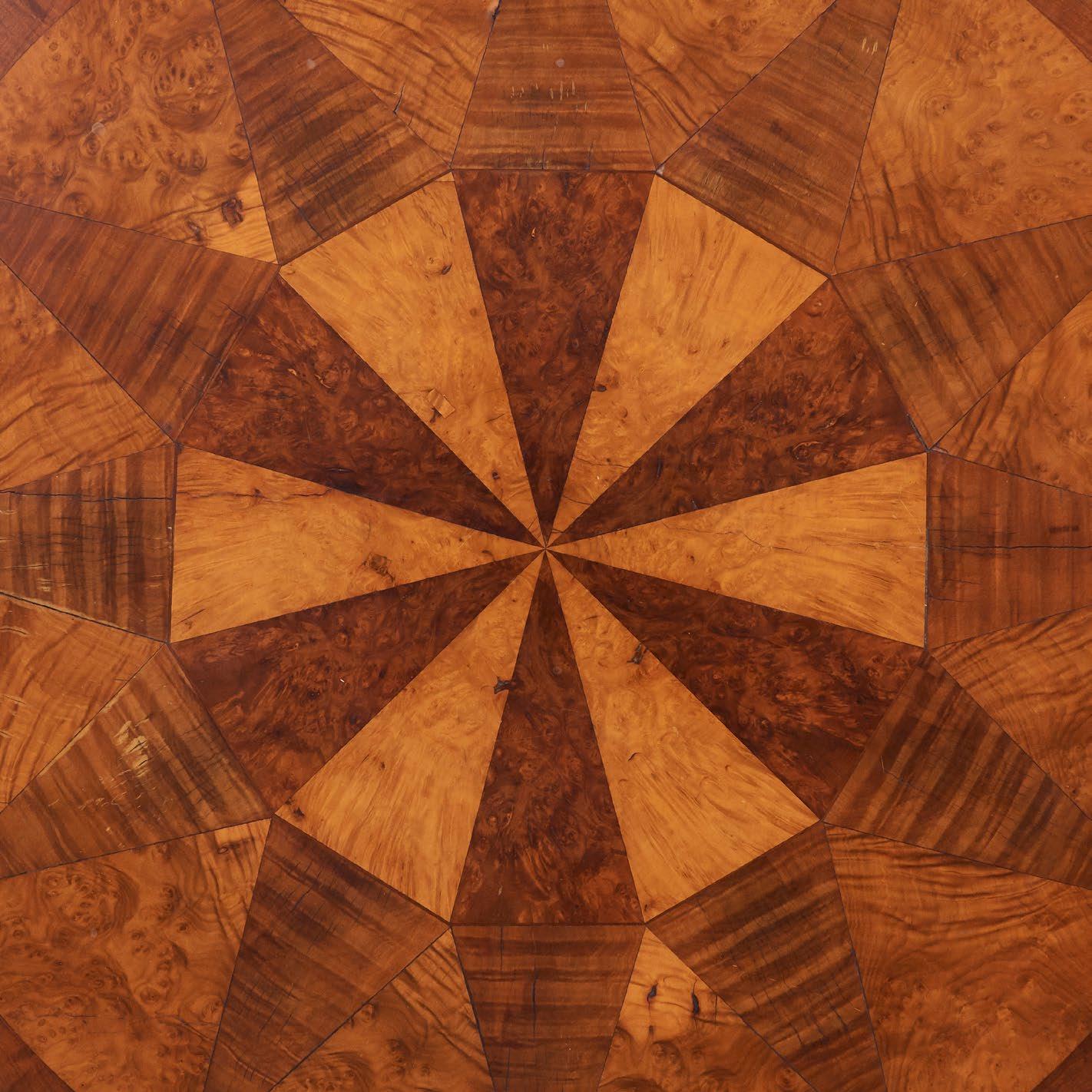
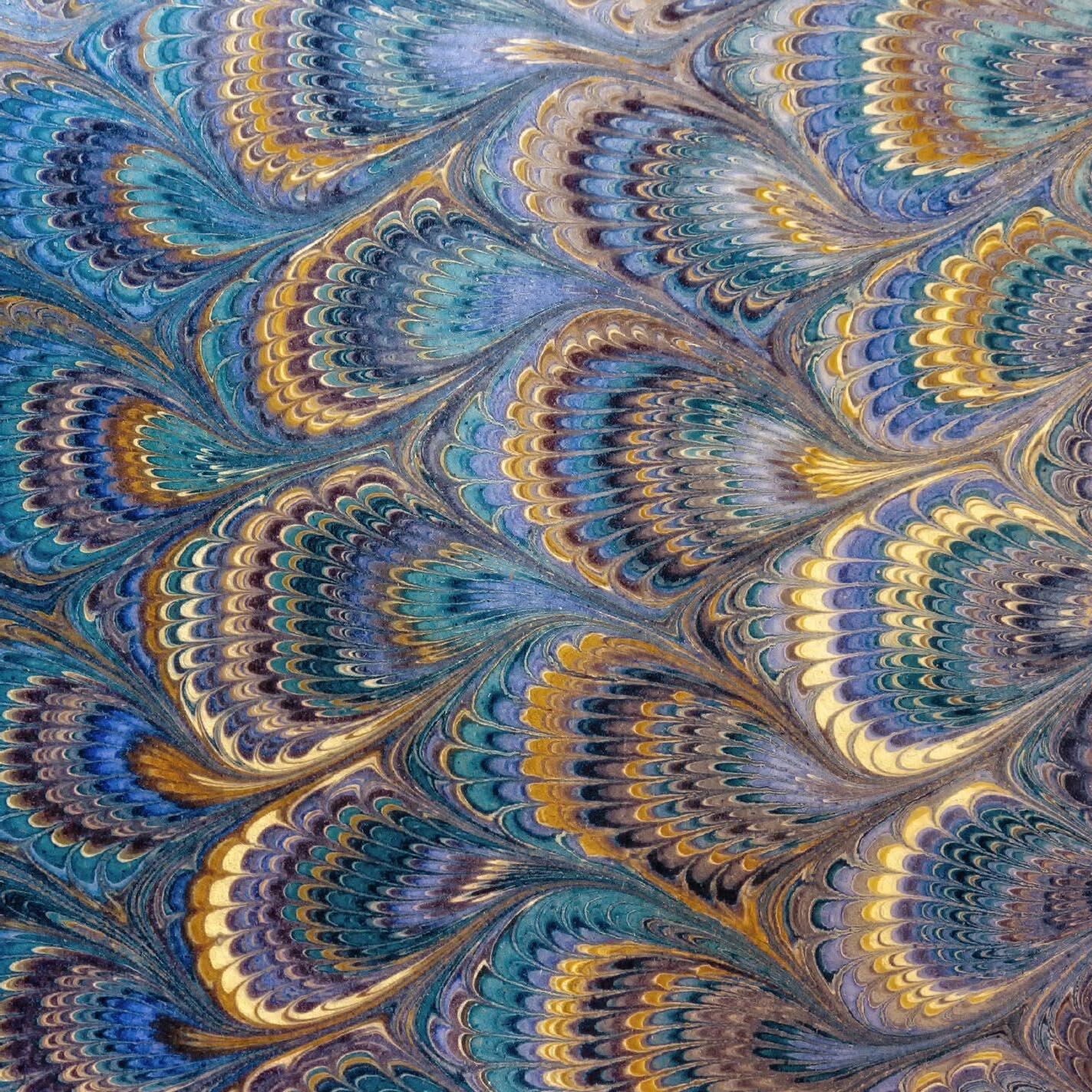

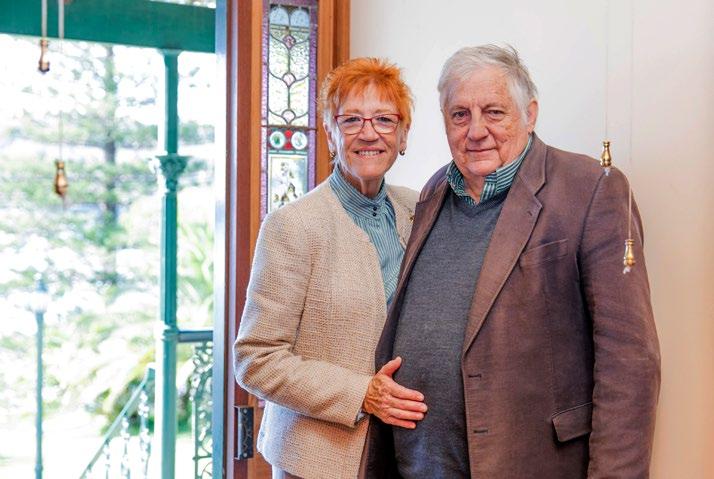
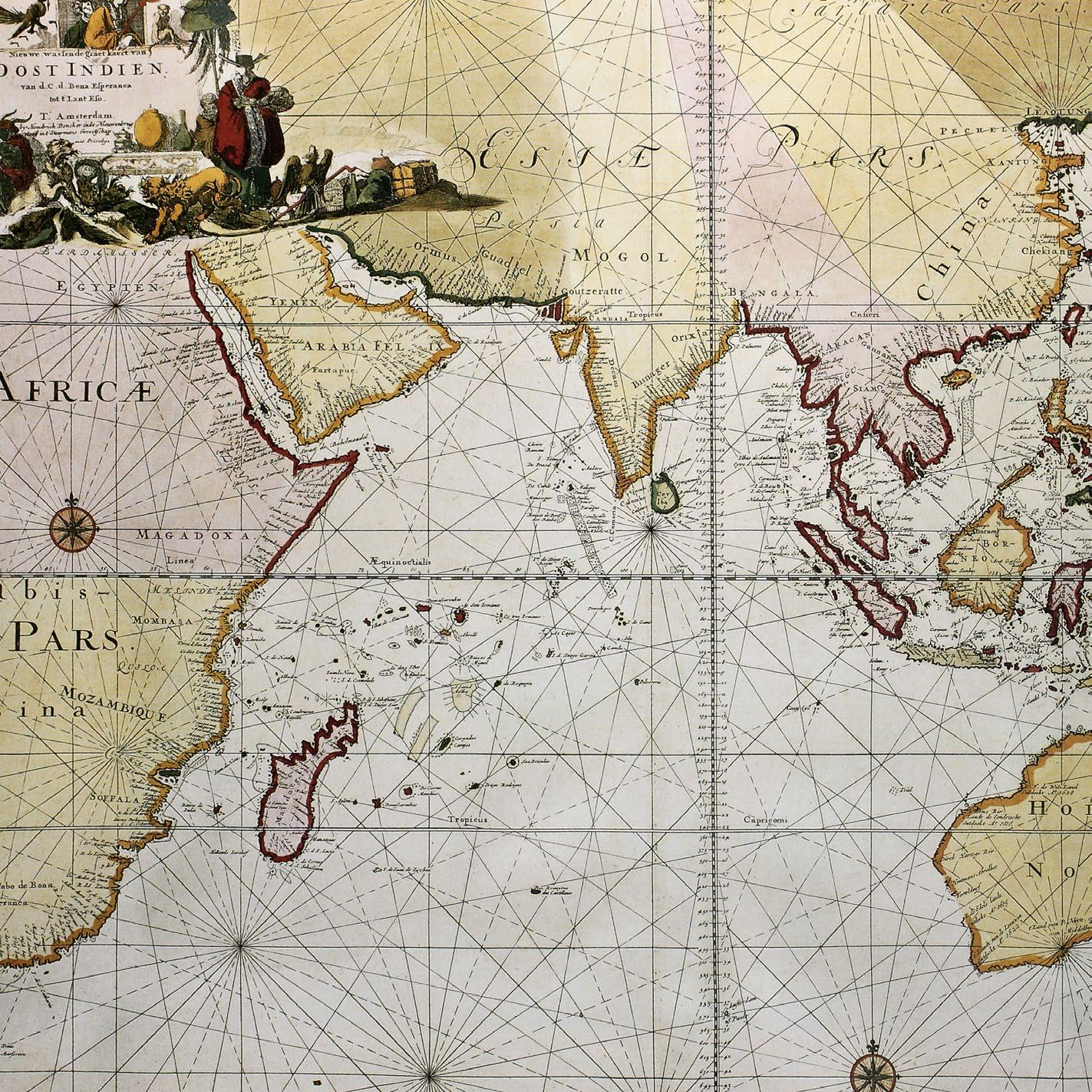


























































































































































































 132
132






























































 NORMAN LINDSAY (Australian, 1879-1969)
NORMAN LINDSAY (Australian, 1879-1969)



















































































 flat-back cedar and painted ship model, Australian, 19th century
SCHOOL (19th century)
RODIUS (1802-1860)
flat-back cedar and painted ship model, Australian, 19th century
SCHOOL (19th century)
RODIUS (1802-1860)

















